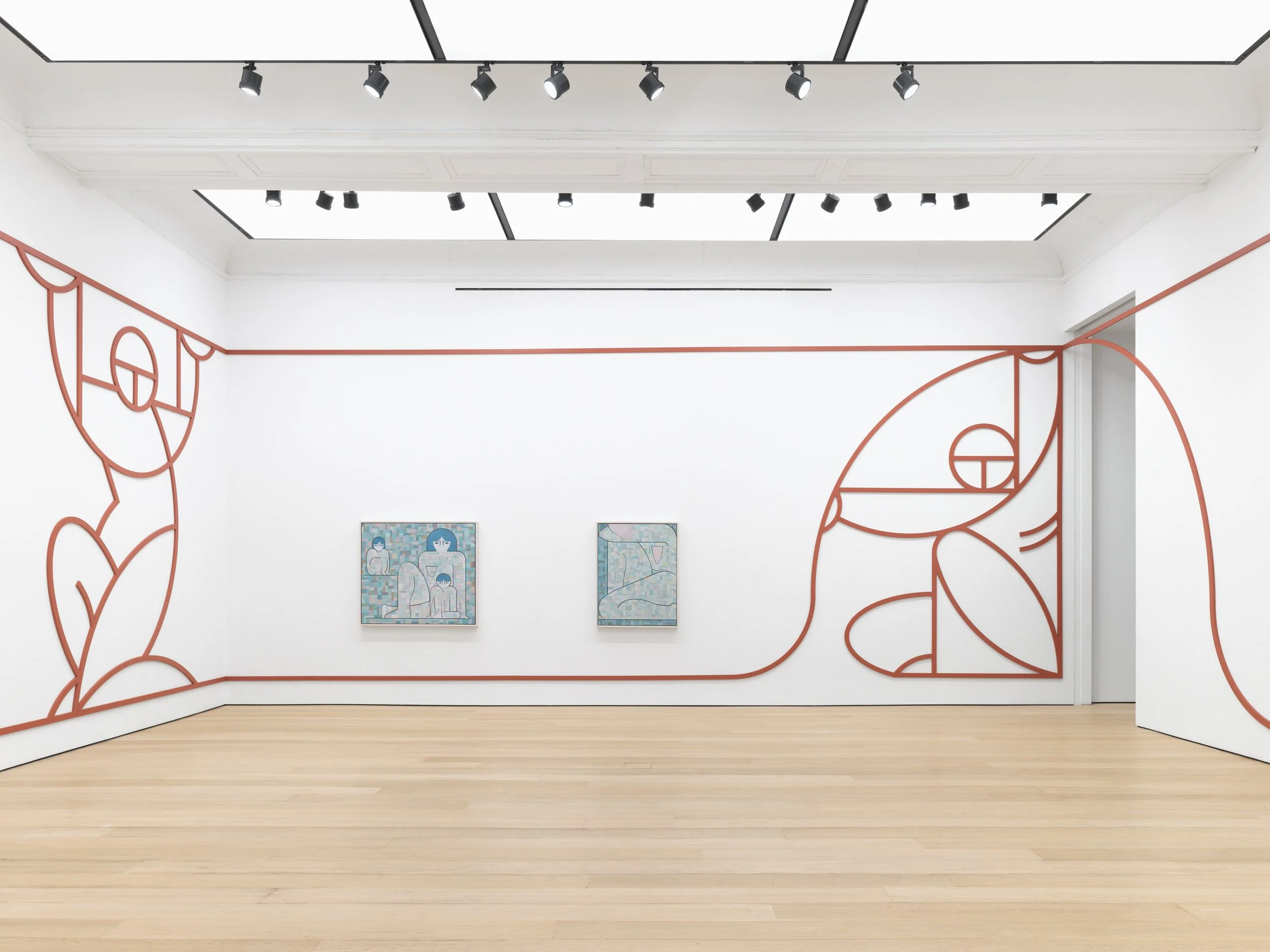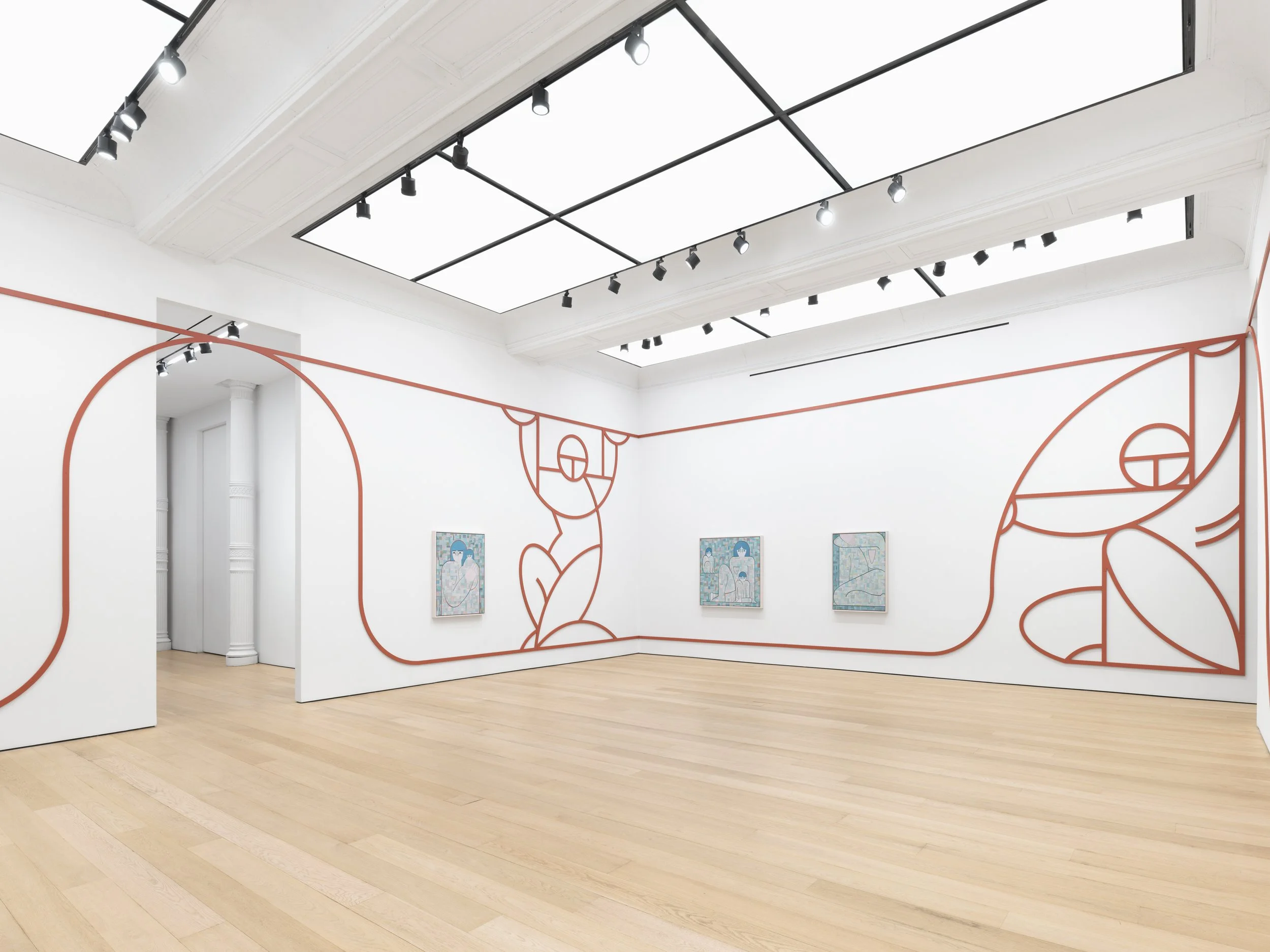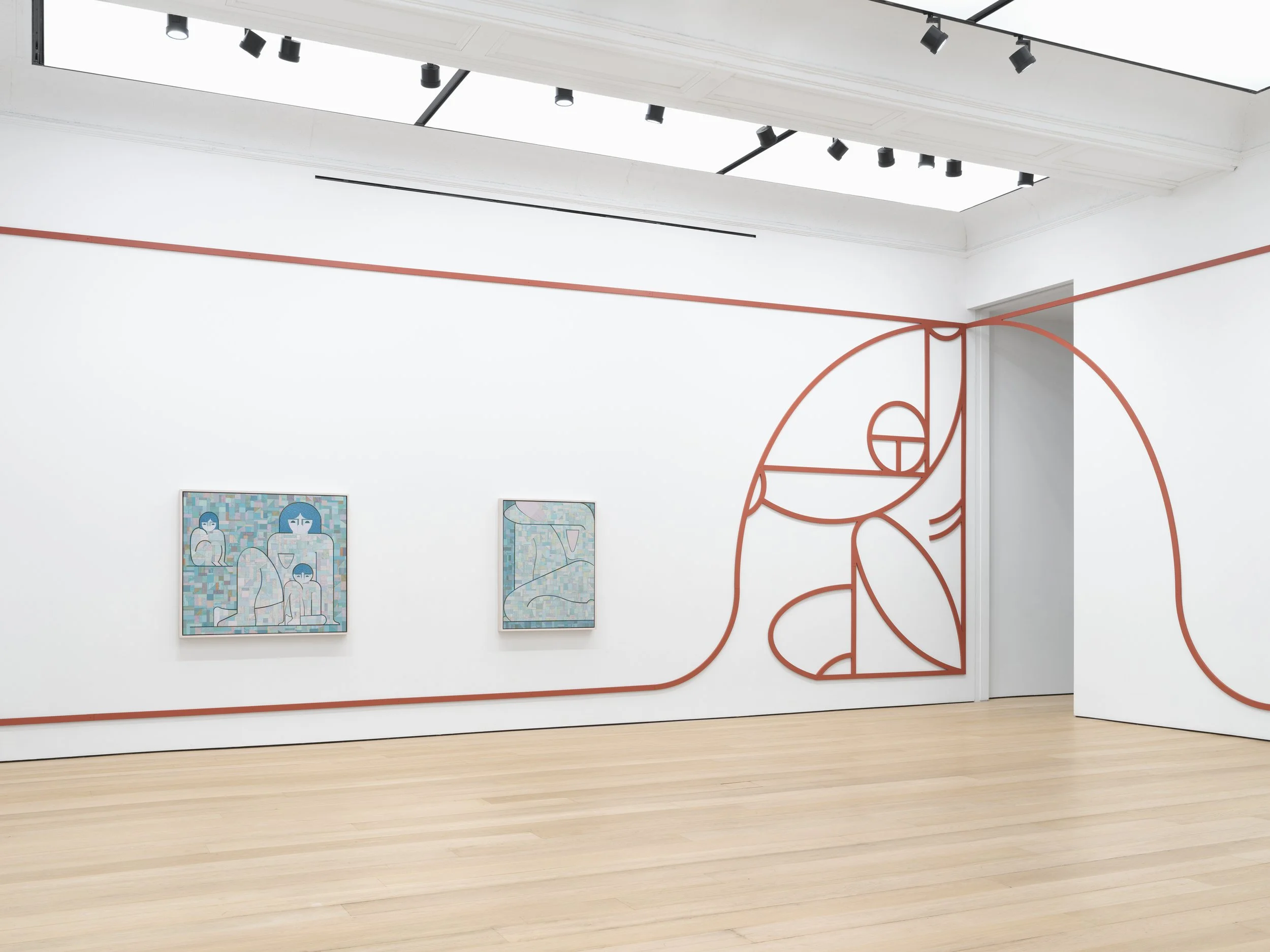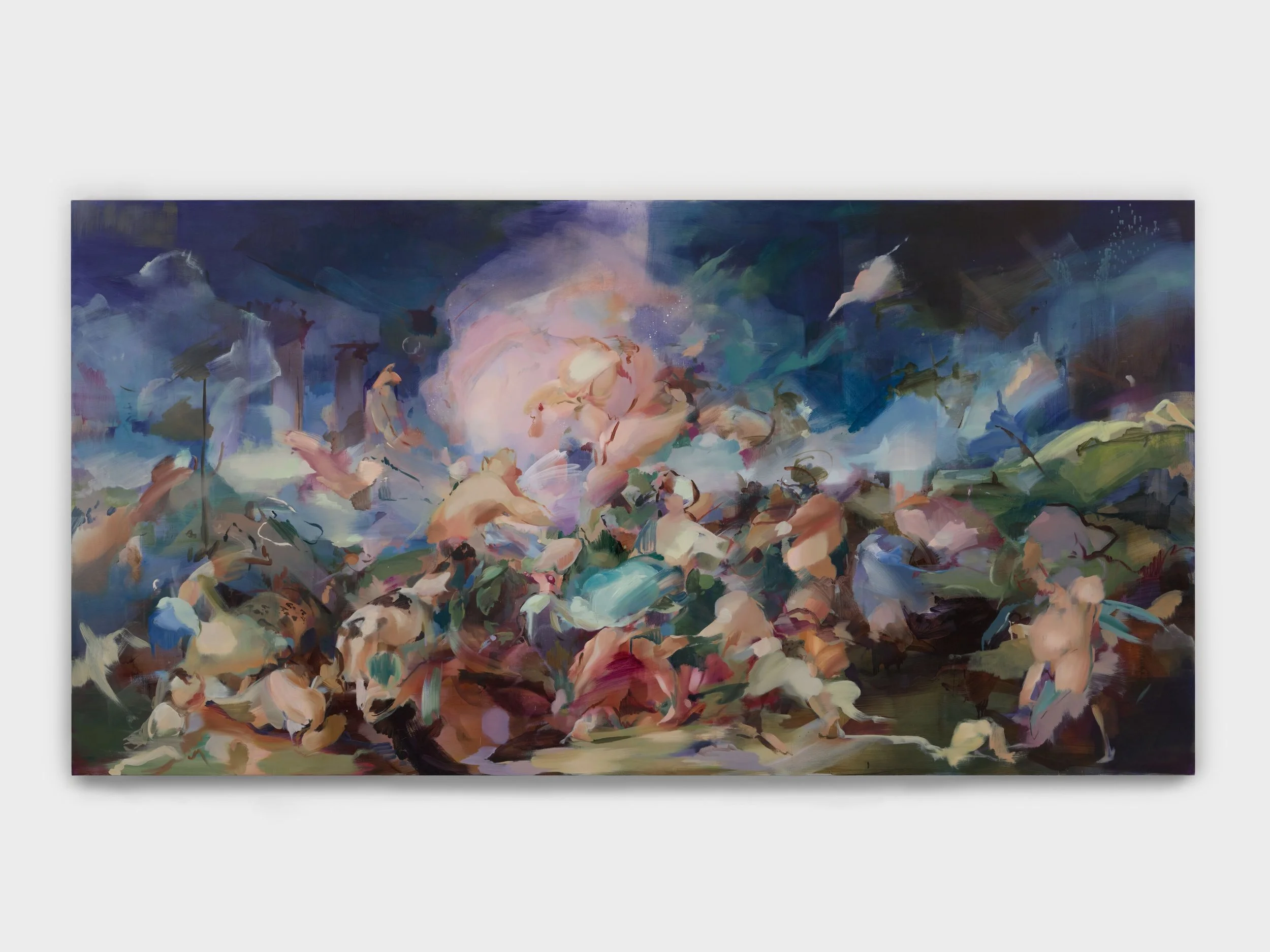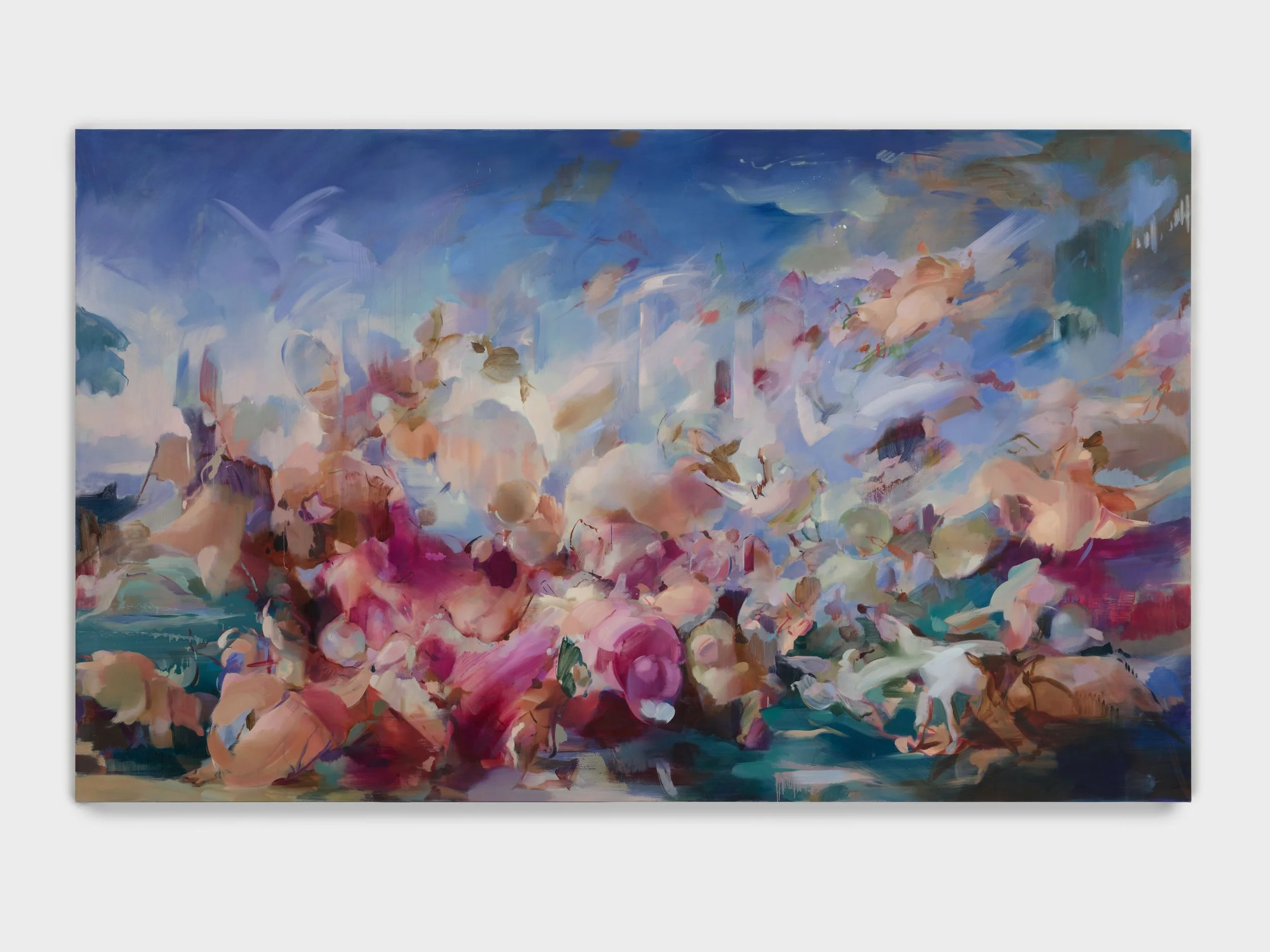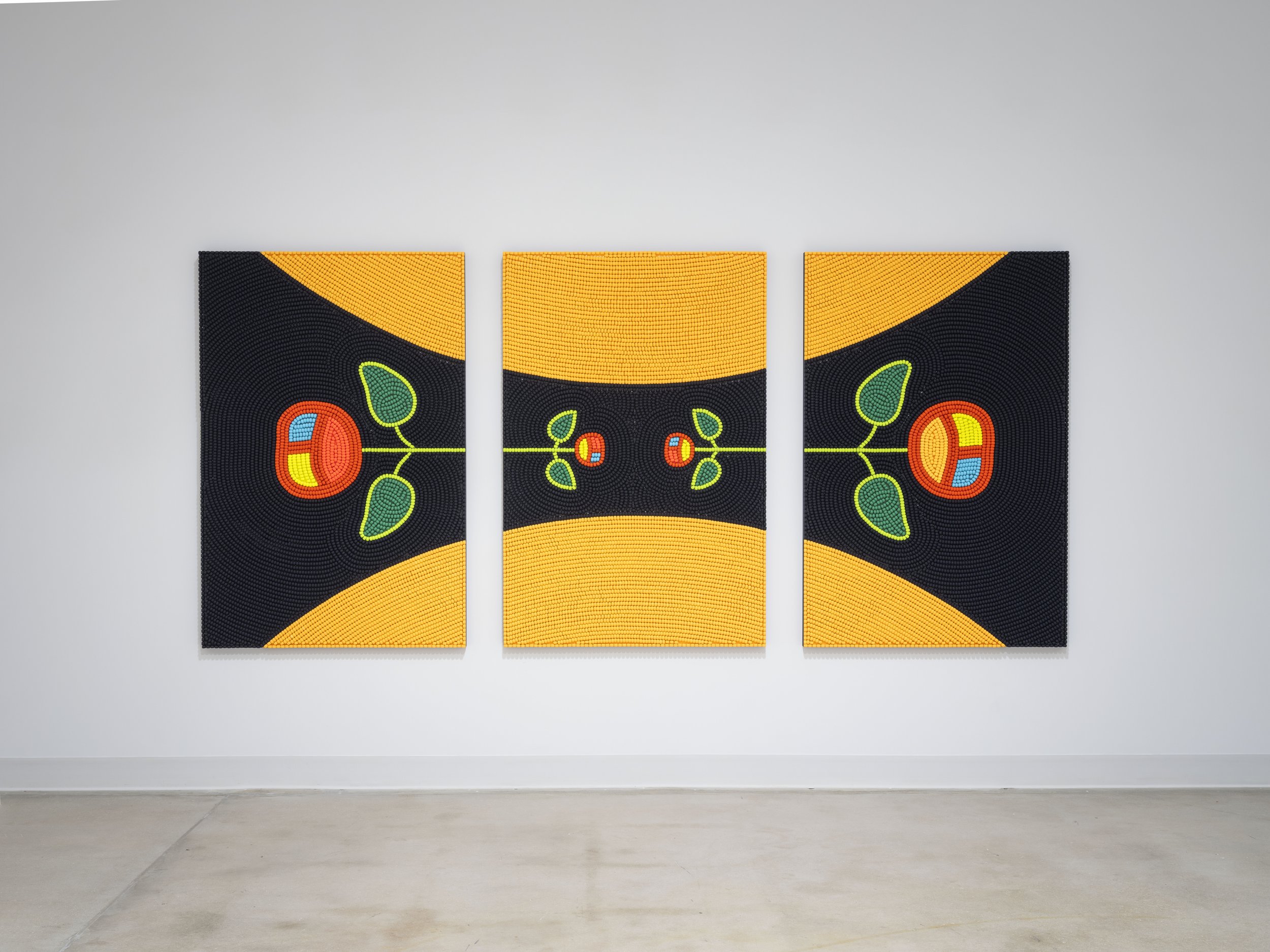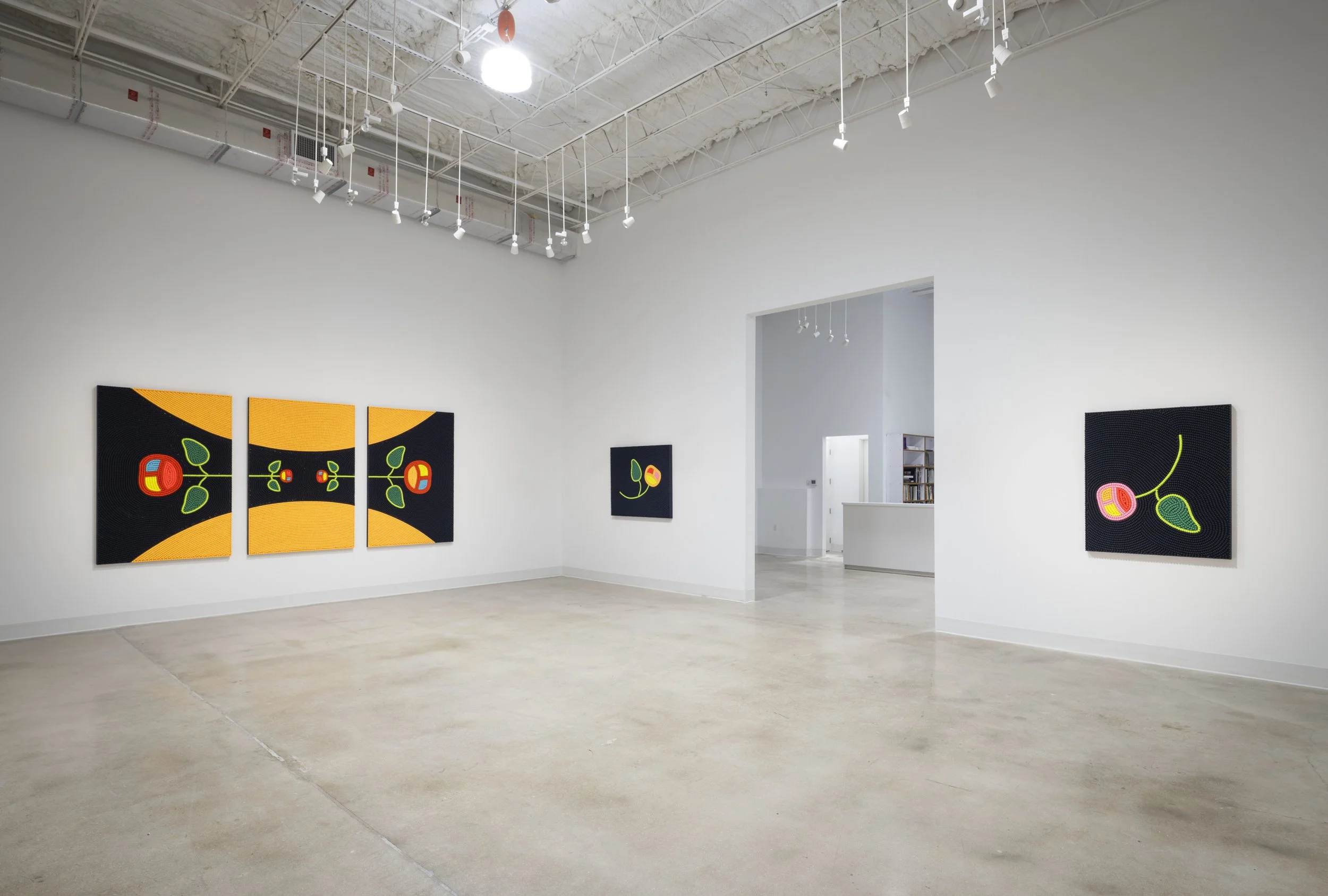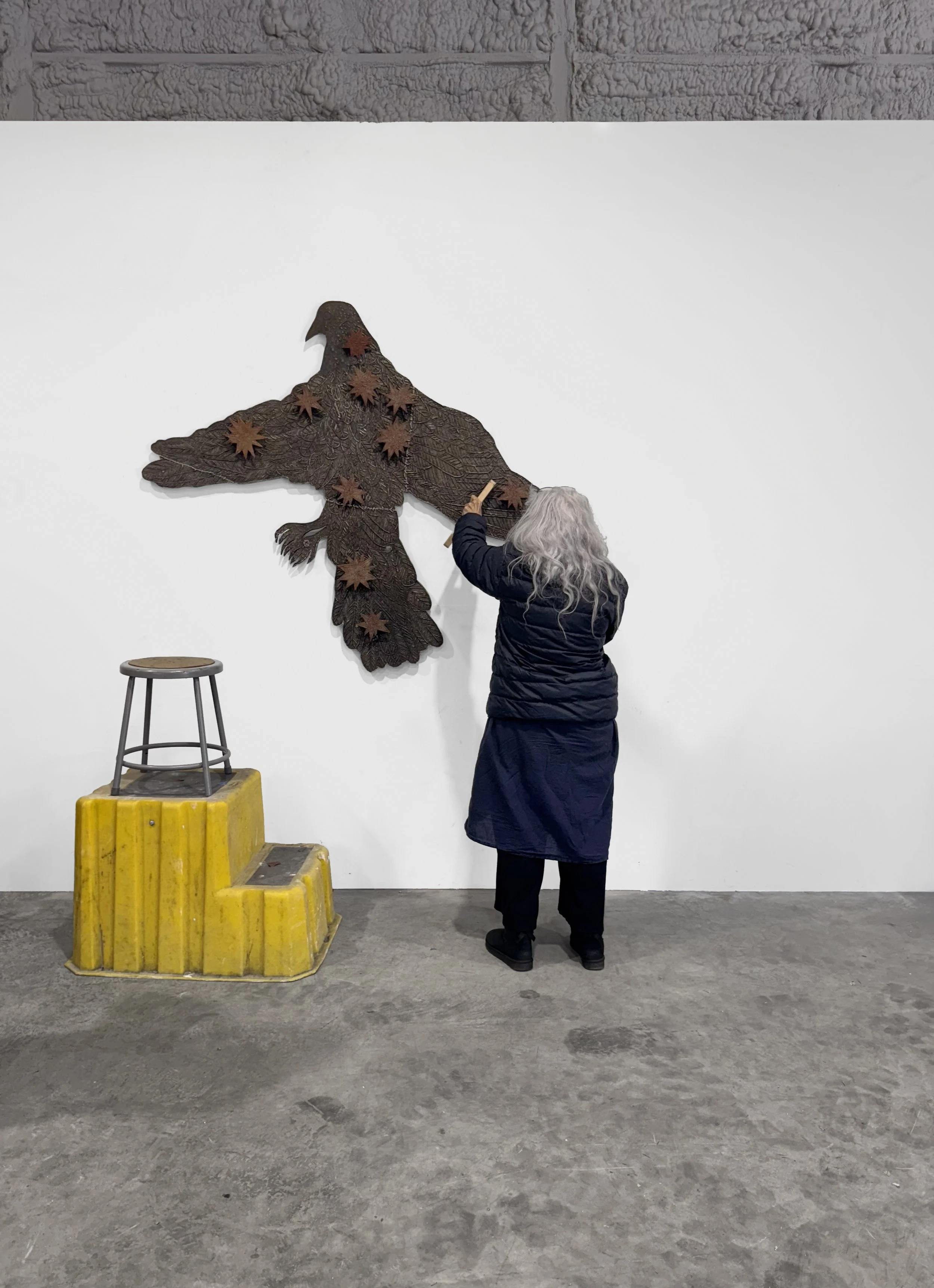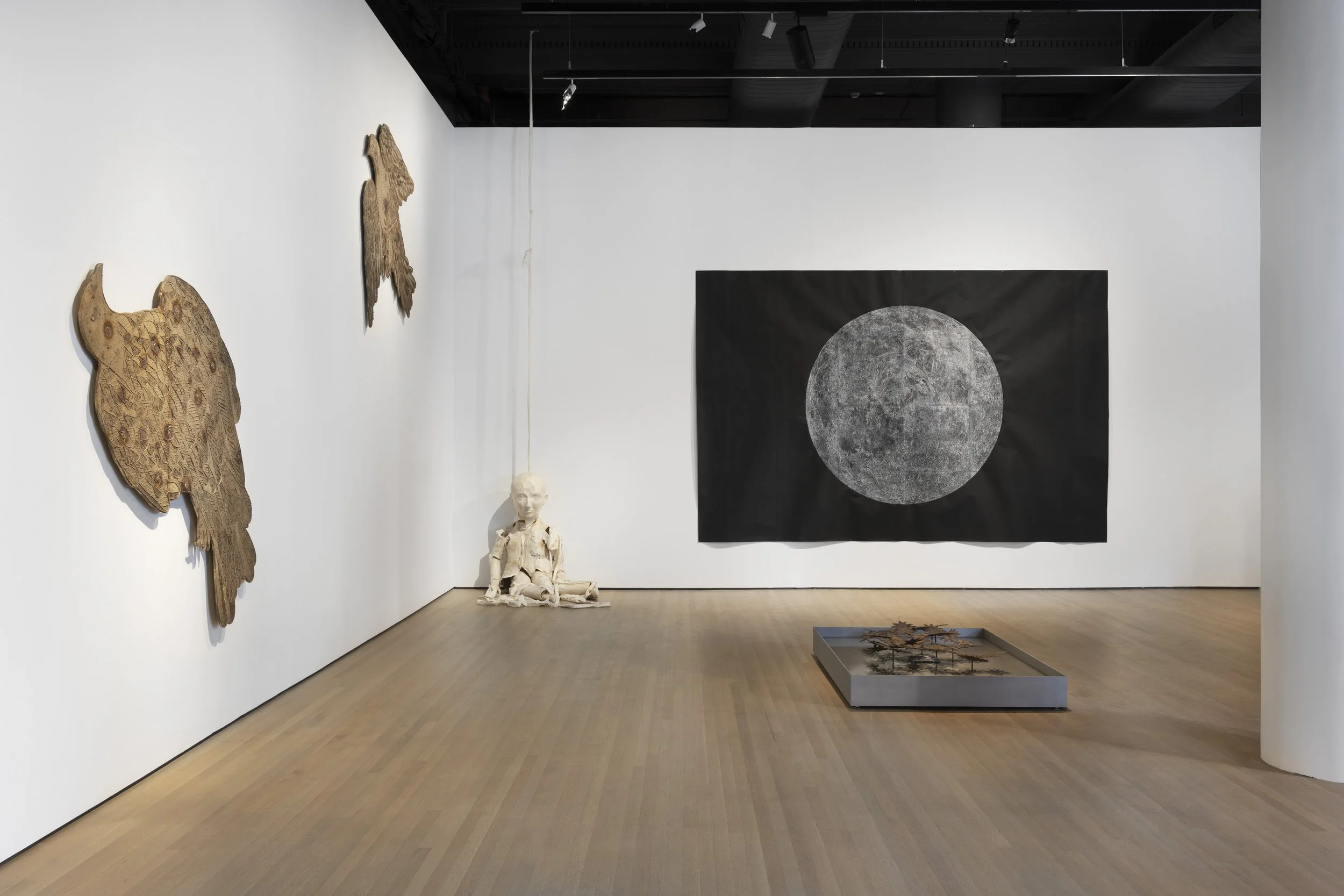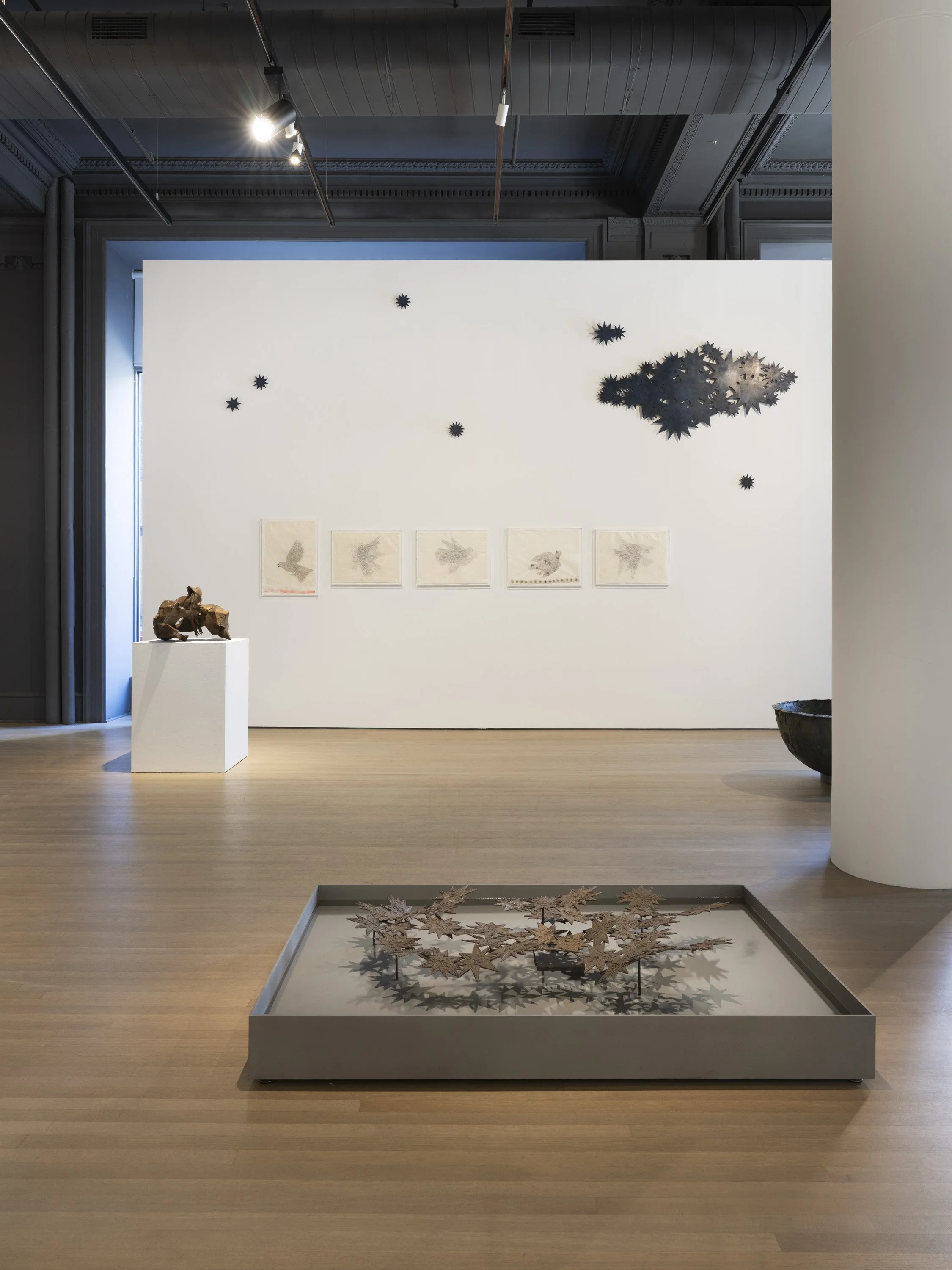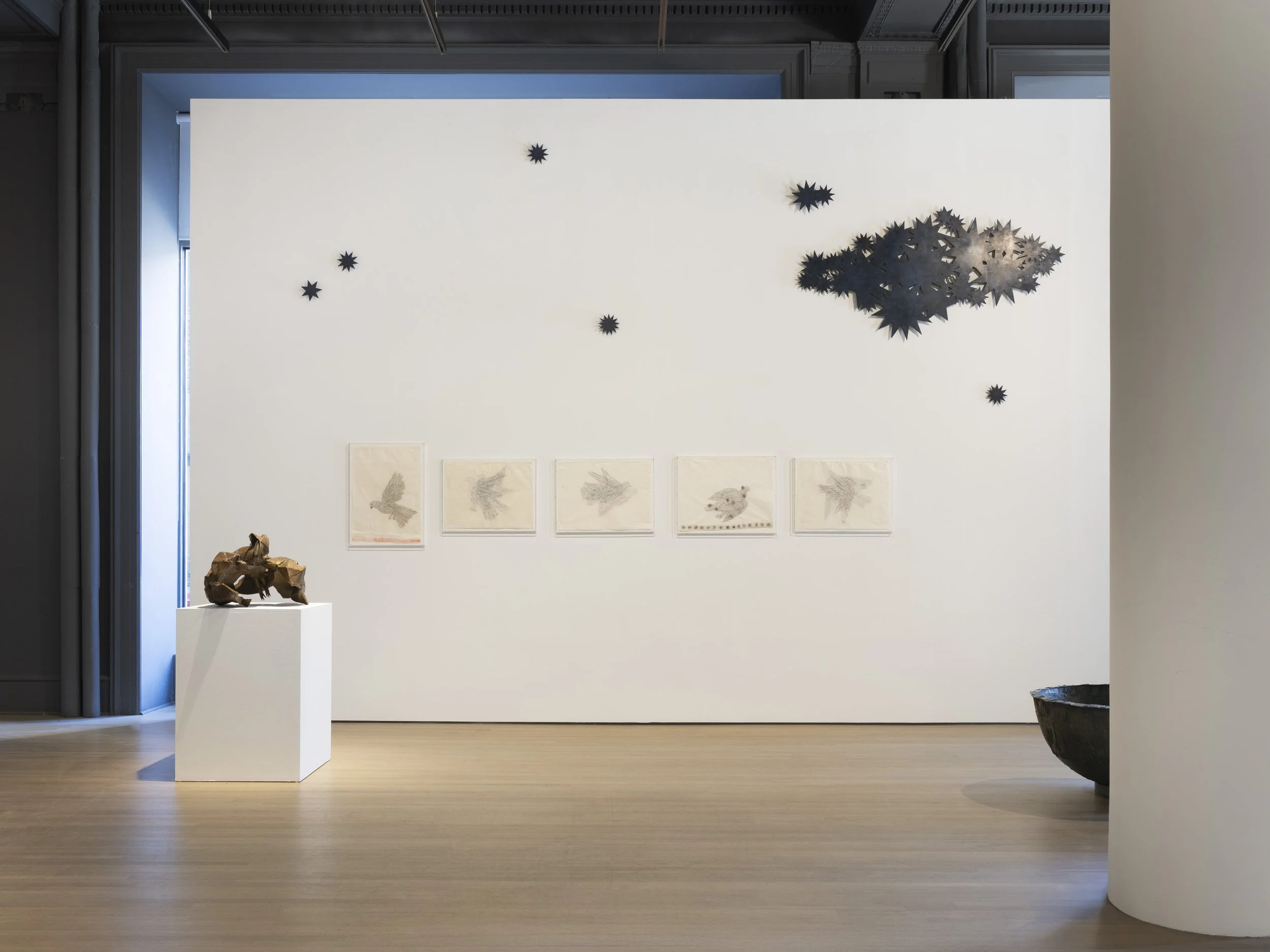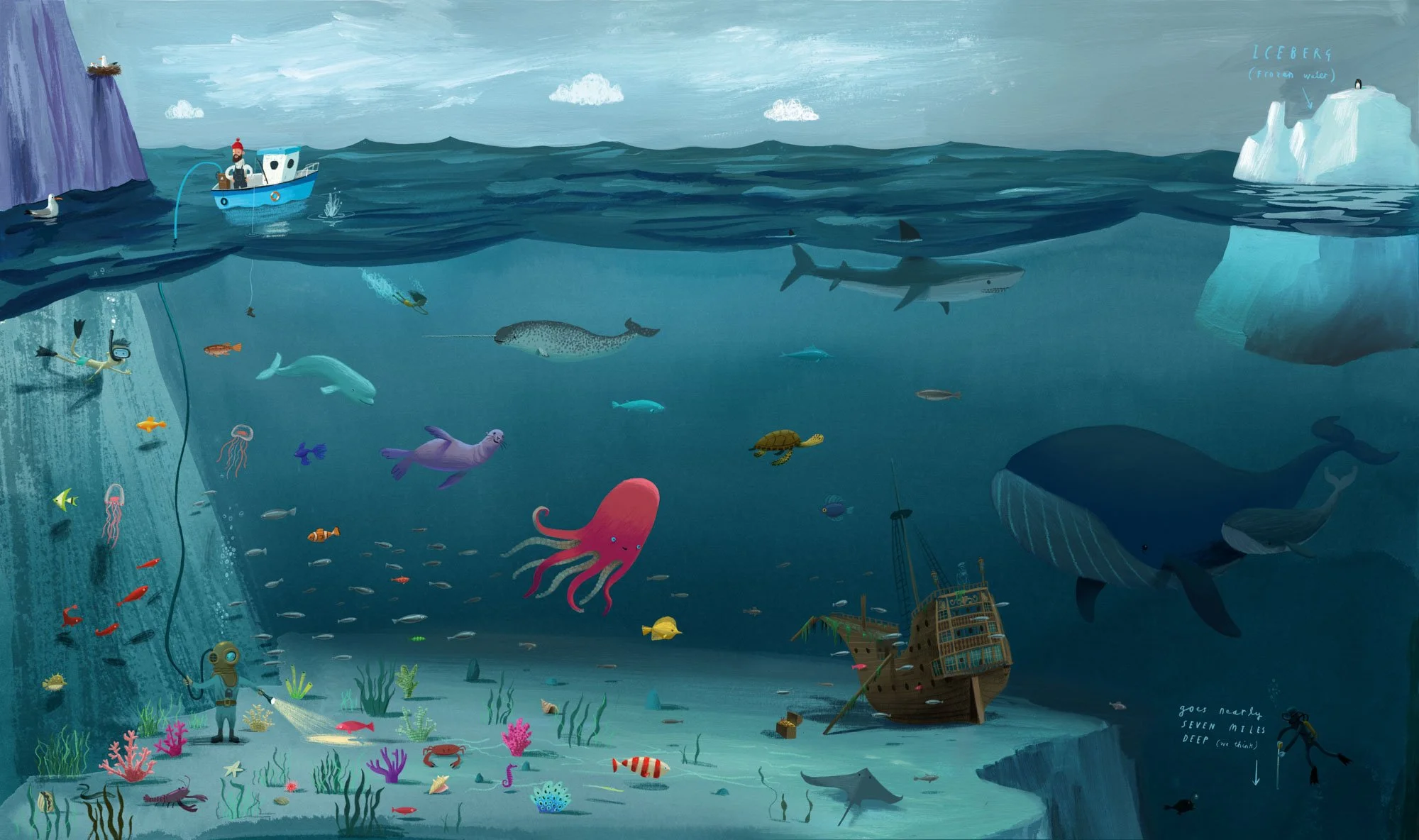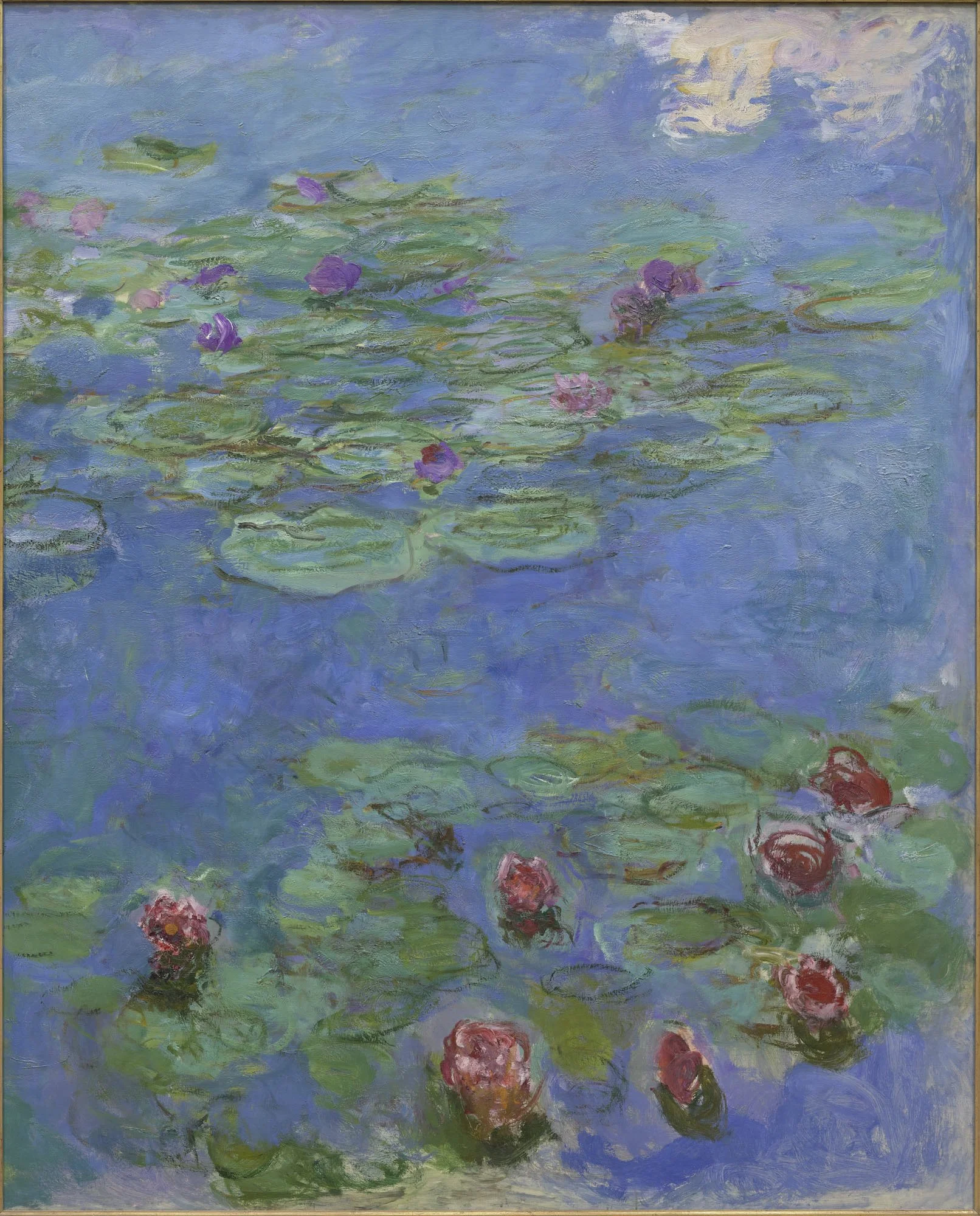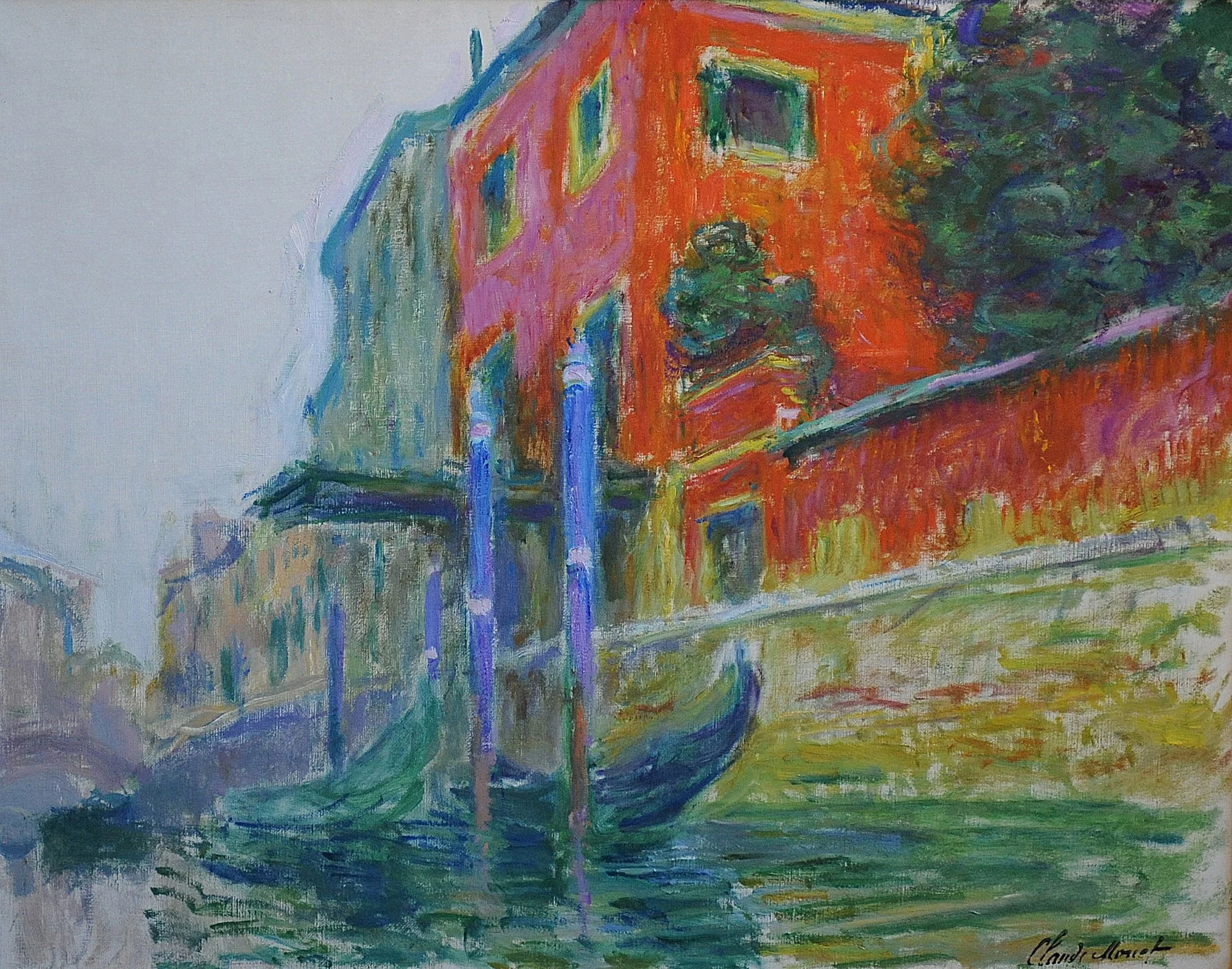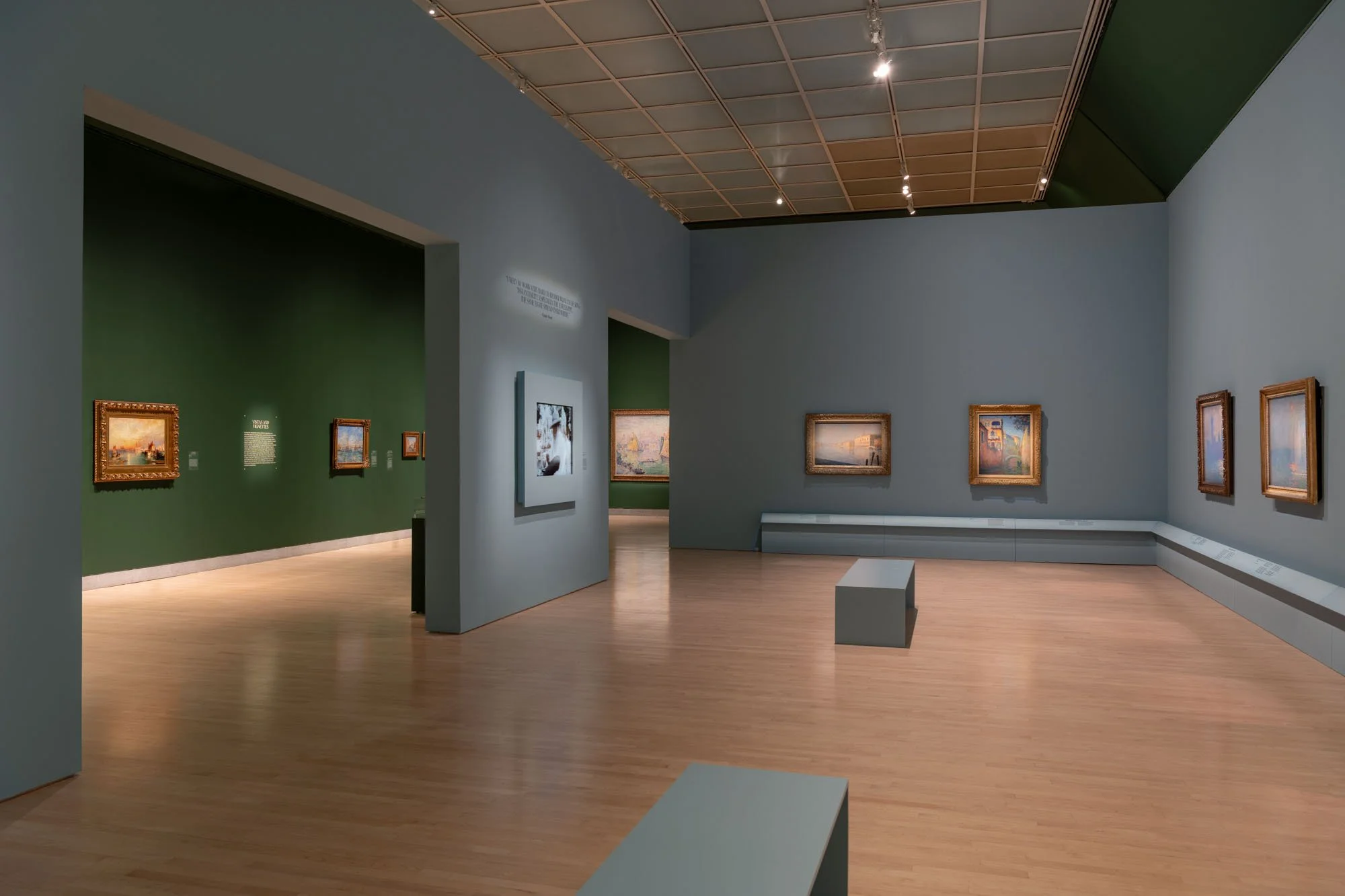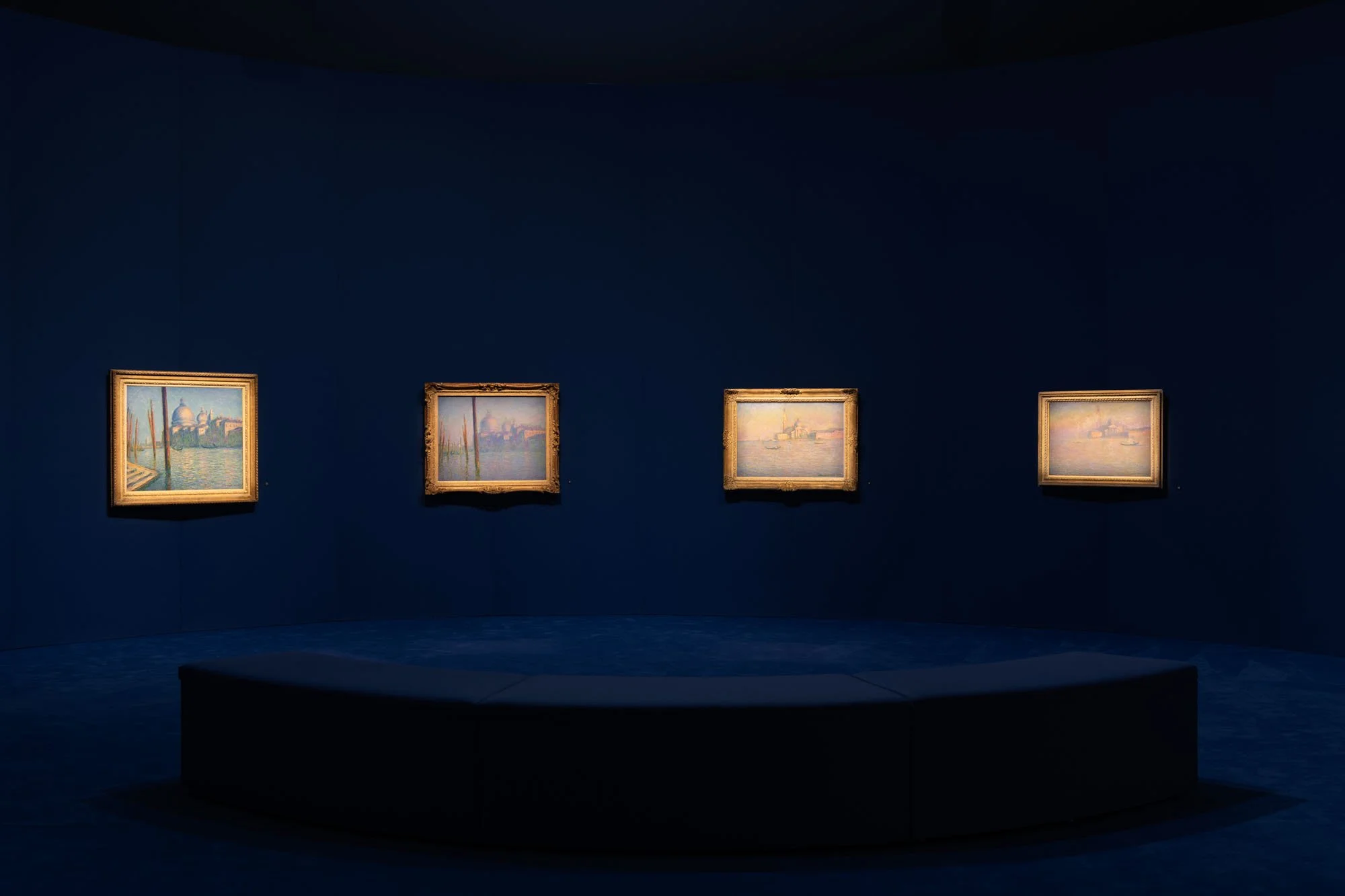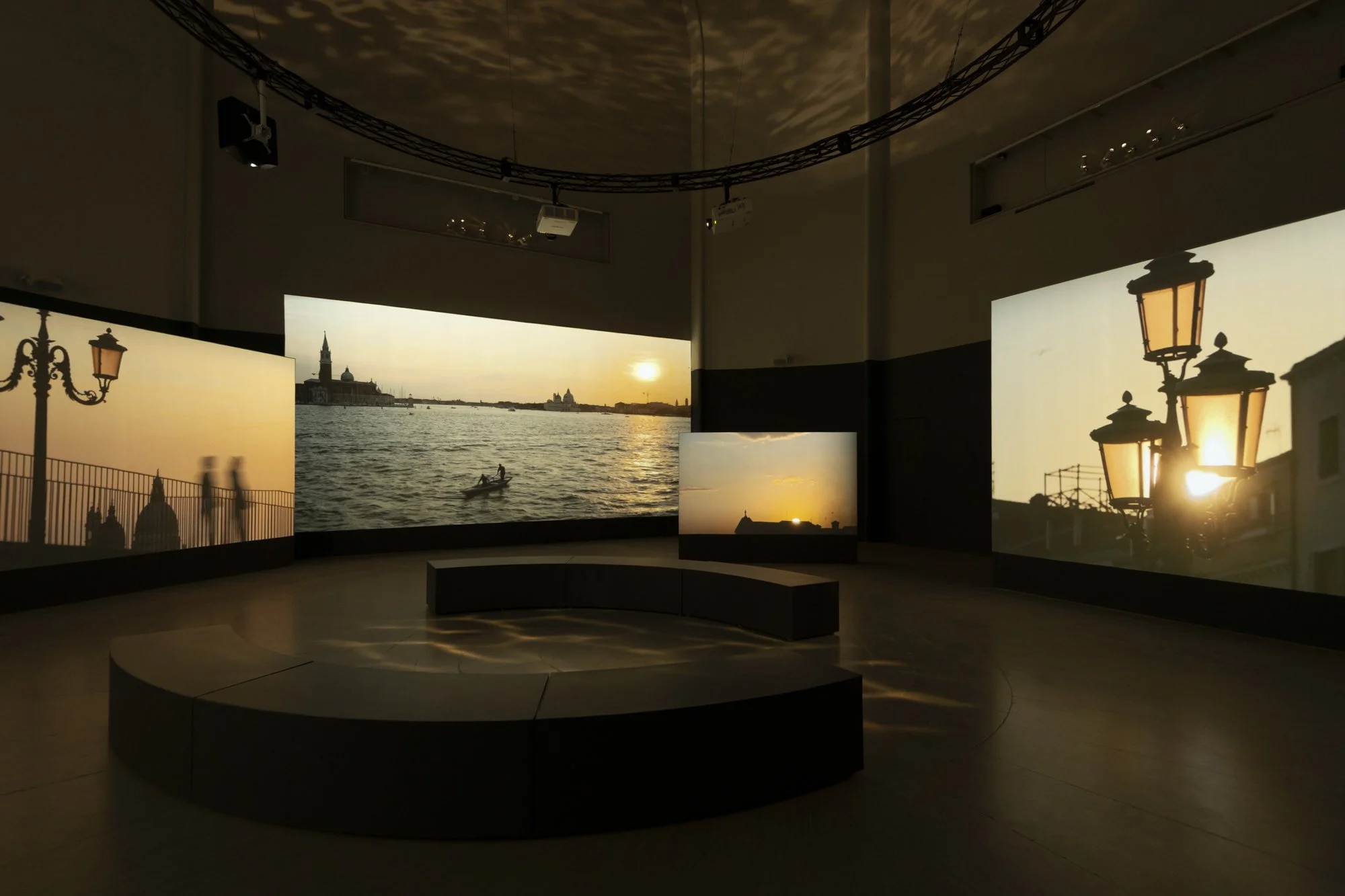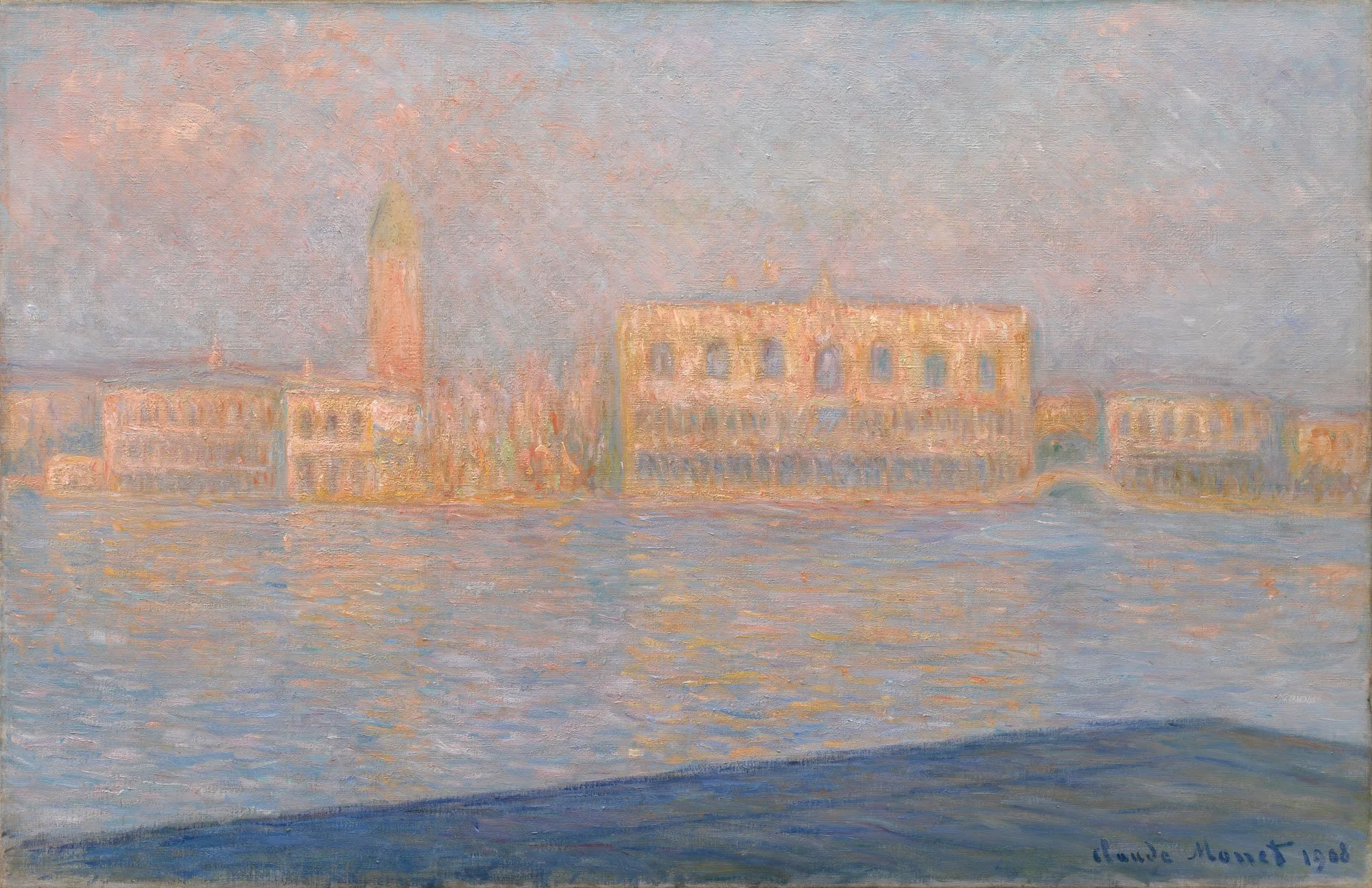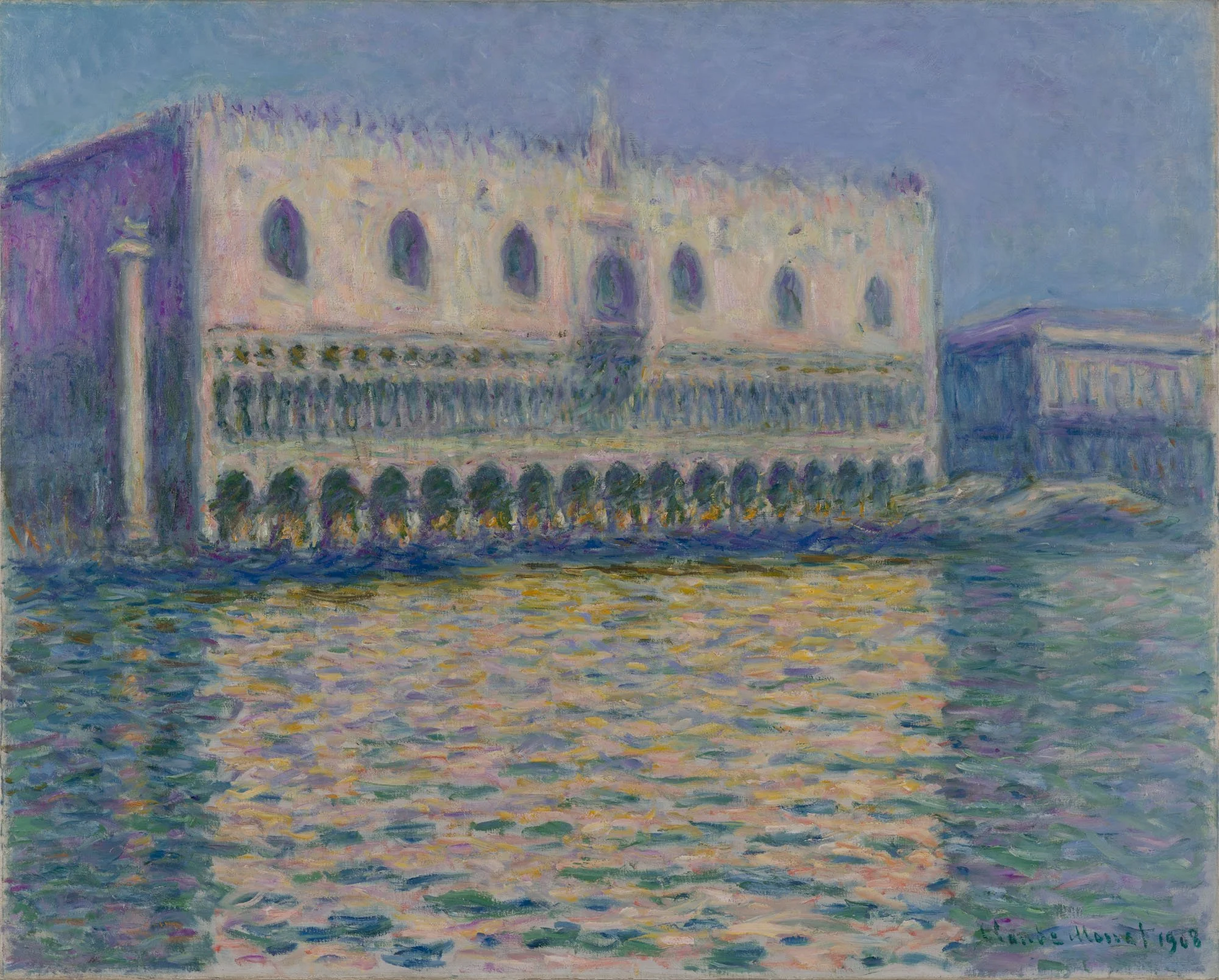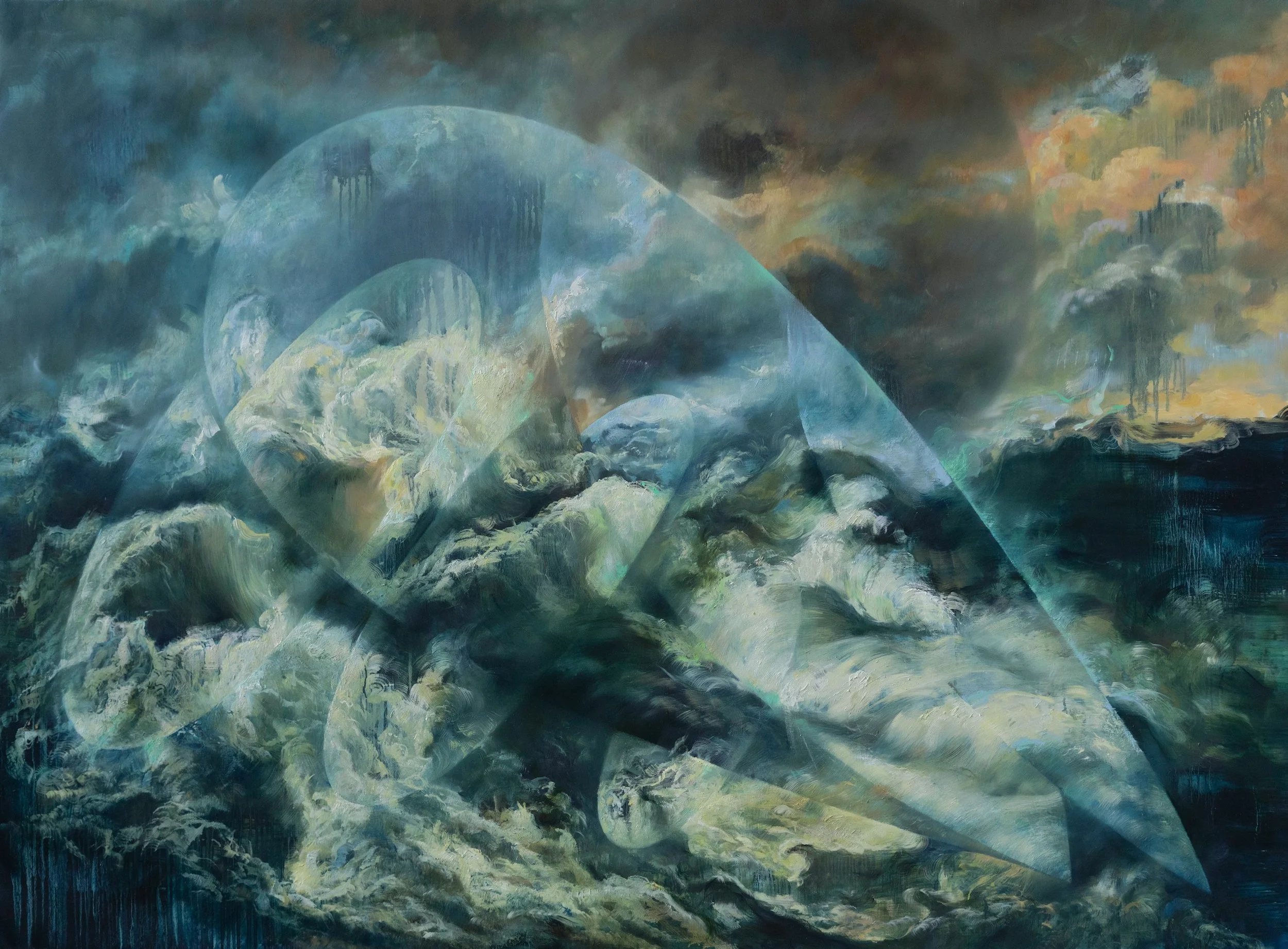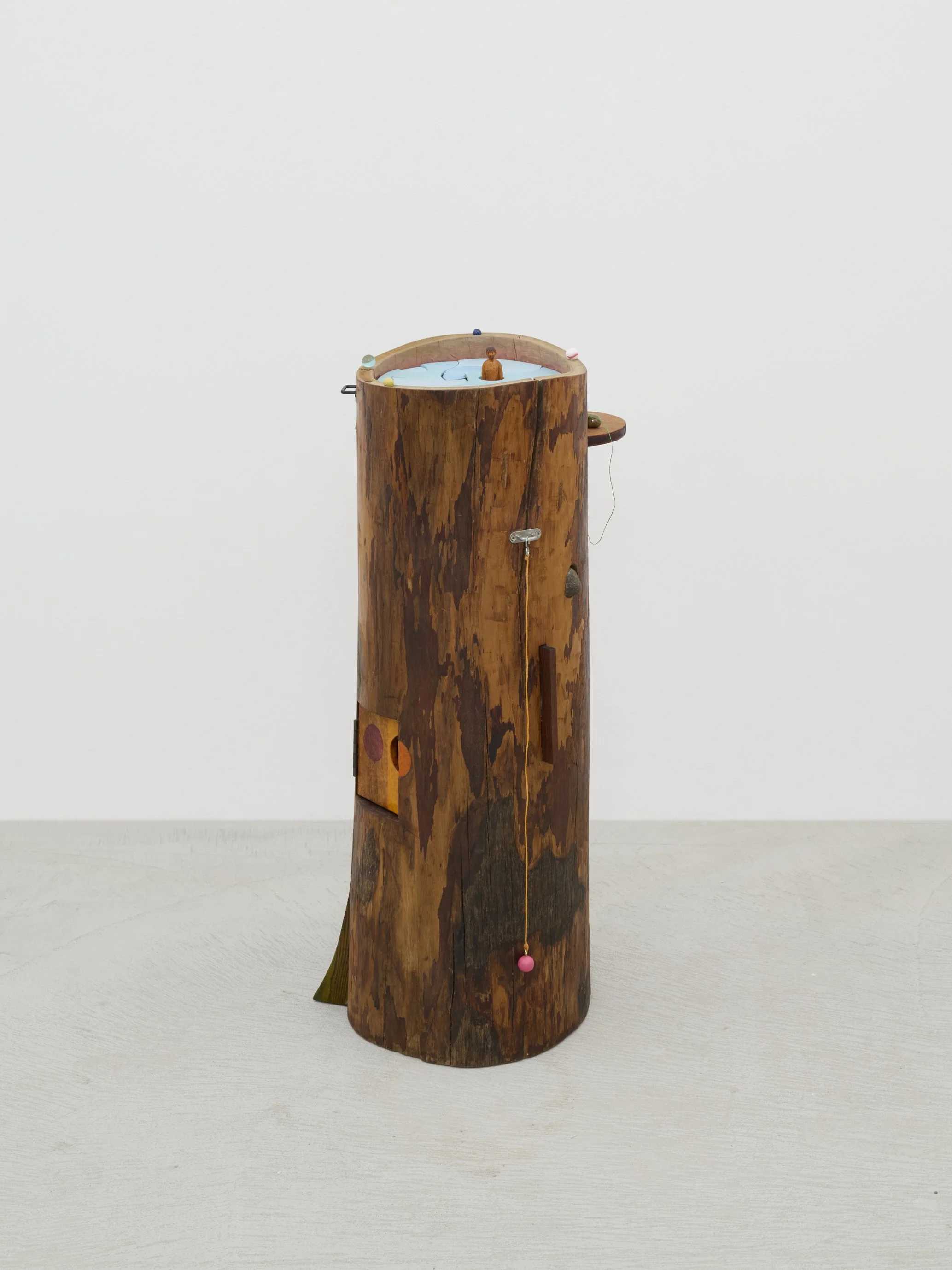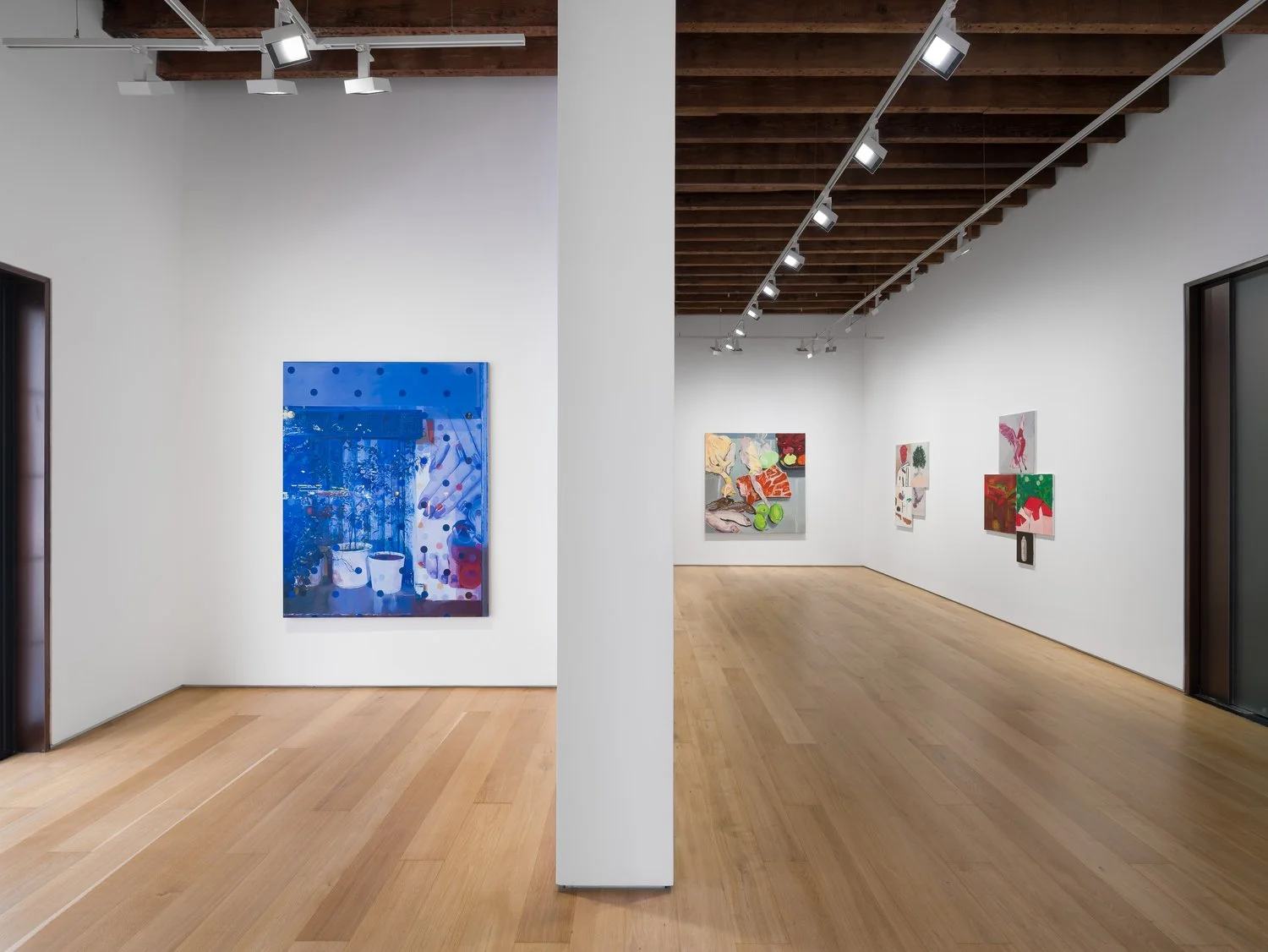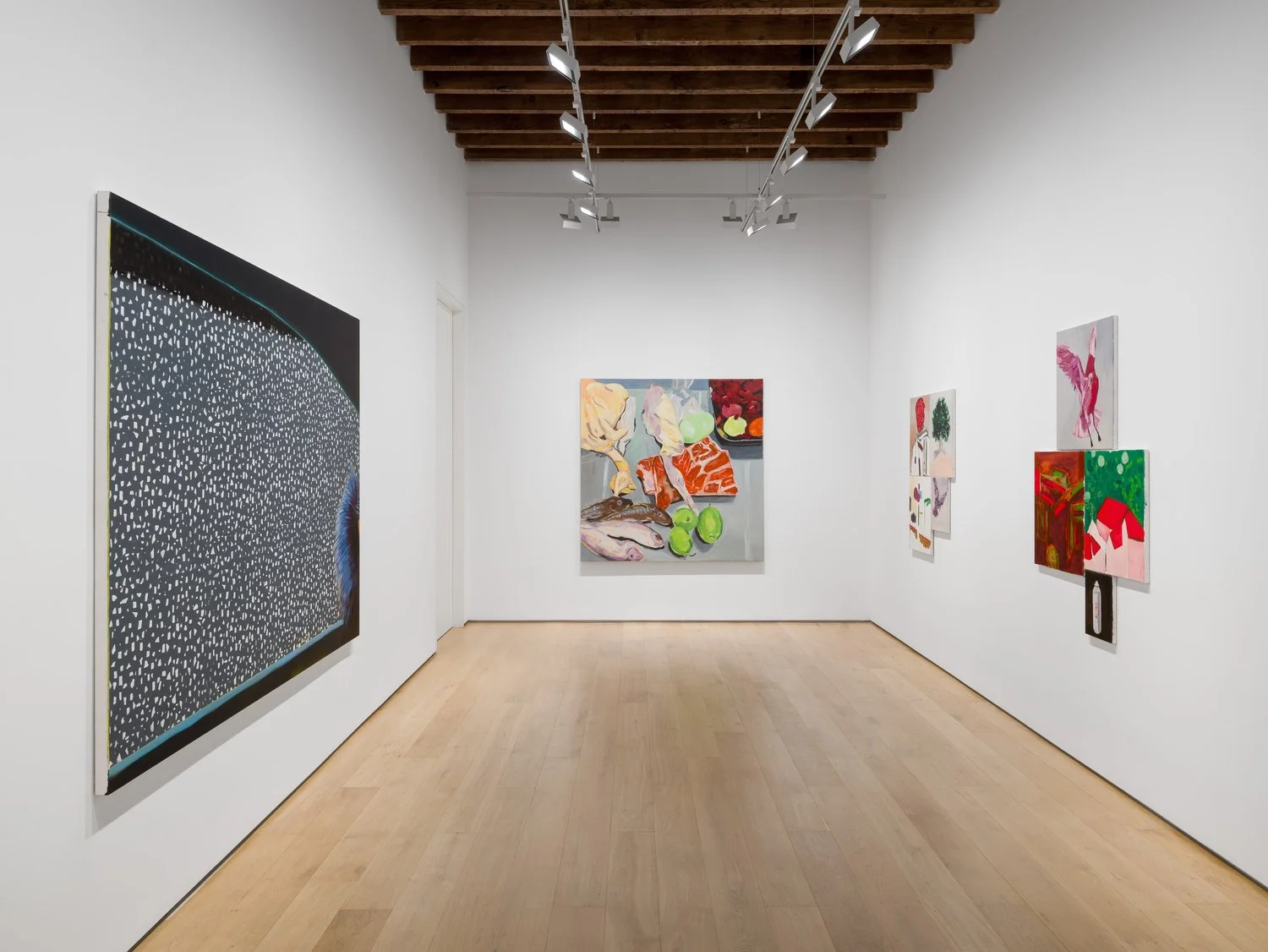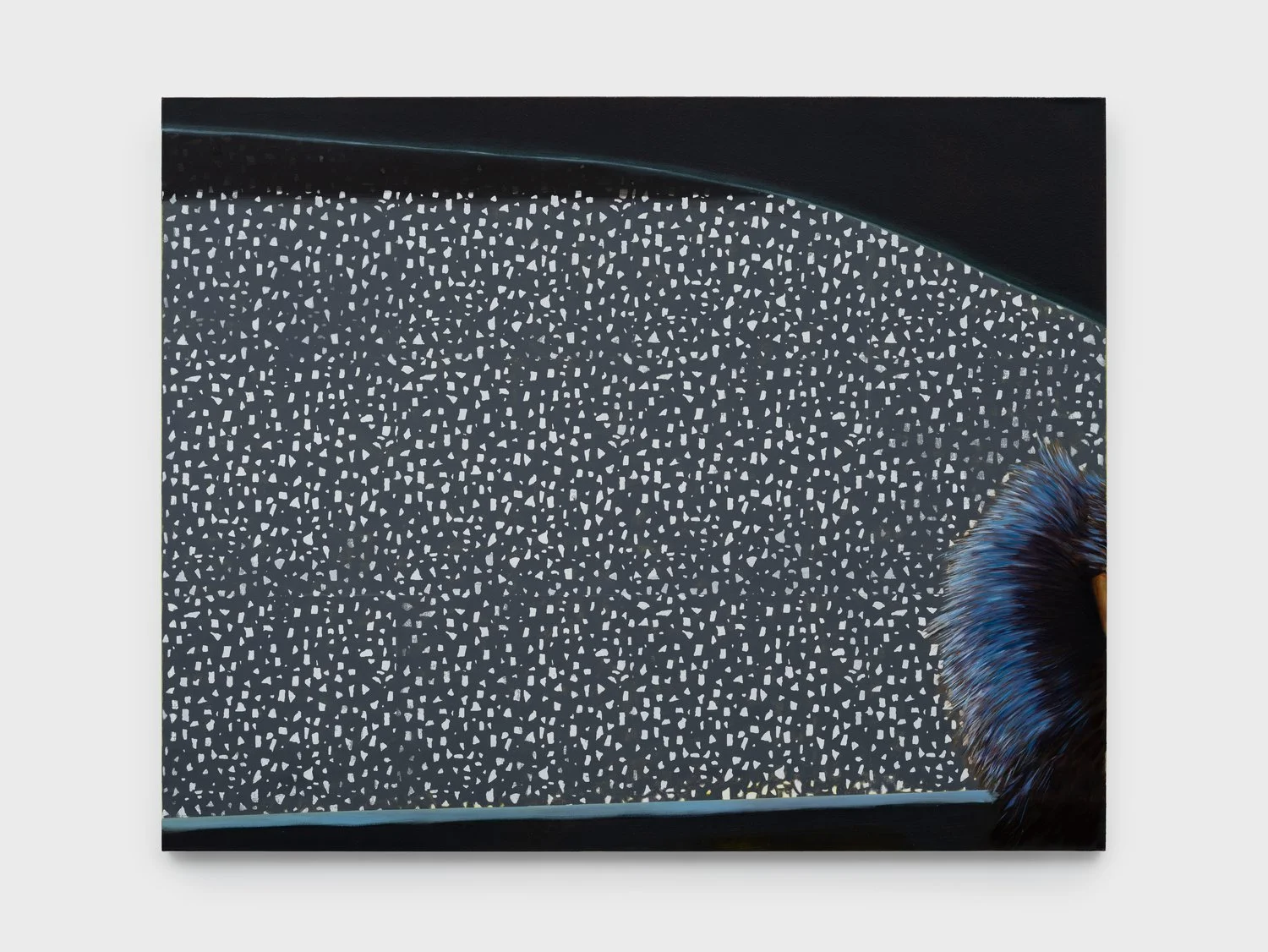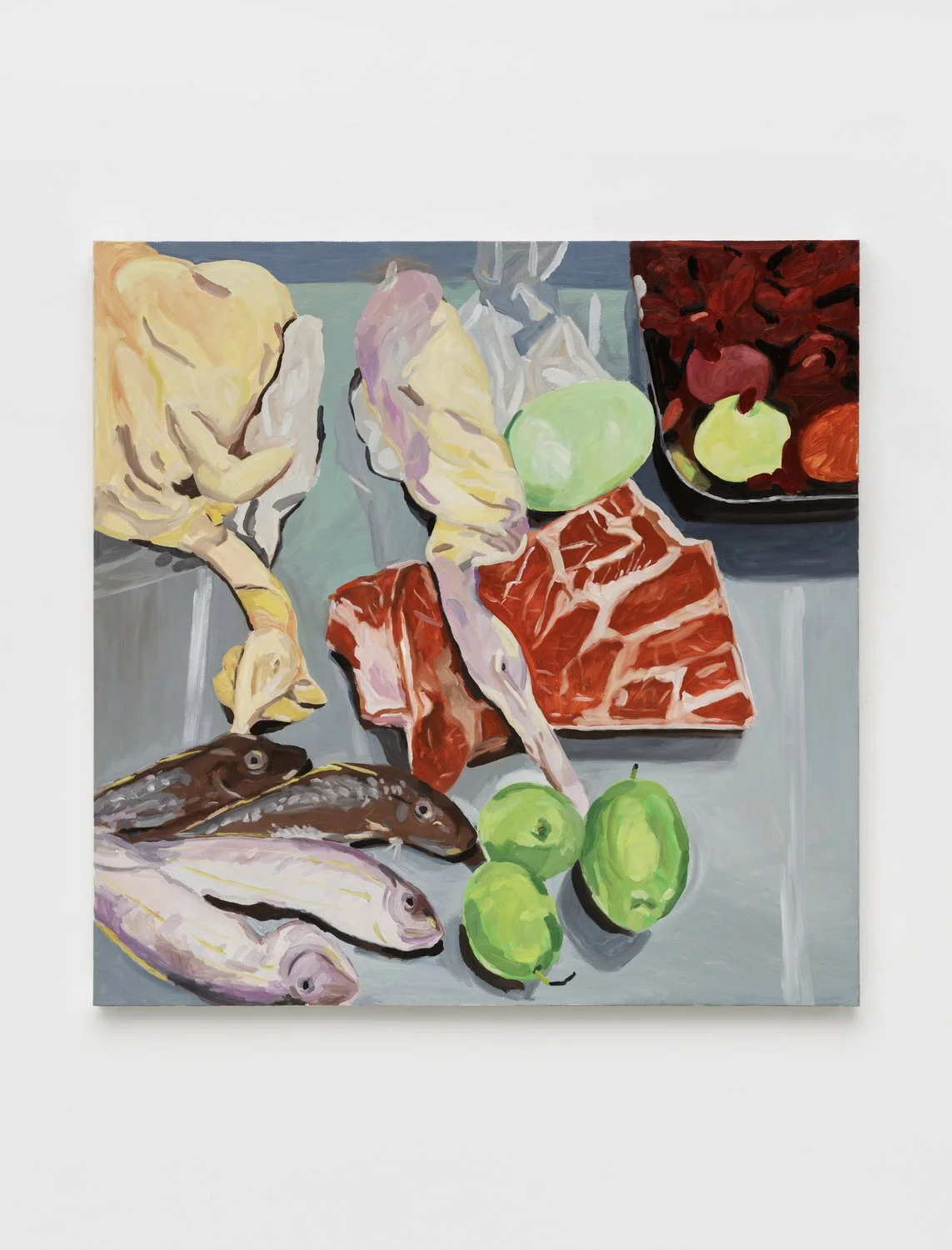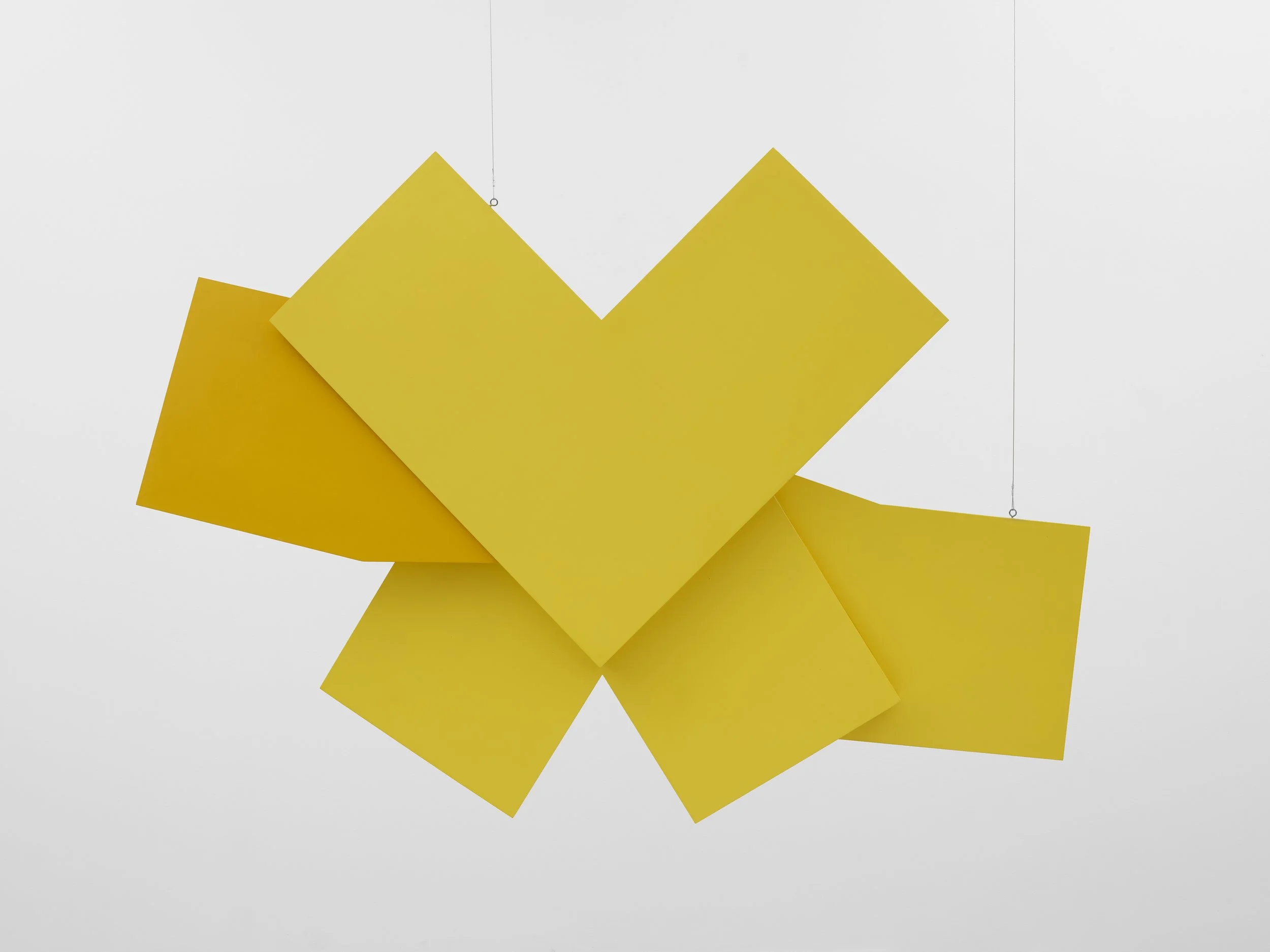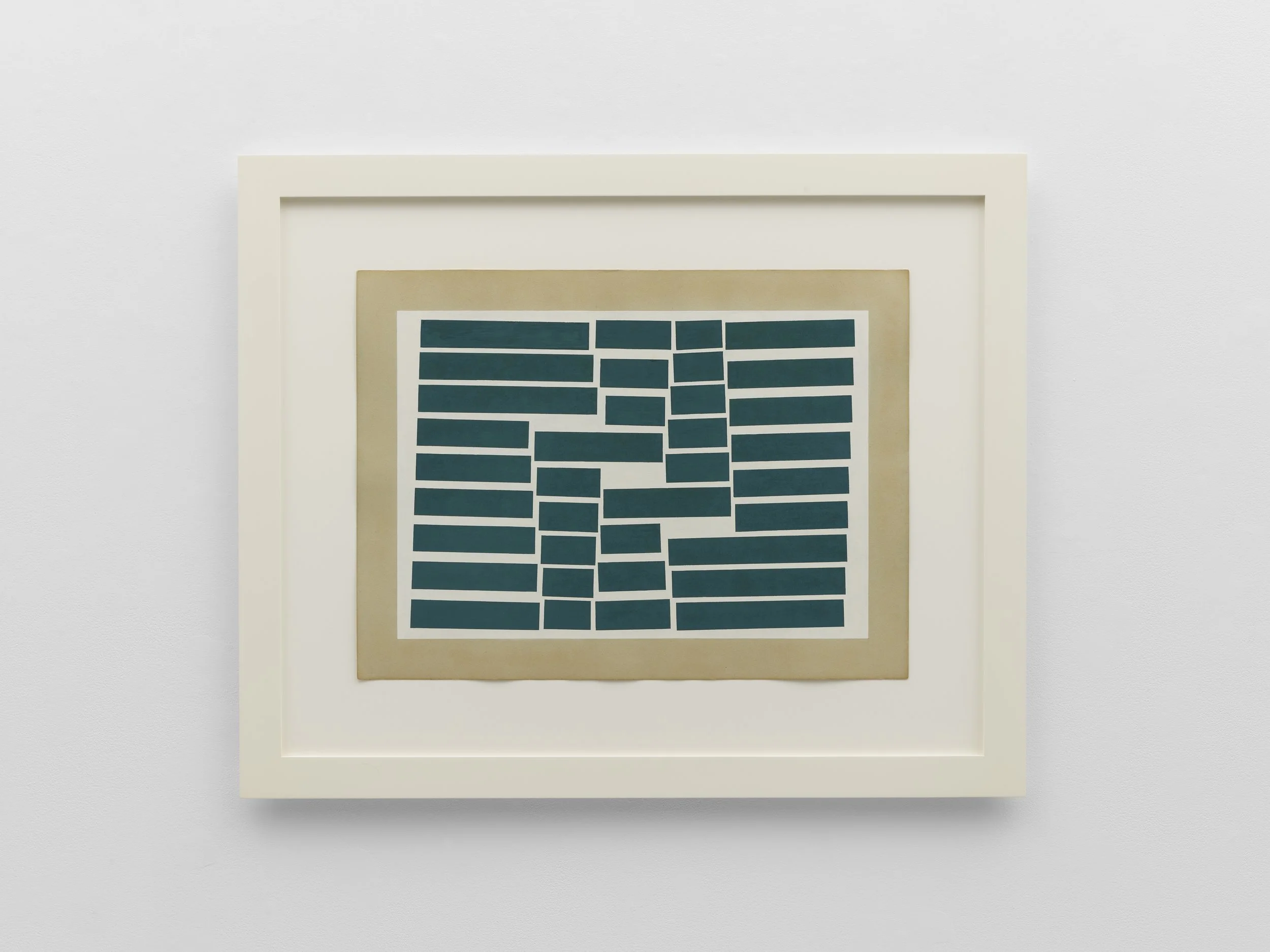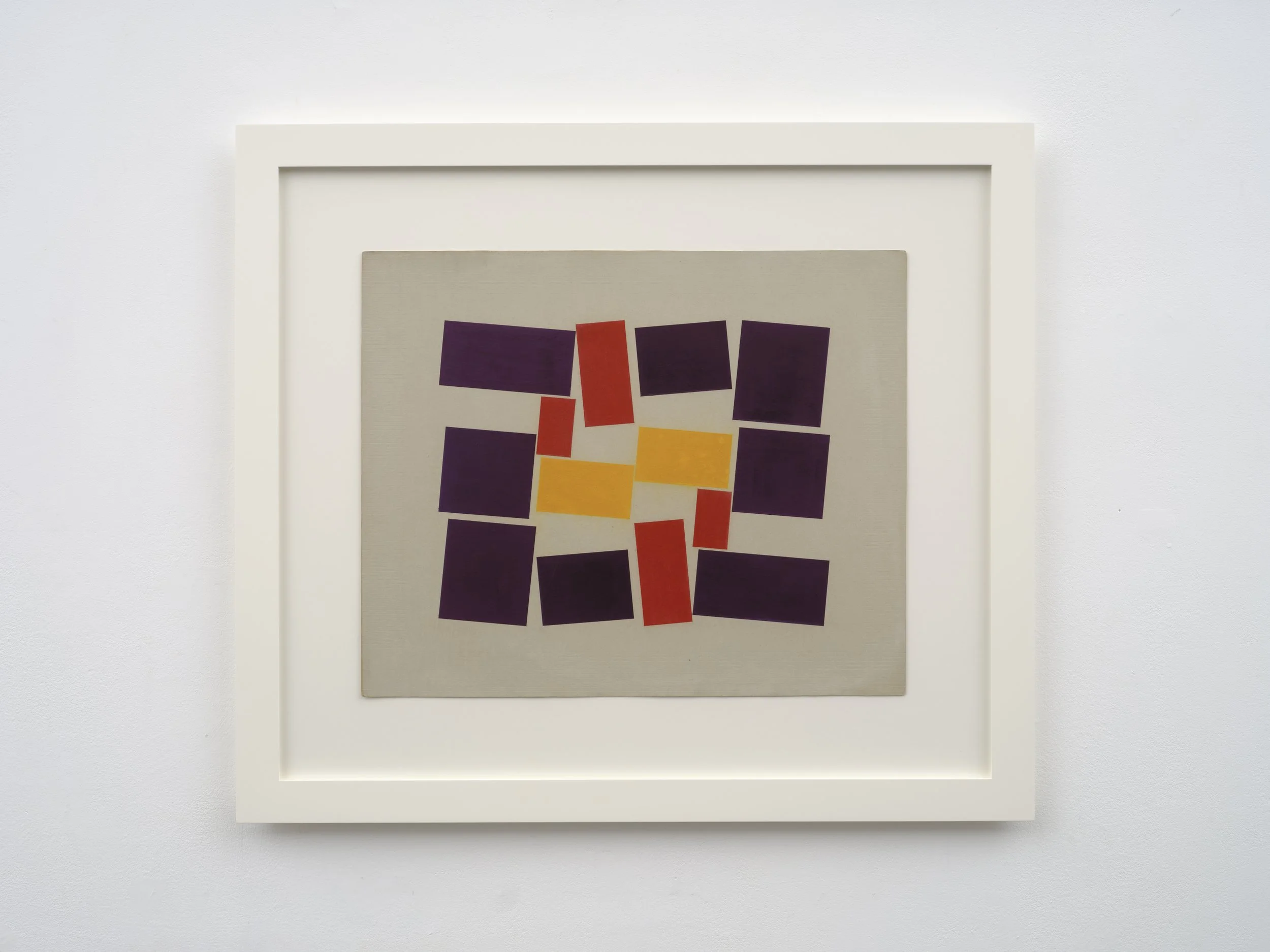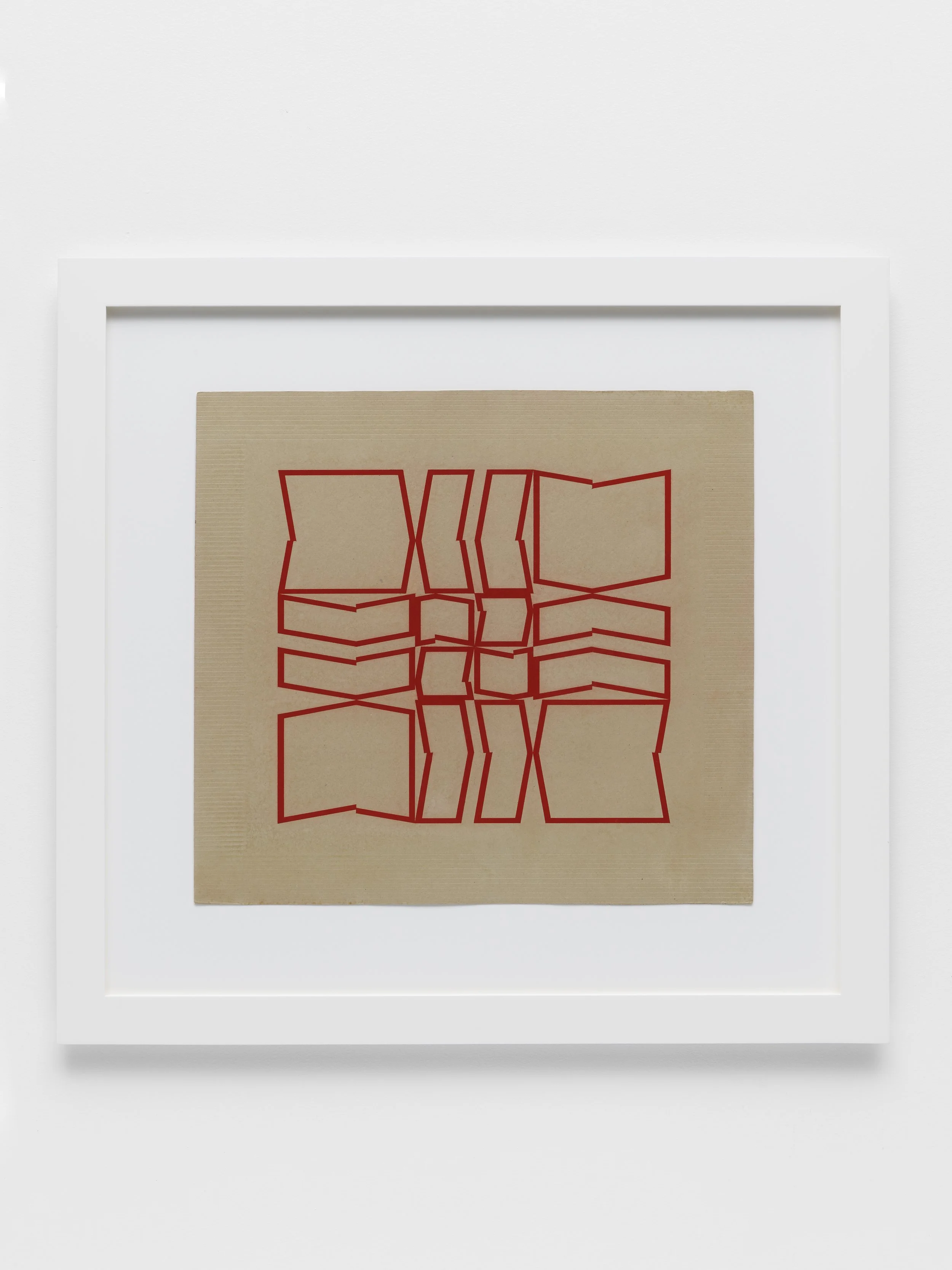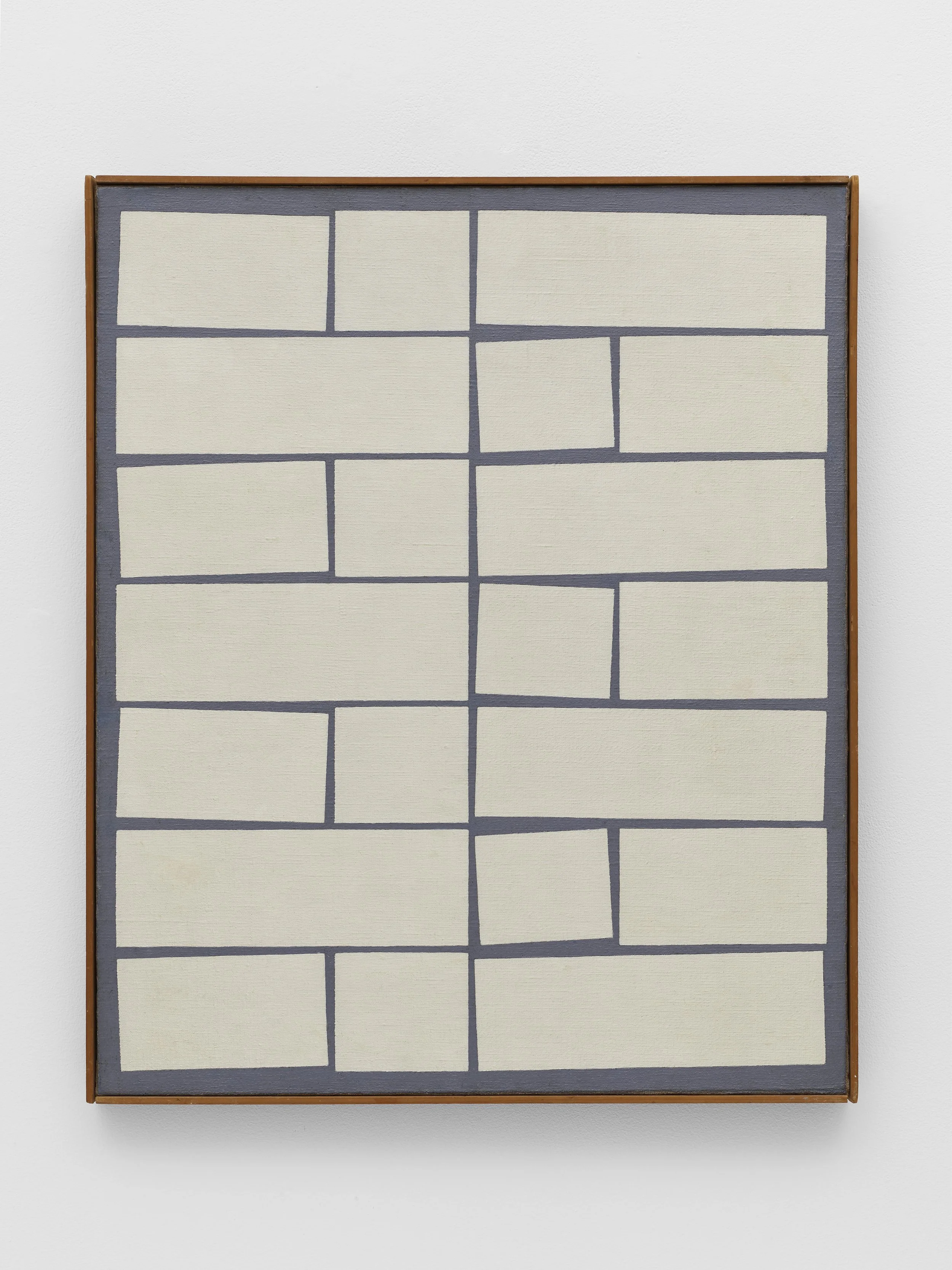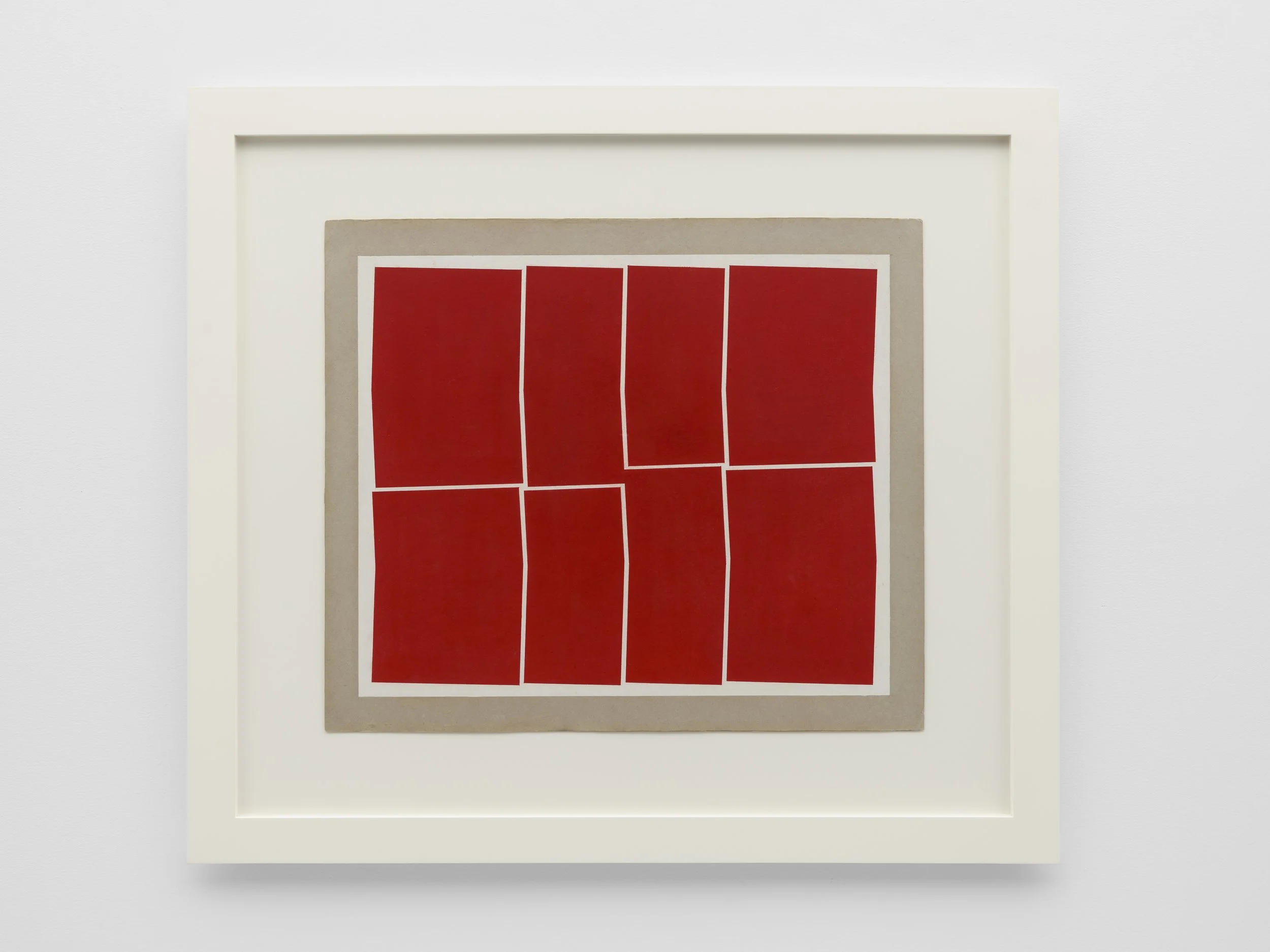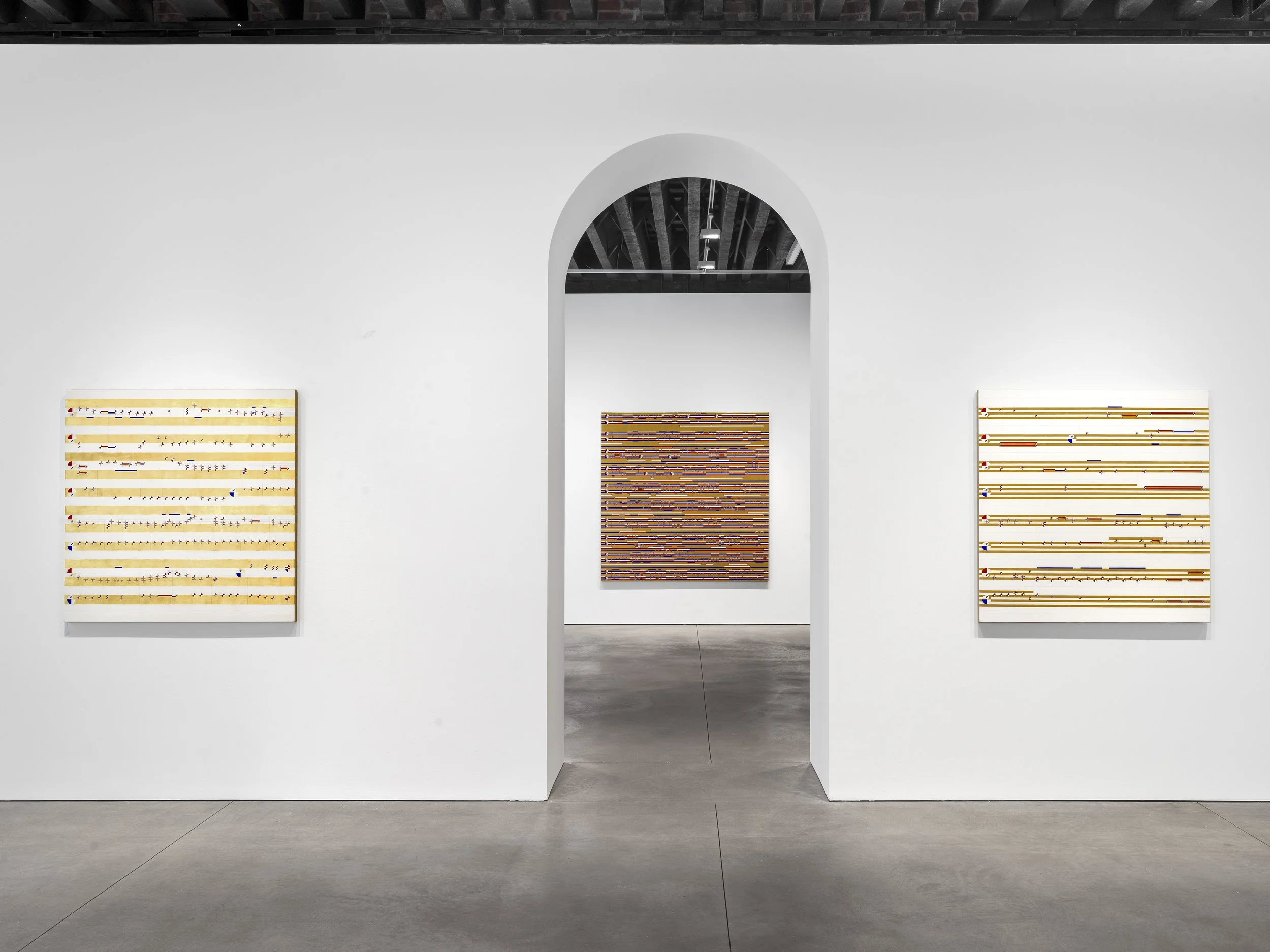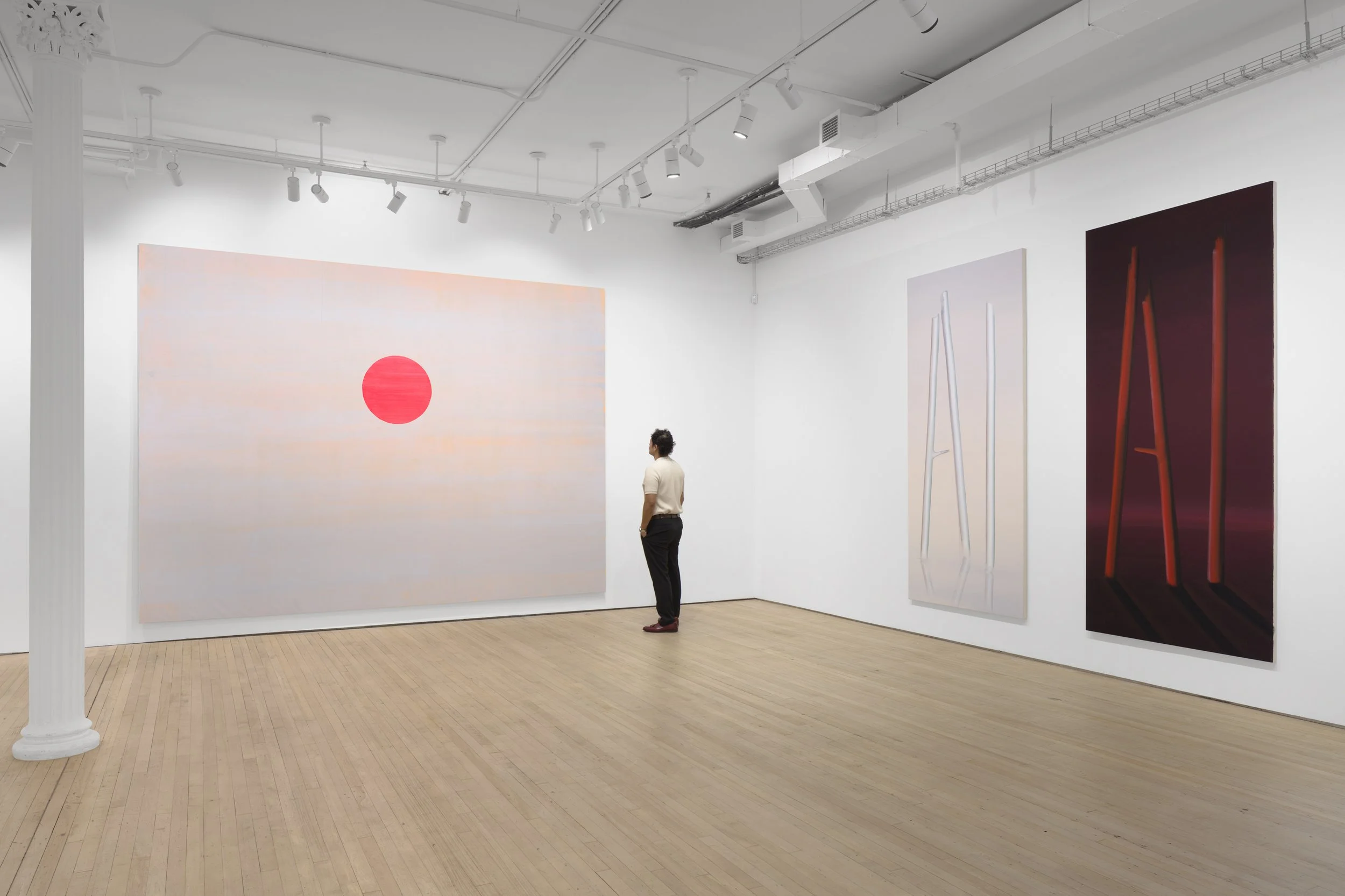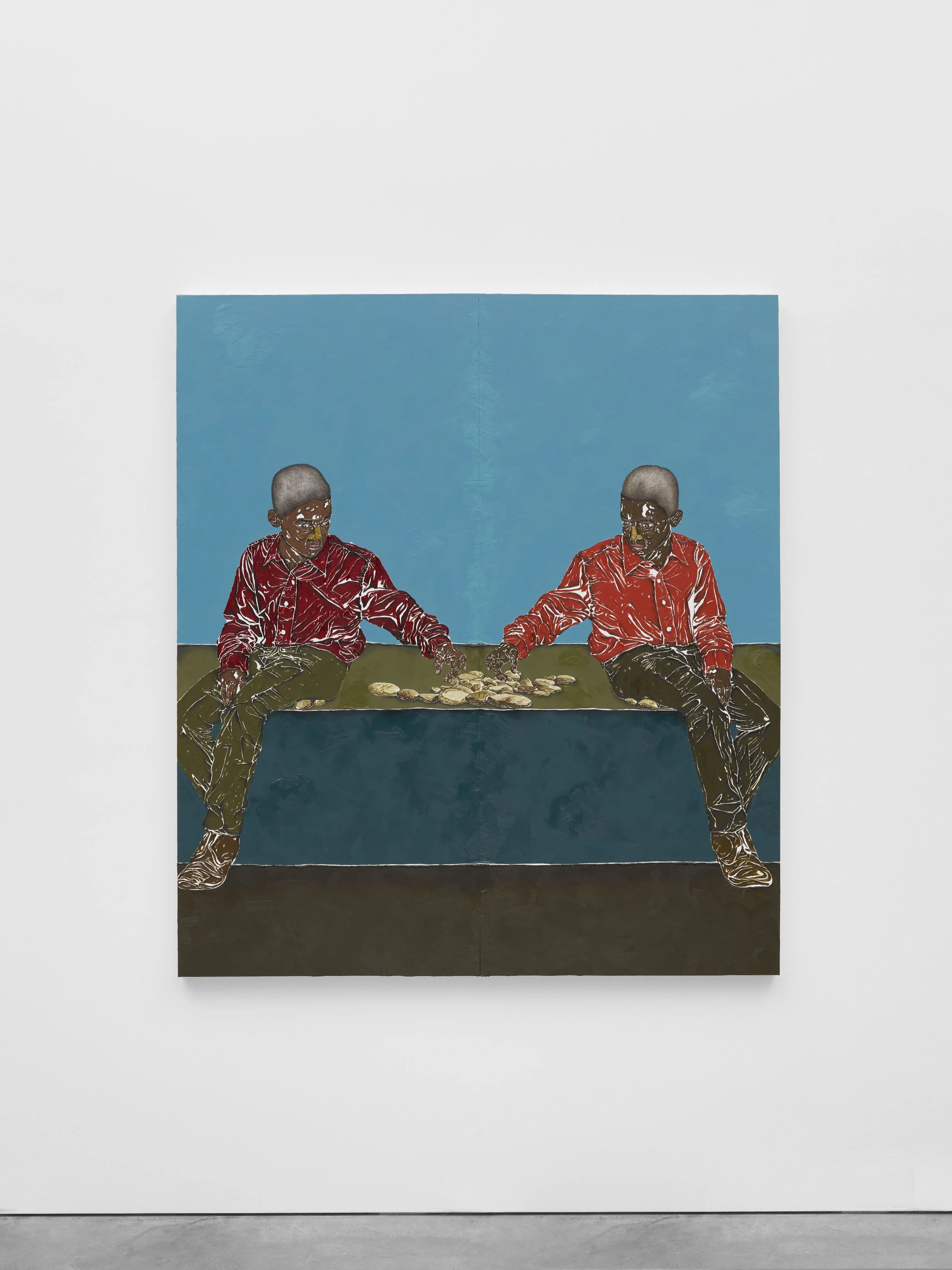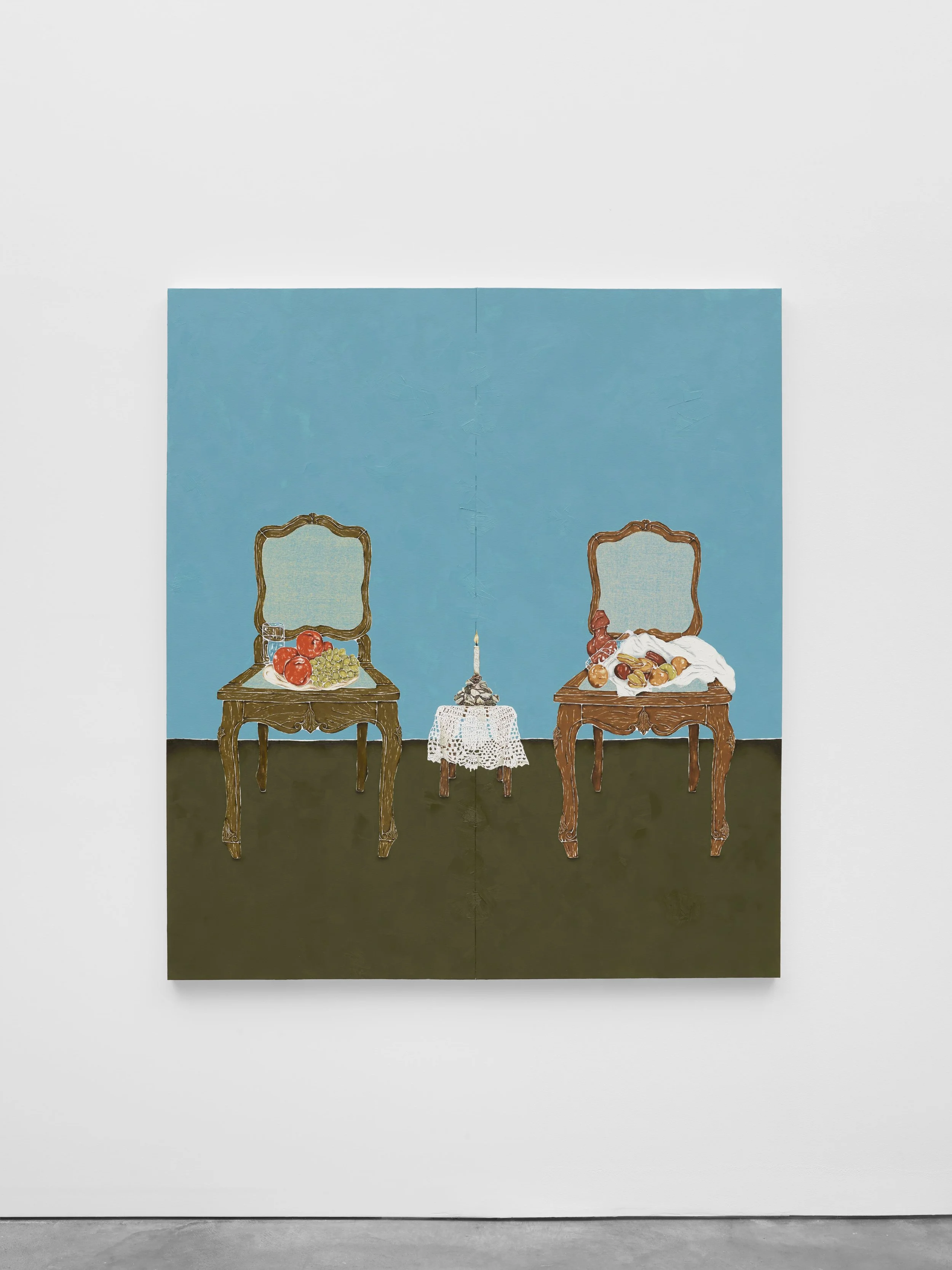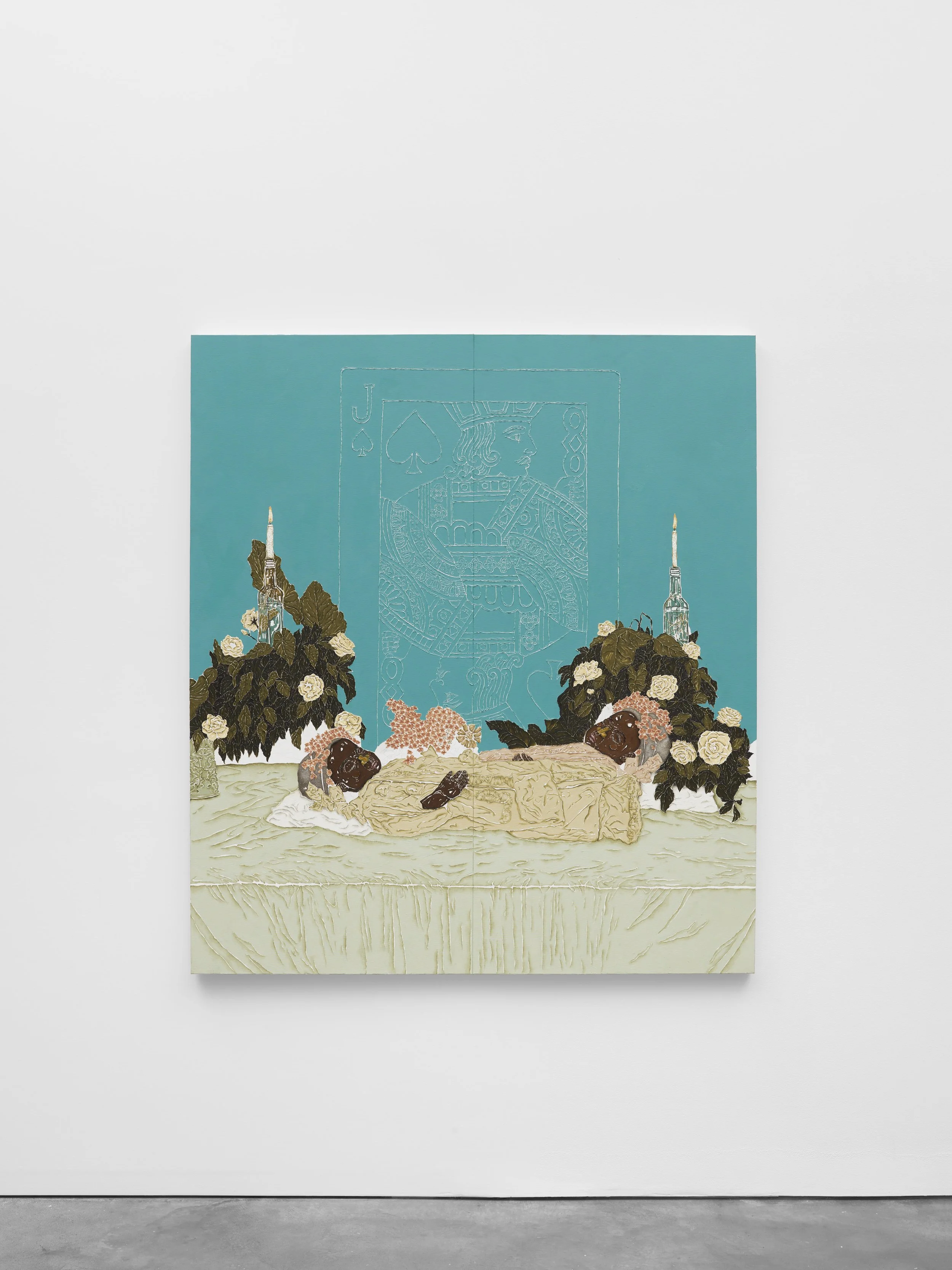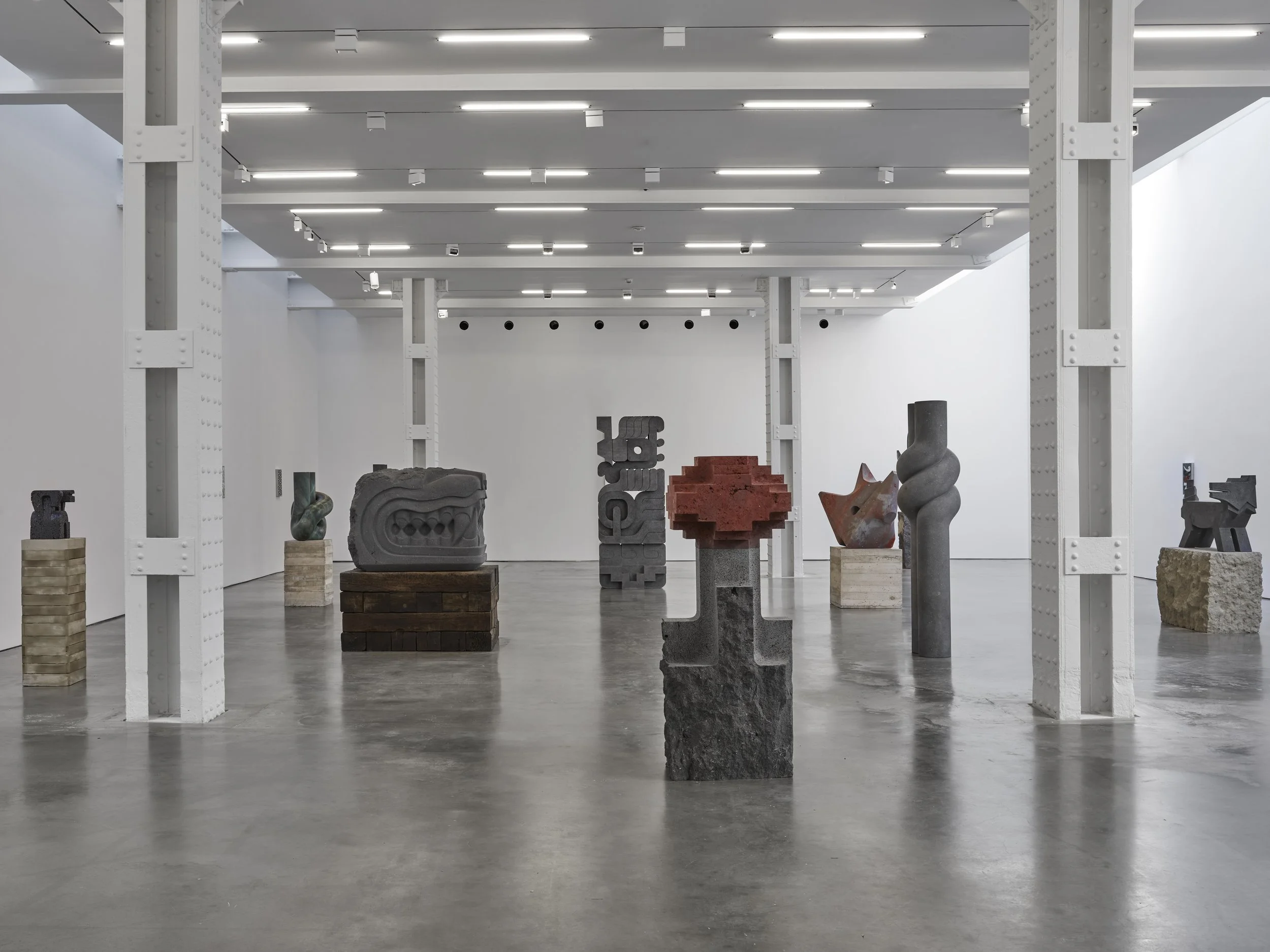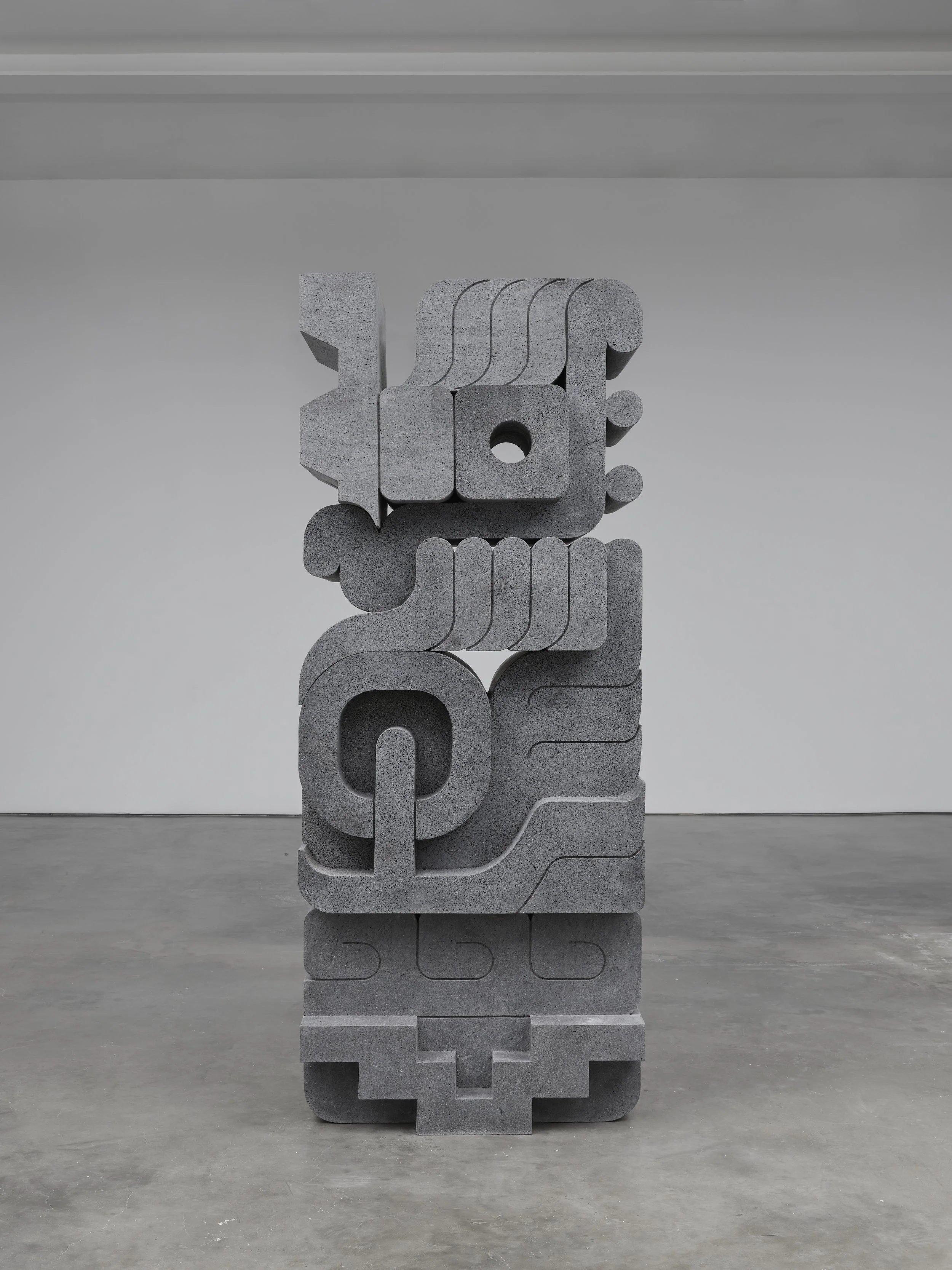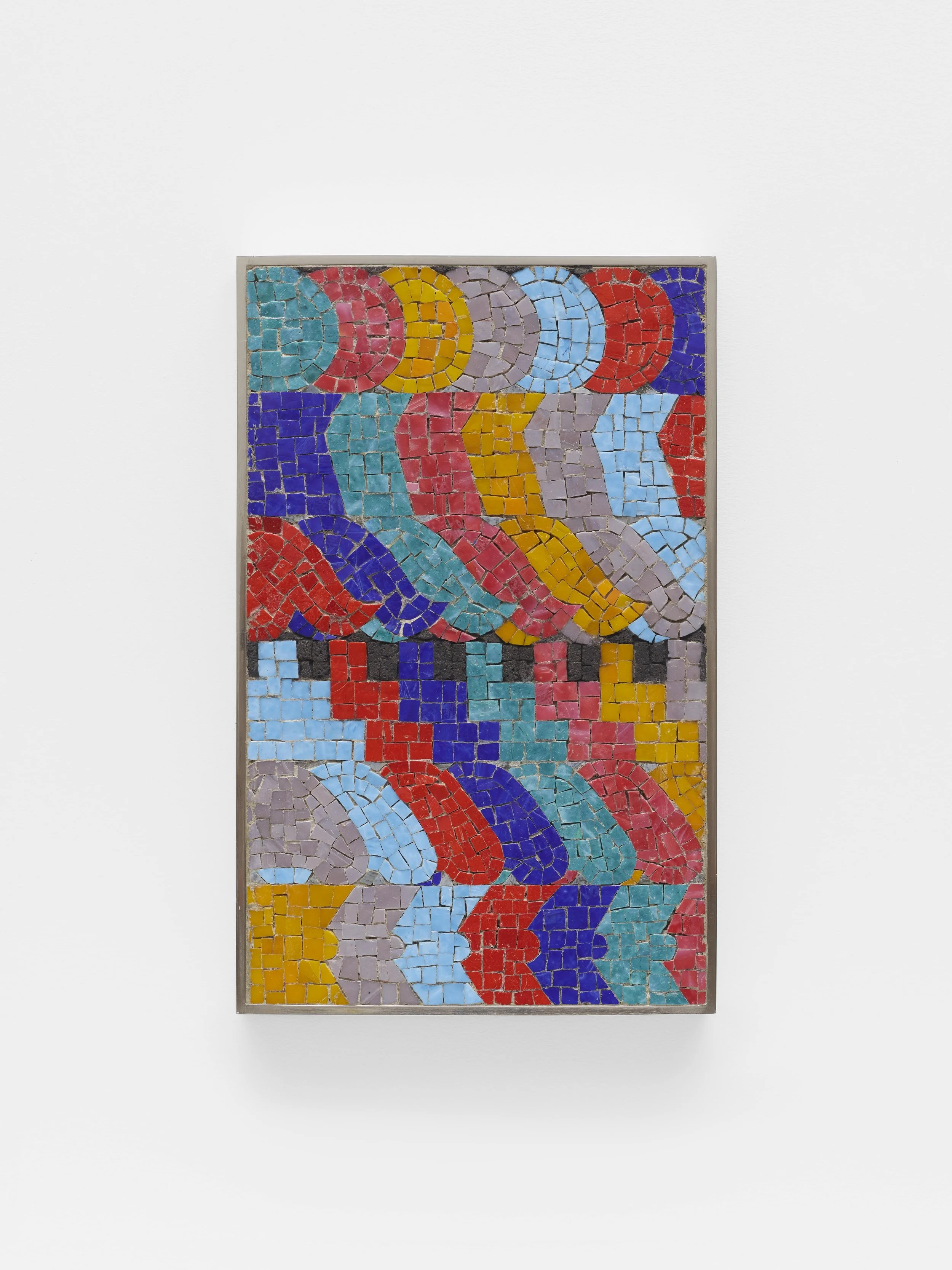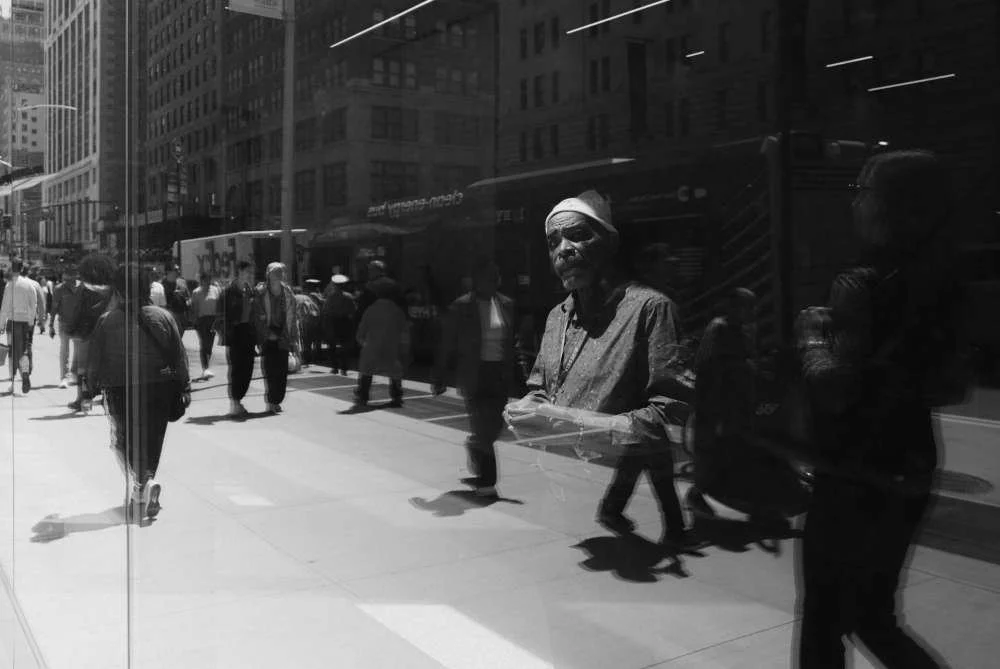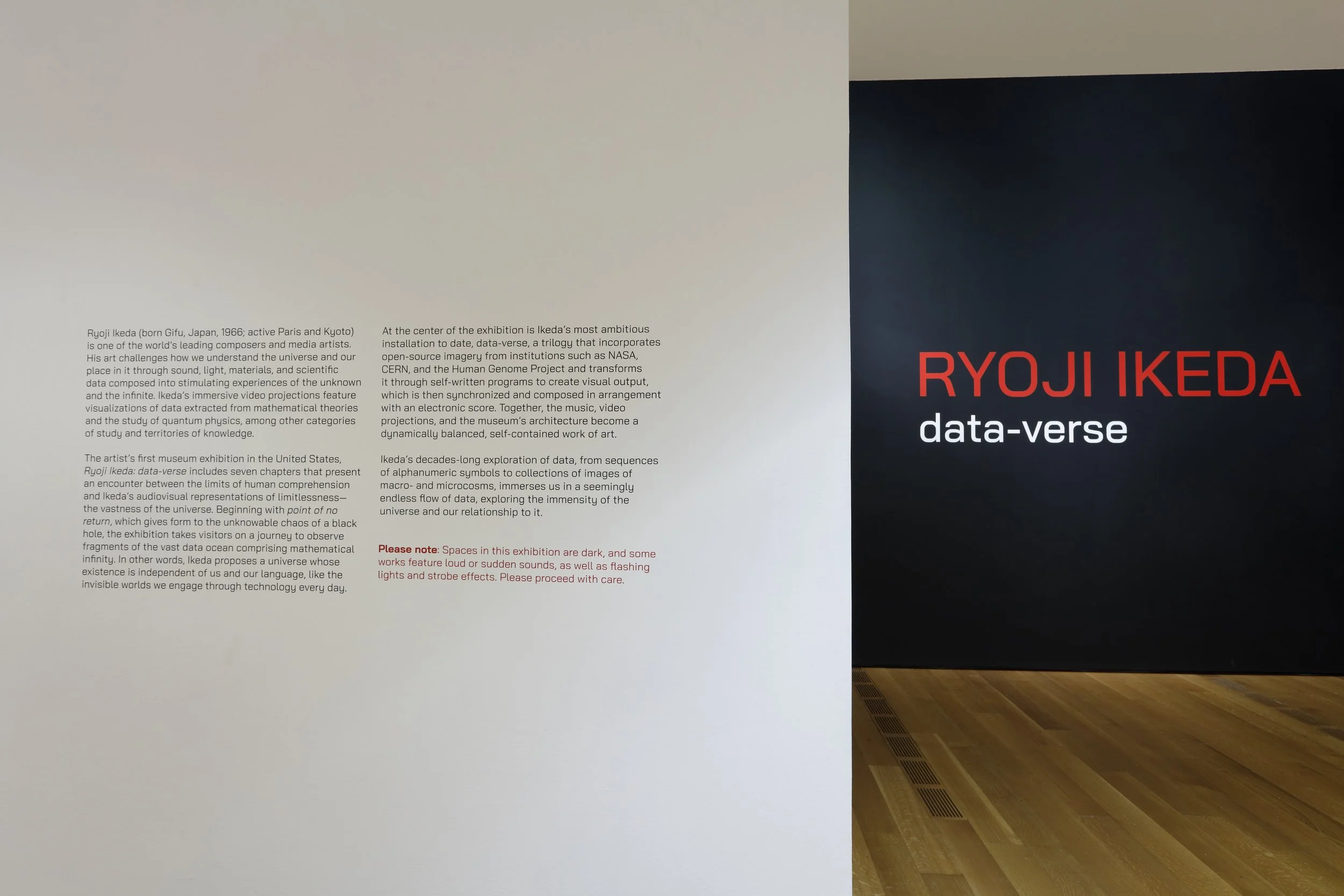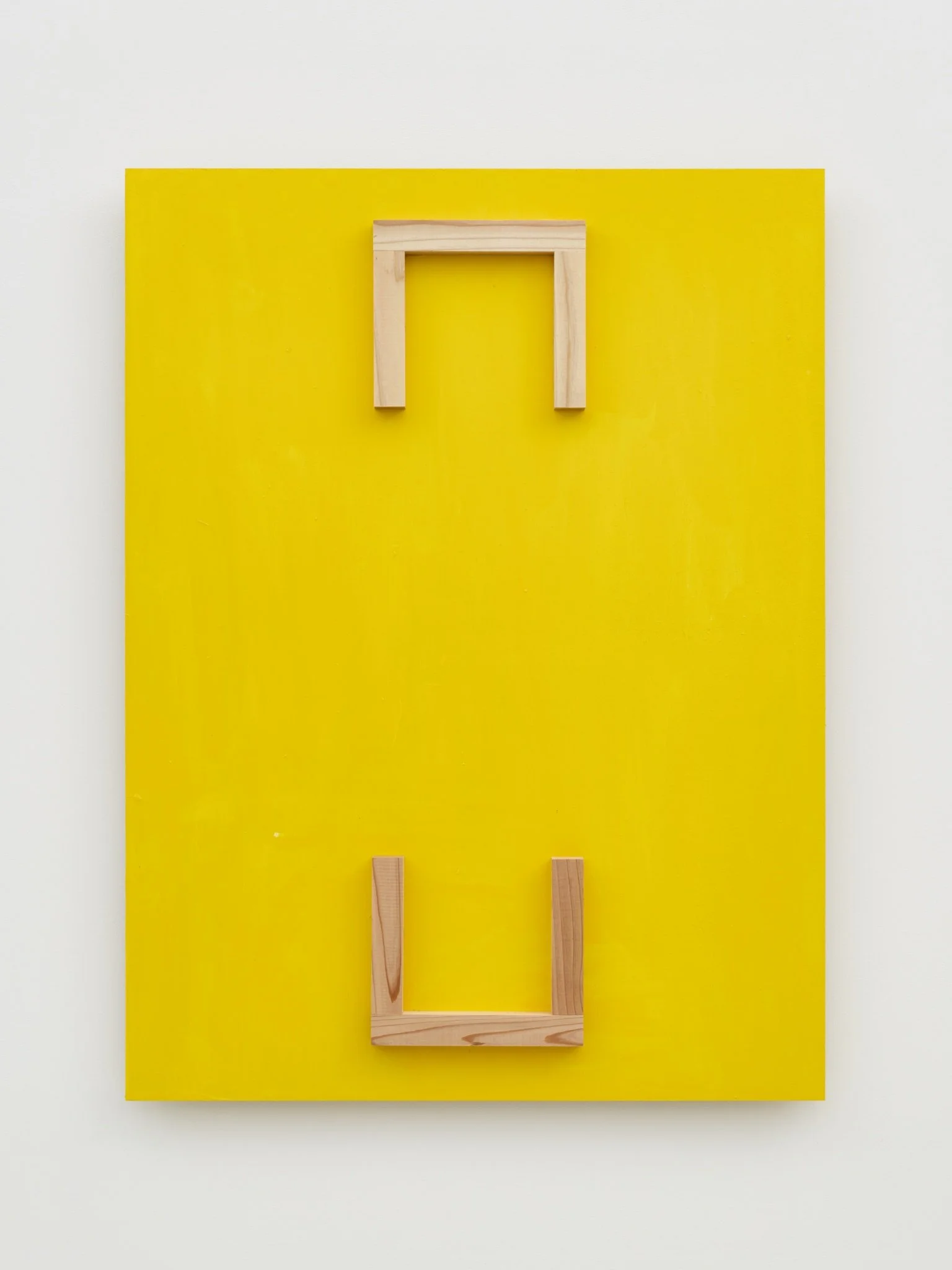Ruby Sky Stiler:Long Pose
Installation view: Ruby Sky Stiler: Long Pose, Alexander Gray Associates, New York, 2025
Alexander Gray Associates, New York presents Ruby Sky Stiler: Long Pose, the artist’s first solo exhibition with the Gallery. The show features new paintings and a large-scale bas-relief mural that encircles the exhibition space. Together, these works expand Stiler’s exploration of art historical archetypes, as she recasts traditions of figuration and the nude through a contemporary lens. The exhibition’s title invokes the academic convention of life drawing from a posed model, highlighting Stiler’s ongoing dialogue with historical forms and techniques.
Stiler’s practice centers on the productive tension between abstraction and representation, and the interplay between flatness and dimensionality. Reworking Cubist fragmentation with classical and vernacular elements, she draws on her background in printmaking to create mosaic-like compositions assembled from hundreds of small, cropped drawings transferred into paint. The paintings on view are primarily rendered in shades of blue, with fractal-like geometries derived from subtle gradations that allow fine details to blend into harmonious compositions. The figures that emerge from these layered tapestries are clear yet precarious, as if on the verge of dissolving into pure form. As the artist explains, “They are almost falling apart into geometry—you take one thing away and they would be just shapes.”





Installation view: Ruby Sky Stiler: Long Pose, Alexander Gray Associates, New York, 2025
This economy of form is evident in the exhibition's titular work Long Pose (2025), a bas-relief mural that unifies Stiler’s paintings within a linear architectural framework. Constructed from wood and painted in a warm earthen hue reminiscent of Pompeiian Red, it reflects Stiler's interest in the shifting nature of historical memory, as this ostensibly ancient color reveals as much about modern restoration as it does about Pompeii’s original palette. Long Pose's ruddy tone and sizeable proportions also recall monumental, weathered steel sculptures by artists like Richard Serra and Mark di Suvero—an imposing aesthetic that Stiler subtly resists. Though substantial in scope, Long Poseleaves the floor space navigable. Visually and materially, it remains light—sculpture, as the artist describes it, “that does not define your path; it does not push you around.” The abstracted, sinuous figures lining the walls are inspired by caryatids, the classical architectural form of female figures bearing structural weight. In Stiler’s hands, these forms move beyond gendered symbolism to become universal emblems of resilience.
Installation view: Ruby Sky Stiler: Long Pose, Alexander Gray Associates, New York, 2025
Stiler's exploration of the politics of representation counts on a wide range of historical references, including Bauhaus architecture, Art Deco ornamentation, and the graphic patterns of Modernist designers such as Anni Albers and Alexander Girard. Alongside these allusions, her paintings incorporate intimate, diary-like drawings—her own spontaneous sketches, her children’s artwork, and imagery from popular children’s books. Drawing on Louise Nevelson’s collage ethos—defined by fragmentation, layering, and recontextualization—Stiler creates hand-assembled compositions that blur the lines between sculpture, collage, and installation.
Installation view: Ruby Sky Stiler: Long Pose, Alexander Gray Associates, New York, 2025
Family and youth are recurrent themes throughout the exhibition. Stiler’s paintings offer expanded portrayals of kinship, depicting female-led social structures, solitary matriarchs, and father-child bonding. The patriarchal foundations of academic drawing and classical ideals of the male body are similarly addressed, while other works respond to these precedents from a distinctly feminist perspective, rejecting idealization in favor of novel ways of imagining the nude. With the exhibition Long Pose, Stiler invites viewers to reconsider familiar visual and cultural conventions—not as fixed symbols, but as evolving forms that bridge time and experience. By merging the personal with the historical, Stiler refines her distinctive visual language, creating a framework, as she notes, “where viewers can find connections and resonances that speak to our shared humanity.”
Stiler has been the subject of multiple solo presentations, including New Patterns, The Frances Young Tang Teaching Museum and Art Gallery at Skidmore College, Saratoga Springs, NY (2022); Group Relief, Fairfield University Art Museum, CT (2020); Fresco, Saint-Gaudens Memorial Park, Cornish, NH (2019); Ghost Versions, The Aldrich Contemporary Art Museum, Ridgefield, CT (2015); and Inherited and Borrowed Types, Portland Institute for Contemporary Art, OR (2010), among others. Her work has been included in numerous group exhibitions including Friends & Lovers, FLAG Art Foundation, New York, NY (2023); No Forms, Hill Art Foundation, New York, NY (2022); Classic Beauty: 21st-Century Artists on Ancient [Greek] Form, Providence College Galleries, RI (2018); The Times, FLAG Art Foundation, NY (2017); We Are What We Hide, Institute of Contemporary Art, Maine College of Art & Design, Portland, ME (2013); and the Socrates Sculpture Park Emerging Artist Fellowship Exhibition, Socrates Sculpture Park, Queens, NY (2010), among others. Her work is in the collections of Fairfield University Art Museum, CT; Farnsworth Art Museum, Rockland, ME; The Frances Young Tang Teaching Museum and Art Gallery at Skidmore College, Saratoga Springs, NY; The Museum of Modern Art, New York, NY; and Rhode Island School of Design Museum, Providence, RI.
Installation view: Ruby Sky Stiler: Long Pose, Alexander Gray Associates, New York, 2025
Flora Yukhnovich. Bacchanalia
Installation view, ‘Flora Yukhnovich. Bacchanalia,’ Hauser & Wirth Downtown Los Angeles 30 October 2025 – 18 January 2026 © Flora Yukhnovich Courtesy the artist, Hauser & Wirth and Victoria Miro Photo: Keith Lubow
Los Angeles... Taking inspiration from art historical genres ranging from French rococo and Italian baroque to abstract expressionism, British artist Flora Yukhnovich creates paintings that celebrate materiality and process through shifting, chimerical forms, while seducing the viewer with elusive glints of content and meaning. For her first solo exhibition in Los Angeles and debut with Hauser & Wirth, Yukhnovich will present a new series of large-scale canvases prompted by the centuries old theme of Bacchanalia. In these canvases, lush, swirling brushstrokes evoke the dynamism and intense corporality of both ancient and contemporary hedonism, a past of satyric excesses and a present of consumerism and popular culture glut.
Party in the U.S.A. 2025 Oil on linen 210.8 x 408.9 cm / 83 x 161 in Photo: Elisabeth Bernstein
In ‘Bacchanalia,’ Yukhnovich explores the frontier at which excess—as a concept, and as a visual and material conceit—begins to obscure rather than illuminate. Her compositions, abstracted and layered with both intricate flourishes and forceful gestures, resist a single focal point. Details are engulfed in a cacophony of marks, where color and texture dominate the optical experience before forms can settle: each painting suggests a scene that is simultaneously dissolving and coalescing. Yukhnovich’s ability to capture such intense flux allows her to convey the precarious balance of seduction and alienation inherent in modern excess.
Teaser 2025 Oil on linen 200.6 x 175.2 cm / 79 x 69 in Photo: Elisabeth Bernstein
Drawing from a wide array of source images, Yukhnovich begins each painting by pinning visual artifacts to mood boards in her studio. As the work evolves, key references and throughlines emerge, shaping the compositional and chromatic variations that define each painting’s rhythmic logic. In ‘Party in the U.S.A’ (2025), Yukhnovich uses the Columbia Pictures logo, featuring its stately ‘Torch Lady,’ as a point of departure. While only traces of the torchbearer remain, she preserves the cinematic widescreen ratio, granting the rolling clouds and classical allusions a grandeur that both suggests the glory of power and warns of its undoing. In the catalogue for the exhibition, Yukhnovich reflects on the enduring power such motifs have exerted across eras and places, from Roman temples to Vegas interiors:





Installation view, ‘Flora Yukhnovich. Bacchanalia,’ Hauser & Wirth Downtown Los Angeles 30 October 2025 – 18 January 2026 © Flora Yukhnovich Courtesy the artist, Hauser & Wirth and Victoria Miro Photo: Keith Lubow
“
I’m interested in what happens when repetition drains symbolism—when something meant to signify order begins to feel unhinged. I’d like my paintings to capture that tipping point, layering imagery until structure gives way to excess. Like a bacchanalian unravelling or like a still life just before the fruit starts to rot.”
Fever Pitch 2025 Oil on linen 229.8 x 381 cm / 90 1/2 x 150 in Photo: Elisabeth Bernstein
Yukhnovich’s work processes centuries of iconography through a distinctly contemporary eye, folding the present into a broader aesthetic continuum of precedents. Among the works on view in the exhibition, two key references reflect this process. The first is the story of Heliogabalus, the young Roman emperor who, while ruling between 218 and 222 AD, allegedly drowned his party guests in rose petals. The second is Lawrence Alma-Tadema’s 1888 painting ‘The Roses of Heliogabalus,’ depicting this fantastical scene. To complete the work, Alma-Tadema had thousands of roses shipped from France to his studio in London, indulging in his own parallel act of imperial decadence. In ‘Bacchanalia,’ Yukhnovich mines these lavish spectacles for meaning while foregrounding the excess pleasures of painting itself.
Seeing Pink Elephants 2025 Oil on linen 209.5 x 454.6 cm / 82 1/2 x 179 in Photo: Elisabeth Bernstein
‘Bacchanalia’ at Hauser & Wirth Downtown Los Angeles will coincide with ‘Flora Yuknovich’s Four Seasons’ at The Frick Collection in New York (3 September 2025 – 9 March 2026), a site-specific mural by the artist in response to François Boucher’s Four Seasons series.
About the Artist
Born in Norwich, United Kingdom, in 1990, Yukhnovich’s characteristic painting language emerged during a period of study as a student at City & Guilds of London Art School, where she completed her MA in 2017. Most recently Yukhnovich has had solo exhibitions at the Ashmolean Museum, Oxford, UK (2023); The Wallace Collection, London, UK (2024); Ordrupgaard, Charlottenlund, Denmark (2024) and, currently, The Frick Collection, New York NY (2025 – 2026). Her work is held in prominent collections worldwide, including the Brooklyn Museum, Brooklyn NY; the Government Art Collection, UK; the Hirshhorn Museum, Washington, DC; the Montreal Museum of Fine Arts, Canada and the National Gallery of Victoria, Melbourne, Australia.
Learning
In response to ‘Bacchanalia,’ Flora Yukhnovich has contributed to a comprehensive learning program, interactive events and additional resources that will be developed in conjunction with the exhibition and partners Arts for Healing & Justice Network, Grand Arts and Inner-City Arts. Details were announced in October.
The exhibition opened on 30 October 2025 and will run through 18 January 2026 at Hauser & Wirth Downtown Los Angeles South Gallery. For more information about this title and others with Hauser & Wirth Publishing, please visit their site here. Please visit the Hauser & Wirth Gallery site for information about upcoming exhibitions. Also, follow the gallery on Instagram, Facebook, X, and YouTube.The magazine also highlighted the book of the same name, which can be found here.
Renée Condo: Niskamij – Sky World
Renée Condo: Niskamij – Sky World GAVLAK, West Palm Beach, November 15, and will run through December 13, 2025. Photography Courtesy of the artist and GAVLAK, West Palm Beach
GAVLAK, West Palm Beach, is pleased to present Niskamij – Sky World, a solo exhibition of new works by Montréal-based artist Renée Condo, marking her debut with the gallery. The presentation follows Condo’s large-scale installation recently unveiled at the 65th edition of the Montreal Museum of Fine Arts’ Museum Ball and extends her exploration of interconnection through a Mi’gmaq worldview. The exhibition opened on November 15 and will run through December 13, 2025.
Renée Condo: Niskamij – Sky World GAVLAK, West Palm Beach, November 15, and will run through December 13, 2025. Photography Courtesy of the artist and GAVLAK, West Palm Beach
Known for her sweeping beadwork compositions, Renée Condo’s visual language grows from the Mi’gmaq understanding that everything in existence is bound in relationship—each action, material, and being influencing the other in a living continuum. Working with thousands of individually sanded, painted, and arranged wooden beads, she constructs rhythmic surfaces that heighten attention to color, texture, and form. Each bead functions as both a distinct element and part of a greater whole, echoing the artist’s ongoing inquiry into the balance between individual and collective harmony.
In Niskamij – Sky World, Condo looks to Mi’gmaq cosmology and the ancestral realm that exists beyond the visible world. Here, creation unfolds as a continual process of becoming—cyclical, subject to renewals and realignments, and moving through thresholds that link the material and the spiritual. In Ga'qanei – Entranceway (2025), Condo explores the dialogue between self and source through mirrored imagery of the sun. Fields of color and form gather and disperse in quiet motion, while Mntu motifs occupy the spaces between—evoking the unseen forces that shape existence. While informed by her interest in physics and metaphysics, this body of work ultimately centers Indigenous understandings of time, energy, and relation.
Renée Condo: Niskamij – Sky World GAVLAK, West Palm Beach, November 15, and will run through December 13, 2025. Photography Courtesy of the artist and GAVLAK, West Palm Beach
Condo’s practice, while formally rigorous, is deeply sensorial. Guided by the Mi’gmaq principle of Heart Knowledge—which privileges feeling over intellect—she approaches each bead with intentional care, infusing the work with what she calls “energetic presence.” Viewers often describe the works as radiant or alive, their surfaces vibrating with quiet intensity. For Condo, this resonance embodies an exchange of energy between maker and viewer, material and meaning.
Throughout Niskamij – Sky World, Condo’s compositions invite contemplation of scale, from the subatomic to the celestial. The works evoke both the intimacy of touch and the vastness of space, offering a meditation on the interconnection of all existence. By merging Indigenous philosophy with the formal language of abstraction, Condo proposes a worldview where perception, matter, and spirit coexist in a state of presence and relation.
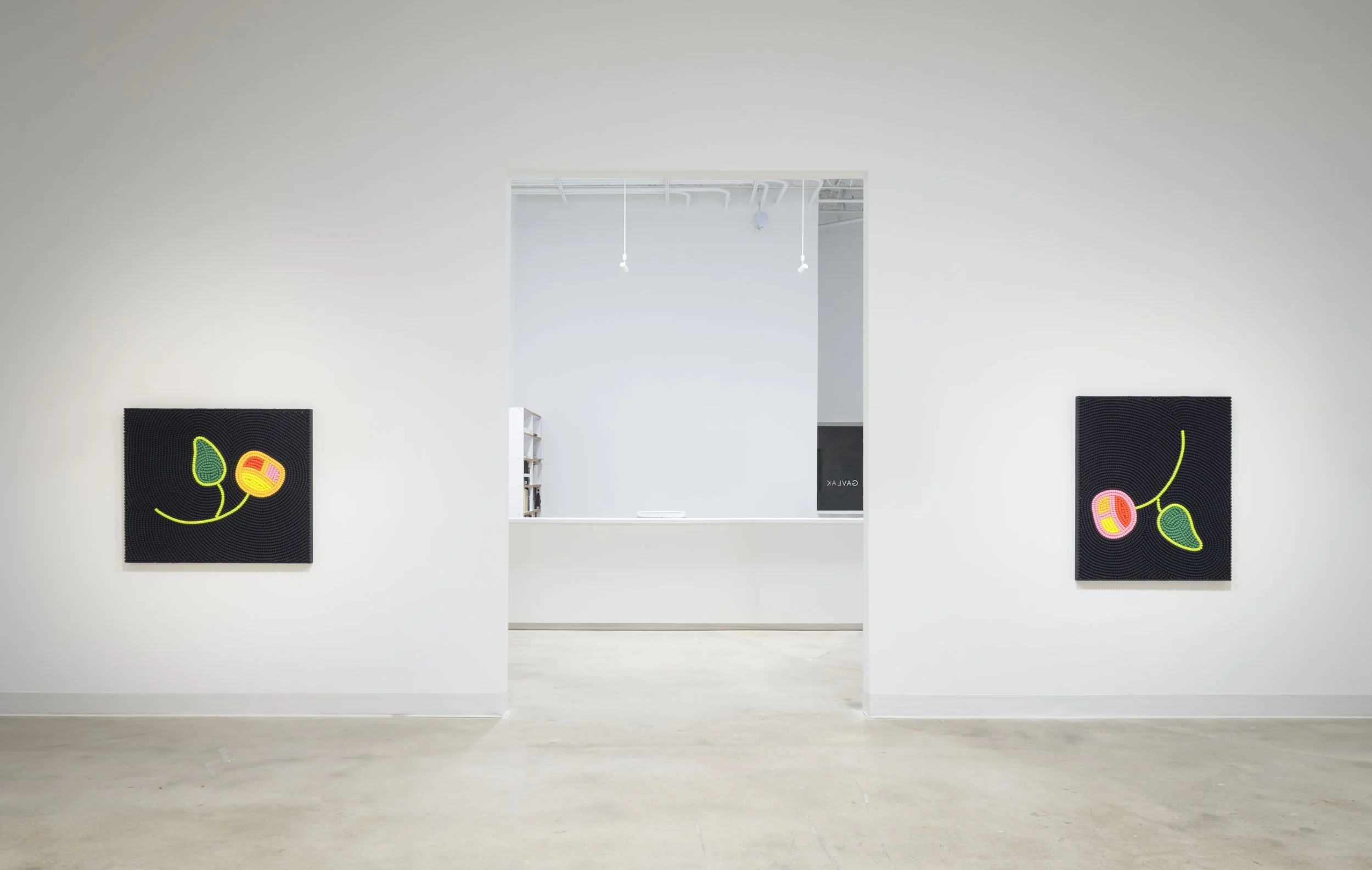
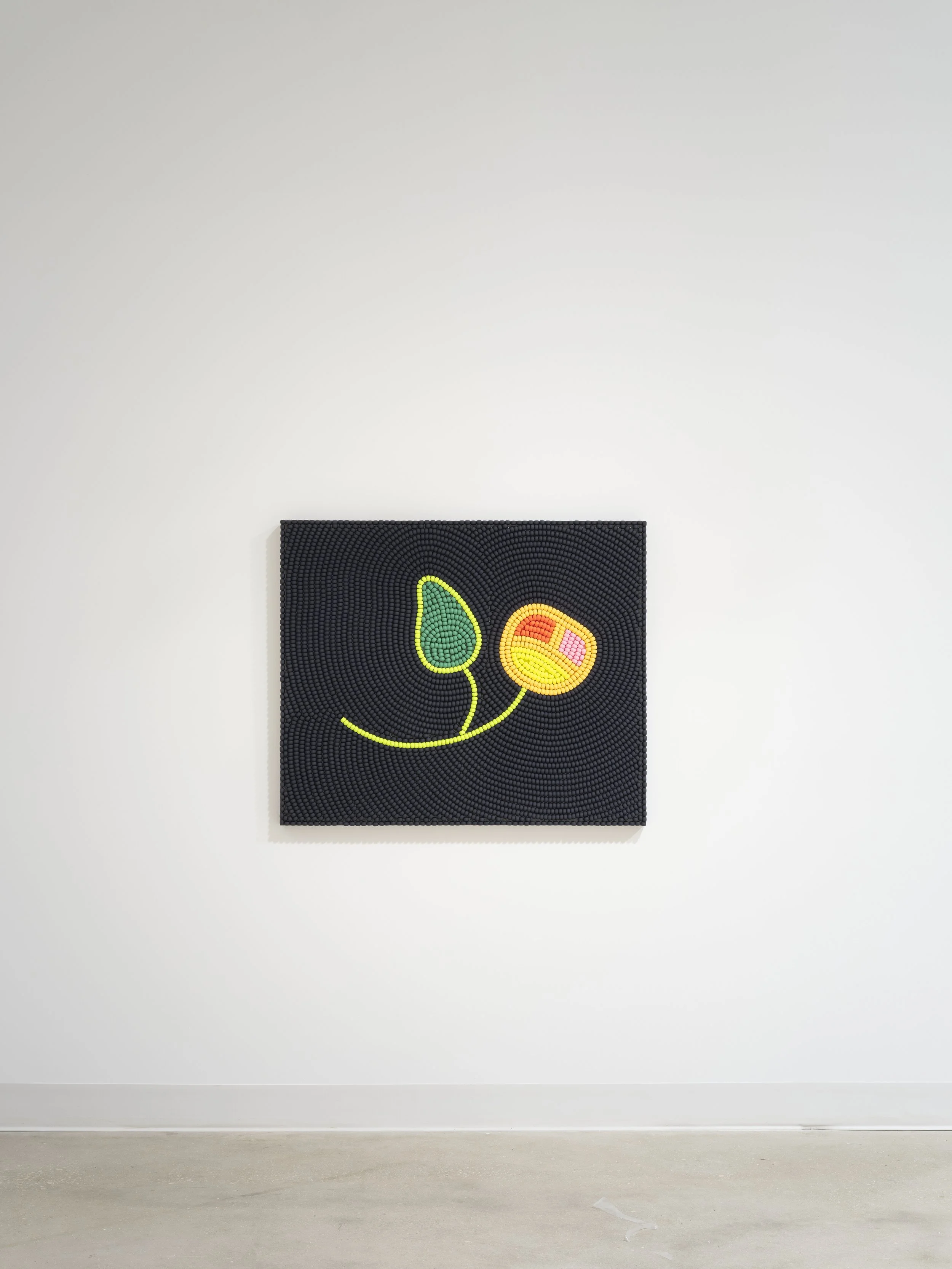
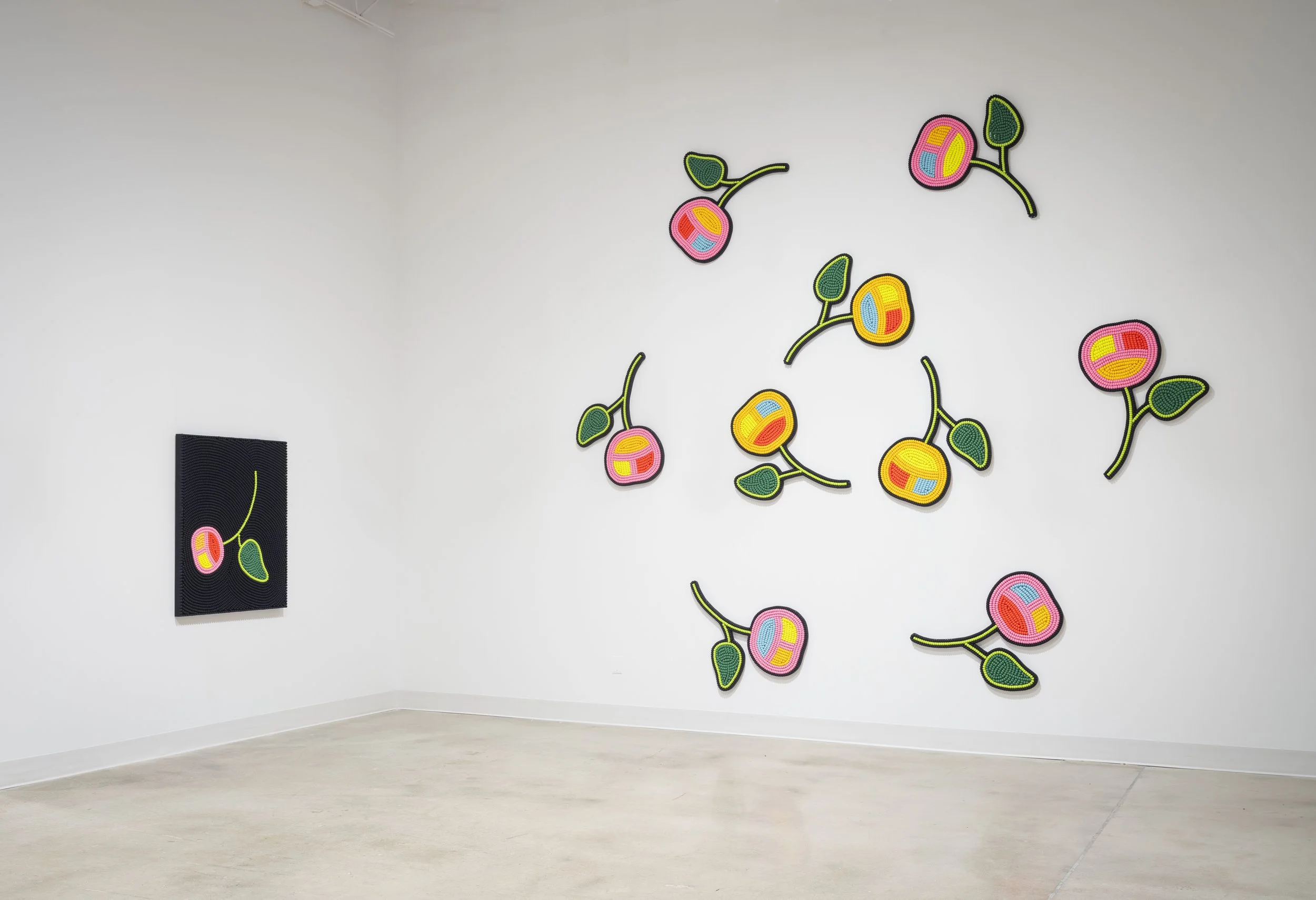
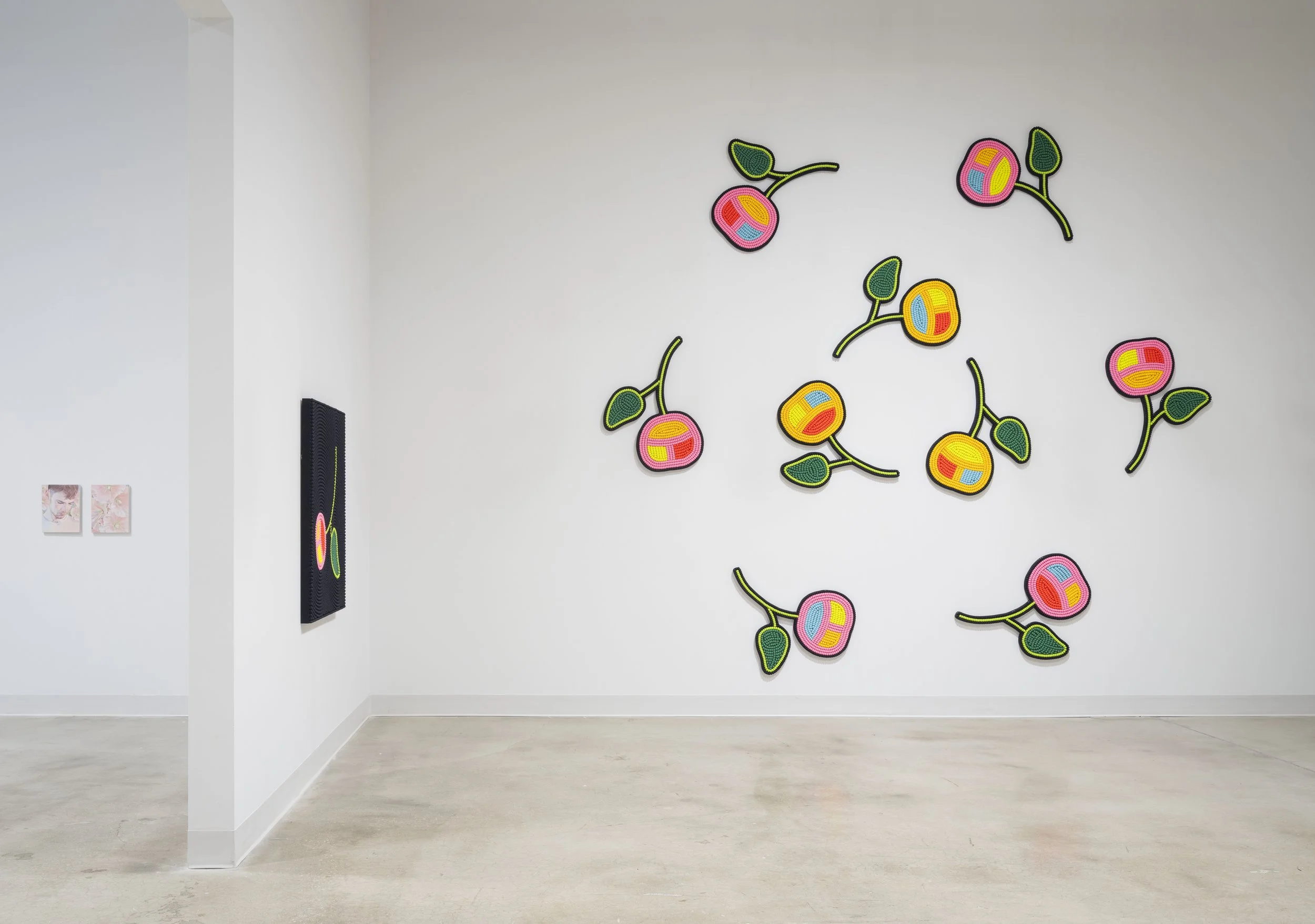


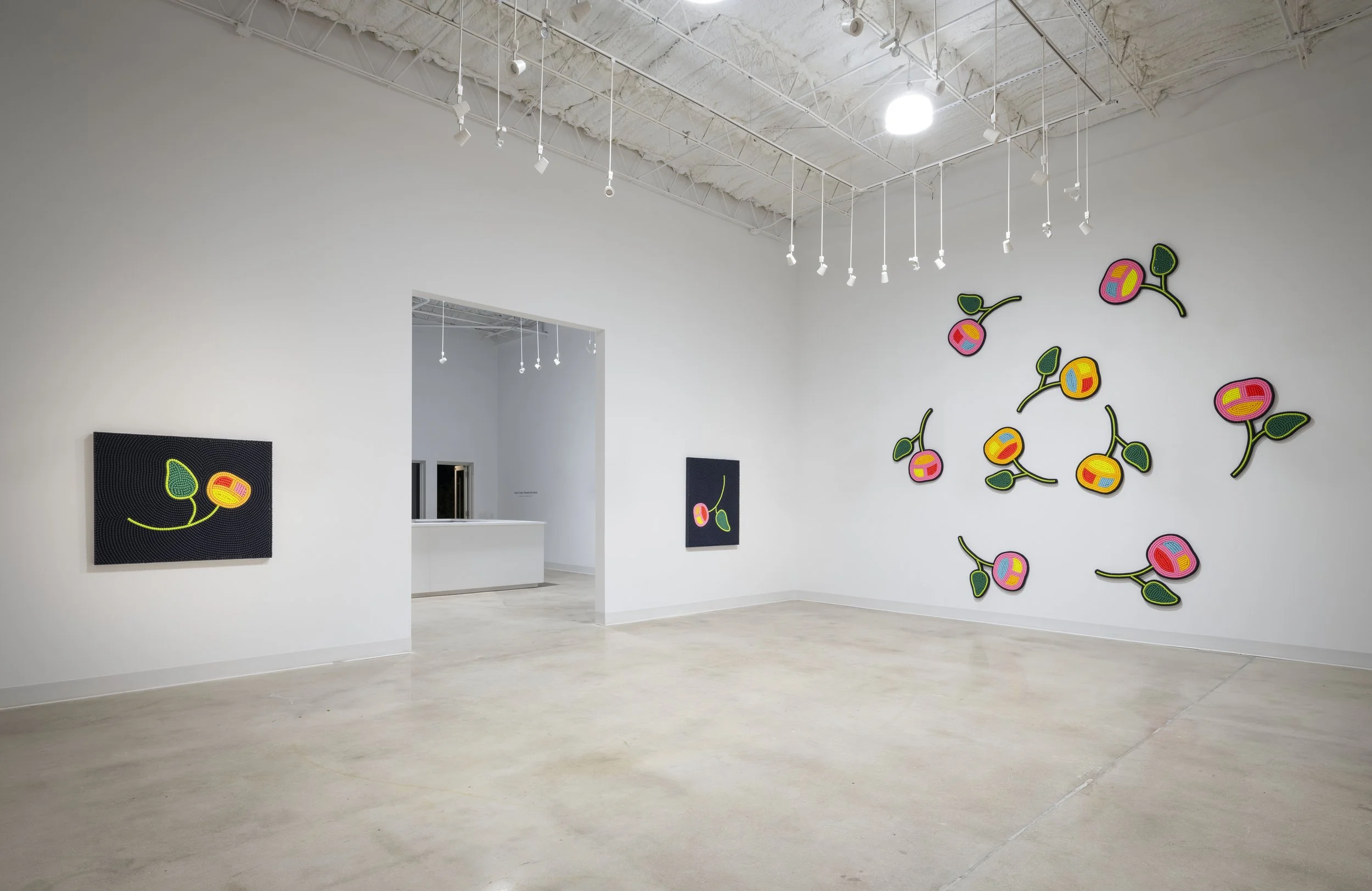

Renée Condo: Niskamij – Sky World GAVLAK, West Palm Beach, November 15, and will run through December 13, 2025. Photography Courtesy of the artist and GAVLAK, West Palm Beach
About the Artist
Renée Condo (b. 1979, Gesgapegiag, QC; lives and works in Tiohtià:ke, Montréal, QC) holds a BFA in Studio Arts and an MFA in Sculpture from Concordia University. Condo’s solo exhibitions include One who shatters particles, one who smells flowers, Blouin Division, Montreal, QC (2025); Shifting Perspectives, Warren G. Flowers Gallery, Montreal, QC (2023); Sisip-Sipu, Knowing Differently, Contemporary Native Art Biennial (BACA), Galerie Laroche/Joncas, Montreal, Que (2022); Heart Knowledge – Pemitgl, Galerie Laroche/Joncas, Montreal, QC (2021). Her work has been included in group exhibitions including a duo exhibition, A Quiet Truth, at Night Gallery, Los Angeles, CA (2024); Abtrus, Galerie Laroche/Joncas, Montreal, QC (2021); Honoring Kinship, BACA (Contemporary Native Art Biennial), Art Mûr, Montreal, QC (2020) among others. As well as various art fairs including Dallas Art Fair, Galerie Blouin Division, Dallas, TX (2025); Art Basel Miami Beach, Gavlak Gallery, Miami, FL (2024); The Armory Show, Galerie Blouin Division, New York, NY (2023); Art Toronto, Toronto, ONT (2021); Miami Untitled, Miami, FL (2024); Plural, Galerie Blouin Division, Montreal, QC (2025, 2024); Artgenéve, Geneva, Switzerland. Condo’s work can also be found in numerous public and private collections including Canada Goose, Montreal, QC and Las Vegas, NV; Citizens Bank, Palm Beach, FL; Google, Toronto, ON; LVMH Moët Hennessy Louis Vuitton, Paris, France; McCarthy Tétrault, Toronto, ON; the Montreal Museum of Fine Arts, QC; RBC Bank, Toronto, ON; Scotia Bank, Toronto, ON; Telus, Toronto, ON; and TD Bank, Toronto, ON. Including public artworks in Laval and Gesgapegiag, QC.
She is currently a laureate of Fonderie Darling’s long-term residency program. Renée Condo is represented by GAVLAK in Palm Beach, FL and Blouin Division | Montreal, Canada.
About GAVLAK
GAVLAK is an internationally recognized contemporary art gallery located in West Palm Beach, Florida. Founded by Sarah Gavlak in 2005, the gallery represents over twenty acclaimed artists, primarily focusing on the representation of women, BIPOC, and LGBTQ+ artists. Over the last two decades, GAVLAK has staged highly conceptual, pioneering exhibitions, including early solo presentations by Lisa Anne Auerbach, Jose Alvarez (D.O.P.A.), Wade Guyton, Shelia Hicks, Elizabeth Klay, Simone Leigh, Marilyn Minter, and Betty Tompkins. In 2014, the gallery expanded to Los Angeles, taking on representation for artists Karen Carson, Judith Eisler, and Viola Frey. Gallery artists regularly participate in national and international museum exhibitions, international biennials, as well as solo exhibitions. Museum acquisitions include the Whitney Museum of American Art, New York, NY; Norton Museum of Art, West Palm Beach, FL; The Guggenheim Museum, New York, NY; Pennsylvania Academy of Fine Art, Philadelphia, PA; The Hammer Museum, Los Angeles, CA; Tate Modern, London, UK; San Francisco Museum of Modern Art, San Francisco, CA. Since opening in 2005, GAVLAK has regularly participated at art fairs, including Art Basel Miami, Miami, FL; The Armory Show, New York, NY; EXPO Chicago, Chicago, IL; Independent, New York, NY; Independent, Brussels, BE; Dallas Art Fair, Dallas, TX; Frieze Masters, London, UK.
For more information about this exhibition and others, please visit the GALVAK Gallery’s website here. The gallery can also be found on Instagram. The magazine also did an interview with Renée, which can be found here.
Kiki Smith: The Moon Watches the Earth
Portrait of Kiki Smithin her studio© Courtesy Pace Gallery
New York – 125 Newbury is pleased to present Kiki Smith: The Moon Watches the Earth, an exhibition of new and historical works by the renowned American artist Kiki Smith. Curated by Arne Glimcher in close collaboration with the artist, the exhibition opened on November 7, 2025 and runs through January 10, 2026. This presentation, which marks Smith’s first solo show in New York City in six years, debuts a series of new bronzes, drawings, and prints produced in recent years alongside sculptural works created during the late 1980s and early 1990s—including a large-scale installation that has not been exhibited in the U.S. for over 30 years. Together, these works sustain a dialogue across three-and-a-half decades of Smith’s practice—an ongoing conversation between past and present—centering on transience and the fragility and joy of embodiment.
Kiki Smith: The Moon Watches the Earth 395 Broadway, NewYork, NY 10013 November 7, 2025–January 10, 2026 Photography courtesy Peter Clough
Since the 1980s, Smith has drawn inspiration for her art from folklore, mythology, history, and the natural world. Even as she has engaged in wide-ranging experimentations with various mediums and materials, in particular paper and bronze, drawing has long remained at the heart of her practice. In the graphic imagery for which she is widely known, Smith often explores the poetic resonance of birds, insects, and other non-human subjects, meditating on the agency of nature both around and within us. At 125 Newbury, Smith debuts a series of new bird reliefs in bronze. In several of these works, she eschews her usual patinated surfaces in favor of raw, unfinished metal, allowing all the marks of the casting process to remain visible like wounds. Smith’s birds are exhibited in conversation with a monumental ink-and-watercolor woodcut, Wooden Moon (2022), which measures 12 feet in width.
Kiki Smith: The Moon Watches the Earth 395 Broadway, New York, NY 10013 November 7, 2025–January 10, 2026 Photography courtesy Peter Clough
The exhibition also includes several important historical works by Smith dating to the early 1990s, the period in which she began solidifying her artistic vocabulary. Presented in dialogue with the bronze birds is a site-responsive installation consisting of papier-mâché figures suspended from the gallery’s ceiling. Large monochromatic panels of painted red paper transform the tonality of the room, contrasting with the pallid figures whose shell-like forms appear like bodily envelopes hanging in space. The work makes references to St. Thomas Aquinas’s notion of the separation of matter and form. Smith’s installation, made during the AIDS crisis, has not been exhibited in New York since it was first created. It is presented alongside other earlier works in both paper and bronze, including her visceral sculpture Untitled (Meat Arm) (1992).
Kiki Smith: The Moon Watches the Earth 395 Broadway, New York, NY 10013 November 7, 2025–January 10, 2026 Photography courtesy Peter Clough
125 Newbury’s presentation also features several works in various print media. Printmaking is central to Smith’s practice, and its technical processes echo the way she creates her bronze reliefs. Printing, like casting, is a process of transfer. In her cast works, Smith begins with drawing—literally incising the graphic markers into a clay surface. She then covers the entire clay surface with wax, creating a cast of the drawing in wet clay. Other highlights in the exhibition include a new series of bird drawings that seem to alight almost miraculously on the diaphanous surfaces of silk tissue paper. Smith, who had her last major solo show with Pace in New York in 2019, has been represented by the gallery since 1994— Kiki Smith: The Moon Watches the Earth celebrates the nearly four-decade friendship between the artist and Arne Glimcher.
Kiki Smith: The Moon Watches the Earth 395 Broadway, New York, NY 10013 November 7, 2025–January 10, 2026 Photography courtesy Peter Clough
Kiki Smith (American, b. 1954, Nuremberg, Germany) is recognized for her multidisciplinary practice through which she explores embodiment and the natural world. The body, mortality, regeneration, gender, as well as the interconnection of spirituality and the natural world are observed through her own personal lens. Her expansive work manifests as sculpture, glassmaking, printmaking, watercolor, photography, and textile, among other art-making forms. Drawn to the cogency of repetition in narratives and symbolic representations, much of Smith’s work is inspired by contemporary and historical visual culture.
Smith has been commissioned to create several permanent installations over the course of her career. In 2010, the Museum at Eldridge Street, New York, housed in the historic Eldridge Street Synagogue, permanently installed Smith’s Rose Window, which she created alongside architect Deborah Gans. In 2022, Smith was commissioned by Metropolitan Transportation Authority Arts & Design to create five permanent floor-to-ceiling mosaics for the Madison terminal of Grand Central Station in New York City. Most recently, Smith, in collaboration with Brückner & Brückner Architects, designed an on-site chapel for the Diocesan Museum in Freising, Germany; The Chapel of Mary's Mantle opened to the public on October 7, 2023.
Smith has been the subject of numerous solo exhibitions worldwide, including over twenty-five museum exhibitions. Her work has been featured at five Venice Biennales, including the 2017 edition. Among her numerous accolades, awards, and honors, Smith received the Skowhegan Medal for Sculpture from the Skowhegan School of Painting and Sculpture, Maine (2000), was elected a member of the American Academy of Arts and Letters and the American Academy of Arts and Sciences (2005), and was granted the Athena Award for Excellence in Printmaking from the Rhode Island School of Design (2005). She received the Medal Award from the School of the Museum of Fine Arts, Boston (2006), and was recognized by TIME Magazine as one of the “TIME 100: The People Who Shape Our World” (2006). Smith received the Women in the Arts Award from the Brooklyn Museum (2009), the 50th Edward MacDowell Medal (2009), the Theo Westenberger Women of Excellence Award (2010), the Nelson A. Rockefeller Award, Purchase College School of the Arts (2010), as well as the U.S. Department of State Medal of Arts (2013). In 2017, she was elected Honorary Academician by the Royal Academy of Arts, London.
Smith is an adjunct professor at New York University and Columbia University and has lectured extensively at institutions including The Museum of Modern Art, New York (2003), The University of Washington, Seattle (2010), and the Herbert F. Johnson Museum of Art, Cornell University, Ithaca, New York (2015).
125 Newbury is a project space in New York City founded in 2022 and helmed by Arne Glimcher, Founder and Chairman of
Pace Gallery. Named for the gallery’s original location, which Glimcher opened at 125 Newbury Street in Boston in 1960, the venture is located at 395 Broadway in Manhattan’s Tribeca neighborhood, at the corner of Walker Street. Occupying a 3,900-square-foot ground-floor space in a landmark building with 17-foot ceilings, the interior of 125 Newbury has been fully renovated by Enrico Bonetti and Dominic Kozerski of Bonetti/Kozerski Architecture. Guided by Glimcher’s six decades of pioneering exhibition-making and steadfast commitment to close collaboration with artists, 125 Newbury presents up to five exhibitions per year. Directing and shaping 125 Newbury’s program, Glimcher organizes exhibitions of work by artists—both within and beyond Pace’s roster—who inspire him, often highlighting a specific aspect or focused period of their practice.
Pace is a leading international art gallery representing some of the most influential contemporary artists and estates from the past century, holding decades-long relationships with Alexander Calder, Jean Dubuffet, Barbara Hepworth, Agnes Martin, Louise Nevelson, and Mark Rothko. Pace enjoys a unique U.S. heritage spanning East and West coasts through its early support of artists central to the Abstract Expressionist and Light and Space movements.
Since its founding by Arne Glimcher in 1960, Pace has developed a distinguished legacy as an artist-first gallery that mounts seminal historical and contemporary exhibitions. Under the current leadership of CEO Marc Glimcher, Pace continues to support its artists and share their visionary work with audiences worldwide by remaining at the forefront of innovation. Now in its seventh decade, the gallery advances its mission through a robust global program— comprising exhibitions, artist projects, public installations, institutional collaborations, performances, and interdisciplinary projects. Pace has a legacy in art bookmaking and has published over five hundred titles in close collaboration with artists, with a focus on original scholarship and on introducing new voices to the art historical canon.
Today, Pace has seven locations worldwide, including European footholds in London and Geneva as well as Berlin, where the gallery established an office in 2023. Pace maintains two galleries in New York—its headquarters at 540 West 25th Street, which welcomed almost 120,000 visitors and programmed 20 shows in its first six months, and an adjacent 8,000 sq. ft. exhibition space at 510 West 25th Street. Pace’s long and pioneering history in California includes a gallery in Palo Alto, which was open from 2016 to 2022. Pace’s engagement with Silicon Valley’s technology industry has had a lasting impact on the gallery at a global level, accelerating its initiatives connecting art and technology as well as its work with experiential artists. Pace consolidated its West Coast activity through its flagship in Los Angeles, which opened in 2022. Pace was one of the first international galleries to establish outposts in Asia, where it operates permanent gallery spaces in Hong Kong and Seoul, along with an office and viewing room in Beijing. In spring 2024, Pace will open its first gallery space in Japan in Tokyo’s new Azabudai Hills development.
For more information about this exhibition and others, please visit the Pace Gallery’s website here. Pace Gallery can be found on Instagram and Artsy, too.
Kiki Smith: The Moon Watches the Earth opened on November 7, 2025 and will run through until January 10, 2026 at the Pace Gallery 395 Broadway location in New York.
CHIHARU SHIOTA: Echoes Between




Toutes les images / All images : © Courtesy of the artist and TEMPLON, Paris —Brussels — New York Photo © Charles Roussel
Templon is proud to present a new immersive exhibition by Chiharu Shiota, from November 6, 2025, through January 22, 2026, the artist’s second solo show in New York.
The exhibition Echoes Between invites audiences on an immersive journey into the universe of Chiharu Shiota. The Japanese artist unfolds her renowned web-like installations, reinventing thread as a poetic and universal medium.
Toutes les images / All images : © Courtesy of the artist and TEMPLON, Paris —Brussels — New York Photo © Charles Roussel
After studying painting in Kyoto, Chiharu Shiota turned away from the medium to explore performance art. Her search for new forms of expression brought her to Germany, where she eventually began using the materials and techniques that would express her artistic voice the best. Thereby, turning to installations, creating vast, ephemeral environments. Through a subtle weaving of knotted threads, she constructs striking scenographies that integrate objects imbued with memory: window frames, discarded musical instruments, suitcases, keys, books, and second-hand garments. Her monumental installations -now emblematic of her practice - have been exhibited in museums worldwide, forming a singular body of work that explores notions of existence, memory, and transcendence.
Toutes les images / All images : © Courtesy of the artist and TEMPLON, Paris —Brussels — New York Photo © Charles Roussel
With Echoes Between, Chiharu Shiota delves into the realm of death, a liminal space where consciousness drifts and transforms. Around two chairs, thousands of luminous threads form a radiant cloud, like a shower of living particles, evoking a continuous dialogue between the real and the imaginary.
In The Soul’s Journey, Shiota saturates the space with red threads, creating an organic, hypnotic immersion into the depths of consciousness, an infinite skein where memories and emotions intertwine. Remaining faithful to her formal investigations, she also presents thread-filled boxes, delicate reliquaries of memory, alongside her Infinite Lines - canvas works that transform the web into a sensitive surface, as if it were skin itself.
Toutes les images / All images : © Courtesy of the artist and TEMPLON, Paris —Brussels — New York Photo © Charles Roussel
Echos Between runs concurrently with Shiota’s acclaimed exhibtion Two Home Countries at the Japan Society, New York.
Toutes les images / All images : © Courtesy of the artist and TEMPLON, Paris —Brussels — New York Photo © Charles Roussel
Biography
Born in Osaka, Japan, in 1972, Chiharu Shiota has been living and working in Berlin for over two decades. Her work has been featured in numerous solo exhibitions and is presented on every continent.
In 2015, she represented Japan at the Venice Biennale, earning international acclaim. Since then, her work has been exhibited at the Museum of Kyoto (Japan, 2018), the Göteborg Museum of Art (Sweden, 2018), the Gropius Bau in Berlin (Germany, 2019), the Mori Art Museum in Tokyo (Japan, 2019), the Fondazione Merz in Turin (Italy, 2020), the Gwangju Biennale Foundation (South Korea, 2021), the Centro Cultural Banco do Brasil in Rio de Janeiro (Brazil, 2021), the Taipei Fine Arts Museum (Taiwan, 2021), Manifesta 14 (Kosovo, 2022), the Musée Guimet in Paris (France, 2022), the Queensland Art Gallery of Modern Art in Brisbane (Australia, 2022), the K11 Museum in Hong Kong (2022), the Shenzhen Art Museum (China, 2023), the Hammer Museum in Los Angeles (United States, 2023), the Grand Palais in Paris (France, 2024), the Fundació Antoni Tàpies in Barcelona (Spain, 2024), the Institute of Contemporary Art in Boston (United States, 2025), and the Japan Society in New York (2025).
Chiharu Shiota has been represented by Galerie Templon since 2011. Chiharu Shiota's’ Echoes Between opened on November 6, 2025, and will run through January 22, 2026, at the Gallery’s New York location. For more information about the exhibit, please visit Templon’s site here. The magazine also conducted an interview with her, which can be found here.
Oliver Jeffers: Life at Sea
Installation view, OliverJeffers: Life at Sea.BrooklynMuseum, September 19, 2025–April 26, 2026. (Photo: Paula Abreu Pita)
This fall, the Brooklyn Museum opened Oliver Jeffers: Life at Sea in the Toby Devan Lewis Education Center. Transporting visitors into the whimsical world of Jeffers’s bestselling 2017 children’s book, Here We Are: Notes for Living on Planet Earth (Philomel Books), the exhibition features an underwater world that begins, when the show first opens, as sparsely populated. Over the course of the presentation, visitors will bring this ocean to life by creating and adding sea creatures to imagine an abundant future. Life at Sea opened on September 19, 2025, and will be on view until April 26, 2026.
Based in Belfast, Northern Ireland, and Brooklyn, Oliver Jeffers is an award-winning artist, illustrator, and writer who uses storytelling to advocate for the environment. His first nonfiction book, Here We Are: Notes for Living on PlanetEarth, was written as a guide for his newborn son on how to navigate the world with kindness and an appreciation for the world around him. Grounded in Jeffers’s signature humor and playfulness, his Brooklyn Museum exhibition similarly prompts visitors to explore their relationship with the Earth and the climate—this time by collaboratively creating an ocean environment. Through the run of the exhibition, visitors of all ages will decorate and install fish and other sea creatures throughout the underwater landscape. During drop-in activities, attendees are invited to build coral structures using recycled sea plastics to populate the gallery’s ocean floor. Through many kinds of community interactions, the deep blue oceanic mural—specially designed by Jeffers for the Education Center—will transform from a lonely expanse into a vibrant biome full of sea life.
The site-specific installation will include a sunken ship–inspired reading nook with a selection of books chosen by Jeffers, featuring writers who inspire imaginative thinking about the importance of caring for the environment. In addition, the Museum’s Education team will host a series of creative workshops throughout the run of the exhibition. These workshops will focus on topics such as learning about different types of fish and birds as well as the reuse of single-use plastics.
“We’re thrilled to be working with Oliver Jeffers to bring his distinctive approach to art and storytelling into our galleries and to engage visitors on this timely topic,” says Sharon Matt Atkins, Deputy Director for Art. “His invitation to consider how we can care for our planet together, along with the opportunity for collective creativity and play, will spark joy and hope for all who visit.”












Installation view, OliverJeffers: Life at Sea.BrooklynMuseum, September 19, 2025–April 26, 2026. (Photo: Paula Abreu Pita)
“I first showed a painting at the Brooklyn Museum over a decade ago, and I’ve hoped to return ever since,” says Jeffers.
“Life at Sea is that return—and it’s more than an installation. It’s an invitation. By building this underwater world together, visitor by visitor, we’re imagining what communities can do when they collaborate. It’s about the oceans, yes—but also about fun, beauty, hope, and how the stories we shape might shape the future. I’m grateful to be doing this with a national institution that shares the values and beliefs that I do.”
Oliver Jeffers, Spread from Here We Are: Notes for Living on Planet Earth. (Philomel Books, 2017). © and courtesy of the artist
Visitors can enhance their experience of Life at Sea with the Museum’s Member Kids’ Club, a brand-new Membership add-on designed specifically for families with children. Available to both current and new Members, Kids’ Club grants access to the Museum’s monthly family-focused programming, featuring hands-on art-making, guided tours, and other interactive experiences tailored to children and their caregivers. Kids’ Club Members receive an exclusive welcome bundle that includes an activity sheet inspired by Jeffers’s storytelling, a Junior Membership Card designed by Jeffers, and a specially designed merchandise item.
Known for his whimsical illustrations and children’s books, Jeffers incorporates painting, bookmaking, illustration, collage, performance, and sculpture to tell stories that spark dialogue about our changing world. Following his beloved debut, How to Catch a Star (Philomel Books; 2004), Jeffers has written and illustrated a collection of award-winning and bestselling picture books that have been translated into over forty-nine languages. He is also an internationally recognized painter and sculptor. Beyond his artistic endeavors, Jeffers uses his platform to advocate for collective action aimed at preserving and nurturing our planet. He has spoken on prominent global stages, including COP26, TED, and the Clinton Global Initiative. By telling stories with creativity and humor, Jeffers inspires audiences of all ages to see the world from new perspectives and consider their role in shaping its future.Oliver Jeffers: Life at Sea is the second special exhibition hosted in the Education Center since its renovation was completed in 2024. The Education Center’s inaugural project, Artland: An Installation by Do Ho Suh and Children, welcomed visitors that same year.
Oliver Jeffers: Life at Sea is organized by Sharon Matt Atkins, Deputy Director for Art, and Keonna Hendrick, Deputy
Director for Learning and Social Impact.
ABOUT THE BROOKLYN MUSEUM
For 200 years, the Brooklyn Museum has been recognized as a trailblazer. Through a vast array of exhibitions, public programs, and community-centered initiatives, it continues to broaden the narratives of art, uplift a multitude of voices, and center creative expression within important dialogues of the day. Housed in a landmark building in the heart of Brooklyn, the Museum is home to an astounding encyclopedic collection of more than 140,000 objects representing cultures worldwide and over 6,000 years of history—from ancient Egyptian masterpieces to significant American works, to groundbreaking installations presented in the only feminist art center of its kind. As one of the oldest and largest art museums in the country, the Brooklyn Museum remains committed to innovation, creating compelling experiences for its communities and celebrating the power of art to inspire awe, conversation, and joy.
The exhibit opened on September 19, 2025, and will be on view until April 26, 2026.. Please visit the Brooklyn Museum’s site for more information about the exhibit. The Museum can also be found on Instagram, TikTok, YouTube, and Facebook.
Monet and Venice
Installation view, Monet and Venice. Brooklyn Museum, October 11, 2025–February 1, 2026. (Photo: Paula Abreu Pita)
Tickets are now on sale for Monet and Venice , an exhibition that will reunite a selection of Claude Monet’s extraordinary Venetian paintings—a radiant yet underexplored chapter in the artist’s late career. The exhibition, New York’s largest museum show dedicated to Monet in over 25 years, will feature more than one hundred artworks, books, and ephemera, including nineteen of Monet’s Venetian paintings. It will mark the first dedicated exploration of Monet’s luminous Venetian works since their debut in 1912, placing them in context with select paintings from key moments throughout his career, and in dialogue with portrayals of the city by artists such as Canaletto, John Singer Sargent, J. M. W. Turner, and Pierre- Auguste Renoir. The exhibition follows past presentations on the artist at the Brooklyn Museum, such as Monet’s London: Artists‘ Reflections on the Thames, 1859 – 1914 (2005), Monet and the Mediterranean (1997), and Monet & His Contemporaries (1991). Monet and Venice at the Brooklyn Museum is sponsored by Bank of America.
Organized with the Fine Arts Museum of San Francisco, and co-curated by Lisa Small, Senior Curator of European Art, Brooklyn Museum, and Melissa Buron, former Director of Curatorial Affairs, Fine Arts Museums of San Francisco and current Director of Collections and Chief Curator, Victoria & Albert Museum, London, the exhibition offers a rare opportunity for visitors to experience Monet’s unique vision of the fabled city.
“It’s thrilling to reunite so many of Monet’s radiant paintings of Venice, including Brooklyn’s own Palazzo Ducale, which was acquired in 1920 and is emblematic of the Museum’s trailblazing commitment to modern French art,” said Lisa Small. “Monet found the lagoon city an ideal environment for capturing the evanescent, interconnected effects of colored light and air that define his radical style. In his Venice paintings, magnificent churches and mysterious palaces, all conjured in prismatic touches of paint, dissolve in the shimmering atmosphere like floating apparitions. We’re eager for our visitors to ‘travel’ to Venice and immerse themselves in the unfolding beauty of these dazzling paintings.”
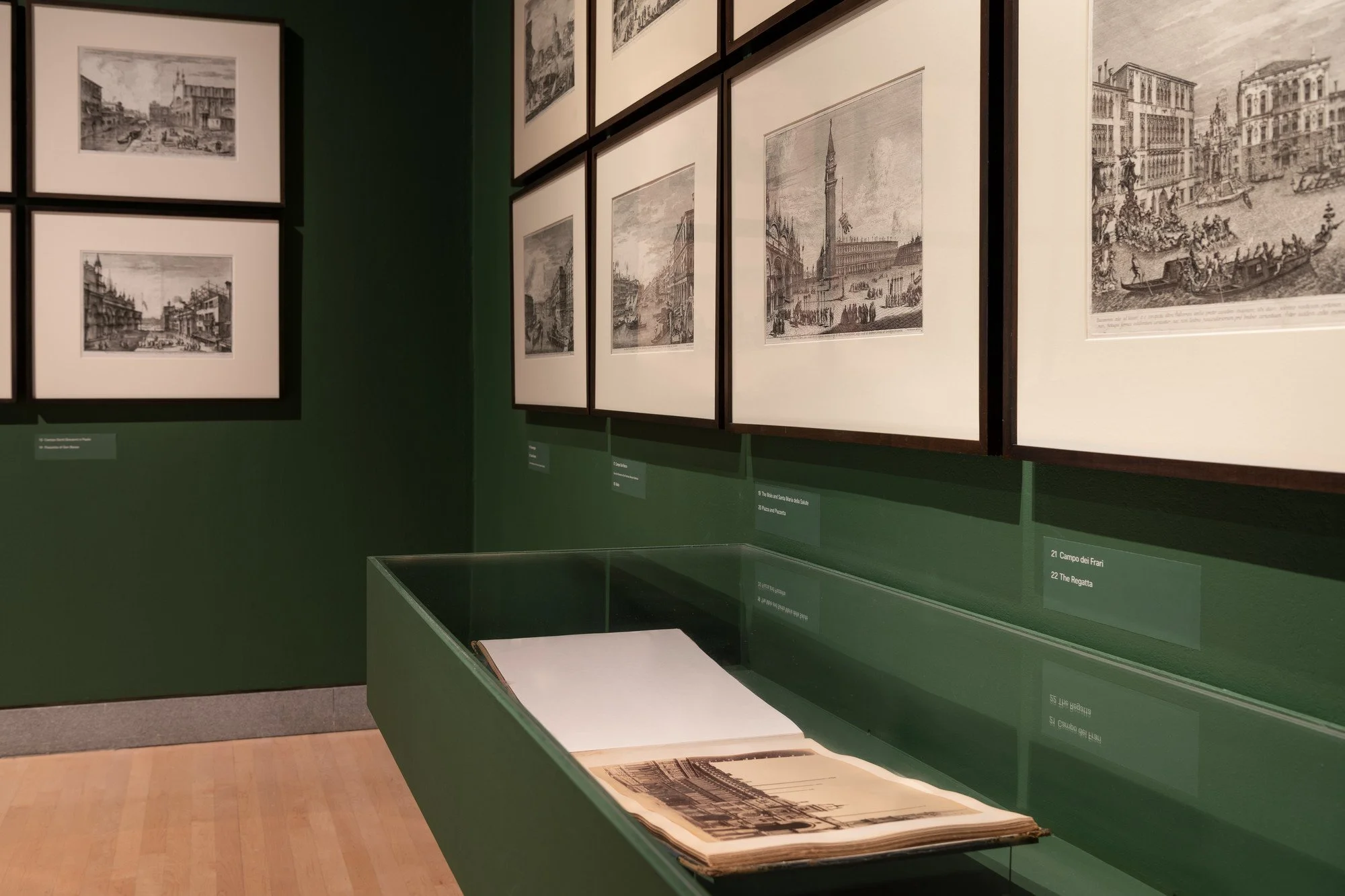










Installation view, Monet and Venice. Brooklyn Museum, October 11, 2025–February 1, 2026. (Photo: Paula Abreu Pita)
“We’re delighted to present this groundbreaking exhibition offering a fresh opportunity for visitors to engage with one of the world’s most celebrated artists in a bold new way,” said Anne Pasternak, Shelby White and Leon Levy Director, Brooklyn Museum. “Through thoughtful interpretation and design, we invite our audiences to see Venice through Monet’s eyes and feel inspired by his vision.”
Claude Monet, French, 1840-1926 Water Lilies 1914-1917 Oil on canvas 65 3/8 × 56 in. (166.1 × 142.2 cm)
“At Bank of America, we believe that investing in the arts has a positive impact on individuals, families, and communities, and partners like the Brooklyn Museum continue to validate this,” said José Tavarez, President, Bank of America, New York City. “Our long-standing relationship with the Museum continues to deepen connections with innovative programming and compelling experiences. We’re proud to have partnered on conservation projects, free museum programming, and exhibitions, and are looking forward to our newest sponsorship of Monet and Venice .”
Although the city was already grappling with the effects of pollution and overtourism when he visited, Monet remarked that Venice was “too beautiful to be painted.”

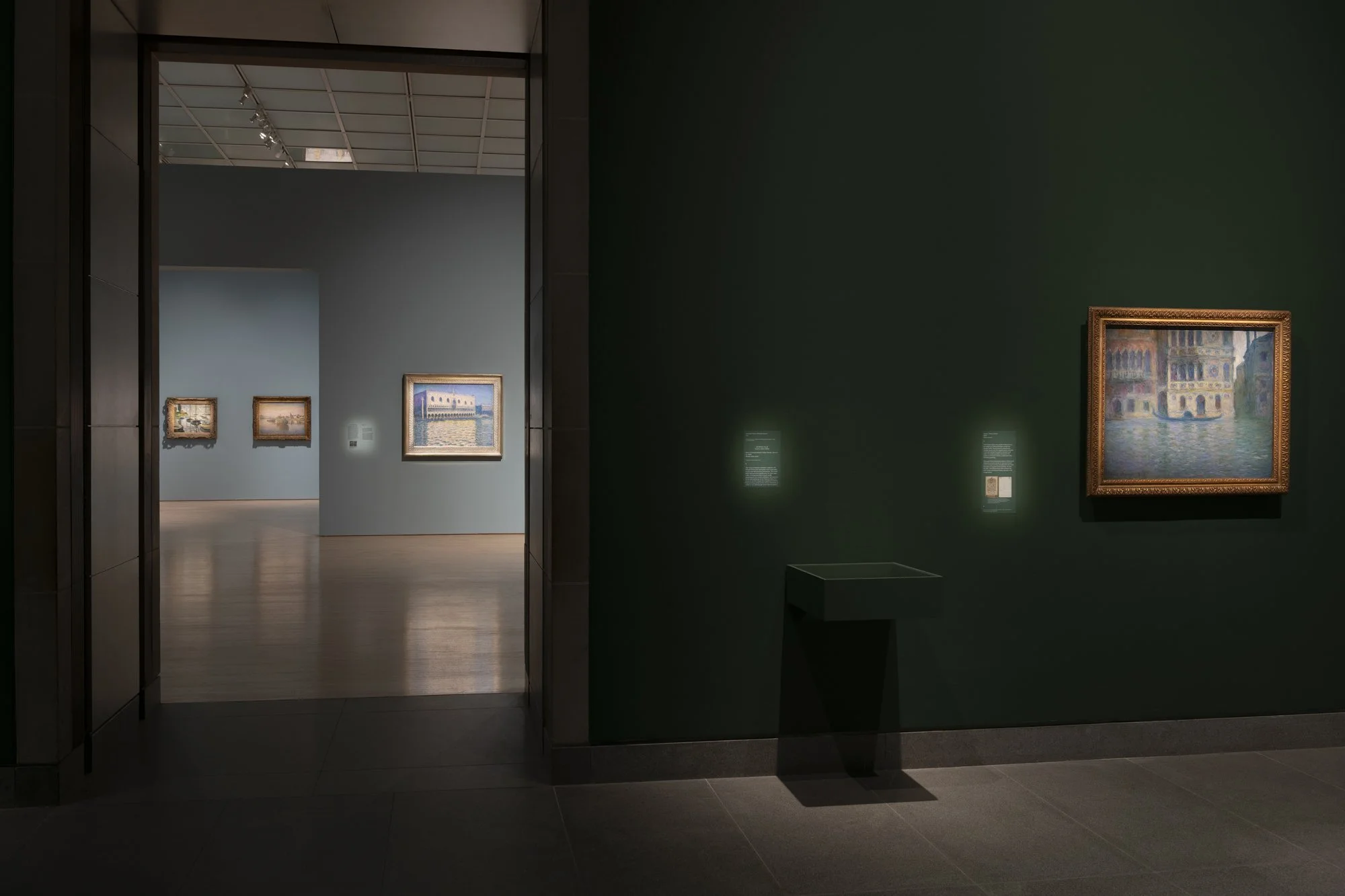











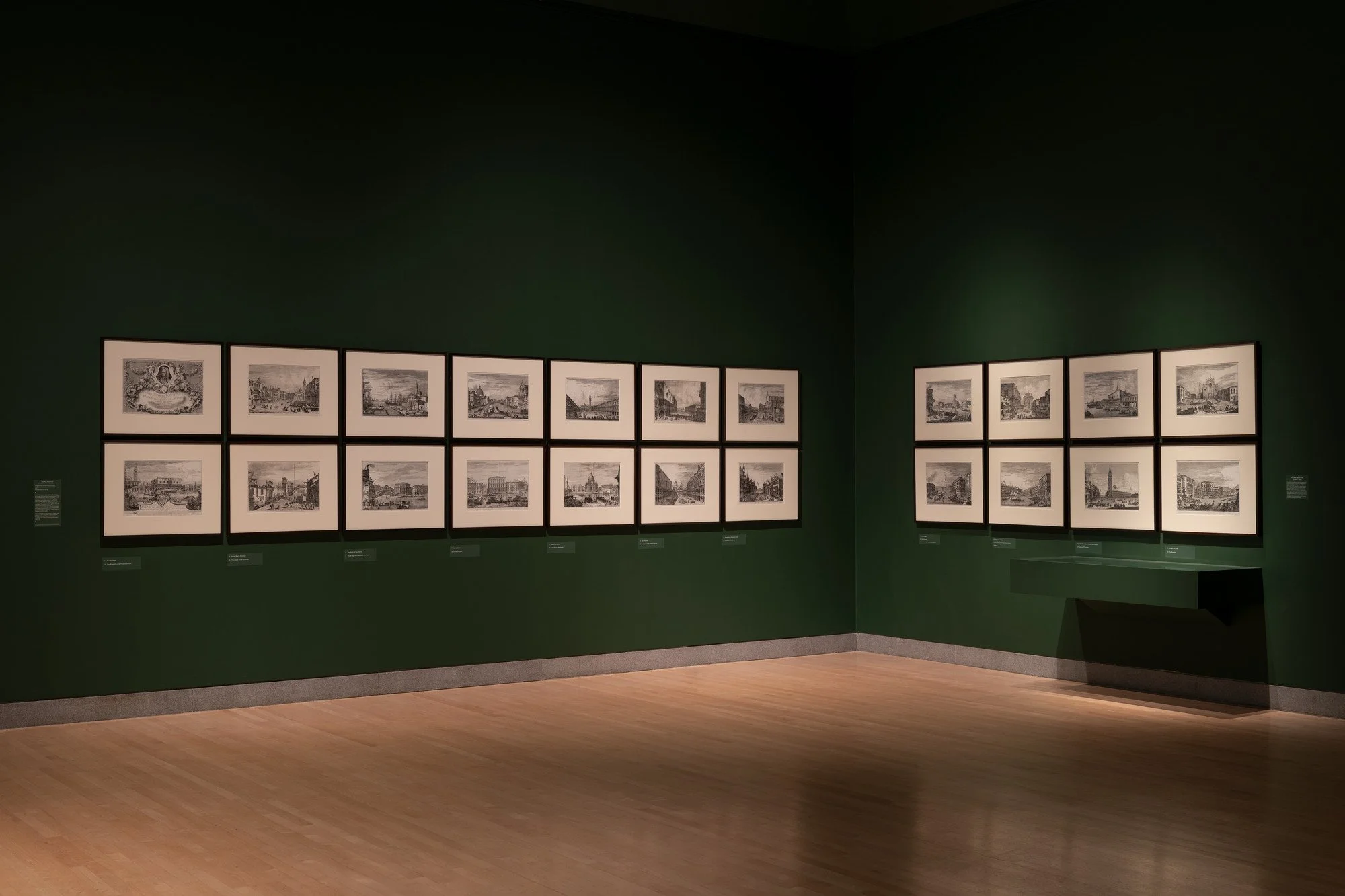

Installation view, Monet and Venice. Brooklyn Museum, October 11, 2025–February 1, 2026. (Photo: Paula Abreu Pita)
In 1908, encouraged by his wife Alice, who hoped the journey would reinvigorate him during a pivotal moment in his career, Monet reluctantly left Giverny and soon became captivated by Venice’s radiant light and architectural splendor. Often overshadowed by his iconic depictions of the French landscape, Monet’s Venetian works are among the most luminous yet underexplored of his career. The pair had planned to return to Venice years later, but in 1911 Alice fell gravely ill and passed away. In mourning, Monet retreated to his studio, where he completed the Venetian paintings and, in 1912, exhibited them to great acclaim in Paris. These were the last new works shown publicly in his lifetime.
Claude Monet, French, 1840-1926 The Red House 1908 Oil on canvas 25 5/16 × 31 13/16 × 1 3/16 in. (64.3 × 80.8 × 3 cm) frame: 35 1/16 × 44 1/8 × 4 5/16 in. (89 × 112 × 11 cm) Colection Galerie Larock-Granoff, Paris
Monet visited Venice only once, yet the city profoundly impacted him. With its fragile beauty and delicate interplay of land and sea, Venice became a site of both formal experimentation and symbolic resonance for the artist. Key examples of Venetian imagery by artists who preceded or were contemporaneous with Monet, including Pierre-Auguste Renoir, John Singer Sargent, J. M. W. Turner, James McNeill Whistler, and others, will be showcased, situating Monet’s works within a rich tradition of Venice as a subject of artistic inquiry. Standout works from the Museum’s collection, including four watercolors by Sargent that have been in the collection since 1909, and a group of Whistler’s famous Venice etchings, will be on view.
Installation view, Monet and Venice. Brooklyn Museum, October 11, 2025–February 1, 2026. (Photo: Paula Abreu Pita)
Unlike the bustling scenes painted by artists like Canaletto, Monet’s Venice is almost devoid of human presence. Instead, he focused on rendering the city’s architecture and canals emerging through and dissolving in the encompassing and unifying color and light that he described as the envelope. In addition to Monet’s paintings of Venice, the exhibition will present over a dozen other works created throughout his career that show his lifelong fascination with water and reflection. Paintings from Monet’s time in Normandy, London, and his home in Giverny—including three of his famed water lily canvases from the Musée Marmottan Monet in Paris, a private collection, and the Fine Arts Museums of San Francisco—will be displayed, drawing connections between the artist’s Venetian experiments and his broader oeuvre. Monet’s trip to Venice was his last major international journey, serving as both an interruption and a replenishment of his artistic focus. He returned invigorated, with a new perspective on the water lily paintings created in Giverny. As Monet asserted, “My trip to Venice has had the advantage of making me see my canvases with a better eye.”
Claude Monet, French, 1840-1926 The Palazzo Ducale, Seen from San Giorgio Maggiore (Le Palais Ducal vu de Saint-Georges Majeur) 1908 Oil on canvas 25 9/16 × 39 9/16 in. (64.9 × 100.5 cm) frame: 33 1/2 × 46 1/8 × 3 1/4 in. (85.1 × 117.2 × 8.3 cm) Solomon R. Guggenheim Museum, New York, Thannhauser Colection, Bequest, Hilde Thannhauser, 1991
The exhibition also features historical ephemera such as guidebooks of Venice and postcards written by Alice to her daughter, including one marking where the couple stayed for part of their trip. Select postcards, photographs, and letters are on loan to the Museum from the collection of Philippe Piguet, Alice Monet’s great-grandson from her first marriage.
Monet and Venice will further engage audiences through multisensory elements, including an original symphonic score inspired by the artist’s Venice paintings by the Brooklyn Museum’s Composer in Residence, Niles Luther. Upon entering the Museum’s fifth-floor rotunda, visitors will be greeted by an immersive installation that captures Venice’s unique atmosphere produced by Brooklyn-based design and technology studio Potion. It features film by Joan Porcel and his Venice-based Joan Porcel Studio, and an ethereal soundscape by Luther, using field recordings he captured in Venice and fragments of melodic themes drawn from his symphony. This visual and aural experience sets the stage for the visitor’s journey through Venice in the subsequent exhibition galleries.
Claude Monet, French, 1840-1926 The Palazzo Ducale 1908 Oil on canvas 32 × 39 in. (81.3 × 99.1 cm) frame: 41 1/4 × 49 × 3 1/2 in. (104.8 × 124.5 × 8.9 cm) Brooklyn Museum, Gift of A. Augustus Healy
“In composing for this exhibition, I’ve approached the paintings as souvenirs in the way Monet described them—memories infused with both beauty and melancholy,” says Luther. “My process is one of discovery, not invention—uncovering music no one has yet heard. Blending Italian, French, and American traditions, the composition mirrors Monet’s shimmering, dissolving Venice, transforming brushstrokes into living sound that surrounds the listener with both light and longing.” In the culminating gallery, Luther’s full symphony enters into dialogue with Monet’s paintings of Venice.
Three paintings, depicting the Palazzo Dario, the San Giorgio Maggiore, and the Palazzo Ducale, helped inspire and shape the emotional landscape of the composition. Just as Monet sought to render Venice‘s unique atmospheric envelop p e —where light, water, and architecture merge into unified sensory impressions—Luther translates these dissolving effects into an immersive sonic experience, deepening and enriching the visitor’s journey to Venice with Monet. After exiting the exhibition into an educational activity area, visitors will be surrounded by wall murals that depict archival images of the re-creation of Venice at Dreamland in Coney Island, linking the borough with the mythologized city.
Installation view, Monet and Venice. Brooklyn Museum, October 11, 2025–February 1, 2026. (Photo: Paula Abreu Pita)
A fully illustrated exhibition catalogue will accompany Monet and Venice , featuring an introduction by Melissa Buron and essays by Lisa Small, Niles Luther, and leading scholars of Impressionism and nineteenth-century art, including André Dombrowski, Donato Esposito, Elena Marchetti, Félicie Faizand de Maupeou, Jonathan Ribner, and Richard Thomson. These contributions explore Monet’s Venice works from sociohistorical and ecocritical perspectives, enriching our understanding of this pivotal moment in the artist’s career.
TOUR SCHEDULE
Brooklyn Museum, October 10, 2025–February 1, 2026
Fine Arts Museums of San Francisco, March 21–July 26, 2026
CREDITS Monet and Venice is organized by the Brooklyn Museum and the Fine Arts Museums of San Francisco.
The exhibition is curated by Lisa Small, Senior Curator of European Art, Brooklyn Museum, and Melissa Buron, Director of Collections and Chief Curator, Victoria and Albert Museum. Original symphonic installation by Niles Luther, Composer in Residence, Brooklyn Museum.
Lead Sponsor
Bank of America
Significant support is provided by the Ford Foundation, Constance Christensen, Mr. and Mrs. Alan Howard, the Arnold Lehman Exhibition Fund, and Jessie and Charles Price.
ABOUT THE BROOKLYN MUSEUM
For 200 years, the Brooklyn Museum has been recognized as a trailblazer. Through a vast array of exhibitions, public programs, and community-centered initiatives, it continues to broaden the narratives of art, uplift a multitude of voices, and center creative expression within important dialogues of the day. Housed in a landmark building in the heart of Brooklyn, the Museum is home to an astounding encyclopedic collection of more than 140,000 objects representing cultures worldwide and over 6,000 years of history—from ancient Egyptian masterpieces to significant American works, to groundbreaking installations presented in the only feminist art center of its kind. As one of the oldest and largest art museums in the country, the Brooklyn Museum remains committed to innovation, creating compelling experiences for its communities and celebrating the power of art to inspire awe, conversation, and joy.
The exhibit opened on October 11, 2025, and will be on view until February 1, 2026. Please visit the Brooklyn Museum’s site for more information about the exhibit. The Museum can also be found on Instagram, TikTok, YouTube, and Facebook.
Hyperobject: Maria Kreyn
Lensed Egg. 60 x 54 inches. Oil on linen. 2024 Courtesy of Artist
The MoN Art Foundation is delighted to present Hyperobject, a solo exhibition of new paintings by Maria Kreyn, within the luminous Byzantine architecture of the Fitzrovia Chapel. Coinciding with Frieze London 2025, the exhibition transforms this sacred space into a site of awe and contemplation, where light, geometry, and atmosphere converge.
This is Kreyn’s fourth solo exhibition in a sacred architectural setting, following her acclaimed 2024 presentation at St. George’s Church during the 60th Venice Biennale. With Hyperobject, she continues this dialogue between contemporary painting and ecclesiastical architecture, transcending ideology and transforming the church into a site of secular reverence and existential wonder.
Ocean Prism I. 60 x 80 inches. Oil on linen. 2024 Courtesy of Artist
At the focal point of the exhibition stands a monumental altarpiece, surrounded by storm paintings that summon the sublime. Inspired by the idea of the “Hyperobject”—forces so vast they exceed human comprehension—Kreyn’s canvases unfold as portals and mirrors, entangling immense cosmic scales with intimate human emotion. Inventing visual metaphors for concepts at the frontier of scientific inquiry, Kreyn invites viewers into a suspended space where chaos meets harmony, fragility meets intensity, and reverence arises beyond the veil of doctrine
The exhibition is curated by Maria Vega and is being presented at The Fitzrovia Chapel. London from October 12-20, 2025. There will be an opening Reception: Tuesday, October 14, 6-10 pm
Artist Biography
Maria Kreyn (b. 1987) is an American artist whose emotionally charged works merge figuration, geometry, and elemental atmospherics. Internationally collected, she has created monumental commissions including a Shakespeare-inspired cycle for London’s Theatre Royal Drury Lane. In 2024, she presented a solo exhibition at St. George’s Church during the Venice Biennale. She lives and works in Brooklyn, New York.
About MoN Art Foundation
Founded in 2023 by curator and gallerist Maria Vega, the MoN Art Foundation creates platforms for dialogue between art, science, and activism. Its mission is to support artists whose practices address urgent ecological and existential questions with rigor and vision, fostering creative strategies for environmental stewardship and cultural transformation
For more information about MoN Art Foundation, please visit their website here. MoN can also be found on Instagram also here.
SAM Contemporaries: How To Dream Worlds
Installation view of SAM Contemporaries: How To Dream Worlds at SAM at Tanjong Pagar Distripark. Image courtesy of Singapore Art Museum.
Singapore, 30 July 2025 – Singapore Art Museum (SAM) presents SAM Contemporaries: How To Dream Worlds, the second edition of this biennial platform dedicated to supporting emerging practices and generative trends in Singapore art. Which opened on 1 August 2025 at SAM, the exhibition features new commissions by six Singapore artists: Chok Si Xuan, Chu Hao Pei, Lee Pheng Guan (PG Lee), Masuri Mazlan, NEO
_
NEO_ARTEFACTS (Fazleen Karlan) and Syahrul Anuar. Framed as a space for collective research and critical inquiry, the exhibition brings together diverse practices that reflect the evolving conversations and approaches shaping contemporary art in Singapore today.
Detail view of NEO_ARTEFACTS’s Secrets, Sweat and Sand as part of SAM Contemporaries: How To Dream Worlds at SAM at Tanjong Pagar Distripark. Image courtesy of Singapore Art Museum.
Developed through close artistic and curatorial exchange, SAM Contemporaries foregrounds artistic process and development as critical sites of inquiry. This initiative supports experimentation and iterative exploration, enabling each artist to dive deeper into their artistic research and develop new works through sustained dialogue with SAM’s curators. This culminates in the exhibition, How To Dream Worlds, presenting deeply researched, personally grounded explorations into a range of contemporary concerns from body-machine relations and the uncovering of dominant or erased histories to the politics of how space is shaped and used.
As viewers engage with the works, they are invited to step into a slow, ongoing process of questioning the now and imagining what might be. Some artworks speculate on futures, others revisit histories or explore the everyday, drawing attention to the subtle forces that shape daily life. Ong Puay Khim, Director of Collections, Public Art & Programmes at SAM, said: "SAM Contemporaries reflects SAM’s commitment to supporting artists and their exploration of long-term and budding interests, grounded by continued conversations. Both in its first edition in 2023 and current edition, some artists of SAM Contemporaries are past residents of the SAM Residencies programme; some have been engaged through different projects; and others mark new relationships. Supporting artists at pivotal moments in their practices, this platform nurtures discursive conversations, opens up fresh modes of seeing and thinking, both artistically and curatorially with a collaborative spirit.
”
Six new commissions dream up alternative worlds
Installation view of Lee Pheng Guan’s Pretty, Please (Sleep Tight) as part of SAM Contemporaries: How To Dream Worlds at SAM at Tanjong Pagar Distripark. Image courtesy of Singapore Art Museum.
The exhibition’s title, How To Dream Worlds, evokes dreaming as both method and resistance. It invites audiences to reimagine modes of living, relating, and perceiving, offering speculative, hopeful propositions that unfold within states of uncertainty and possibility. Through diverse strategies, each artist proposes new ways of seeing and sensing the world as it is, while offering pathways toward what it could still be and become.
Lee Pheng Guan’s Pretty, Please (Sleep Tight) is a multi-media installation centred on lalang (Imperata cylindrica), a hardy, invasive weed seldom visible within Singapore’s meticulously manicured and controlled urban landscapes. Thriving only in neglected pockets of the city, lalang in this work has been laboriously gathered and encased within rigid metal frames. Drawing on gardening as both metaphor and method, Lee’s work reveals the often imperceptible mechanisms of control embedded in everyday life: within landscapes, bodies, and the architecture of daily existence. It reflects on how systems of order, both ecological and social, are maintained through acts of pruning, regulating, and enclosing. The work offers a quiet reckoning: what comforts do we cling to, and at what cost?
Installation view of Chu Hao Pei’s Nasi Goreng Diplomacy #3 as part of SAM Contemporaries: How To Dream Worlds at SAM at Tanjong Pagar Distripark. Image courtesy of Singapore Art Museum.
In Nasi Goreng Diplomacy #3, Chu Hao Pei presents the third chapter of an ongoing artistic research project through an extended cooking ritual. Collaborators Fadiah Nadwa Binti Fikri, Rizki Amalia Affiat and Sharmini Aphrodite share their nasi goreng recipes, which are prepared and reflected upon across four video works. Nasi goreng (meaning “fried rice” in Malay), with its ubiquitous yet adaptable characteristics, is commonly found across Southeast Asia, yet possesses no standardised form. Set against the performative backdrop of a diplomatic roundtable, the installation humorously substitutes national debates and the intricacies of diplomacy mirrored with conversations about food, evoking relational politics and collective negotiation enacted through everyday rituals. Visitors are invited to contribute their recipes, extending this participatory dialogue around community and exchange. Masuri Mazlan’s installation can haunting be another way of enduring? draws from memories of fractured belonging – of homes that were unstable, impermanent or denied. It reimagines home as a haunted shell where belonging is never fixed but always in negotiation. Using salvaged furniture, latex skins, expanding foam, and photographic fragments, Masuri conjures spectral presences; bodies withheld sanctuary yet refusing erasure. These materials grow, peel, and distort across familiar surfaces, forming wound-like membranes and hollowed spaces that speak to both refuge and refusal. Rooted in personal memory yet resonant with collective experiences of precarity and exclusion, the work proposes haunting as a mode of endurance: a persistent flicker, a soft defiance, and a refusal to disappear.
Installation view of Syahrul Anuar’s the mountain lovers club as part of SAM Contemporaries: How To Dream Worlds at SAM at Tanjong Pagar Distripark. Image courtesy of Singapore Art Museum.
Syahrul Anuar’s the mountain lovers club invites viewers to reckon with Singapore’s artificial elevations in the absence of natural topography. Referencing the tower viewers commonly found on observation decks and viewing platforms, the installation prompts reflection on how land, development, and aspiration intersect, raising critical questions of identity and place within the island city-state. The work explores Singapore’s mountain-less landscape, now dominated by the artificial peaks of public housing estates and skyscrapers. Oscillating between the historical and contemporary, factual and fictional, it invites visitors to consider their shifting relationship with a land transformed by urban expansion, resource extraction, and the costs of economic prosperity. In Secrets, Sweat and Sand, NEO.
_
Installation view of NEO_ARTEFACTS’s Secrets, Sweat and Sand as part of SAM Contemporaries: How To Dream Worlds at SAM at Tanjong Pagar Distripark. Image courtesy of Singapore Art Museum.
NEO_ARTEFACTS constructs a speculative archaeological dig at the fictional site of Gunong Perandaian. Blurring the lines between narratives of history and fiction, the installation features replicas of iconic pop culture relics such as Indiana Jones’ Holy Grail and Lara Croft’s necklace and the Triangle of Light from the Tomb Raider series. Amidst epic lores surrounding archaeological sites and relics, the work activates a critical interrogation of how the discipline has been exoticised and mythologised, and how that shapes popular understandings of civilisation. By inviting viewers to piece together an origin story for Gunong Perandaian, NEO
_
NEO_ARTEFACTS asks urgently: whose stories are being told, and by whom?
Installation view of Chok Si Xuan’s solid_state as part of SAM Contemporaries: How To Dream Worlds at SAM at Tanjong Pagar Distripark. Image courtesy of Singapore Art Museum.
Finally, Chok Si Xuan’s solid state features three kinetic sculptures constructed by draping silicone and nylon over electrical components and shape-memory alloys. These hanging forms rotate, expand, and contract in ways that mimic human gestures. However, the subtle whirring of concealed motors betrays their machinic core. In the installation, two livestreams capture the internal movements and sounds of the sculptures, while a third assembles visual fragments from recorded and stock footage, highlighting the fragmented journeys of materials, whose origins are obscured by global supply chains and extractive processes. Similarly, while the sculptures take on tangible forms that we can recognise, like the human body, their internal workings remain concealed. By drawing attention to the atomisation of material culture that shapes our technological world, solid- state speculates on what remains shrouded in both body and object.
By rooting these imagined worlds in the realities of our time, How To Dream Worlds offers insight into how artists respond to the conditions around them, underscoring SAM’s belief in art as a vital space for inquiry, reflection, and change. Accompanying the exhibition is a rich line up of artist- and curator-led programmes designed to deepen engagement and expand understanding of the works. A forthcoming publication in October will document the artists’ evolving creative processes, alongside curatorial essays and creative responses. The exhibition will be shown at Gallery 3 at SAM at Tanjong Pagar Distripark from 1 August to 16 November 2025. General Admission (free for Singaporeans and PRs) applies.
About Singapore Art Museum
Singapore Art Museum opened in 1996 as the first art museum in Singapore. Also known as SAM, we present contemporary art from a Southeast Asian perspective for artists, art lovers and the art curious in multiple venues across the island, including a new venue in the historic port area of Tanjong Pagar.
SAM is building one of the world's most important public collections of Southeast Asian contemporary art, with the aim of connecting the art and the artists to the public and future generations through exhibitions and programmes. SAM is working towards a humane and sustainable future by committing to responsible practices within its processes.
For more information about the SAM Contemporaries: How to Dream Worlds exhibition and other events at the museum, please visit the site here. SAM can be found on X, Instagram, Facebook, and YouTube. Additionally, more information about SAM Contemporaries: How to Dream Worlds and its accompanying programs can be found here.
Keisuke Yamamoto: Cultivating a Poem Lost to Memory
Installation view of Cultivating a Poem Lost to Memory, September 13 - October 11, 2025, Tomio Koyama Gallery Photo by Kenji Takahashi ©Keisuke Yamamoto, Courtesy of Tomio Koyama Gallery
Tomio Koyama Gallery Roppongi is pleased to present an exhibition by Keisuke Yamamoto entitled “Cultivating a Poem Lost to Memory.” This exhibition marks the artist’s eighth solo show at the gallery and his first in eight years, featuring new sculptures and drawings.
【About Keisuke Yamamoto and his work: expressing chaos, the multilayered nature of soil, and underground worlds through a versatile imagination】
Keisuke Yamamoto (b. 1979) graduated from the sculpture department of Tokyo Zokei University in 2001 and completed his Master’s degree in sculpture at the Graduate School of Fine Arts at Tokyo University of the Arts in 2018. He currently serves as Associate Professor in the Concentration in Sculpture at Joshibi University of Art and Design.
Yamamoto has expressed his artistic world through both sculpture and painting. One of the most distinctive features of his practice is his affinity for soil and subterranean realms. He has connected his unique imagination to a sense of faith in and reverence for the land, the time and history embodied in layers of earth, nutrients and microorganisms, lifelines, chemical artifacts, and the chaotic darkness, presenting them as forms of existence that are free and unencumbered.
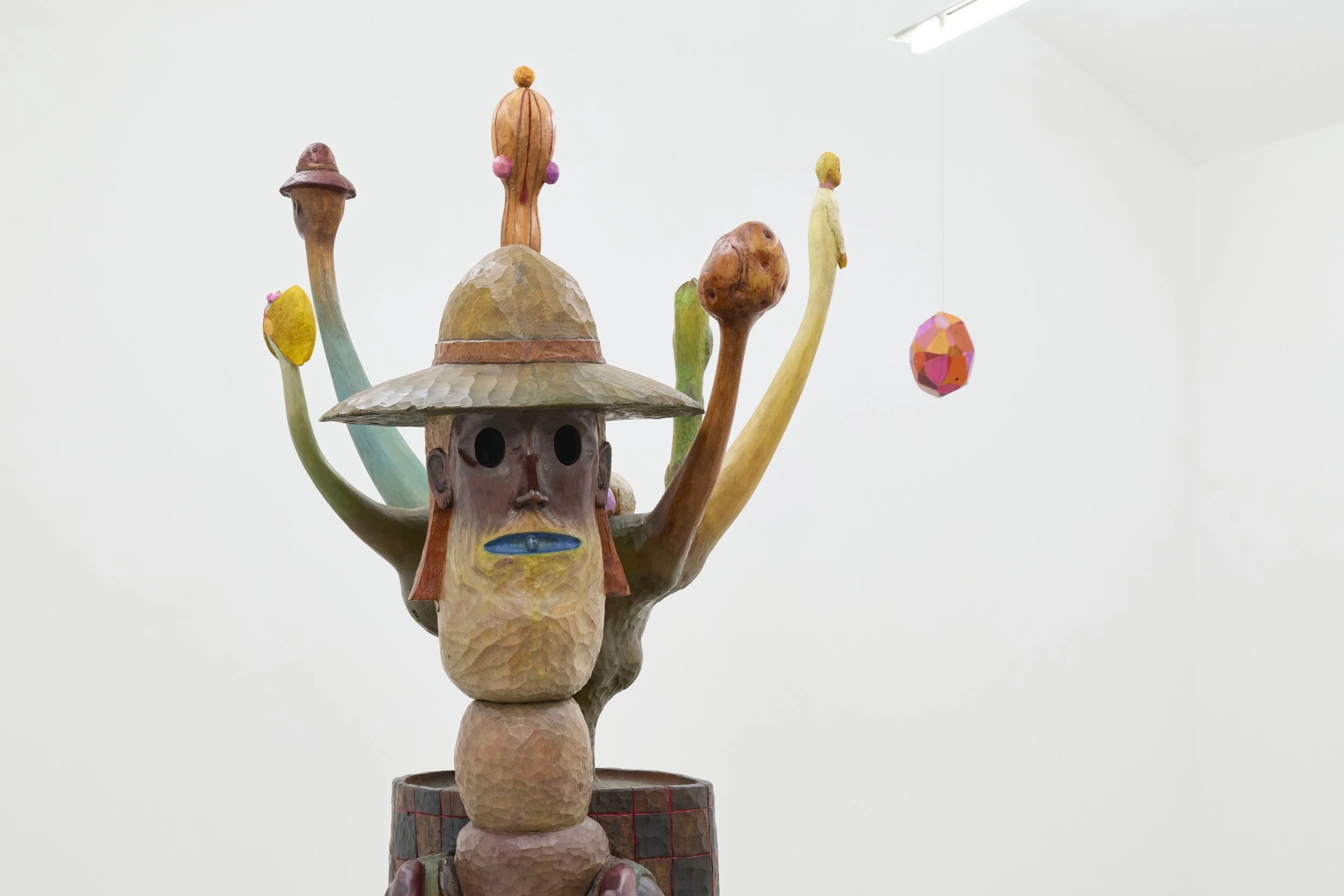
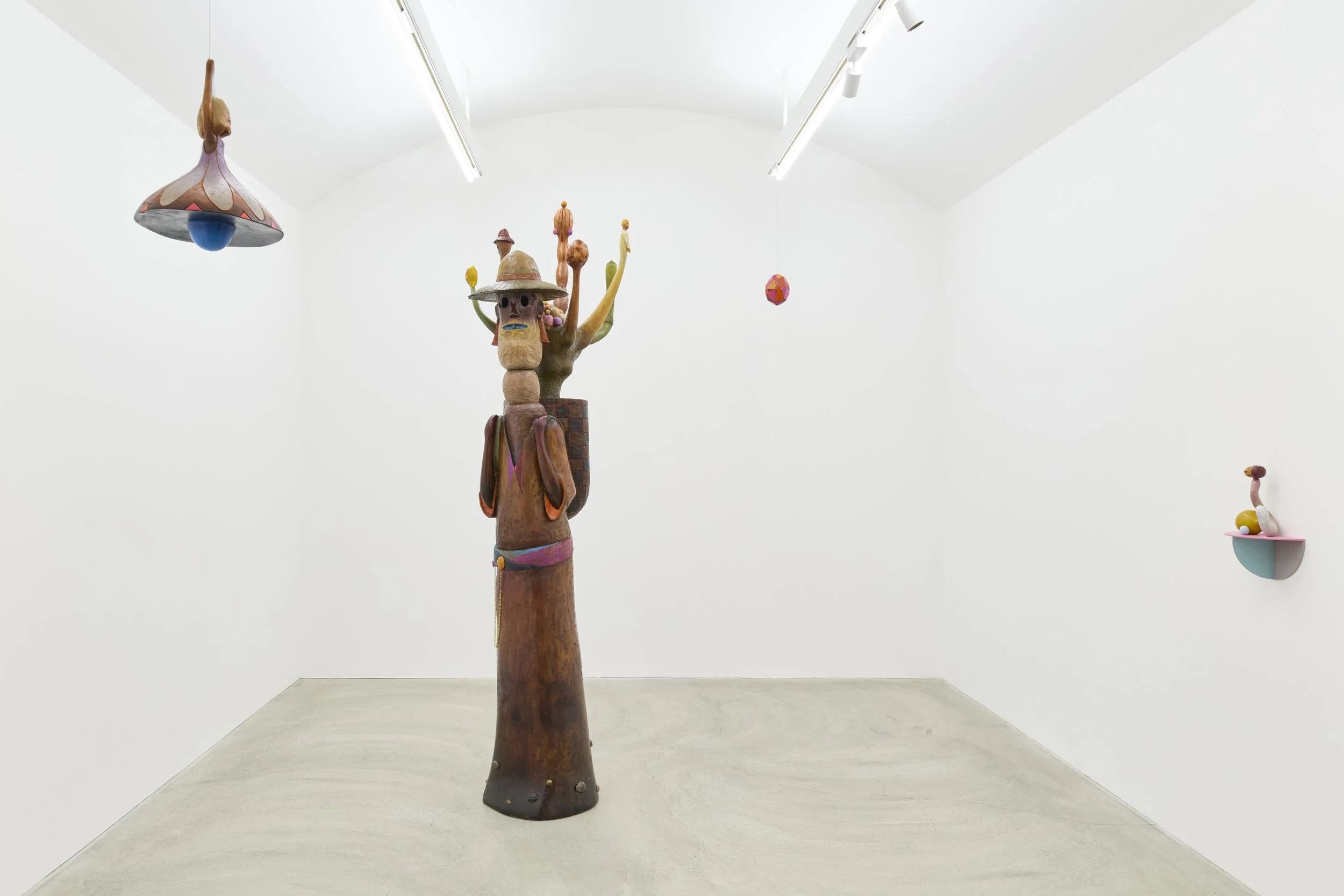
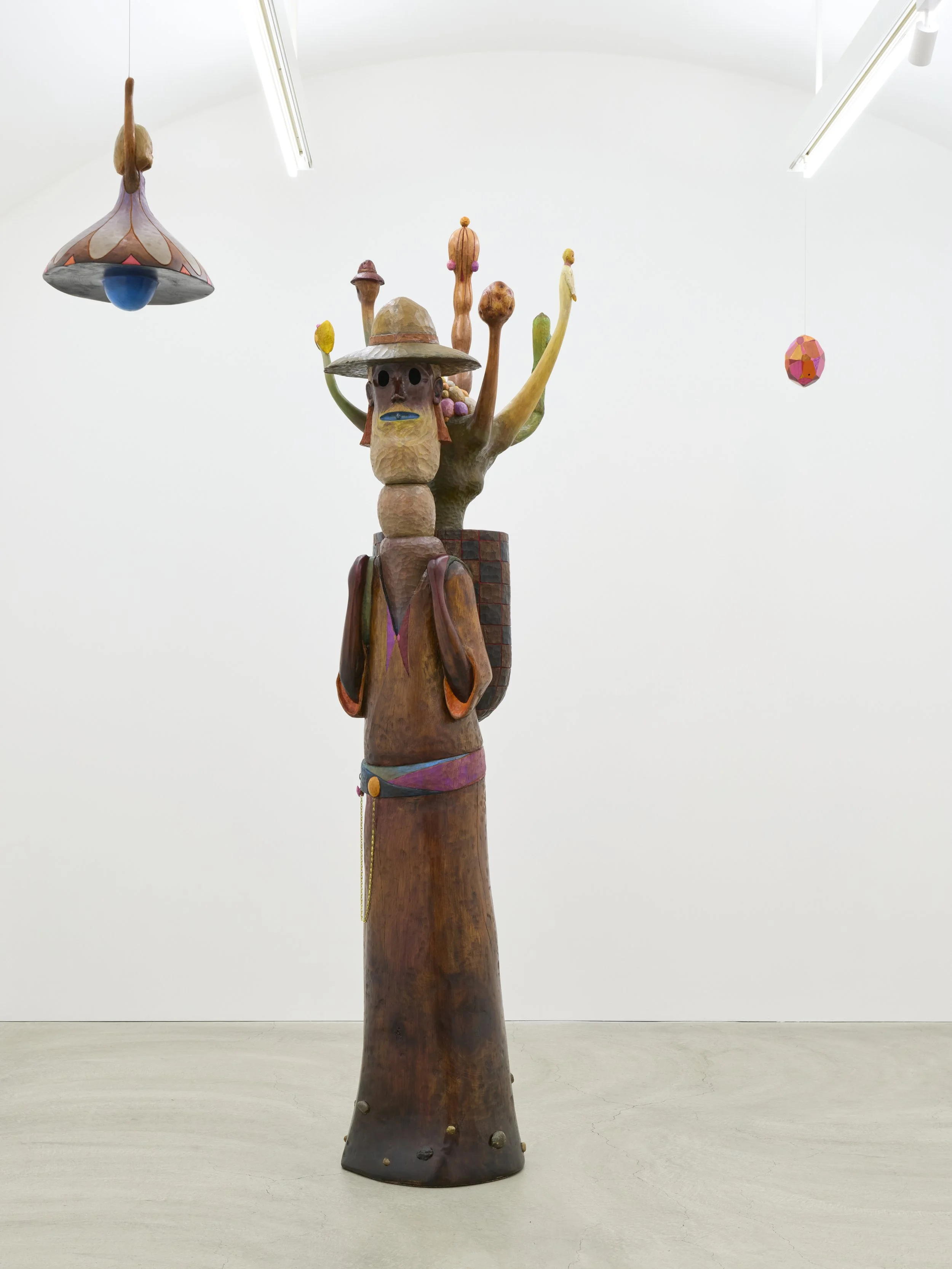
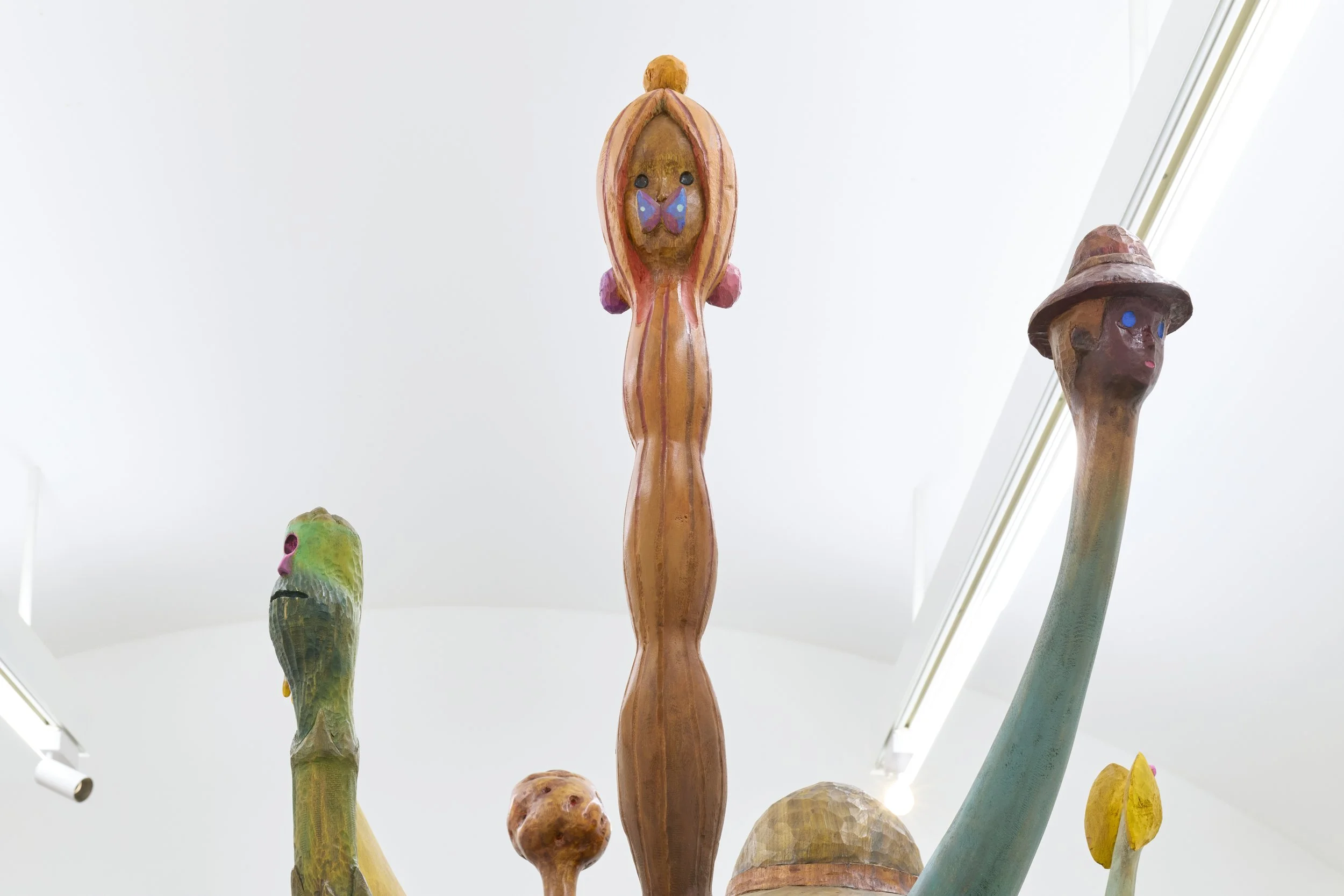
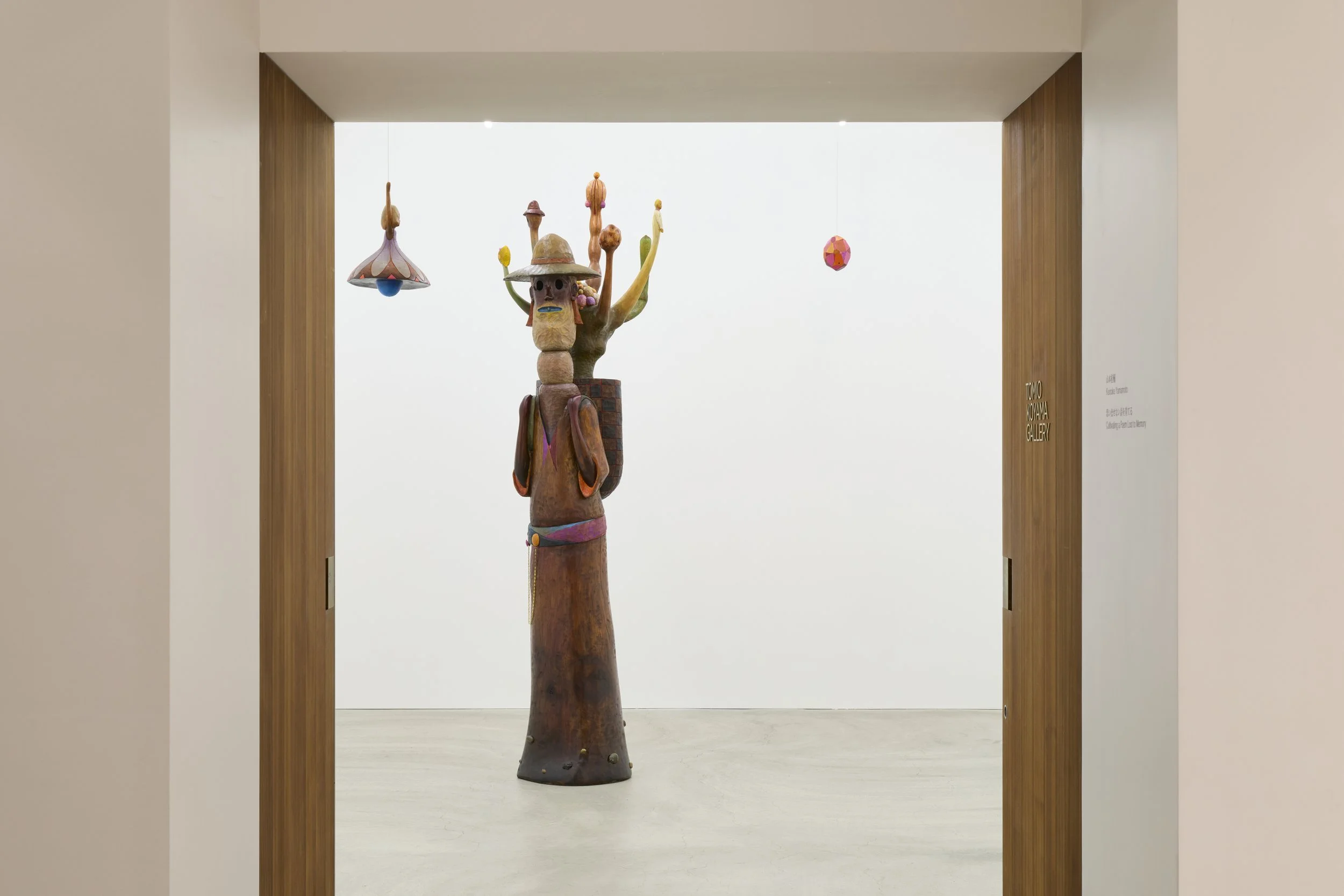
山本桂輔 Keisuke Yamamoto夢遊する樹 The Sleepwalking Tree2016/2022/2025Wood, oil paint, stone, glass木、油彩、石、ガラスh.265.5 x w.73.0 x d.82.0 cm Photo by Kenji Takahashi ©Keisuke Yamamoto, Courtesy of Tomio Koyama Gallery
While this underlying philosophy remains constant, the direction of his work has evolved as his interests have shifted. His early representative series “Untitled” (2008-2012) features massive wooden sculptures more than five meters high that brim with an overflowing sense of vitality and rhythm. For his 2012 solo exhibition, Yamamoto created works rich in vernacular elements — an attempt to breathe new life into old tools and implements that seem to have always been there, through a form of coexistence.
山本桂輔 Keisuke Yamamoto 甘い光 Sweet Light “Cultivating a Poem2024wood, oil paint, wire木、油彩、ワイヤーh.34.7 x w.26.5 x d.24.5 cm/including the wire: h.84.0 Photo by Kenji Takahashi ©Keisuke Yamamoto, Courtesy of Tomio Koyama Gallery
For this exhibition, building on the momentum from his participation in the 2024 Yamagata Biennale, Yamamoto will present new works that function like tools, stages, or board games with no rules. These pieces draw upon and cultivate the energy, history, and stories that reside in the earth and its depths through images of tree roots. Additionally, his outdoor bronze installation Talking and Singing in Sleep is currently on display at Marunouchi Street Gallery.
【About this exhibition and the works on display: images of accumulation, slumber, and dreams generated through trees that connect the subterranean realm with the earth and sky】
Installation view of Cultivating a Poem Lost to Memory, September 13 - October 11, 2025, Tomio Koyama Gallery Photo by Kenji Takahashi ©Keisuke Yamamoto, Courtesy of Tomio Koyama Gallery
On the occasion of this exhibition, Yamamoto penned the following statement.
“I am interested not in art as a special act performed by special individuals, but rather the ordinary, natural acts of imagining, thinking, and making things that humanity has engaged in since time immemorial. It is these acts that I feel are evidence of humanity’s attempts to understand this world, through an infinite number of forms conjured by individuals over the course of their relationship with the world. One way to describe them is as tiny whispers or mutterings that have been overlooked by grand historical narratives.”
“Countless lives exist beneath the earth, and the history of billions of years of activity is inscribed therein — an infinite number of nameless things, events, thoughts, and wishes. The underground feels like a world where everything melts together and coexists.”
“Trees connect the underground to the earth and sky, and images are generated through these connections. Various things frolic, accumulate, and gradually take shape.”
In Garden of Hot Springs, part of Yamamoto’s “Cultivating a Poem Lost to Memory” series, human-like figures and spheres lie scattered and suspended across what appears to be a cross-section of a log inundated by water, while abstract, painterly circles are also depicted along the sides.
山本桂輔 Keisuke Yamamoto 手品、プールの底の種 Magic, the Seed at the Bottom of the Pool 2024 wood, oil paint, stones, strings, metal fittings, paper, color pencil木、油彩、石、紐、金具、紙、鉛筆h.62.0 x w.33.0 x d.32.1 cm Photo by Kenji Takahashi ©Keisuke Yamamoto, Courtesy of Tomio Koyama Gallery
Are these people from the past that the earth has witnessed, non-existent people from dreams, or something from the future? These spheres resemble stones, stars, eyes, seeds, flowers, or light, yet they also seem like minute particles. Through the trees, organic beings appear in an imaginative and abstract manner, evoking in the viewer images of distant life, cosmic forces, and a sense of drifting between dream and reality.
山本桂輔 Keisuke Yamamoto 熱水泉の庭 Garden of Hot Springs “Cultivating a Poem 2024 wood, oil paint, stones, glass, ceramic, strings, metal fittings木、油彩、石、ガラス、セラミック、紐、金具 h.90.7 x w.40.0 x d.33.0 cm Photo by Kenji Takahashi ©Keisuke Yamamoto, Courtesy of Tomio Koyama Gallery
Also on display are works from Yamamoto’s “Zao Notebook” series — pencil drawings created while strolling in the area around Mount Zao, in which he sketches the forms he sees with curved, undulating lines, to which he adds details later, as if recalling them after forgetting — as well as pieces from his “Gently Scooping” series. This latter series represents Yamamoto’s attempts to expand on the image of rock fragments that become pebbles as a result of the flow of a river, using cups and spheres to express the distortion and rotational movement of the world through the random reflections of light in glass.
山本桂輔 Keisuke Yamamoto 地底の星屑(微光流星の花) 2025 wood, oil paint, ceramic, iron, lead, stone, thread木、油彩、セラミック、鉄、鉛、石、糸h.42.0 x w.28.3 x d.6 cm Photo by Kenji Takahashi ©Keisuke Yamamoto, Courtesy of Tomio Koyama Gallery
With a perspective that is gentle yet sharp, Yamamoto softly scoops up and creates an infinite number of forgotten, nameless things, thoughts, and wishes, and his artistic practice that transcends time and space continues to grow ever more profound. We hope you will take the opportunity to experience the most recent iteration of his artistic world.
Cultivating a Poem to Memory opened on September 13, with an opening reception on September 13, from 5-7pm The exhibition will close on October 11, 2025. The TOMIO KOYAMA GALLERY ROPPONGI is open from 11 am to 7 pm. It is CLOSED: Sun, Mon, and National Holidays.
For more information about this exhibition at TOMIO KOYAMA GALLERY ROPPONGI and others, please visit their site here. The gallery can be found on X, Facebook, Instagram, and YouTube. For more information on the artist, please visit here.
-
Depictura Dexter Dalwood | Van Hanos | Zhao Gang

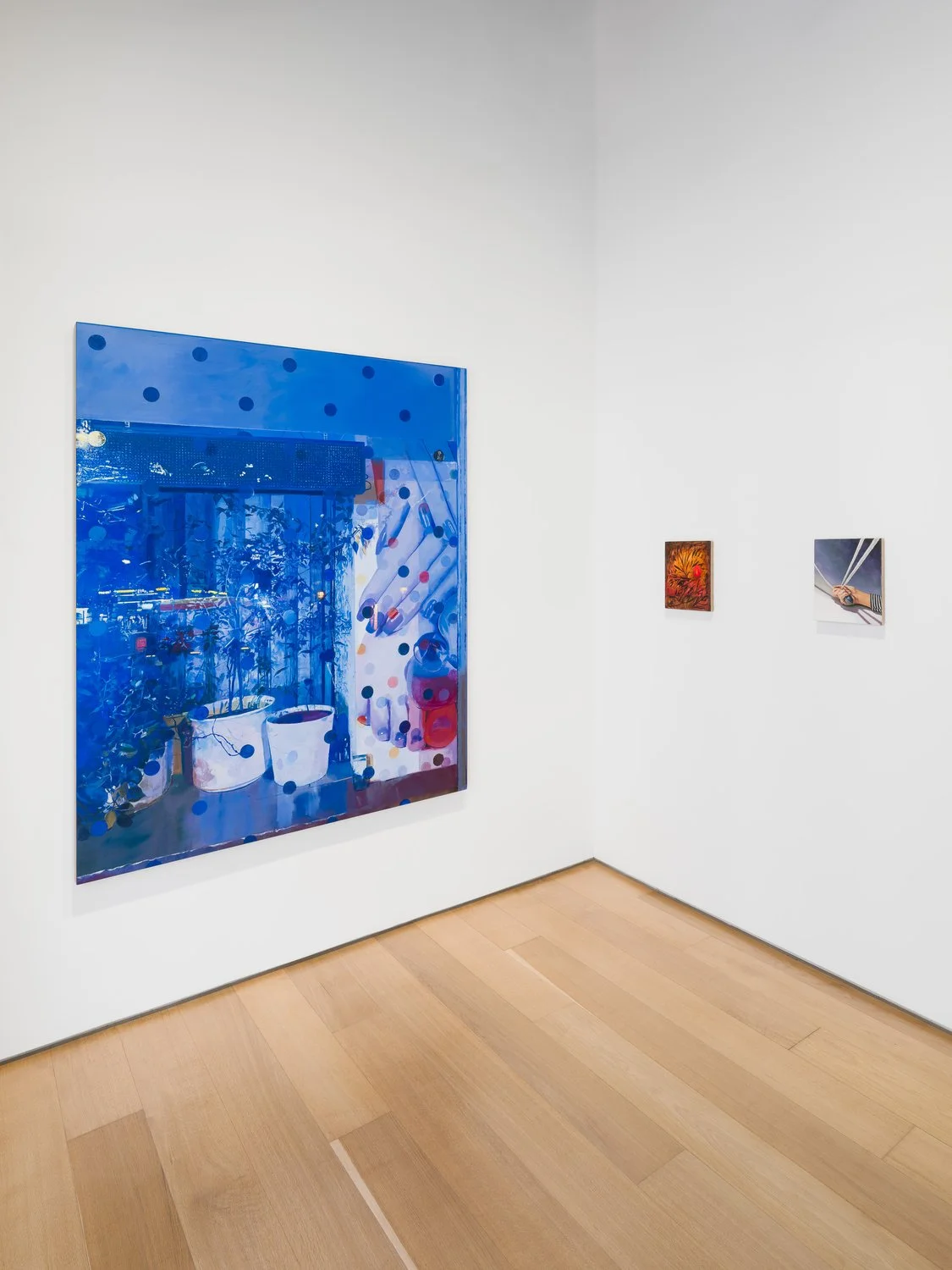
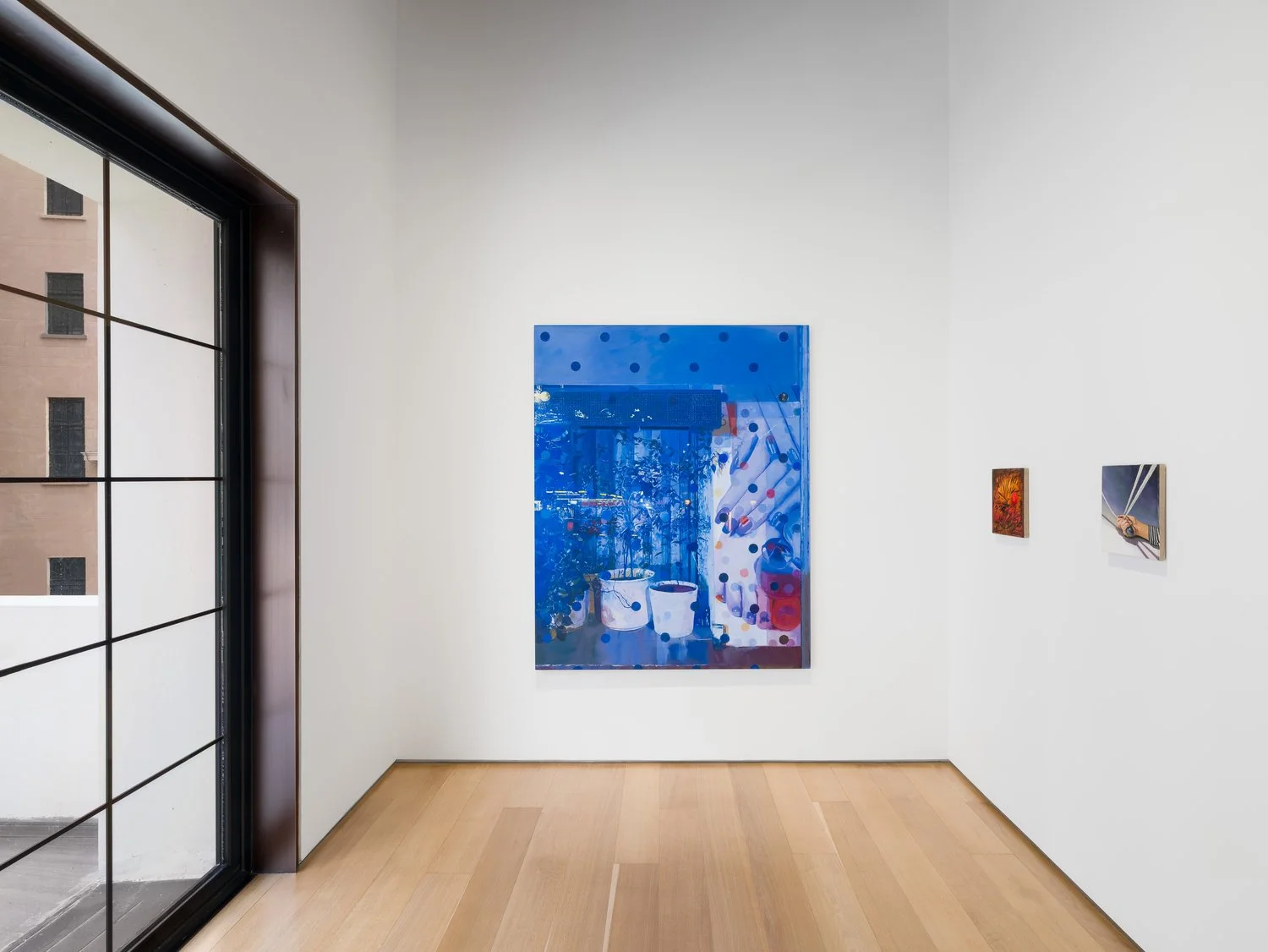

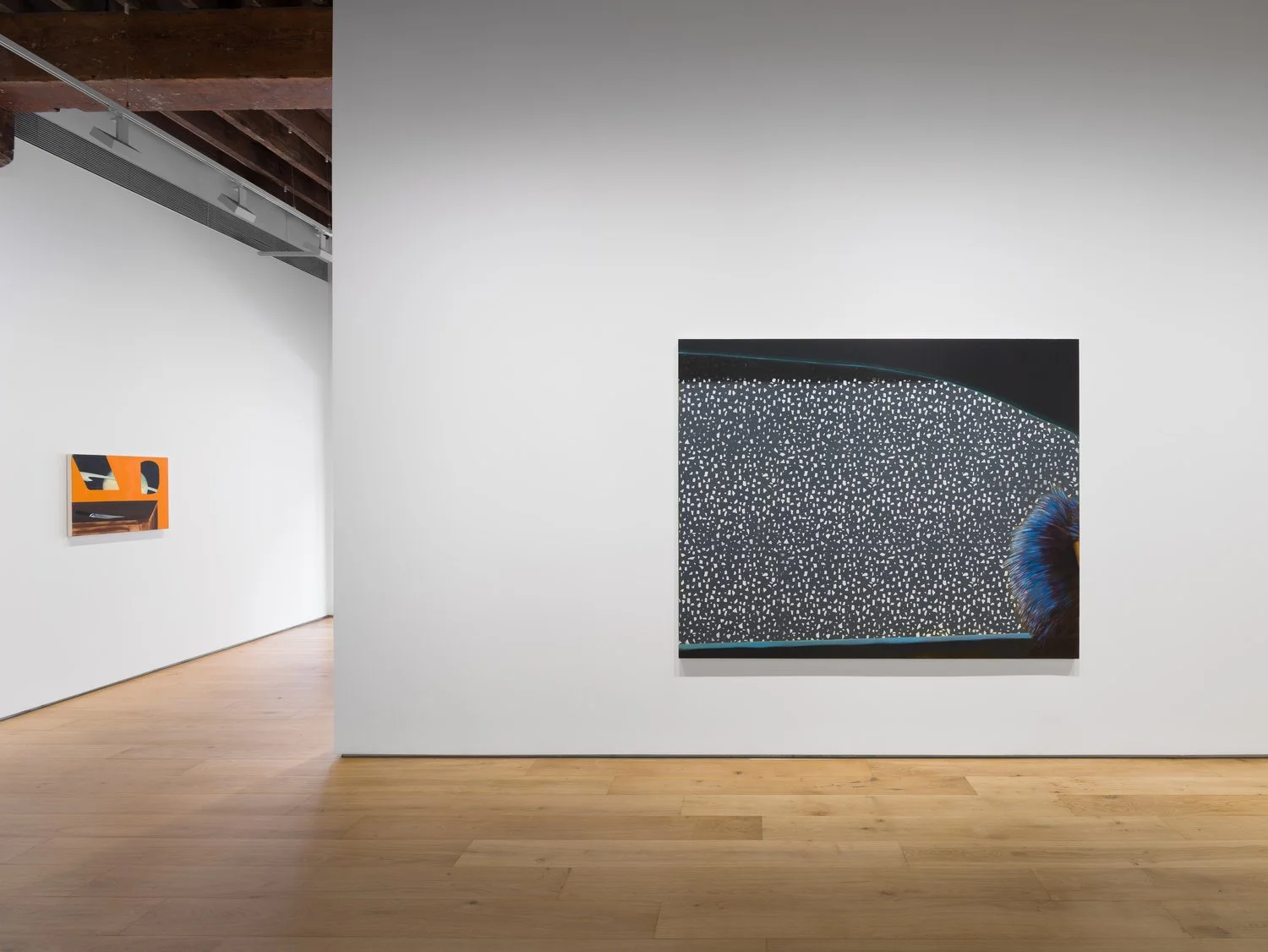
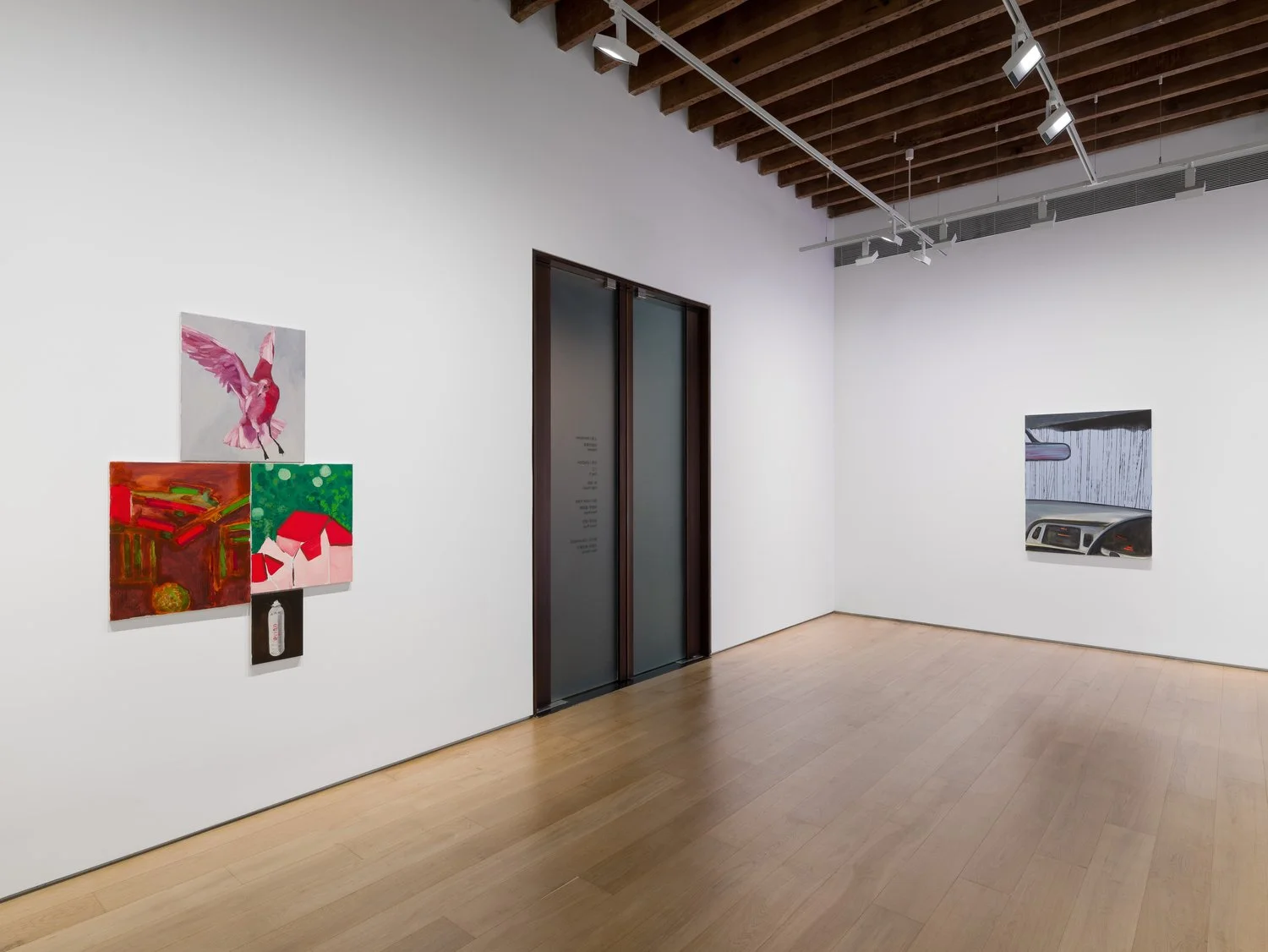

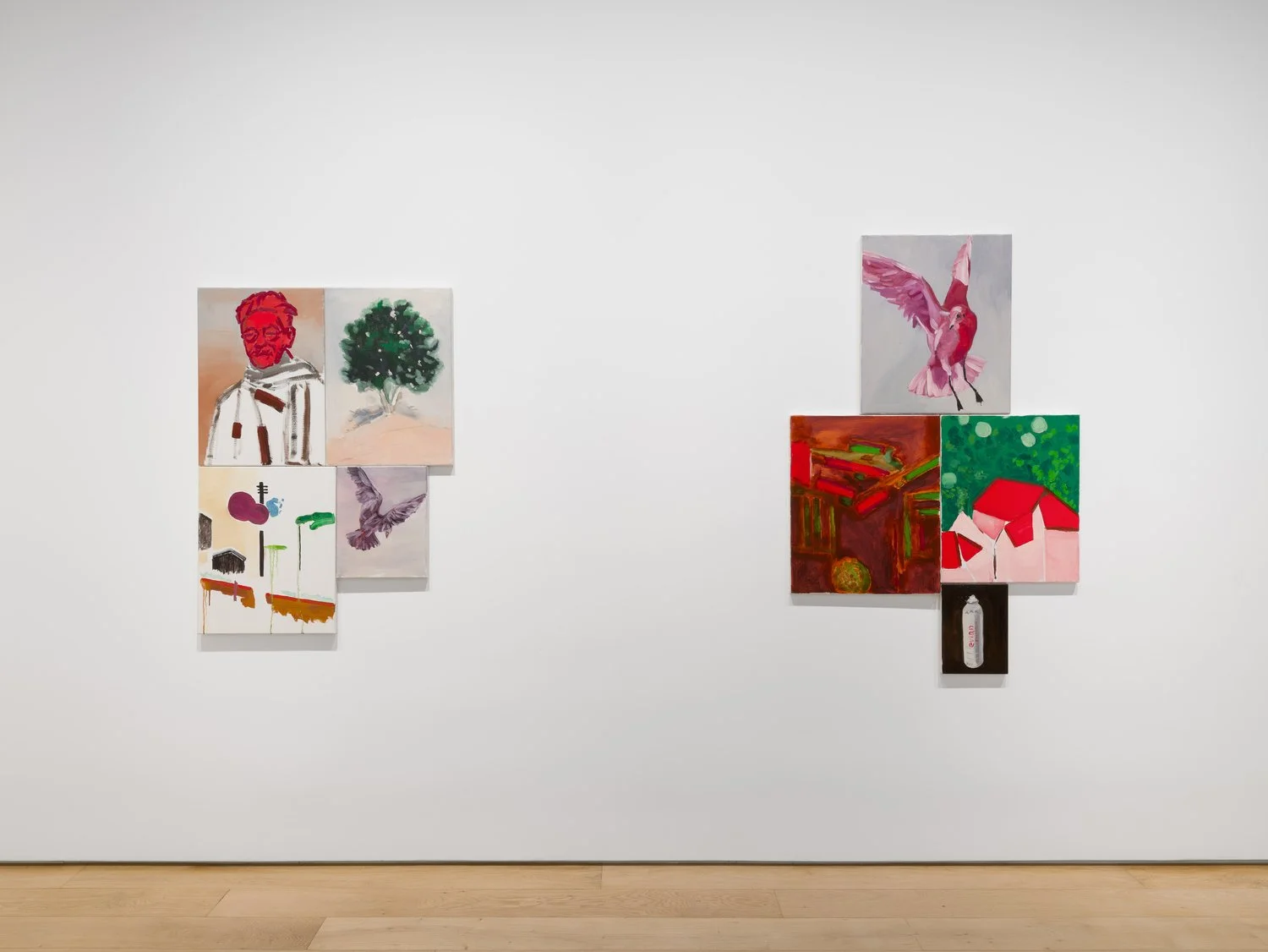
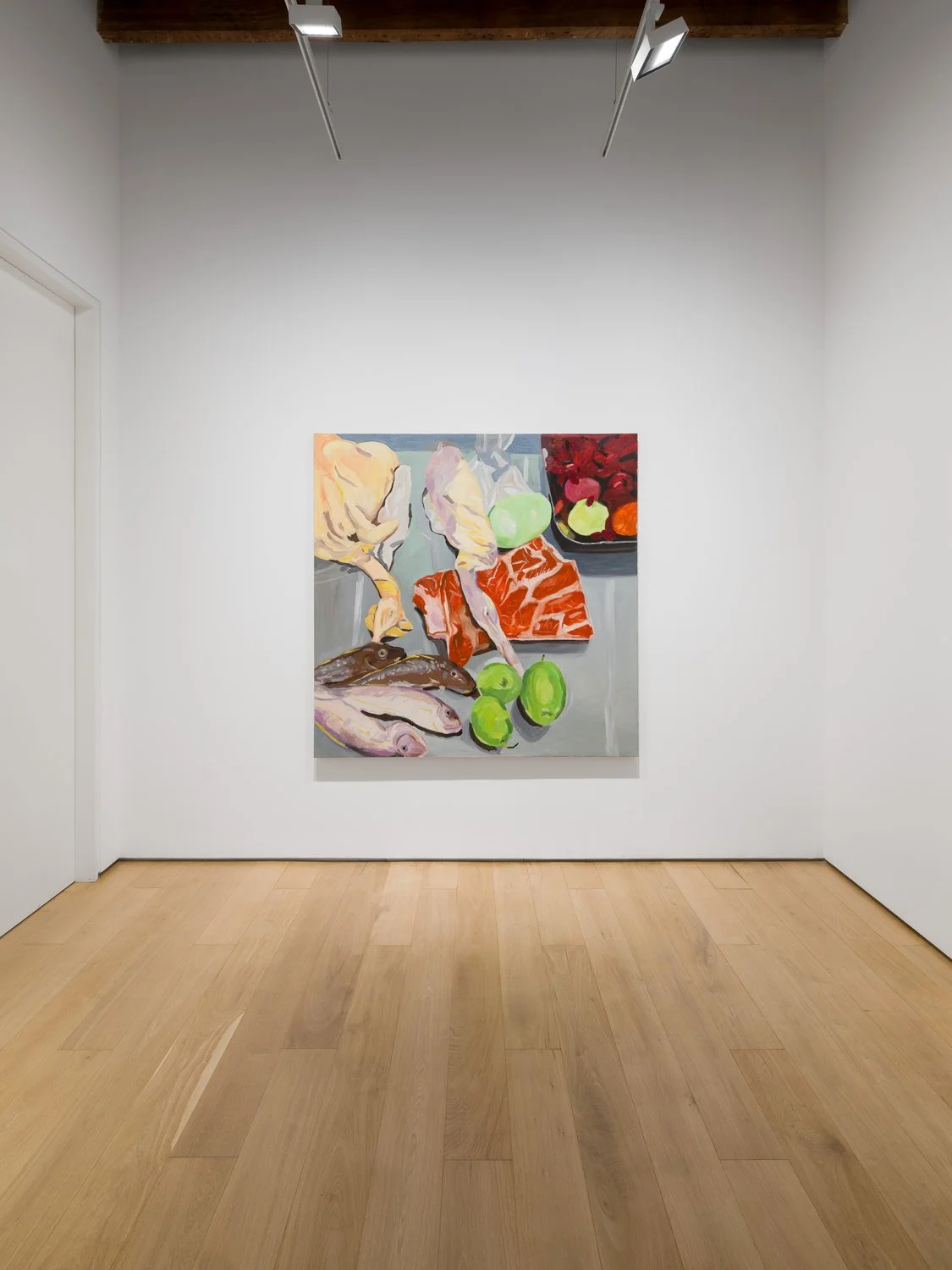

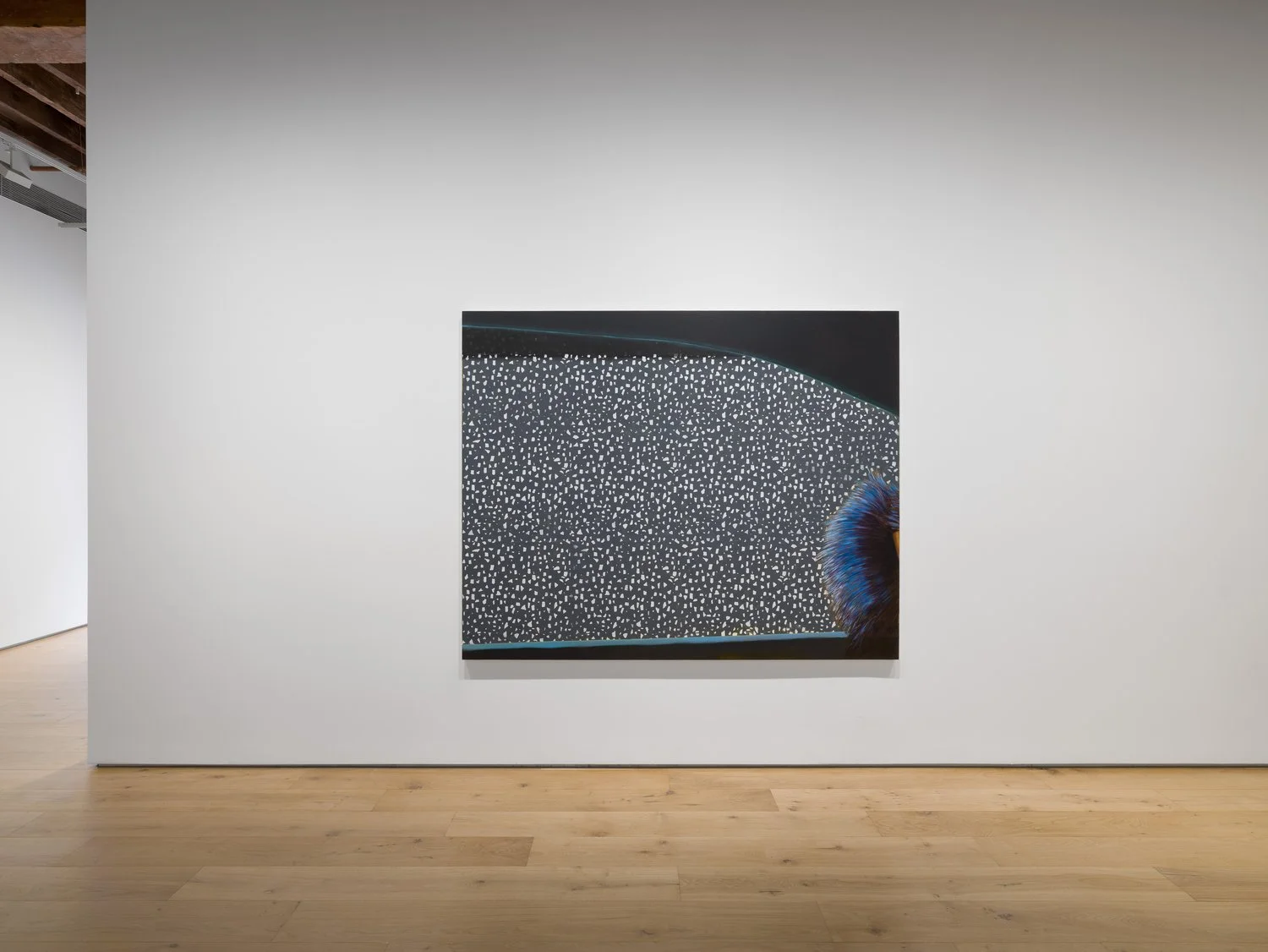
Installation view of Depictura, 6 September –25 October 2025, Lisson Gallery, Shanghai. Courtesy Lisson Gallery. Photography by Alessandro Wang
Lisson Gallery Shanghai brings together three figurative artists – Dexter Dalwood, Van Hanos and Zhao Gang – whose works collapse and expand space and time, traversing the borders between hyperrealism, abstraction and imagined realities. Each creates object-worlds for viewers to travel through, using spatial ambiguity and surreal juxtaposition to imbue two-dimensional images with three-dimensional ambitions.
Taking its title from Leon Battista Alberti's original treatise on line and perspective in art, De Pictura (On Painting) from 1450, this exhibition also marks a moment when the poles of flatness and depth shift — as it was in the transition from the Medieval to the Renaissance — and explores the possibilities that exist between two and three dimensions. To 'depict' is also to paint or document what is in front of the beholder, an act of looking and absorbing that nevertheless reveals different approaches in these three painters.
Installation view of Depictura, 6 September –25 October 2025, Lisson Gallery, Shanghai. Courtesy Lisson Gallery. Photography by Alessandro Wang
Each work in this selection of paintings portrays elements of visible or recognisable reality, but simultaneously combines these physical and painterly sensibilities with interruptions, whether symbolic gestures, innovative mark-making or imagistic collage. Each artist can also be said to embody or refer back to some of the key tenets of (Western) art history – employing the traditions of landscape, still-life and history painting, for example – while also breaking down these hierarchies and creating new literary, cinematic and political fields for experimentation.
From Left to Right: Dexter Dalwood 德克斯特·达尔伍德 Hard 倾盆大雨 2018 Oil on canvas 帆布、油彩 131 x 97 cm 51 5/8 x 38 1/4 in © Dexter Dalwood. Courtesy Lisson Gallery, Dexter Dalwood 德克斯特·达尔伍德 Lux 光 2018 Oil and acrylic on canvas 帆布、油彩、丙烯 182 x 228 cm 71 5/8 x 89 3/4 in © Dexter Dalwood. Courtesy Lisson Gallery, Dexter Dalwood 德克斯特·达尔伍德 2059 (knife) 2059 (刀) 2021 Oil on canvas 帆布、油彩 60 x 72 cm 23 5/8 x 28 3/8 in © Dexter Dalwood. Courtesy Lisson Gallery
In Dexter Dalwood’s practice, the medium of painting is not only examined and celebrated in terms of its history and legacy; he also demonstrates the enduring contemporary relevance of painting as a way of communicating how we experience the world in which we live. In Hard and Lux (both 2018), Dalwood harks back to the origin of post-Impressionist painting by constructing a space for contemplation and solitude in the image of natural phenomena. The act of looking becomes disrupted — the viewers are placed inside a vehicle, looking out through a rain-streaked windshield or a snow-filled backseat window. While in 2059 (knife) (2021), the artist scales this oil on canvas to Jean-Siméon Chardin’s The House of Cards (1737), offering a reflection on the medium today, and stretching his references across time to juxtapose classical still-life motifs with bright, futuristic planets and galaxies.
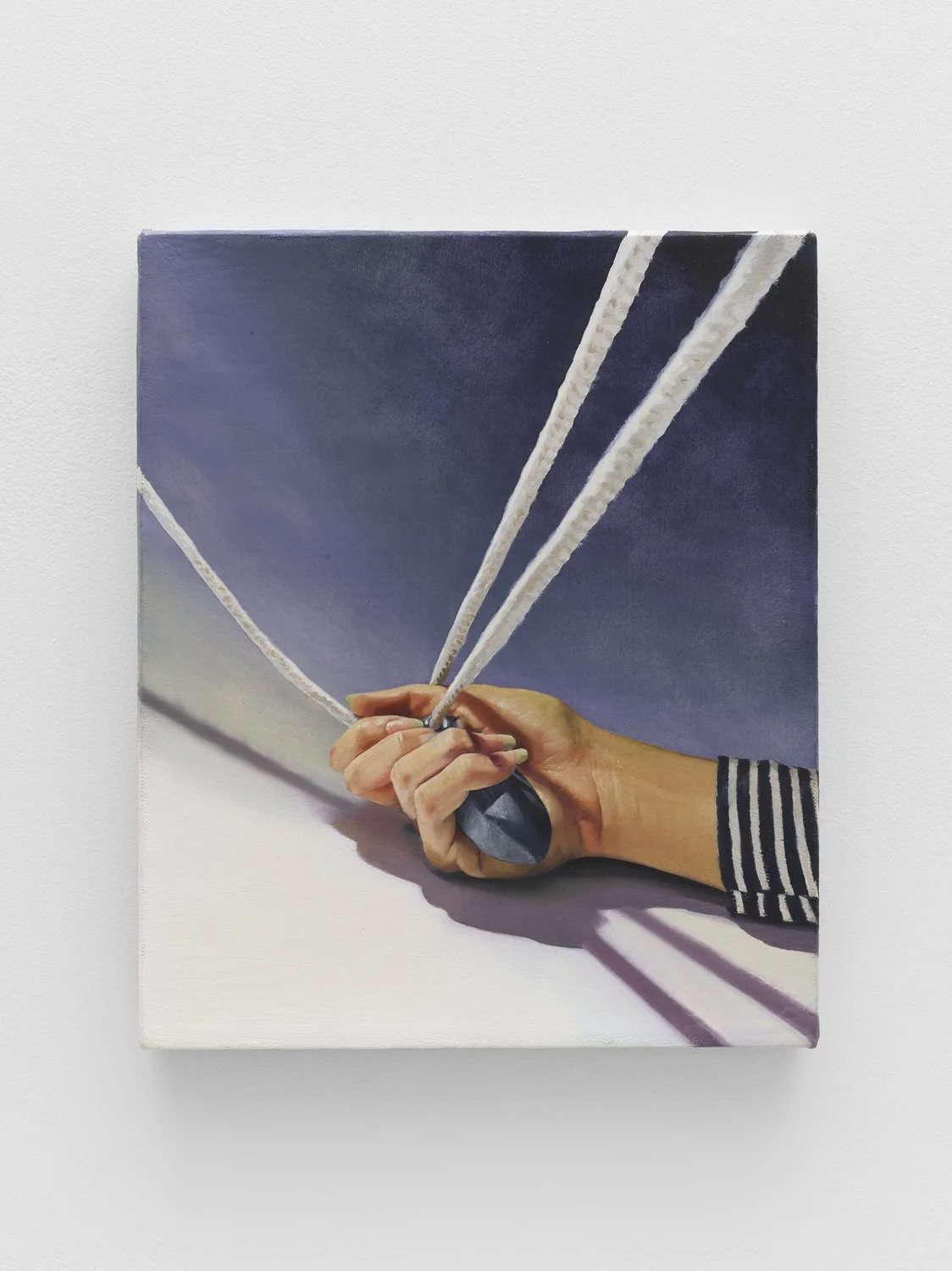

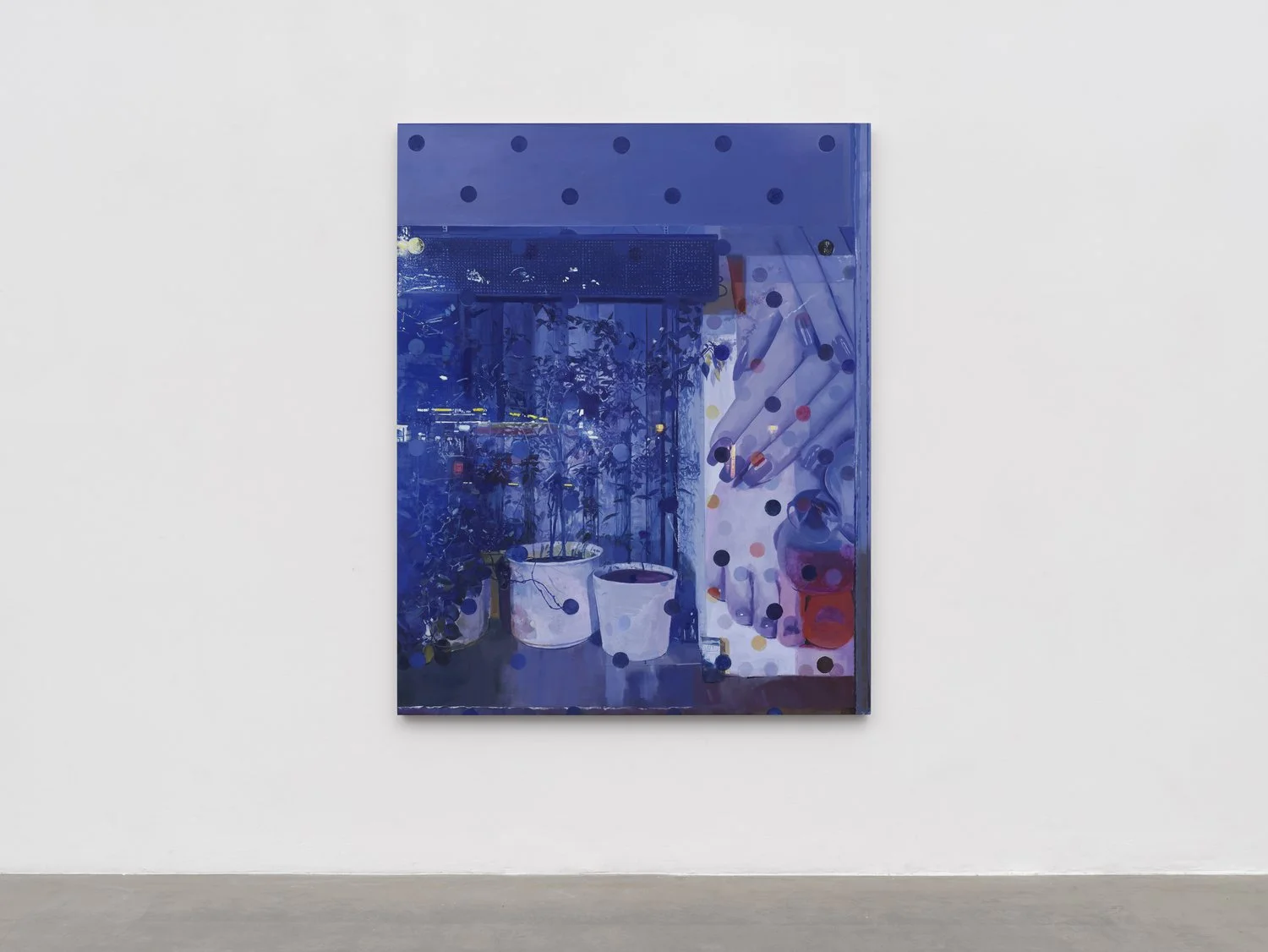
From Left to Right:Van Hanos 范·海诺斯 Kyra's Hand 凯拉的手 2017 Oil on linen 亚麻布、油彩 31.1 x 25.7 x 2.2 cm 12 1/4 x 10 1/8 x 7/8 in © Van Hanos. Courtesy Lisson Gallery, Van Hanos 范·海诺斯 Sleepy Hollow 沉睡谷 2021 Oil on linen亚麻布、油彩 30.5 x 25.4 x 2.5 cm 12 x 10 x 1 in © Van Hanos. Courtesy Lisson Gallery ,Van Hanos 范·海诺斯 The Ambulance 救护车 2023 Oil on linen 亚麻布、油彩 190.5 x 152.5 x 4 cm 75 x 60 x 1 5/8 in © Van Hanos. Courtesy Lisson Gallery
Van Hanos’ approach to painting is best undefined, forsaking particular modes or methods. Ranging from landscape to portraiture, beyond categorisation as either figuration or abstraction, his work navigates perceptual shifts and thematic rupture. Hanos explores the tremendous range of possibilities within the human mind and experience, and his paintings can be created as meticulous oil renderings of images taken from photographs, with technical precision and photographic tendencies, or as sublime, abstracted amalgamations of past observations and ruminations, replete with internal references to other paintings or past subjects, and layered with meaning. Hanos’ work always beckons the viewer to look closer—as what one first experiences is undoubtedly bound to shift upon continued investigation.
From Left to Right: Zhao Gang 赵刚 Chicken, Duck and Fish鸡鸭鱼肉 2023 Oil on canvas 帆布、油彩 180 x 180 cm 70 7/8 x 70 7/8 in © Zhao Gang. Courtesy Lisson Gallery ,Zhao Gang赵刚 Forever the City 3 永恒的城市3 2025 Oil on canvas帆布、油彩 Overall dimensions variable 尺寸可变 © Zhao Gang. Courtesy Lisson Gallery ,Zhao Gang 赵刚 Forever the City 5 永恒的城市5 2025 Oil on canvas帆布、油彩 Overall dimensions variable 尺寸可变 © Zhao Gang. Courtesy Lisson Gallery
In his work, Zhao Gang delves into the fluidity of individual identities, the clash of cultures, and the intricate interplay of fragmented historical events. In Chicken, Duck and Fish (2023), raw-cuts of meat, poultry and fish collectively serve as an alternative 'self-portrait' through which Zhao suggests identity is something ‘eaten’ and reassembled through desire, power, and the mythologies of East and West. Alongside this are a pair of collages drawn from Zhao’s personal resonance to Qingdao, where he first visited in 1978.Taking the style of montage to reflect the artist’s past and present memories of the coastal city in China's Shandong Province, the fragmented composition also evokes social media grids, inviting viewers to form their own interpretations and narratives.
About the artists
Dexter Dalwood (b. 1960, Bristol, UK) is based in Mexico City. In 2017 he undertook a residency in Oaxaca and made a series titled An Inadequate Painted History of Mexico on his return to London, which has since featured in the touring show, 'Esto No Me Pertenece' at Centro de las Artes San Agustín, Oaxaca, Mexico and Museo Nacional de Arte (MUNAL), Mexico City, Mexico (2021-22). Dalwood’s other major solo museum shows include Kunsthaus Centre PasquArt, Biel, Switzerland (2013); CAC Málaga, Spain (2010); FRAC Champagne-Ardennes, Reims, France (2010) and Tate, St. Ives, UK (2010).
Van Hanos (b. 1979, Edison, USA) lives and works in Marfa. He has a BA from Maryland Institute College of Art, Baltimore, MD, USA (2001), and an MFA from the School of the Arts at Columbia University, New York, NY, USA (2010). Recent solo exhibitions include Twin at Lisson Gallery, London, UK (2022); Conditional Bloom at Lisson Gallery, New York, NY, USA (2021); Interiors at Château Shatto, Los Angeles, CA, USA (2020); Mommy’s Boy at Cleopatra’s, New York, NY, USA (2017); Late American Paintings at Château Shatto, Los Angeles, CA, USA (2017); Awake At The Funeral at Tanya Leighton, Berlin, Germany (2017); Van Hanos at Parapet Real Humans, St. Louis, MO, USA (2017); and Intercalaris at Rowhouse Project, Baltimore, MD, USA (2016).
Zhao Gang (b. 1961, Beijing, China) is based in New York and Beijing. He obtained a Master of Arts degree from Bard College, New York (1999). Zhao Gang’s recent solo exhibitions includes TAG Art Museum, Qingdao, China (2025); D+ Museum, Shenzhen, China (2024); Long Museum, Chongqing, China (2022); Long Museum, Shanghai, China (2021); Kuandu Museum of Fine Arts, Taipei (2020); Pérez Art Museum, Miami, FL, USA (2019); Museum of Contemporary Art, Santiago, Chile (2016); Ullens Center for Contemporary Art, Beijing, China (2015); Today Art Museum, Beijing, China (2011); Hong Kong Arts Centre, Hong Kong, China (2008); and He Xiangning Art Museum, Shenzhen, China (2006).
About Lisson Gallery
Lisson Gallery is one of the most influential and longest-running international contemporary art galleries in the world. Today the gallery supports and promotes the work of more than 70 international artists across spaces in London, New York, Los Angeles, Shanghai and Beijing. Established in 1967 by Nicholas Logsdail, Lisson Gallery pioneered the early careers of important Minimal and Conceptual artists such as Art & Language, Carl Andre, Daniel Buren, Donald Judd, John Latham, Sol LeWitt, Richard Long and Robert Ryman among many others. It still works with many of these artists and others of that generation, from Carmen Herrera and Olga de Amaral to Hélio Oiticica and Lee Ufan. In its second decade the gallery introduced significant British sculptors to the public for the first time, including Tony Cragg, Richard Deacon, Anish Kapoor, Shirazeh Houshiary and Julian Opie. Since 2000, the gallery has gone on to represent many more leading international artists such as Marina Abramović, Ai Weiwei, John Akomfrah, Liu Xiaodong, Otobong Nkanga, Pedro Reyes, Sean Scully, Hiroshi Sugimoto and Wael Shawky. It is also responsible for raising the international profile of a younger generation of artists including Dana Awartani, Cory Arcangel, Garrett Bradley, Ryan Gander, Hugh Hayden, Haroon Mirza, Laure Prouvost and Cheyney Thompson.
The exhibition opened on 6 September – 25 October 2025 2/F, 27 Huqiu Road, Shanghai.
For more information about this exhibition and others, please visit the Lisson Gallery here. The gallery can also be found on Facebook, YouTube, and Instagram.
Hélio Oiticica
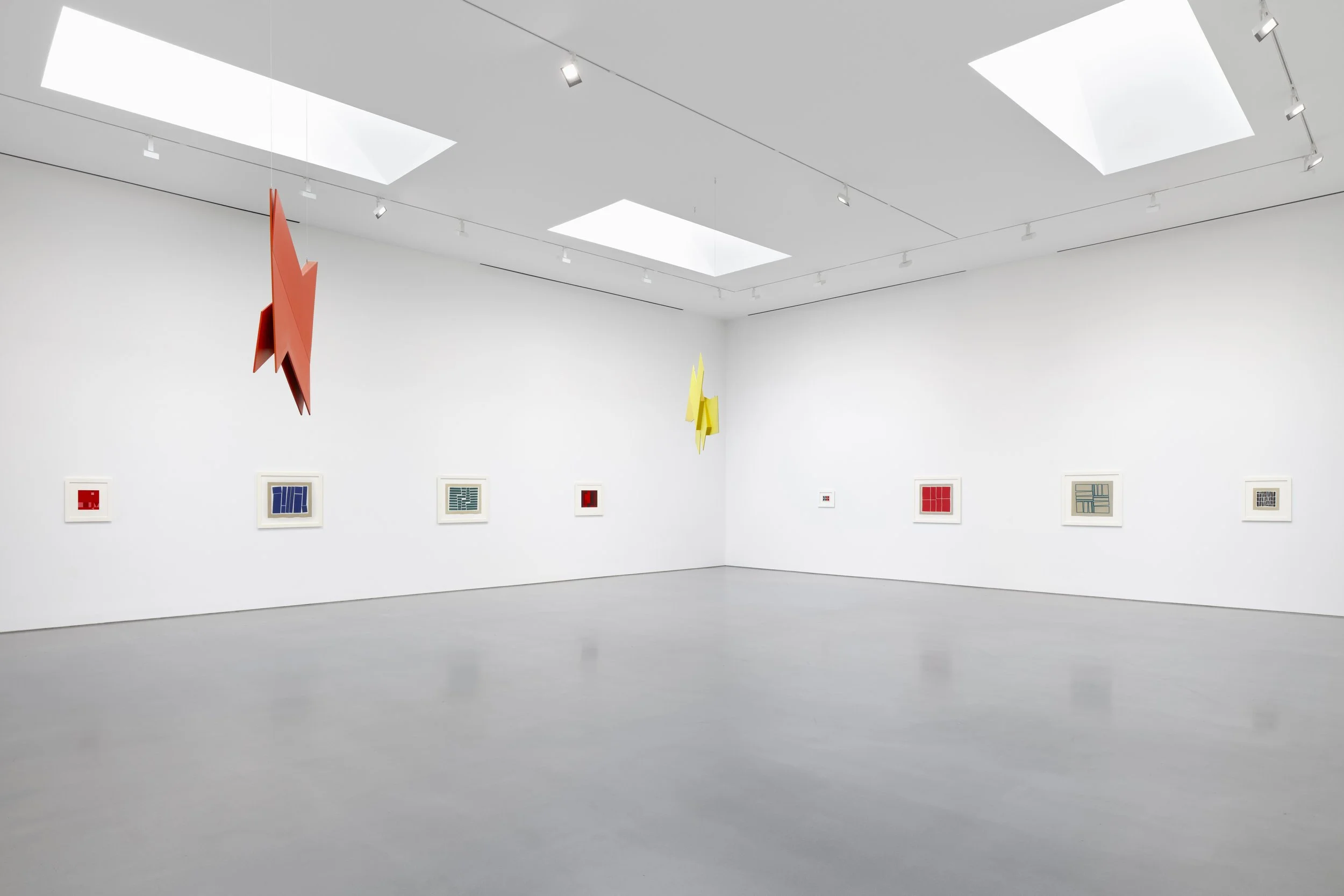



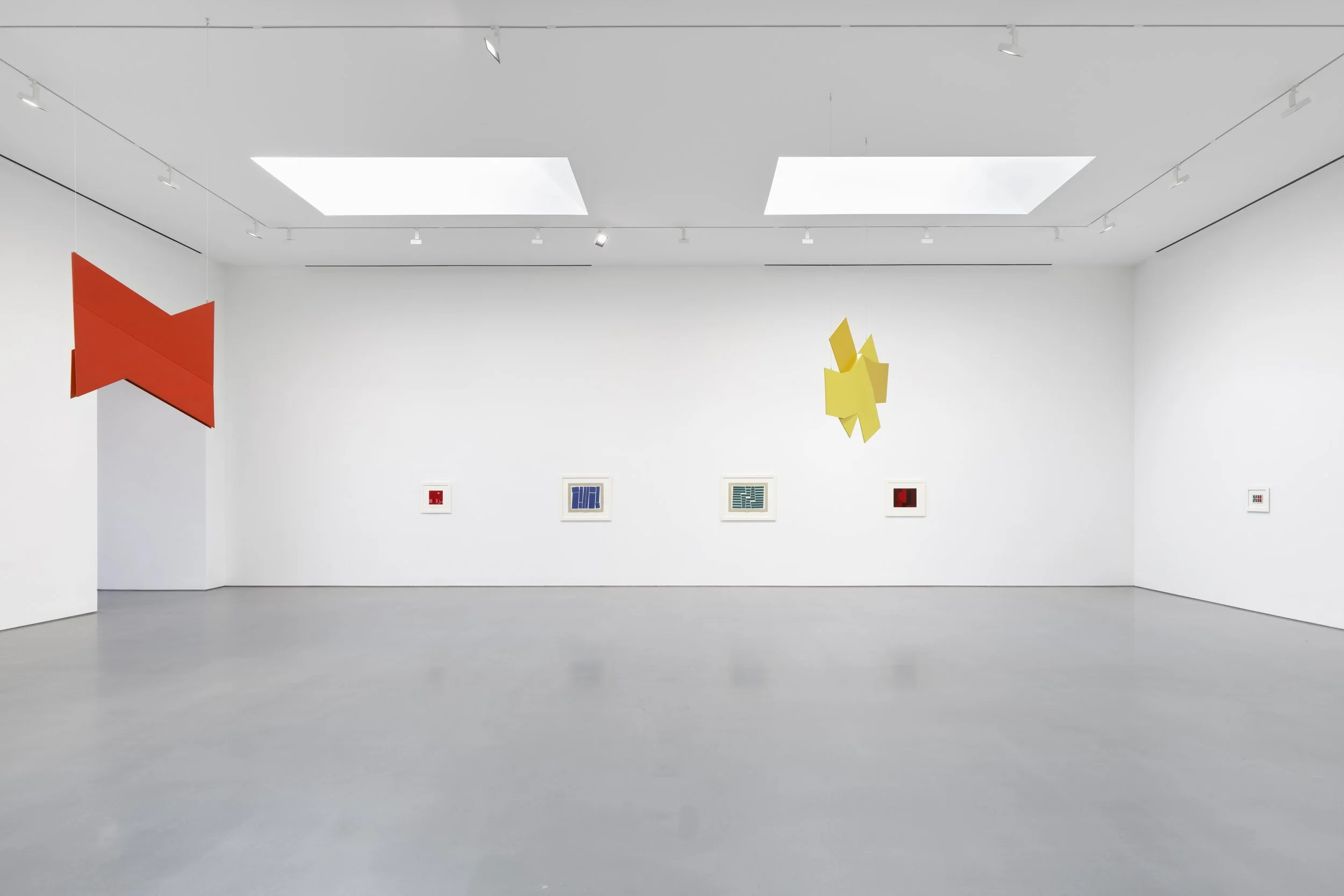
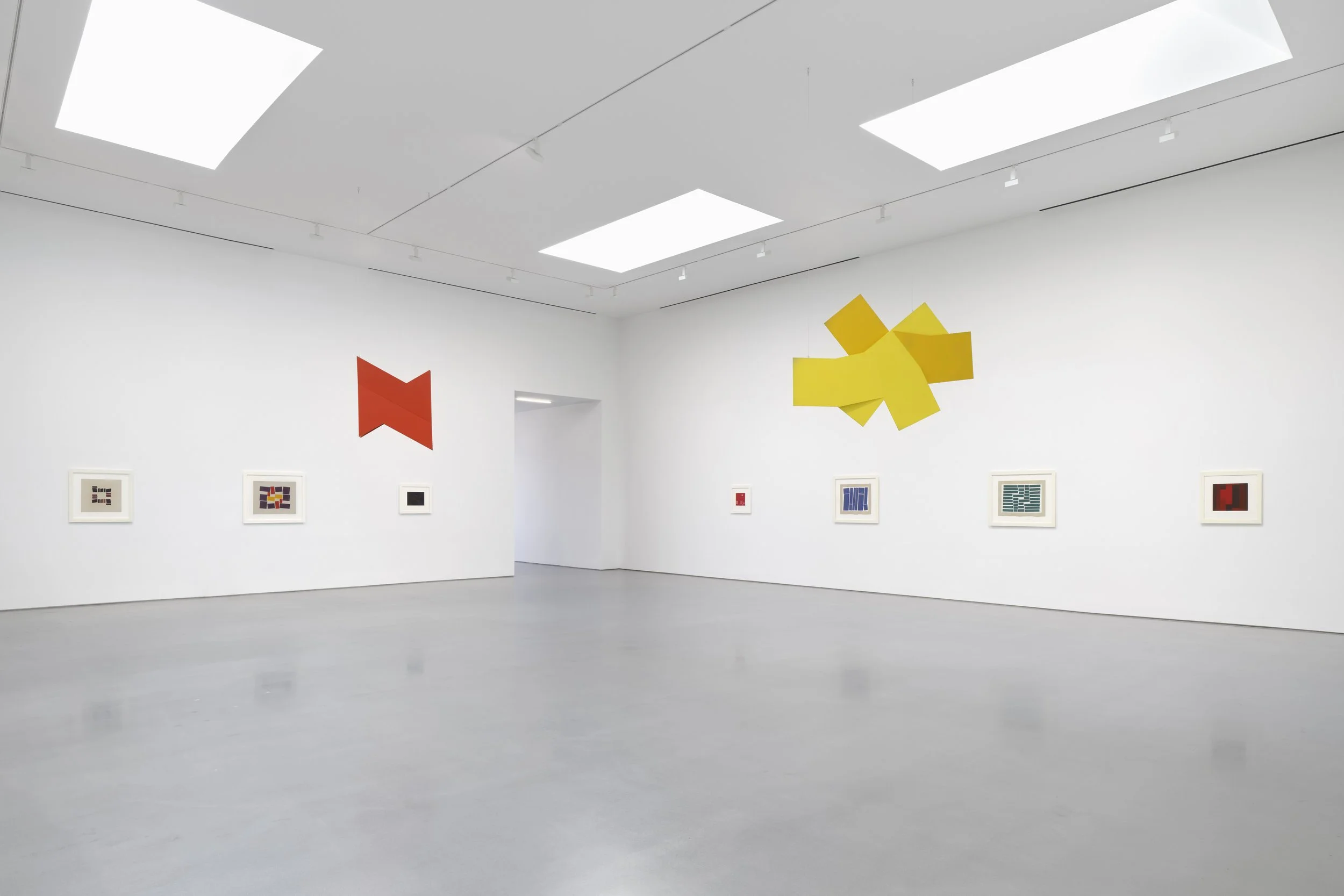
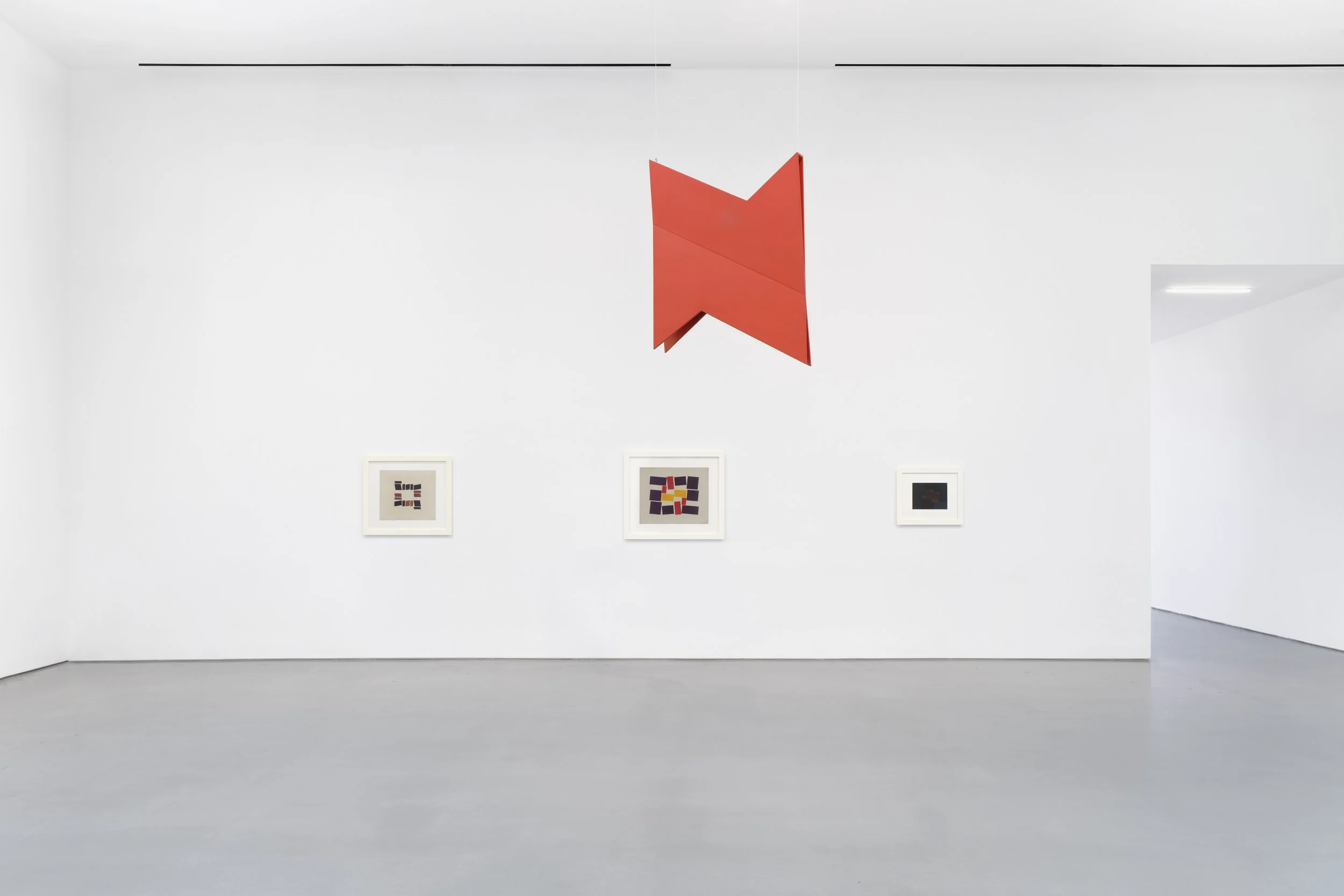
Exhibition view of ‘Hélio Oiticica’ at Lisson, Gallery Los Angeles, 17 September – 1 November 2025 © César and Claudio Oiticica, Courtesy Lisson Gallery
In the first major exhibition in Los Angeles dedicated to the art of Hélio Oiticica (1937–1980), Lisson Gallery presents a selection of the artist’s seminal compositions, including vibrant gouaches, and dynamic suspended sculptures, and a rare oil painting. Highlighting the formative years of Oiticica’s career, the exhibition charts his trajectory from early geometric abstraction to immersive environments that transformed the viewer’s experience with art and space.
From Left to Right: Hélio Oiticica Untitled, 1958 Gouache on cardboard 49.8 x 67 cm 19 5/8 x 26 3/8 in © César and Claudio Oiticica, Courtesy Lisson Gallery,Hélio Oiticica Untitled (Metaesquema), 1958 Gouache on cardboard 52 x 63.5 cm 20 1/2 x 25 in © César and Claudio Oiticica, Courtesy Lisson Gallery, Hélio Oiticica Untitled (Metaesquema), 1958 Gouache on cardboard 53.2 x 58 cm 21 x 22 7/8 in © César and Claudio Oiticica, Courtesy Lisson Gallery
While living in Washington, D.C., from 1947 to 1949, Oiticica was first introduced to the art and theories of Paul Klee, Kazimir Malevich, and Piet Mondrian at the National Gallery of Art. At sixteen, he began studying under artist Ivan Serpa at the Museum of Modern Art in Rio de Janeiro and soon joined the Grupo Frente (1954–56), a collective of innovative artists led by Serpa. Oiticica’s earliest works—gouache on cardboard—reflect both his fascination with European modernism and his engagement with Grupo Frente. United in their rejection of academic and figurative Brazilian modernism, the Grupo Frente embraced experimentation and explored diverse abstract and constructivist visual languages. Their approaches emphasized color, structure, and technical innovation—sometimes diverging sharply from one another. Among the works in the exhibition is a rare Grupo Frente-period gouache on masonite painting by Oiticica, exemplifying the visual strategies and material processes that defined the collective.
Hélio Oiticica Untitled, 1955 Gouache on cardboard 12 x 17.5 cm 4 3/4 x 6 7/8 in © César and Claudio Oiticica, Courtesy Lisson Gallery
Throughout 1957-58, Oiticica continued to analyze the roles of color, structure and space in the production of his iconic series of Metaesquemas (a title that translates roughly as ‘metaschemes’ or ‘metastructures’). These comprise multiple variations upon a basic structure – usually rectangular or rhomboid shapes arrayed in a tentative grid over a single underlying color. Only six Metaesquemas were made in oil on canvas, and of these, only four survive. Metaesquema (1958) is a single vertical instance, consisting of two columns of rectangles arrayed in brick-like tiers against a grey-blue background. The individual shapes tilt in defiance of the grid, as though the ordering logic of the composition was beginning to unravel. The semblance, in this painting, of a real-life edifice – its spatial depth tentatively implied by the vertical centreline – anticipates Oiticica’s shift into three-dimensional structures.
Hélio Oiticica Untitled, 1955 Gouache on cardboard 27.9 x 35.6 cm 11 x 14 in © César and Claudio Oiticica, Courtesy Lisson Gallery
This variation in his work culminated in the creation of the Spatial Reliefs, suspended structures conceived as “paintings in space” that activate volume, color, and the viewer’s movement. Made from cut and painted wooden planes, these works extend the logic of painting into three dimensions, creating new spatial-temporal relationships between artwork and observer.
Hélio Oiticica Metaesquema, 1958 Oil on canvas 73 x 60.3 x 2.9 cm 28 3/4 x 23 3/4 x 1 1/8 in © César and Claudio Oiticica, Courtesy Lisson Gallery
By the early 1960s, Oiticica was redefining the very purpose of art. His immersion in the everyday life of Rio’s Mangueira favela led him to develop “environmental art”—works that embraced participation, embodiment, and social experience. Whether in the Grupo Frente gouaches, the Metaesquemas or the intricate volumetric structures of the Spatial Reliefs, his work of the 1950s and ’60s harbors a generative tension – that of constituent elements poised between coherence and dispersal: between autonomous art object and inchoate world. In this regard, the works precede the radical deconstructive impulse of his multi-sensory architectural environments of the 1970s.
Hélio Oiticica Untitled (Metaesquema), 1958 Gouache on cardboard 54.6 x 64.1 cm 21 1/2 x 25 1/4 in © César and Claudio Oiticica, Courtesy Lisson Gallery
While this exhibition marks Oiticica’s first solo presentation in Los Angeles, his art has received significant institutional recognition in the region. The Los Angeles County Museum of Art (LACMA) holds in its collection two Metaesquemas from the late 1950s, as well as a Penetrable from 1979. In 2010, Oiticica’s iconic blue-lit swimming pool installation from 1973, a collaboration with Neville D’Almeida, was featured in Suprasensorial at the Museum of Contemporary Art. His influence continues to expand: this December, Dia Beacon will restage Oiticica’s monumental installation Grande Núcleo (Grand Nucleus), NC3, NC4, NC6 (1960–63), alongside a selection of other major works.
About the artist
Hélio Oiticica (1937 – 1980) is widely regarded as one of Brazil’s leading artists of the twentieth century and a touchstone for much contemporary art made since the 1960s, primarily through his freewheeling, participatory works of art, performative environments, avant-garde films and abstract paintings. Even before the age of 20, Oiticica was a key member of the historic Rio de Janeiro-based Grupo Frente (1954-56), his radical play with geometric form and vibrant colors transcending the minimal lines of European constructivism and imbuing his work with an exuberant rhythm that resonated with the avant-garde music and poetry of his native Brazil. In the late 1950s, Oiticica would go on to become a leading figure of Brazilian Neo-Concretism (1959-61) that included other ground breaking artists such as Lygia Clark, Lygia Pape and the poet Ferreira Gullar, ultimately giving rise to the artistic movement known as Tropicalismo, named for a work of Oiticica’s from 1967.
Increasingly, Oiticica became a countercultural figure and underground hero, foregrounding bodily interaction with spatial and environmental concerns over pure aesthetics. “Ambient art,” he wrote, “is the overthrow of the traditional concept of paintingframe and sculpture – that belongs to the past. It gives way to the creation of ‘ambiences’: from there arises what I call ‘antiart,’” which he later defined as “the era of the popular participation in the creative field.” This generous and generative practice would become highly influential for subsequent generations of artists, especially his Parangolés or ‘habitable paintings’ and all-encompassing series of installations, known variously as Núcleos (ceiling-hung geometric panels forming gradual chromatic experiences) and Propositions or Penetrables (labyrinth-like architectural environments made of sand and semi-permeable cabins). This supra-sensorial approach continued until his untimely death in 1980 at the age of 42.
Oiticica’s work has been the subject of many major museum exhibitions, including the critically acclaimed retrospectives Hélio Oiticica: Dance in my Experience at the Museu de Arte de São Paulo and the Museu de Arte Moderna do Rio de Janeiro in 2020-2021, and Hélio Oiticica: To Organize Delirium, which debuted at the Carnegie Museum of Art in Philadelphia in 2016 and traveled to the Art Institute of Chicago and the Whitney Museum of American Art in 2017. Dia: Beacon will open a solo presentation of his work in November 2025. Hélio Oiticica: The Body of Color was exhibited at The Museum of Fine Arts, Houston in 2006-2007 and in London at the Tate Modern in 2007. His work is included in the collections of numerous international institutions including Carnegie Museum of Art, Pittsburgh, PA, USA; Inhotim Centro de Arte Contemporãnea, Belo Horizonte, Brazil; Los Angeles County Museum of Art, Los Angeles, CA, USA; Museo de Arte Reina Sofia, Madrid, Spain; Museu de Arte Moderna, Rio de Janeiro, Brazil; Museum of Fine Arts, Houston, TX, USA; Museum of Modern Art, New York, NY, USA; Tate Modern, London, UK; Walker Art Center, Minneapolis, MN, USA; the Guggenheim Abu Dhabi, United Arab Emirates; and the Pérez Art Museum Miami, FL, USA, among others. The Projeto Hélio Oiticica was established in Rio de Janeiro in 1980 to manage the artist’s estate.
About Lisson Gallery
Lisson Gallery is one of the most influential and longest-running international contemporary art galleries in the world. Today the gallery supports and promotes the work of more than 70 international artists across spaces in London, New York, Los Angeles, Shanghai and Beijing. Established in 1967 by Nicholas Logsdail, Lisson Gallery pioneered the early careers of important Minimal and Conceptual artists such as Art & Language, Carl Andre, Daniel Buren, Donald Judd, John Latham, Sol LeWitt, Richard Long and Robert Ryman among many others. It still works with many of these artists and others of that generation, from Carmen Herrera and Olga de Amaral to Hélio Oiticica and Lee Ufan. In its second decade the gallery introduced significant British sculptors to the public for the first time, including Tony Cragg, Richard Deacon, Anish Kapoor, Shirazeh Houshiary and Julian Opie. Since 2000, the gallery has gone on to represent many more leading international artists such as Marina Abramović, Ai Weiwei, John Akomfrah, Liu Xiaodong, Otobong Nkanga, Pedro Reyes, Sean Scully, Hiroshi Sugimoto and Wael Shawky. It is also responsible for raising the international profile of a younger generation of artists including Dana Awartani, Cory Arcangel, Garrett Bradley, Ryan Gander, Hugh Hayden, Haroon Mirza, Laure Prouvost and Cheyney Thompson.
The exhibition opened on 17 September with an opening held from 6 – 8 pm and will be on view until 1 November 2025 at the gallery’s Los Angeles location, 1037 N. Sycamore Ave, Los Angeles.
For more information about this exhibition and others, please visit the Lisson Gallery here. The gallery can also be found on Facebook, YouTube, and Instagram.
GABRIEL OROZCO: Partituras
Gabriel Orozco Exhibition view, Partituras, Marian Goodman Gallery, New York, 2025 Courtesy of the artist and Marian Goodman Gallery Photo credit: Alex Yudzon
Marian Goodman Gallery is very pleased to announce Gabriel Orozco: Partituras, on view in New York from, where the exhibition opened on 12 September and will close on 25 October 2025. For this exhibition, Orozco will present a new series of work which takes its starting point in music. Having played the piano improvisationally for many years, Orozco compares this practice to drawing in time and space, using sound and acoustics. The Partituras paintings explore the translation of these musical sketches into his distinctive geometric language, creating works that resonate with shifting rhythms and tempos.
Gabriel Orozco Exhibition view, Partituras, Marian Goodman Gallery, New York, 2025 Courtesy of the artist and Marian Goodman Gallery Photo credit: Alex Yudzon
In her text on the new series, the art historian Briony Fer writes: “if Orozco’s unlikely course in this new body of work explores a relationship to music, it is, of course, not in search of the spiritual in art. Instead, he turns this mythic origin on its head to break the musical score down into its most basic material units; instead of striving for the vibration of the soul, he explores the vibrations within a particular situation. Orozco treats the musical score as an interface between the act of playing the piano and the act of making a painting. They are not inspired by the music of a particular composer like, say, Brancusi making a sculpture in response to a piece by Erik Satie. In this case, the relationship between painting and music is absolutely not the ‘theme’ of the work, but simply provides a procedure – and a space to work in and through a set of rules that he sets himself.”
Gabriel Orozco Exhibition view, Partituras, Marian Goodman Gallery, New York, 2025 Courtesy of the artist and Marian Goodman Gallery Photo credit: Alex Yudzon
Elaborating on the process Orozco uses to create the Partituras, Fer writes that it “is a series of translations, that take place over an extended period of time. It’s a variation on the way Orozco made the Samurai Tree paintings based on the rotation of the knight’s move in chess. But now there are several stages involved: from playing, to recording, to listening, to transcribing, to drawing, to transferring, to painting. These allow for multiple spatial and temporal transpositions. It’s important that the titles consist only of the date and the time he played the piece on the piano, although evidently the painting we are seeing has undergone several phases to become the precision diagram that it is. The process is circuitous – but as Orozco has said, it’s possible a musician could actually ‘read’ the Partituras paintings and make musical sense of them. There are certainly aspects of encoding and recoding that happen as he turns the score into his own system of geometry. In the process, one could say that the artist creates his own semiotic system, translating each individual note into a corresponding sign. After all the mediations involved in the process of making them, perhaps the paintings can be seen as ‘time-pieces’ of an unconventional kind, where the medium of time itself is at stake.”
Gabriel Orozco (b. 1962) divides his time between Mexico City, Paris, Tokyo, and New York. A major retrospective of his work traveled from 2009 to 2011, starting at the Museum of Modern Art, New York and moving on to the Kunstmuseum Basel, Switzerland, the Centre Pompidou, Paris and the Tate Modern, London. His most recent exhibition was held at the Museo Jumex in Mexico City (2025). In 2025 Orozco received the Commander of the Ordre des Arts et des Lettres by the French Ministry of Culture. Over the last decade, Orozco has developed a number of permanent landscape design projects for museums and public spaces which include the South London Gallery garden (2013-2016), Chapultepec Park in Mexico City (2019-2025), and the Leeum Museum garden in Seoul (2022-2025). Latest publications on Orozco’s work include Politécnico Nacional, with texts by Briony Fer and Benjamin H.D. Buchloh, (Rizzoli, 2025), Working Tables / Spacetime, text by Benjamin H.D. Buchloh (Marian Goodman Gallery, 2024), and Diario de Plantas (Zolo Press, 2023).
Gabriel Orozco Exhibition view, Partituras, Marian Goodman Gallery, New York, 2025 Courtesy of the artist and Marian Goodman Gallery Photo credit: Alex Yudzon
About Marian Goodman Gallery
Marian Goodman Gallery champions the work of artists who stand among the most influential of our time, representing over five generations of diverse thought and practice. What makes the gallery singular is its enduring and deep-rooted collaborations and understanding with the artists—a bond that is concurrent with curators, thought leaders, and art institutions worldwide. The Gallery’s exhibition program, characterized by its caliber and rigor, provides international platforms for its artists to showcase their work, foster vital dialogues with new audiences, and advance their practices within nonprofit and institutional realms.
Our enduring legacy persists through the combined strength and leadership of Partners Rose Lord, Emily Jane Kirwan, Leslie Nolen, and Junette Teng whose extensive tenure with the gallery and its distinguished roster of artists began under Founder Marian Goodman.
Established in 1977 by Goodman, who had earlier co-founded the art publishing company, Multiples, Inc., the Gallery gained prominence early in its trajectory for introducing the work of seminal European artists to American audiences. Synchronous with the mission at hand, Marian and the Gallery were inevitably drawn to Europe, establishing a Paris location in the Marais district in 1995 and an adjacent space for books and editions in 2017. From 2014 until 2022, the Gallery also operated an exhibition space in London.
With its desire to expand and explore growing areas of interest for its artists, the Gallery recently moved its New York City headquarters to the historic Grosvenor building in Tribeca in October 2024 and inaugurated a new permanent space in Los Angeles in September 2023. With two major spaces anchoring each coast, and an ongoing program for over three decades in Paris, Marian Goodman Gallery is committed to further advancing new bodies of work and the creative practices of the leading contemporary artists of our time.
The artists in the Gallery’s program share a culture-critical approach to art, maintain extraordinary perception and integrity, and a tendency in their respective practices to propel the collective experience of art through empowering and sustaining relationships with others. These visionaries, with their distinctive means of expression and technical expertise, have been responsible for inspiring future artists and enriching the dialogue around art. Working in partnership with the Gallery leadership and directors, the artists have continually collaborated to create and stimulate the intellectual discourse within their own work and elsewhere - through their collective knowledge and expertise, the artists have created circles of impact and distinction that continue to impart, illuminate and ground us, and resonate through the industry.
The Gallery represents over fifty artists and estates working in the U.S. and internationally: Eija-Liisa Ahtila, Chantal Akerman, Giovanni Anselmo, Leonor Antunes, Nairy Baghramian, Lothar Baumgarten, Dara Birnbaum, Christian Boltanski, Daniel Boyd, Marcel Broodthaers, Maurizio Cattelan, James Coleman, Tony Cragg, Richard Deacon, Tacita Dean, Rineke Dijkstra, Cerith Wyn Evans, Andrea Fraser, Bernard Frize, Dan Graham, Pierre Huyghe, Cristina Iglesias, Amar Kanwar, Agnieszka Kurant, An-My Lê, Steve McQueen, Julie Mehretu, Annette Messager, Delcy Morelos, Sabine Moritz, Maria Nordman, Gabriel Orozco, Giulio Paolini, Giuseppe Penone, Anri Sala, Matt Saunders, Tino Sehgal, Paul Sietsema, Robert Smithson, Ettore Spalletti, Tavares Strachan, Thomas Struth, Niele Toroni, Álvaro Urbano, Adrián Villar Rojas, Danh Vo, James Welling, Yang Fudong and Jongsuk Yoon.
In addition to its exhibition program, the Gallery’s continued legacy is strengthened by its institutional partnerships and philanthropic efforts. Through organizations such as The Marian Goodman Gallery Initiative in honor of the late Okwui Enwezor, a joint collaborative effort managed by the ICI (Independent Curators Intl.), and the Gallery’s education department, among others, the Gallery has continued to strengthen and expand opportunities for research, education, and access to higher levels of learning, and advocate for building stronger communities of diversity in the realm of art.
The exhibit opened on 12 September and will close on 25 October 2025 at the Gallery’s New York Location at 385 Broadway, New York, NY 10013. There was an opening Reception: 12 September 2025, 6-8 pm
For more information about the exhibit, please visit the Marian Goodman Gallery’s site. The gallery can be found on Instagram and Artsy, too.
Wanda Koop: Magnetic Field
Courtesy of the artist, Night Gallery, Los Angeles and Arsenal Contemporary, New York. Photography by Lance Brewer
Arsenal Contemporary NY, in collaboration with Night Gallery, Los Angeles, is pleased to announce Magnetic Field, a presentation of new paintings by Wanda Koop. The show, Koop’s first solo in New York since 2018, follows Night Gallery’s major historical presentation of Koop’s plywood paintings (1981-90) at Frieze New York 2025. The artist has shown in more than 60 exhibitions internationally.
Koop created her newest body of work in her summer studio at Riding Mountain, Manitoba, a few hours northwest of her long-time home in Winnipeg. The resulting, multi-layered landscapes and skyscapes take inspiration from Koop’s surroundings, which are both idyllic and fragile. Calligraphic reeds break through a tranquil pond in Reed - E, Reed - Gold, and Reed - XO (all 2024). The bright orange sun in Evacuate (2025) evokes the Manitoba fires that recently forced 20,000 residents to leave their homes.
Courtesy of the artist, Night Gallery, Los Angeles and Arsenal Contemporary, New York. Photography by Lance Brewer
Koop's newest paintings offer wry considerations of technological doomerism. She debuts her “AI Ghost Trees,” in which barren tree trunks form the suggestive letters “AI” as if nature itself were warning us of a conspiracy. In her newest moon paintings, Koop seems to be identifying earth’s satellite as the genesis for the circle-centricity of so much modern art. It floats in rippling skies suggesting the unseen electronic currents of a theremin. The artist recently began playing the instrument, which allows her to tap into the intuitive and otherworldly energies that also guide her mark-making.
Koop’s approach to technology embraces double-edged humor and a broader, longer view. It’s unsettling to see a signifier for artificial intelligence in tree trunks, to try to find linguistic configurations in pond reeds and electronic patterns in the night skies. Yet as technology increasingly consumes our daily lives, it becomes impossible to escape its shadow in even the most remote locales.




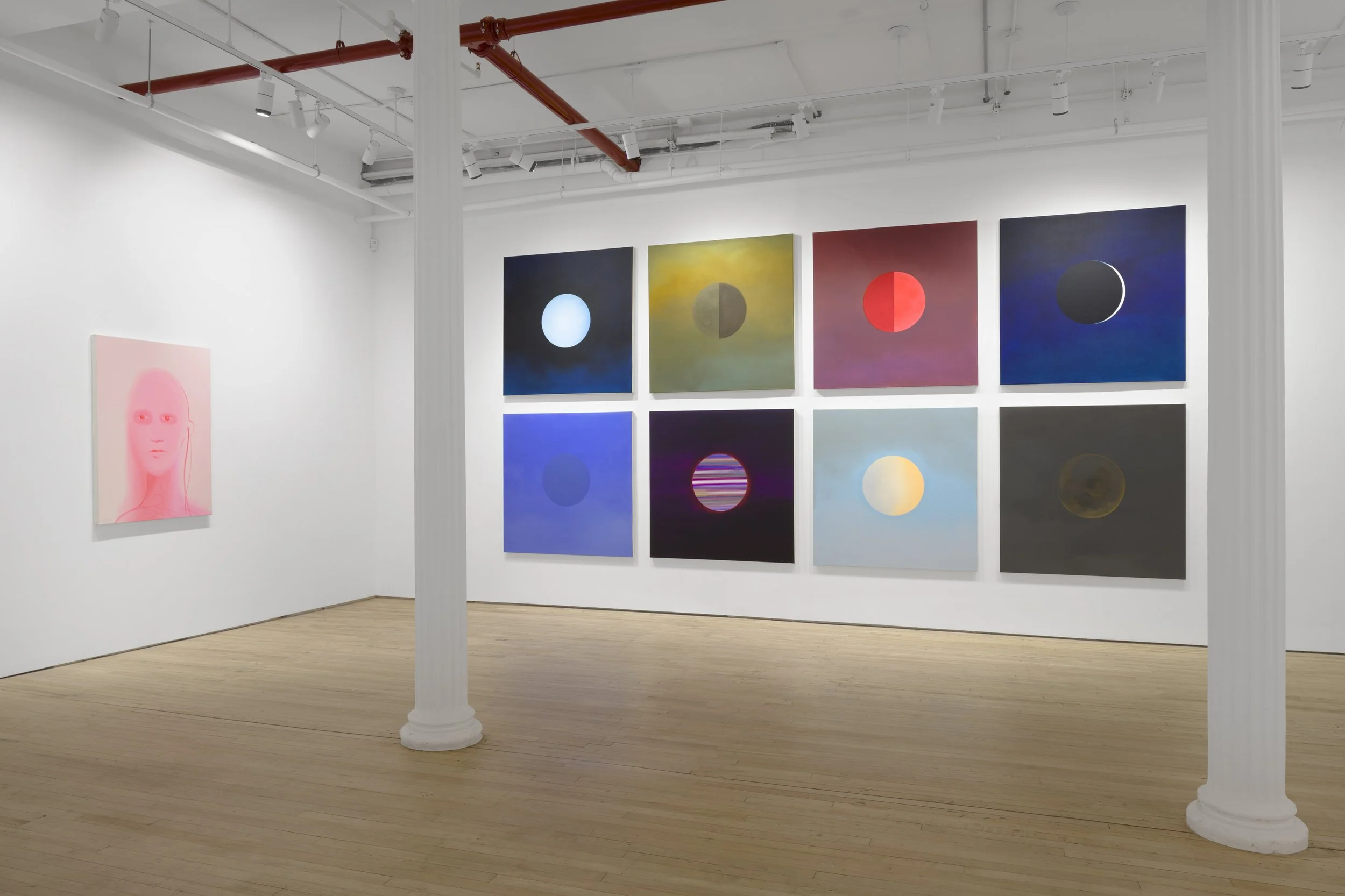
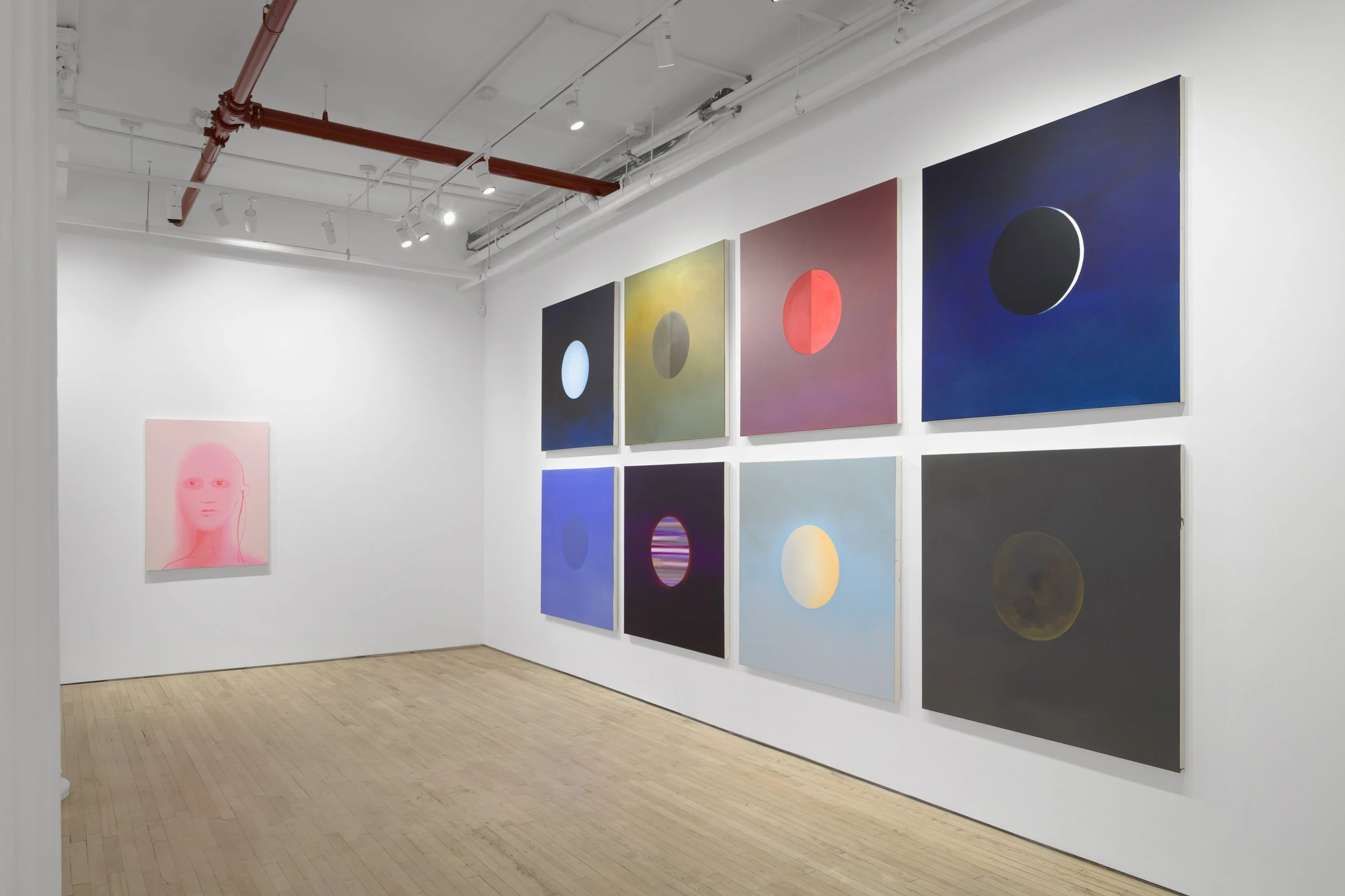
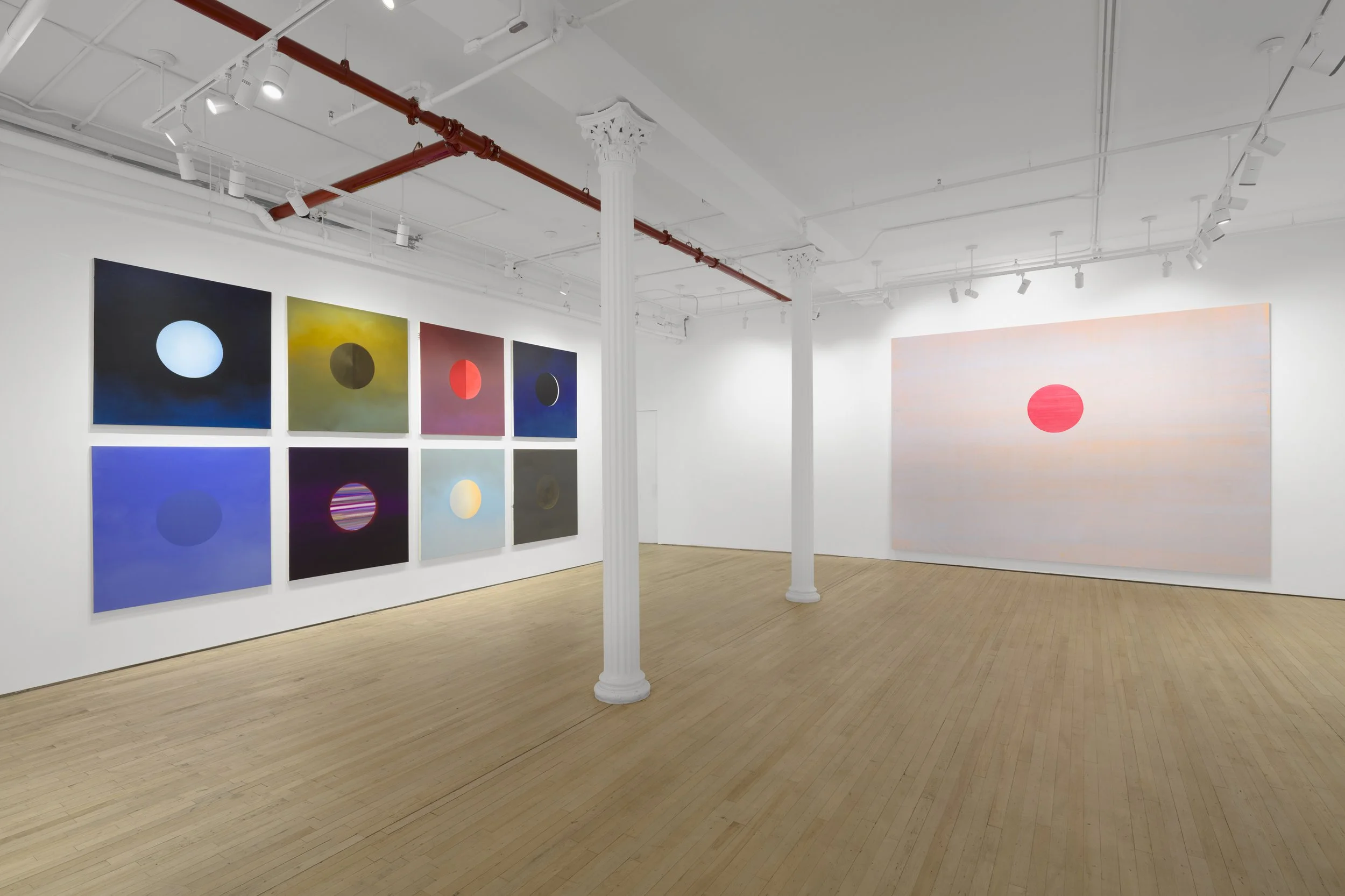
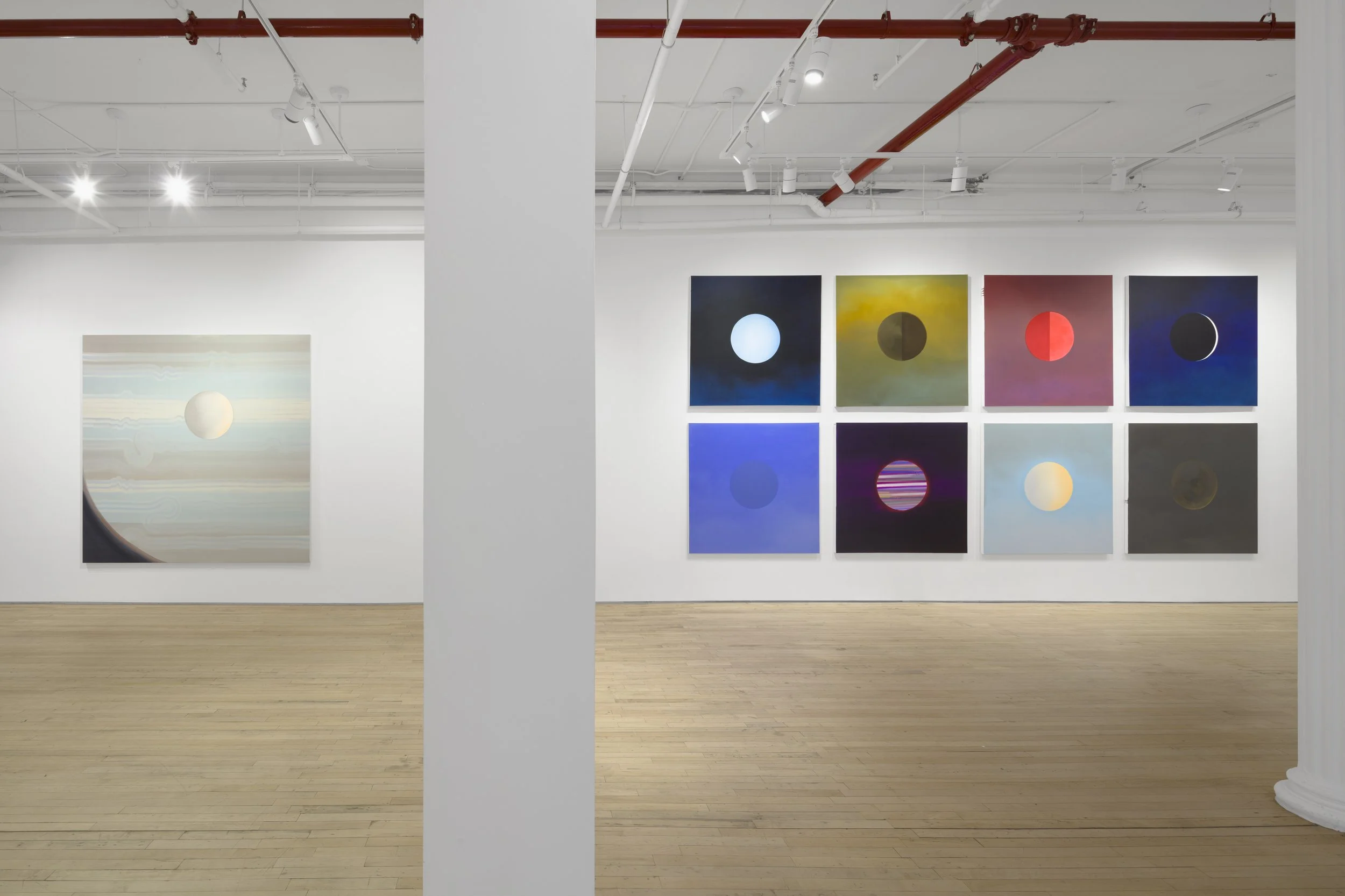
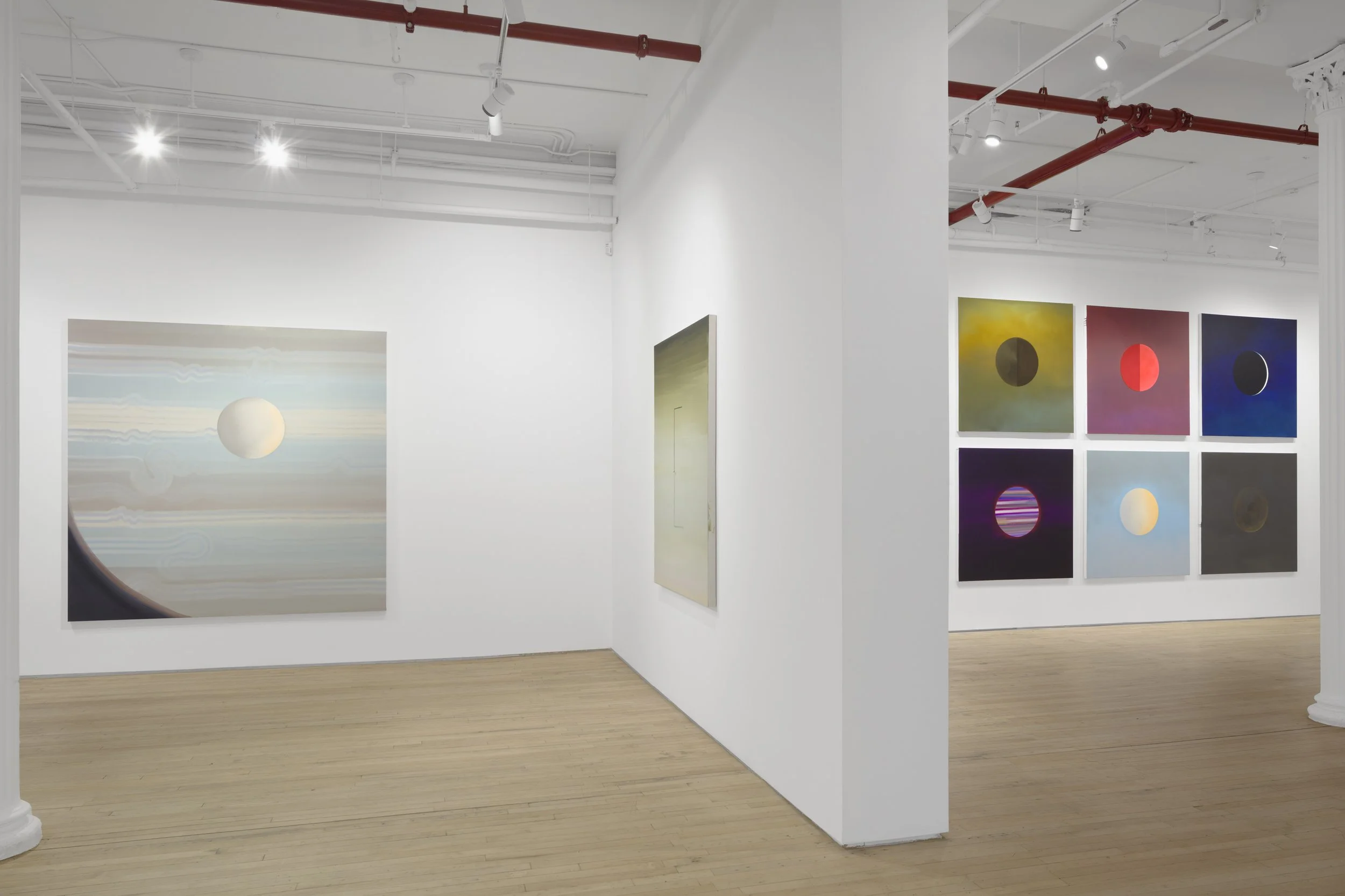
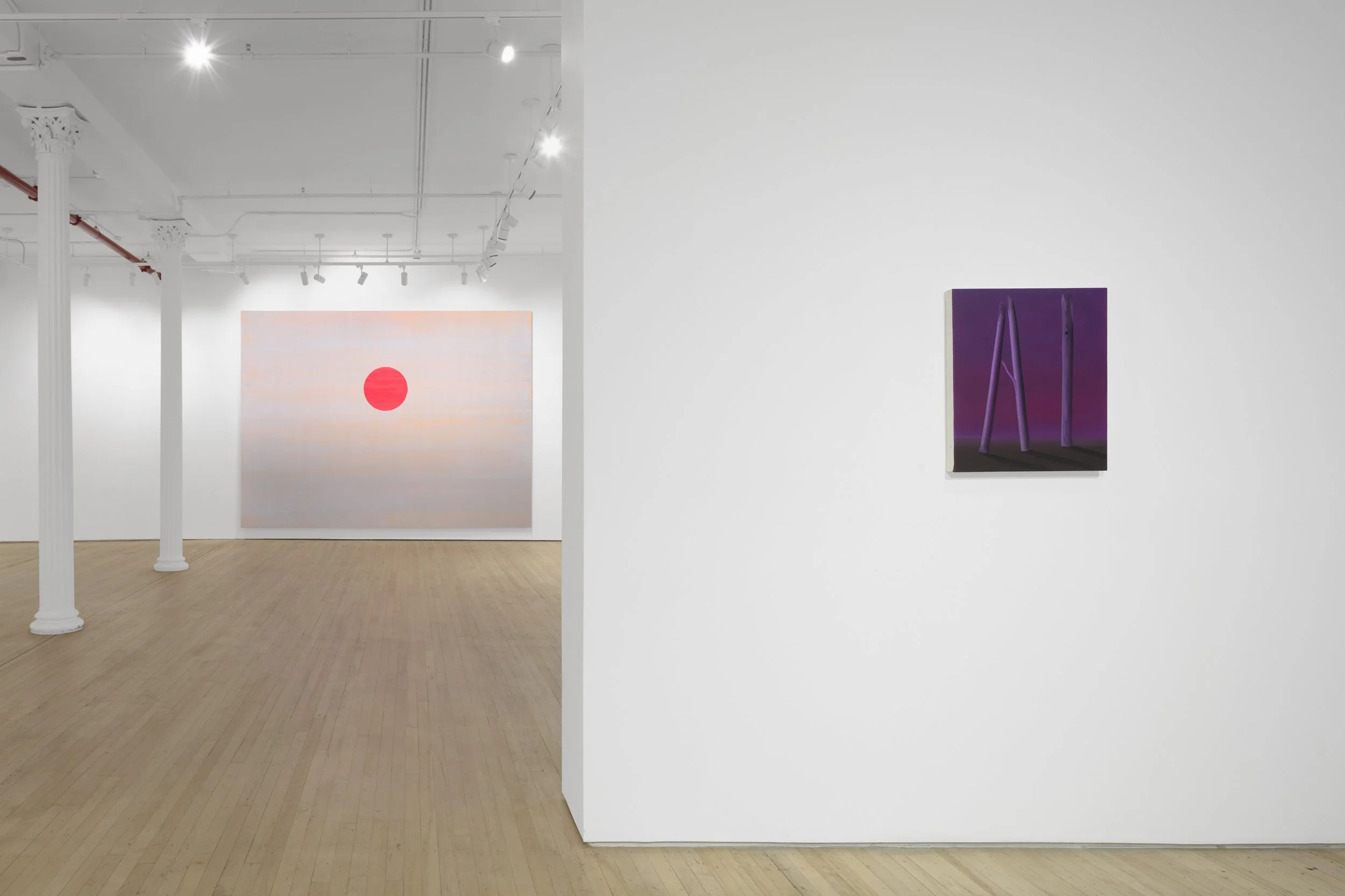
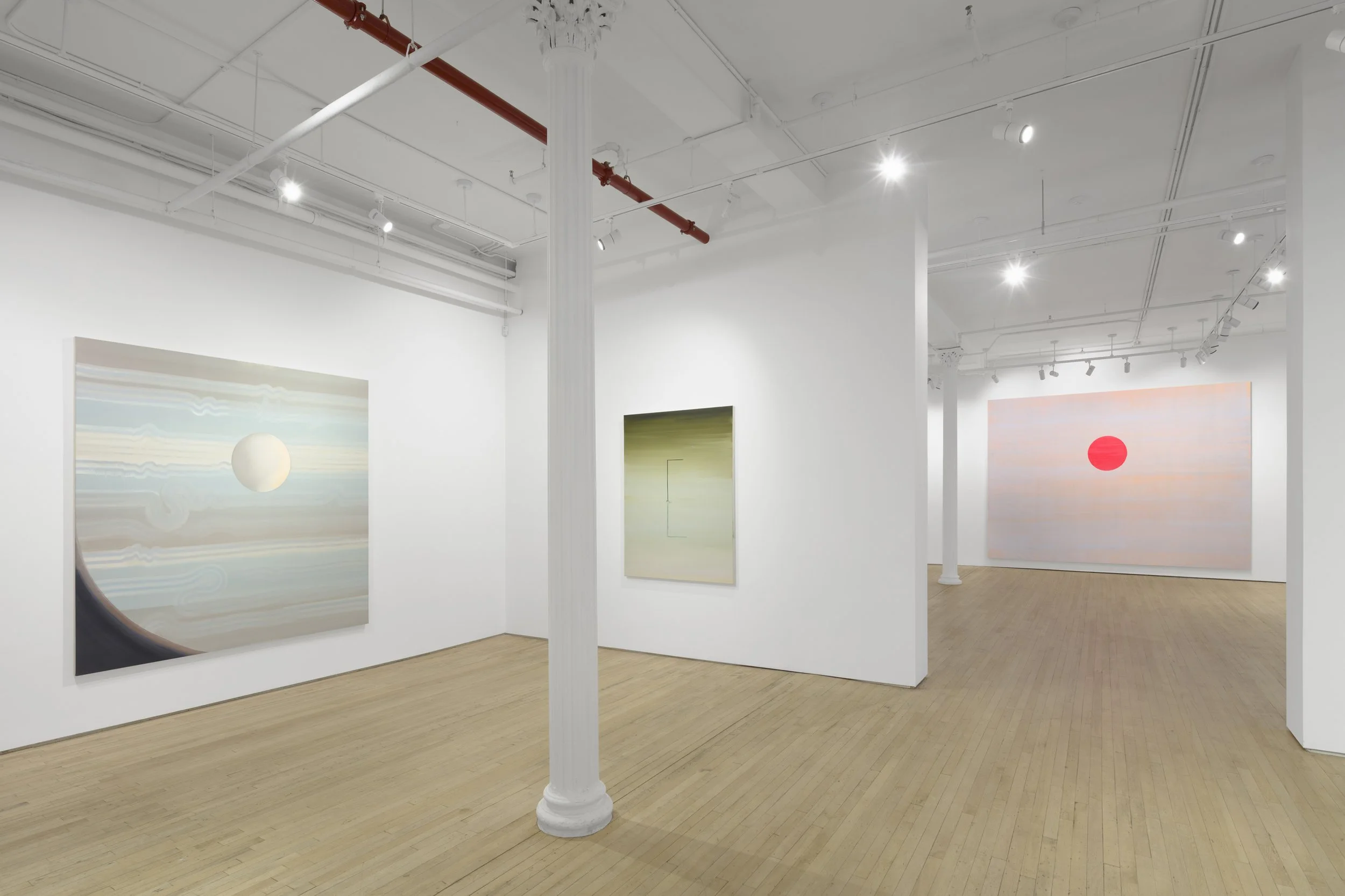
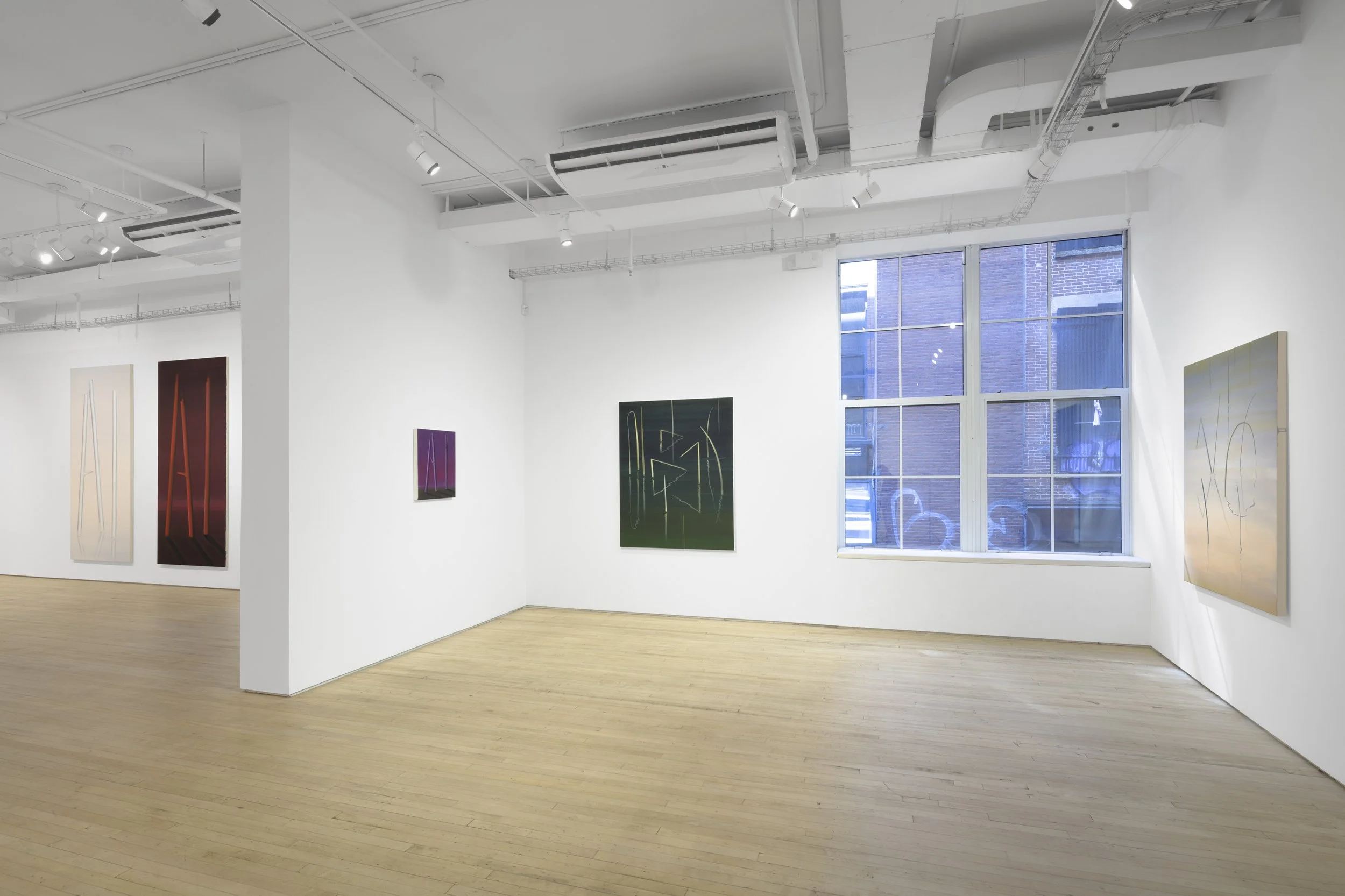


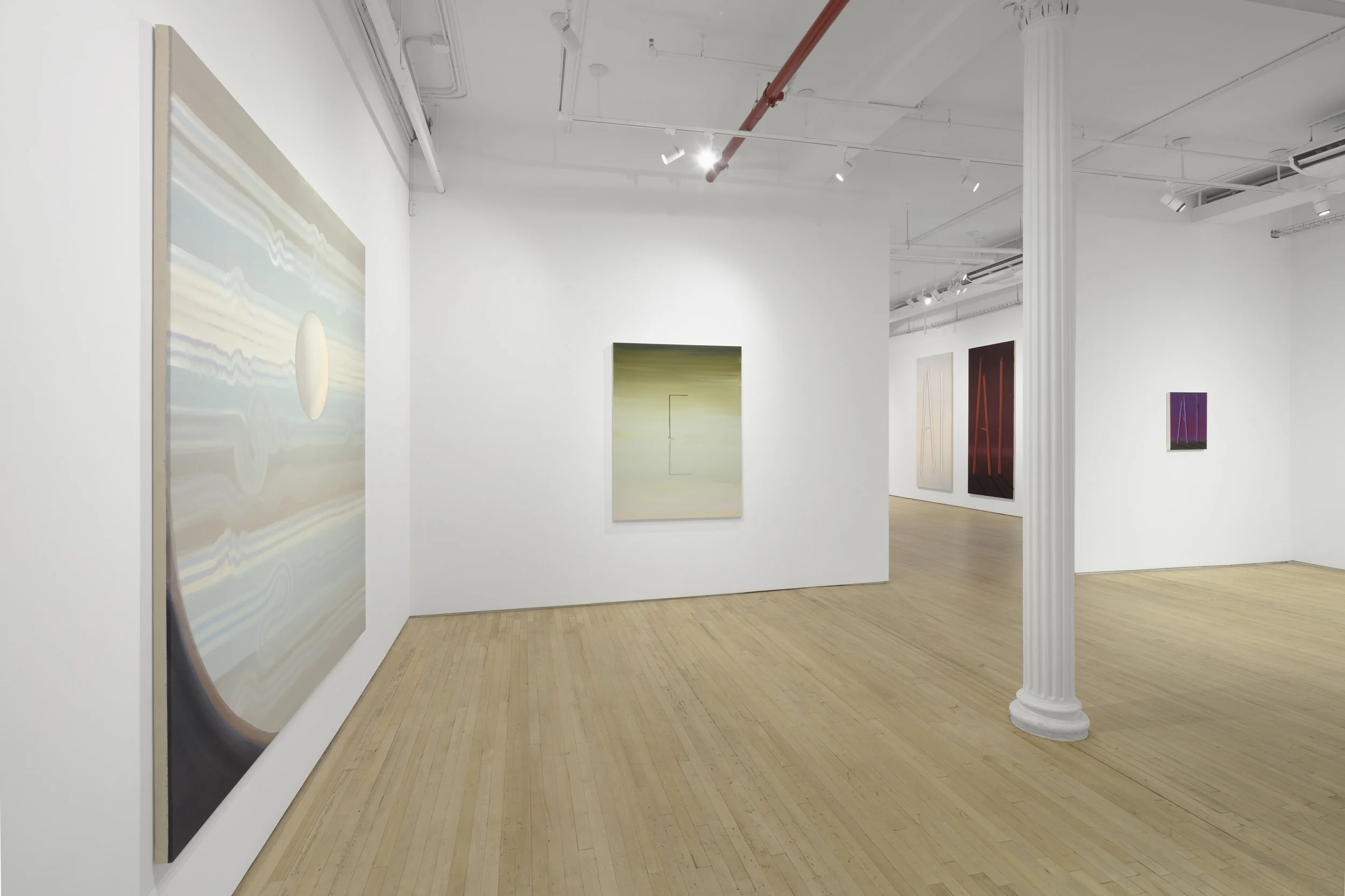
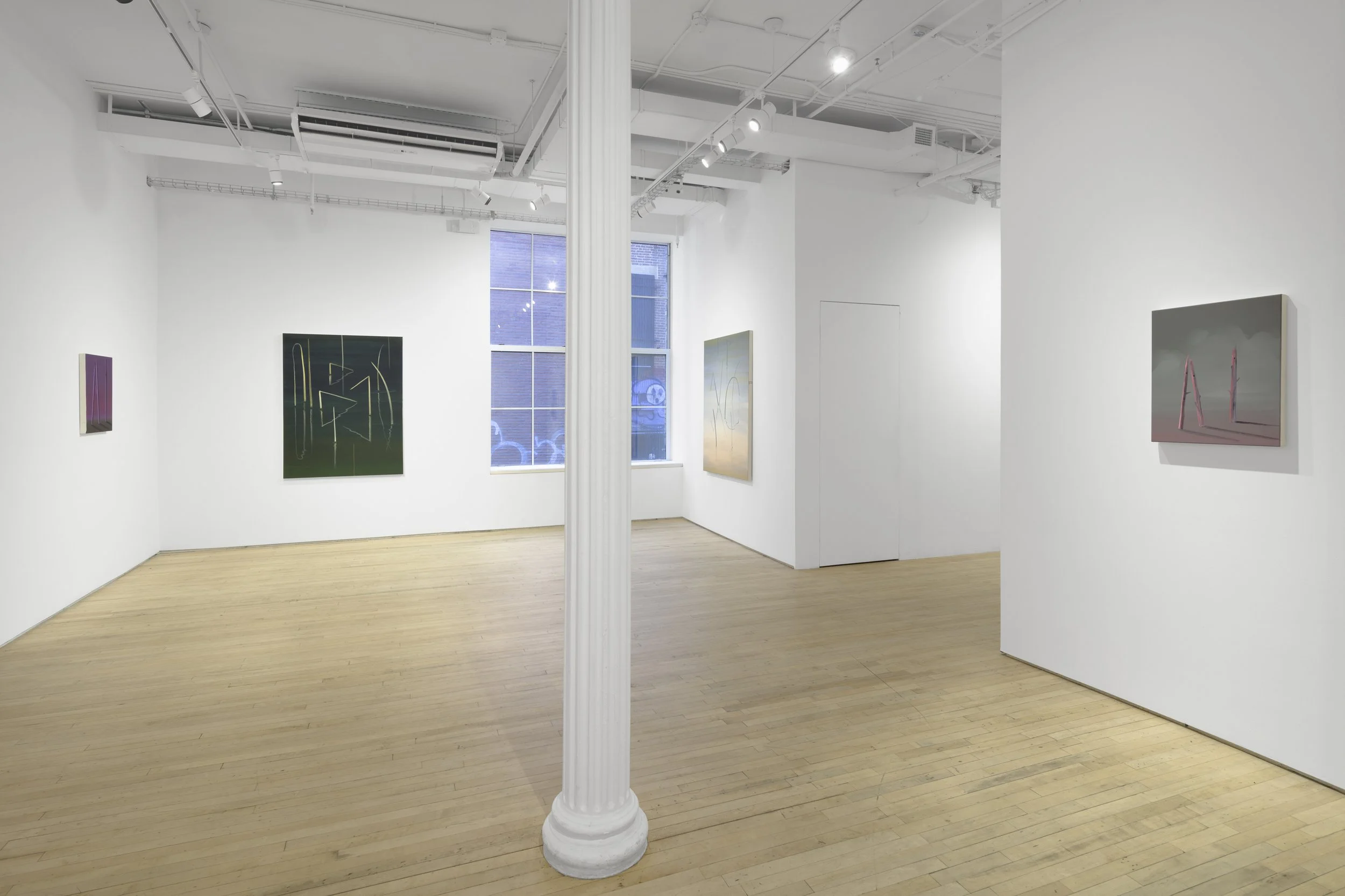
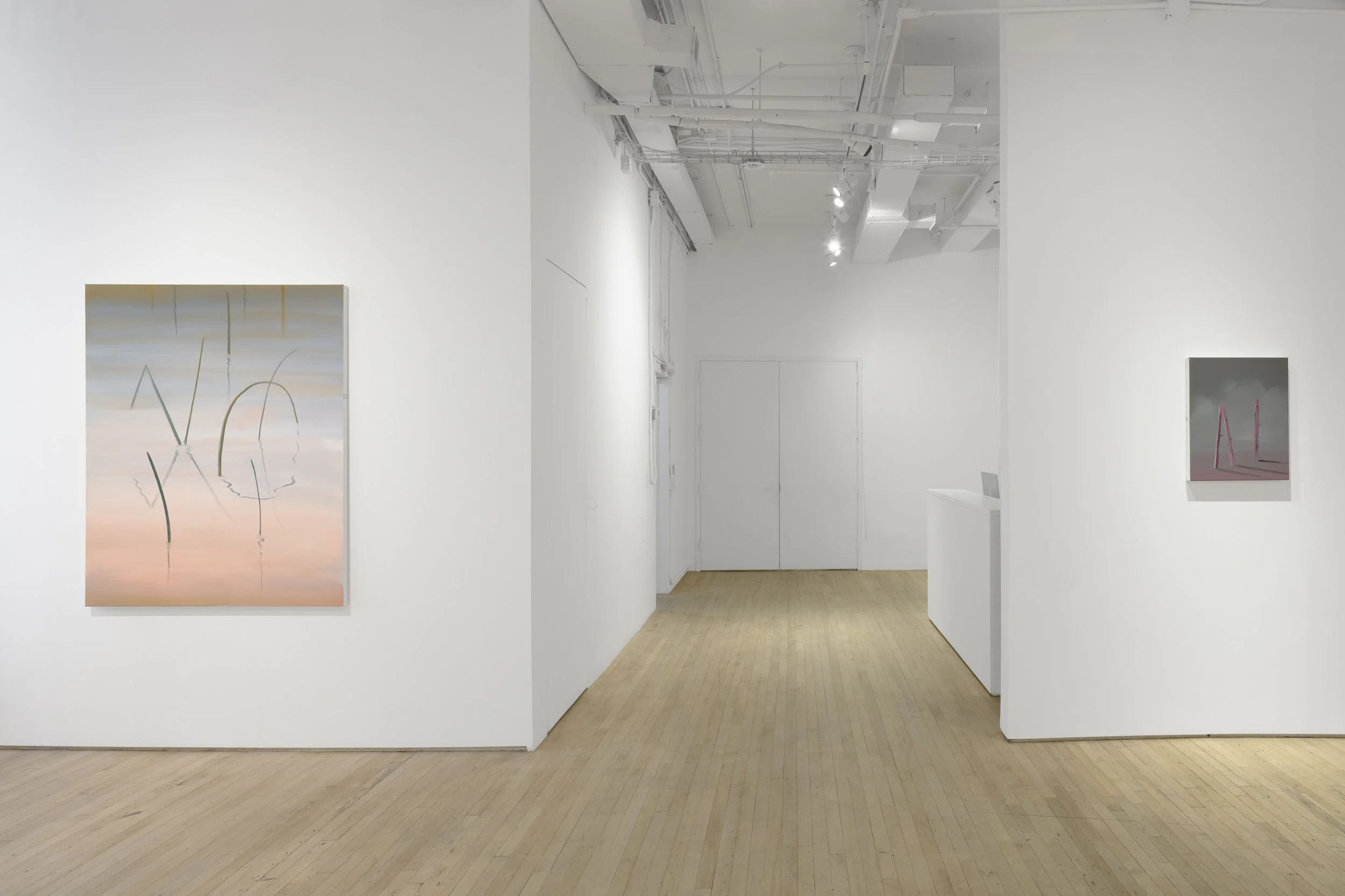
Courtesy of the artist, Night Gallery, Los Angeles and Arsenal Contemporary, New York. Photography by Lance Brewer
The exhibition title reflects the artist’s attitude towards technological progress in the face of environmental collapse. Magnetic Field refers to the north-pointing compass that the artist painted on her cabin floor in Riding Mountain. This act recalls Koop’s earliest paintings, made on plywood that the artist salvaged and traded for artworks before she could afford canvases and stretchers of her own. Painting gains meaning not via its technological utility, but for its very presence and persistence as a primordial object of communication. Koop feels out her direction with her own internal guide, creating luminous fields that exist outside of language— be it early script or large language models. Her canvases reconnect us with the mysteries of the natural universe, which will persist long after we and our gadgets are gone.
This is Wanda’s latest exhibition, which opened on September 5th and will close on November 1st of this year, entitled Magnetic Field, presented by Arsenal Contemporary NY, in collaboration with Night Gallery, Los Angeles. The magazine did an interview with her, which can be found here. For more information about Wanda’s artwork, please visit her website here and also, please follow her on Instagram., More information about the exhibition and others at Arsenal Contemporary and Night Gallery, please visit the Night Gallery’s website here and Arsenal’s here.
Dalton Paula: Infâncias Negras
Dalton Paula Coral, 2025 Oil and silver leaf on canvas Overall: 180 x 480 x 4 cm Overall: 70 7/8 x 189 x 1 5/8 in Each panel: 180 x 160 x 4 cm Each panel: 70 7/8 x 63 x 1 5/8 in Photo Paulo Rezende. © Dalton Paula
Lisson Gallery is pleased to present its debut solo exhibition with acclaimed Brazilian artist Dalton Paula, featuring a powerful new body of work that reclaims and re-centers Black childhoods as vital spaces of joy, memory, resilience, and cultural continuity. Marking a significant expansion of his practice, Paula moves beyond his celebrated portraiture to create vivid, narrative-filled compositions that depict moments of play, ritual, celebration, and communal life—each rendered against his signature blue-green backgrounds, a visual nod to Brazil’s tradition of studio portraiture.
From Left to Right: Dalton Paula Festa, 2025 Oil and silver leaf on canvas Overall: 180 x 320 x 4 cm Overall: 70 7/8 x 126 x 1 5/8 in Photo Paulo Rezende. © Dalton Paula, Dalton Paula Criança Babá Egun, 2025 Oil and silver leaf on canvas Overall: 180 x 320 x 4 cm Overall: 70 7/8 x 126 x 1 5/8 in Photo Paulo Rezende. © Dalton Paula
At the heart of the exhibition is a monumental, four-meter-wide painting portraying a choir of 17 children. Dressed in ceremonial attire that fuses historical and contemporary dress, as well as the sacred and the playful, they sing in unison—a sonic and visual gesture resonant with Brazil’s cultural syncretism. More than a depiction of music, this work becomes a living archive: a testament to collective memory, ancestral knowledge, and the creative agency of Afro-Brazilian youth. Across the exhibition, childhood is reframed not merely as a site of innocence, but as a domain of resistance, inheritance, and imaginative power.
Dalton Paula Vendedor de Pedra, 2025 Oil and silver leaf on canvas 180 x 160 x 4 cm 70 7/8 x 63 x 1 5/8 in Photo Paulo Rezende. © Dalton Paula
Paula’s approach is grounded in rigorous archival research and a method he calls critical fabulation (from the framework set out in Saidiya Hartman’s 2008 book, Venus in Two Acts)—a speculative, creative process that fills in the silences of undocumented histories. His paintings often incorporate symbolic motifs, often modelled or modified from art historical precedents, which layer the work with spiritual and contextual depth. Elements such as the wooden chair, symbolizing dignity and authority, or the glass of water, evoking spiritual purification and remembrance, serve as quiet tools of storytelling, asserting Afro-Brazilian presence and power within a reimagined visual canon.
While the scenes of birthdays, games, offerings, and everyday intimacy may appear novel within Paula’s visual language, they continue a longstanding thread in his practice. Earlier series, such as Rota do Tabaco [Tobacco Routes], 2016 (paint on ceramic vessels,) and Rota do Algodão, [Cotton Routes] 2022 (cotton textile-covered objects), also featured portraits of children, toys and dolls, while continuing his sustained commitment to recovering Afro-Brazilian histories through imagememories— narratives that resist colonial erasure and center Black resilience.
This new series also meditates on the transformative power of voice—understood as song, as testimony, and as collective affirmation. Drawing from the history of choral traditions in Brazilian schools and churches, Paula frames voice as both a spiritual and political force. When children are denied full recognition and protection, these works offer a counterimage: one where Black children are not ornamental or invisible, but central—makers of culture, carriers of tradition, and embodiments of the future.
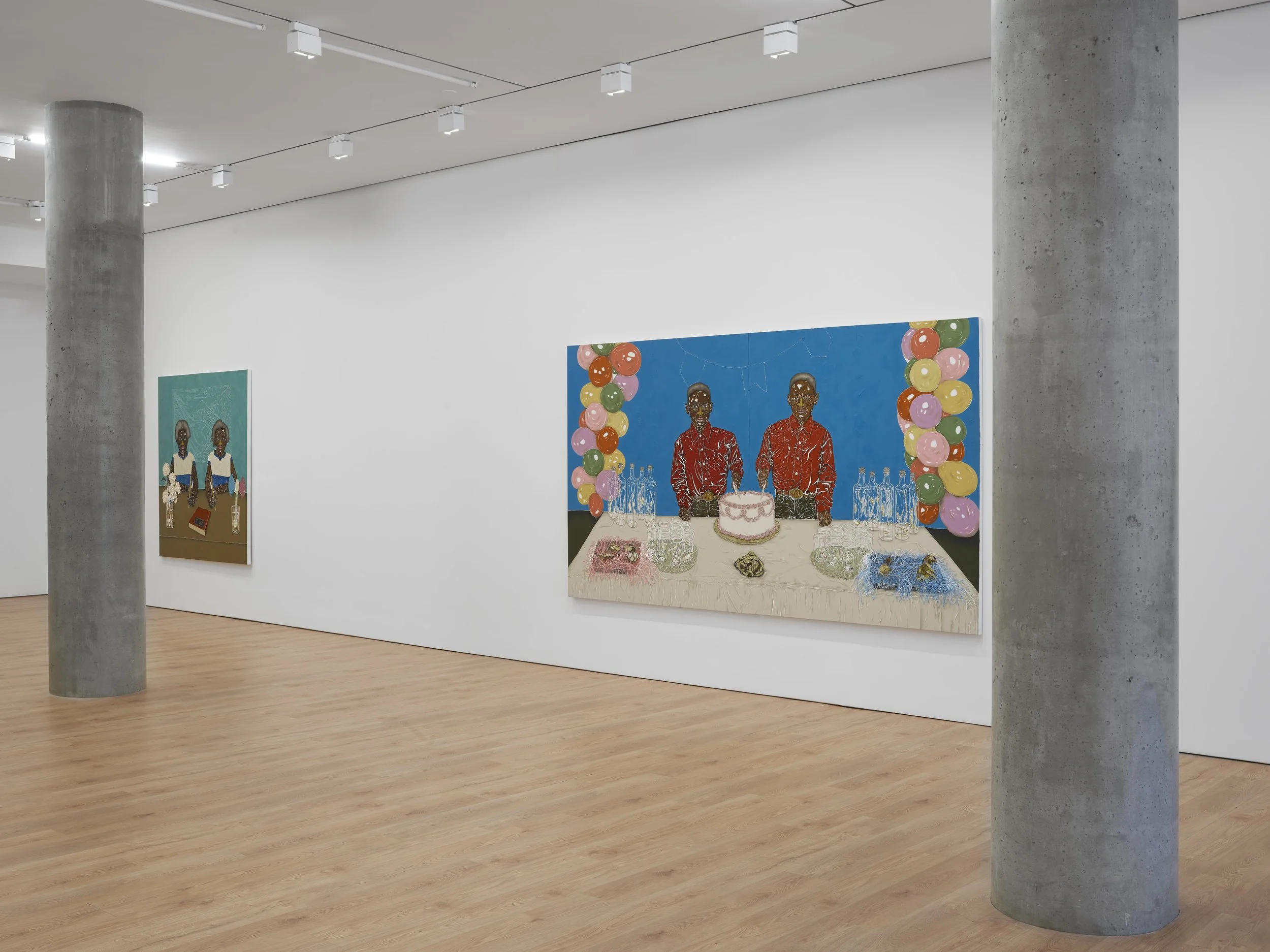

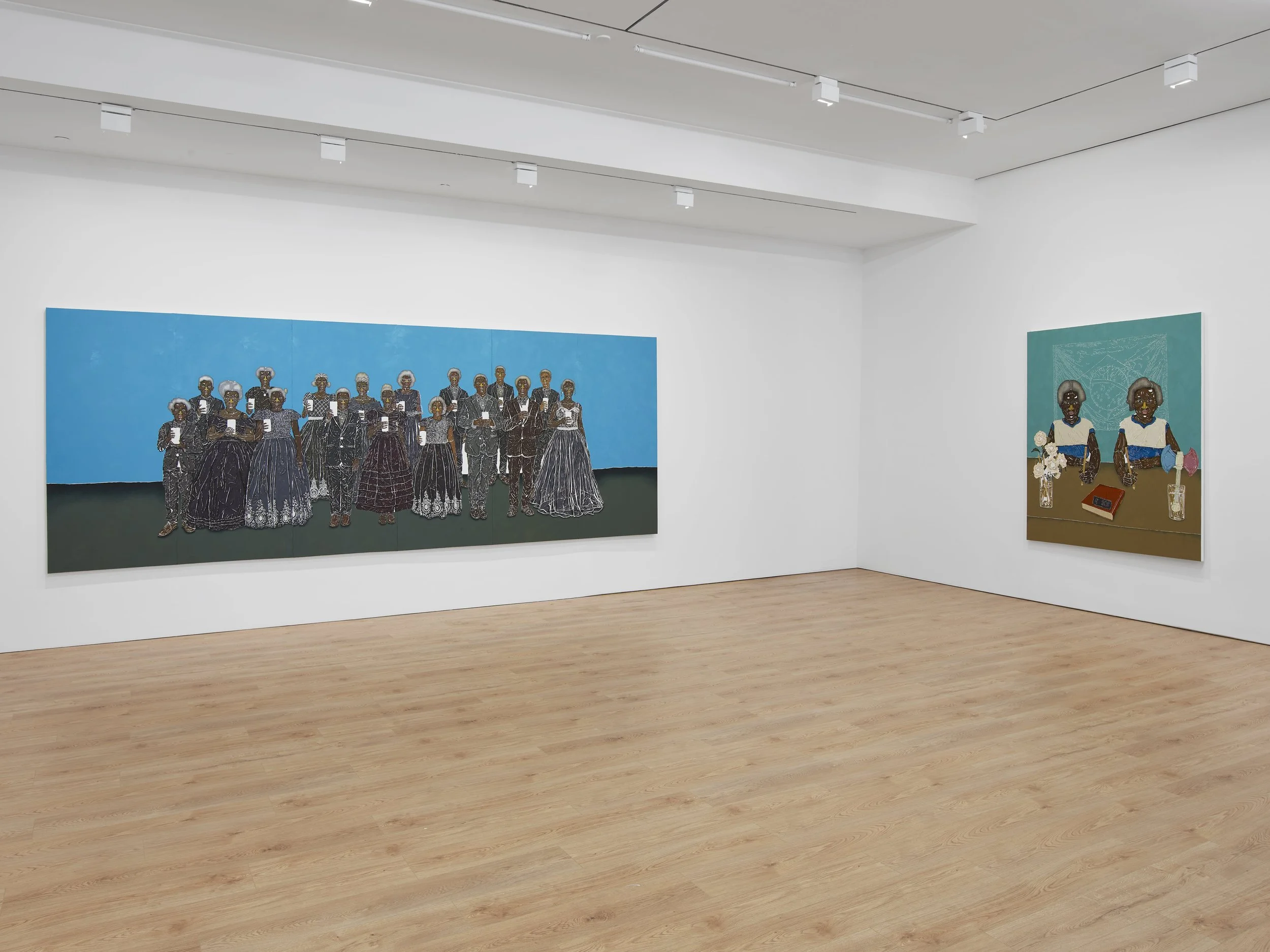
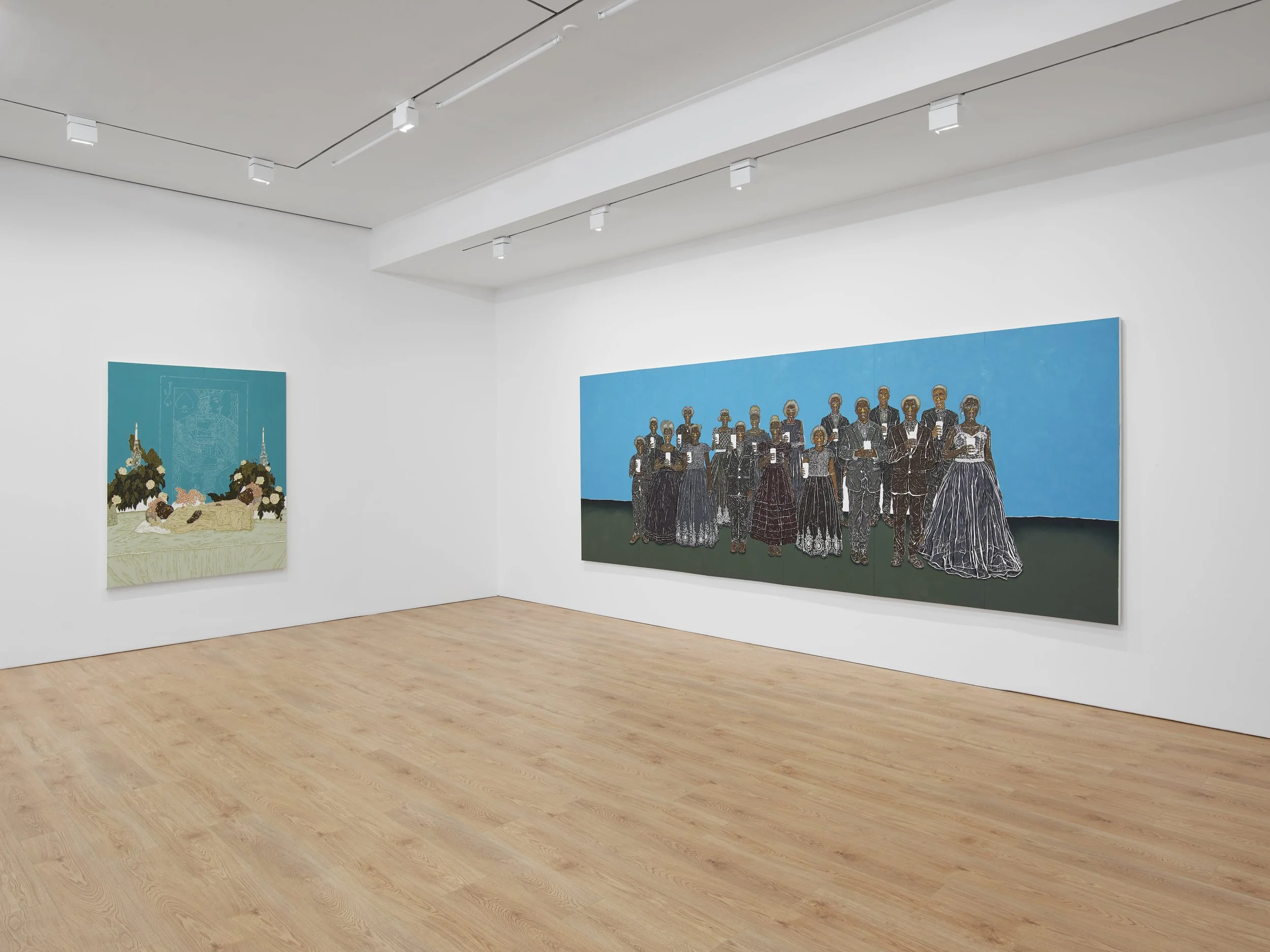
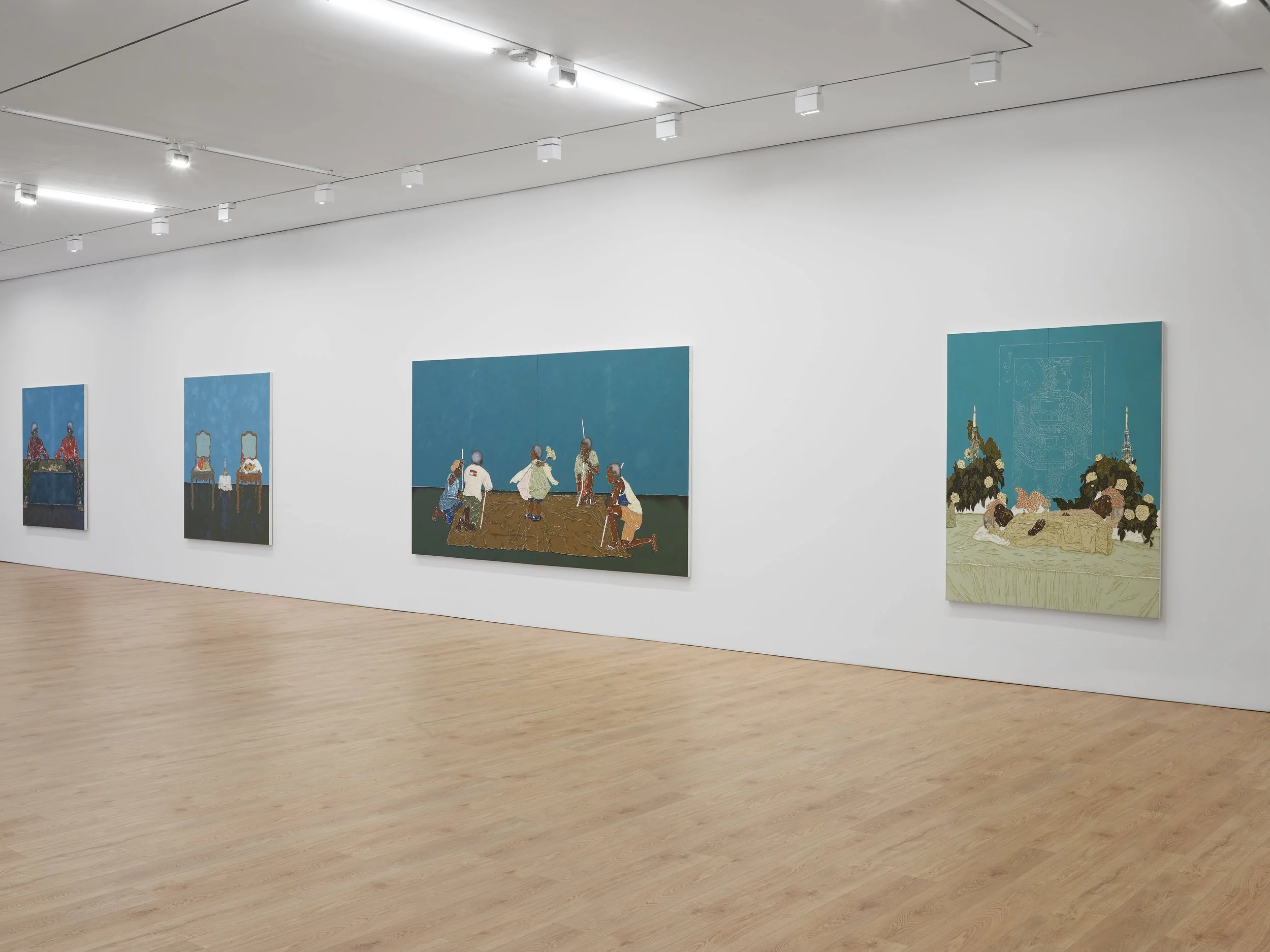
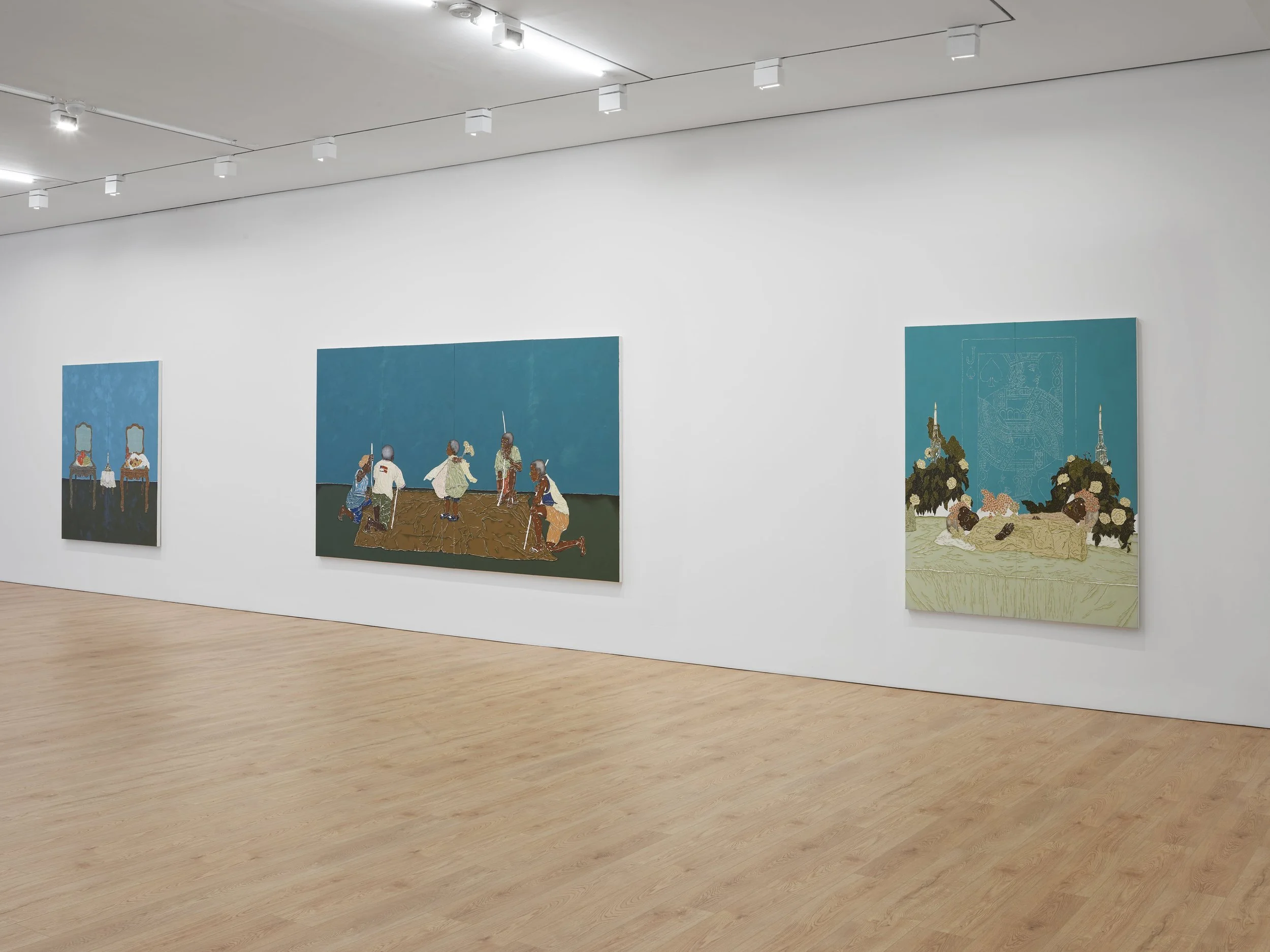

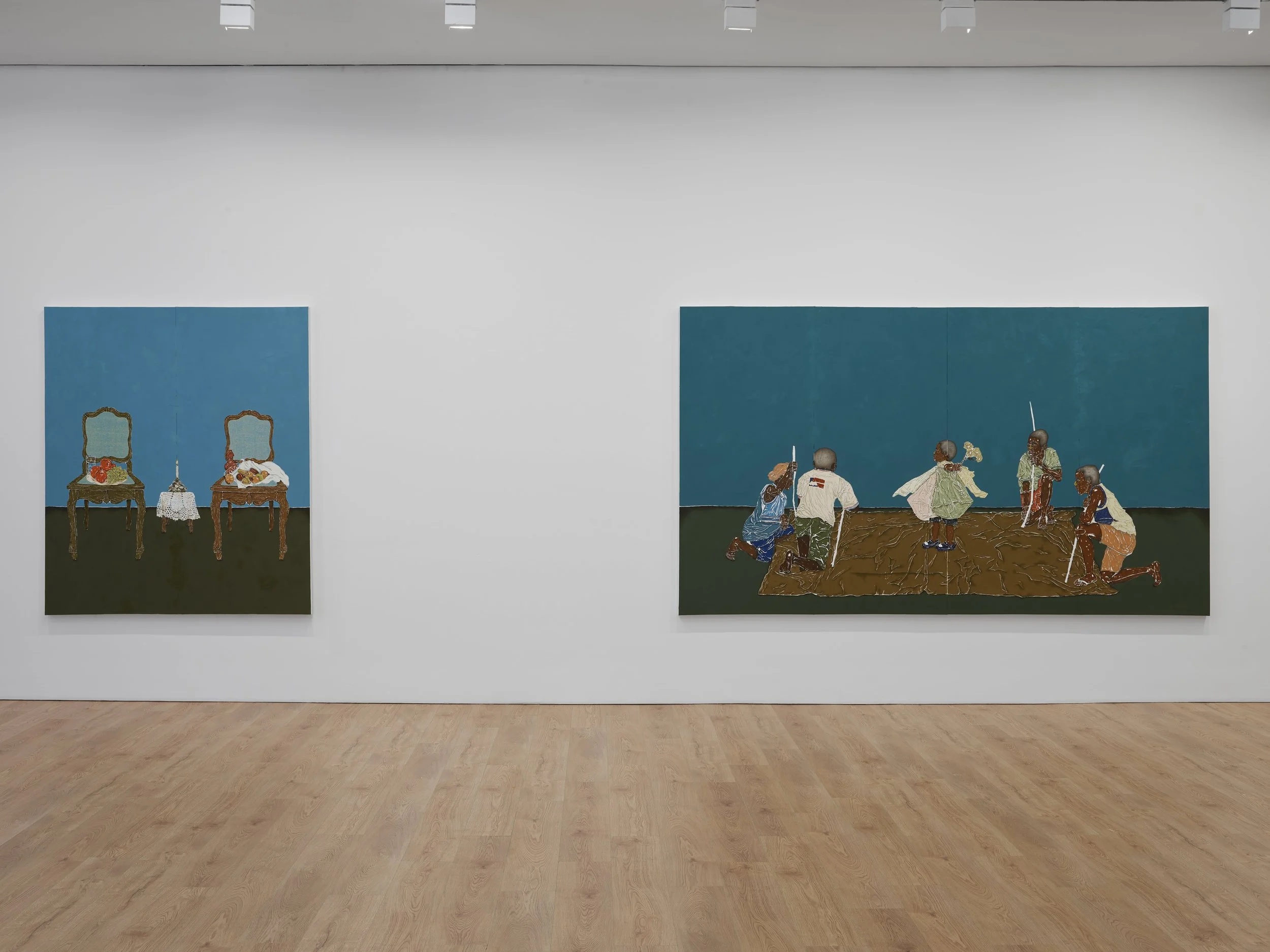

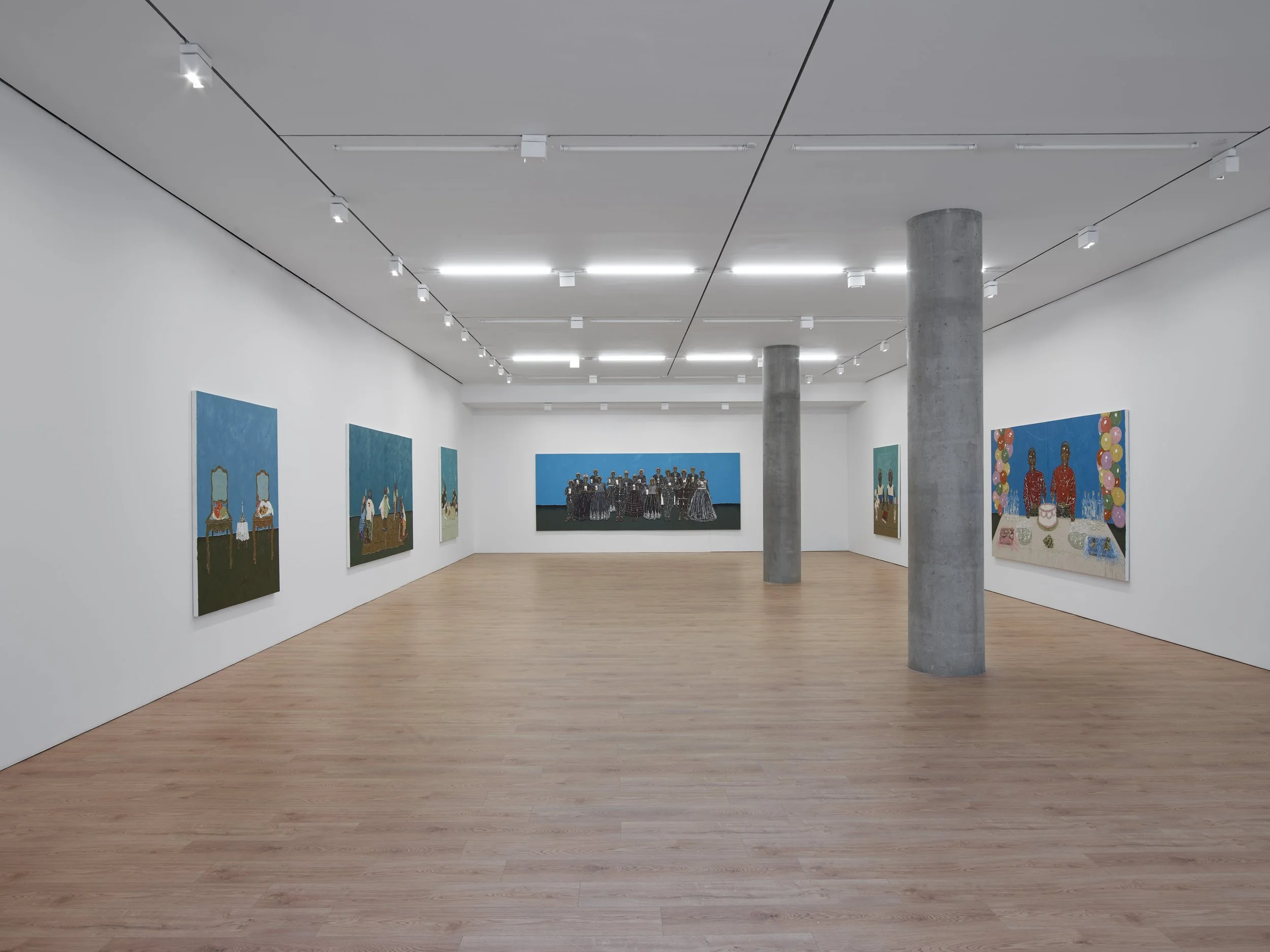
Exhibition views of ‘Dalton Paula’ at Lisson, Gallery New York, 11 September – 18 October 2025 © Dalton Paula, Courtesy Lisson Gallery
Running concurrently with the Lisson Gallery exhibition, Paula’s art school and residency, Sertão Negro, will present a special project at the Storefront for Art and Architecture in New York, opening September 13. Founded in Goiás, Brazil, Sertão Negro extends beyond the arts, integrating its educational and studio provision with a self-sustaining farm and garden. This multidisciplinary, emancipatory project is modeled after the tradition of quilombos—communities formed by escaped enslaved peoples—and is rooted in Afro-Brazilian knowledge systems, ecological stewardship, and intergenerational learning. Sertão Negro will also participate in the 36th Bienal de São Paulo this fall in the form of an architectural and participatory installation
Dalton Paula Formatura Escolar, 2025 Oil and silver leaf on canvas 180 x 160 x 4 cm 70 7/8 x 63 x 1 5/8 in Photo Paulo Rezende. © Dalton Paula
About the artist
Dalton Paula is an artist, researcher and educator known for his powerful engagement with Afro-Brazilian traditions. Paulaforegrounds the lives of undocumented figures whose contributions to society have been overlooked by working to impart a lasting cultural legacy through the continuation of communities and bodies of wisdom that have been forgotten or hidden over time. Just as the personages he depicts were excised from official narratives or documentation due to their actions in opposition to slavery or other forms of injustice, Paula uses collage, paint, film and photography, as well as the symbols and traditions of studio portraiture, in order to stitch the memory of their existence back into the fabric of history. He also works to elevate and commemorate these portrayals through the use of regal attire, highlights of gold leaf and the aura of reverence usually reserved for subjects of high or noble rank.
In addition to his individual and groupings of portrait busts and full-length portraits – created through meticulous archival research and, where necessary, equal parts critical fabulation – Paula has produced vast installations and series in ceramics and textile on the residues and tolls left behind by the human labour used in the tobacco and cotton industries in Brazil and further across the Global South.
Dalton Paula Natureza Morta, 2025 Oil and silver leaf on canvas 180 x 160 x 4 cm 70 7/8 x 63 x 1 5/8 in Photo Paulo Rezende. © Dalton Paula
As further evidence of his uniquely transformative and postcolonial practice, Paula has established his own center for knowledge transference in the central state of Goiás, not far from his birthplace in the capital of Brasilia. Known as Sertão Negro, this art school, residency, studio, garden and kitchen complex hosts classes, workshops and study groups to explore creativity and the possibilities of the surrounding ecosystem, so mirroring the collective activities of former quilombos, sites of refuge originally formed by African slaves in Diaspora.
Dalton Paula Funeral, 2025 Oil and silver leaf on canvas 180 x 160 x 4 cm 70 7/8 x 63 x 1 5/8 in Photo Paulo Rezende. © Dalton Paula
Dalton Paula (born in Brasilia, Brazil, 1982) lives and works in Goiânia, Brazil, where he graduated from the Visual Arts programme at the Federal University of Goiás (UFG). He was awarded the Chanel Next Prize in 2024 and the Marcantonio Vilaça Award in 2019. His recent solo exhibitions include: Museu de Arte de São Paulo (MASP) and Pinacoteca de Sāo Paulo, Brazil (2022-23); Museu de Arte Contemporânea, Centro Cultural Oscar Niemeyer, Goiânia (2014); Museu de Arte Contemporânea, Sala Samuel Costa, Goiânia, Brazil (2010). Major group exhibitions include: ‘Foreigners Everywhere’, Venice Biennale, Italy (2024); ‘Afro-Atlantic Histories’, touring from Museu de Arte de São Paulo and the Instituto Tomie Ohtake in Brazil (2018) to the Museum of Fine Arts, Houston; National Gallery of Art, Washington, DC; Los Angeles County Museum of Art; and the Dallas Museum of Art, USA (2021-24); ‘Compositions for Insurgent Times’, Museu de Arte Moderna do Río de Janeiro, Brazil (2021-22); ‘Critical Fabulations’, Museum of Modern Art (MoMA), New York, USA (2021-23); ‘Songs for Sabotage’, New Museum Triennial, New York, USA (2018); ‘O Triângulo do Atlântico’, 11th Bienal do Mercosul, Porto Alegre, Brazil (2018); ‘The Atlantic Triangle’, Goethe-Institut, Lagos, Nigeria (2018) and ‘Incerteza Viva’, 32nd Bienal de São Paulo, Brazil (2016).
About Lisson Gallery
Lisson Gallery is one of the most influential and longest-running international contemporary art galleries in the world. Today the gallery supports and promotes the work of more than 60 international artists across spaces in London, New York, Los Angeles, Shanghai and Beijing. Established in1967 by Nicholas Logsdail, Lisson Gallery pioneered the early careers of important Minimal and Conceptual artists, such as Art & Language, Carl Andre, Daniel Buren, Donald Judd, John Latham, Sol LeWitt, Richard Long and Robert Ryman among many others. It still works with many of these artists as well as others of that generation from Carmen Herrera to the renowned estate of Leon Polk Smith. In its second decade the gallery introduced significant British sculptors to the public for the first time, including Tony Cragg, Richard Deacon, Anish Kapoor, Shirazeh Houshiary and Julian Opie. Since 2000, the gallery has gone on to represent many more leading international artists such as Marina Abramović, Ai Weiwei, John Akomfrah, Susan Hiller, Tatsuo Miyajima and Sean Scully. It is also responsible for raising the international profile of a younger generation of artists led by Cory Arcangel, Ryan Gander, Van Hanos, Hugh Hayden, Haroon Mirza, Laure Prouvost, Pedro Reyes, Wael Shawky and Cheyney Thompson.
The exhibition opened on 11 September and will run through 18 October 2025 at the 504 West 24th Street location.
For more information about this exhibition and others, please visit the Lisson Gallery here. The gallery can also be found on Facebook, YouTube, and Instagram.
Pedro Reyes
Exhibition views of ‘Pedro Reyes’ at Lisson, Gallery New York, 11 September – 18 October 2025 © Pedro Reyes, Courtesy Lisson Gallery
Lisson Gallery is pleased to present a solo exhibition of new work by acclaimed artist Pedro Reyes, marking a significant evolution in his sculptural practice. Bringing together monumental stone works and, for the first time, a suite of wall-based mosaics, the exhibition transforms the gallery into a sculptural forest—a landscape of myth, material, and movement.
Pedro Reyes Citlallo, 2025 Mosaic 46.4 x 29.2 x 3.8 cm 18 1/4 x 11 1/2 x 1 1/2 in © Pedro Reyes, Courtesy Lisson Gallery
Rooted in Mesoamerican cosmology, Reyes’ formal syntax draws deeply from his own heritage. His forms echo the traditions of Mexica and Olmec carving, reinterpreted through a contemporary lens that also recalls the synthesis of Art Deco and modern abstraction. By weaving together these distinct visual territories, Reyes explores how sculpture can serve as a vessel of memory, a bridge between the ancient and the contemporary, and a medium for cultural resilience and renewal.
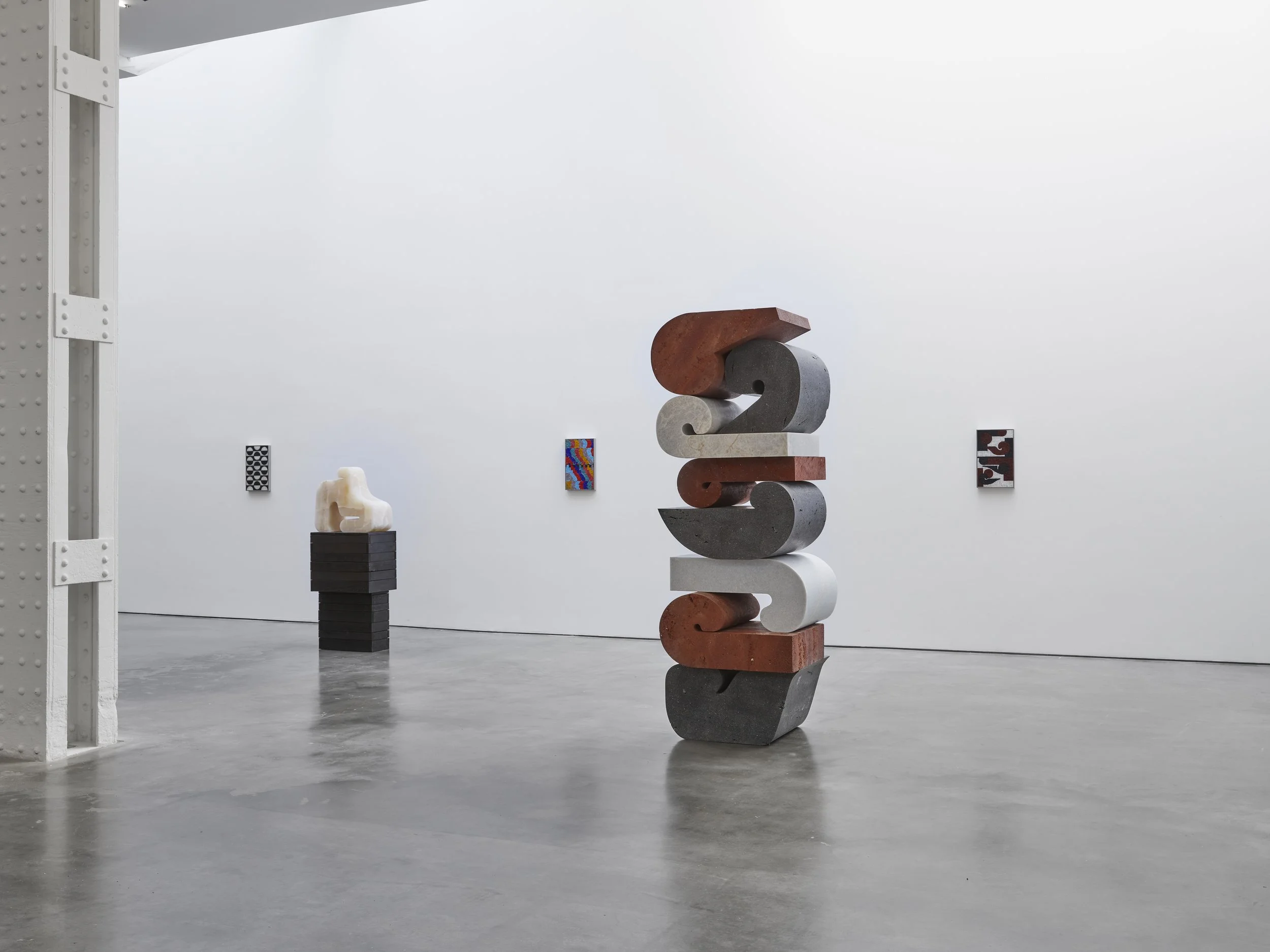

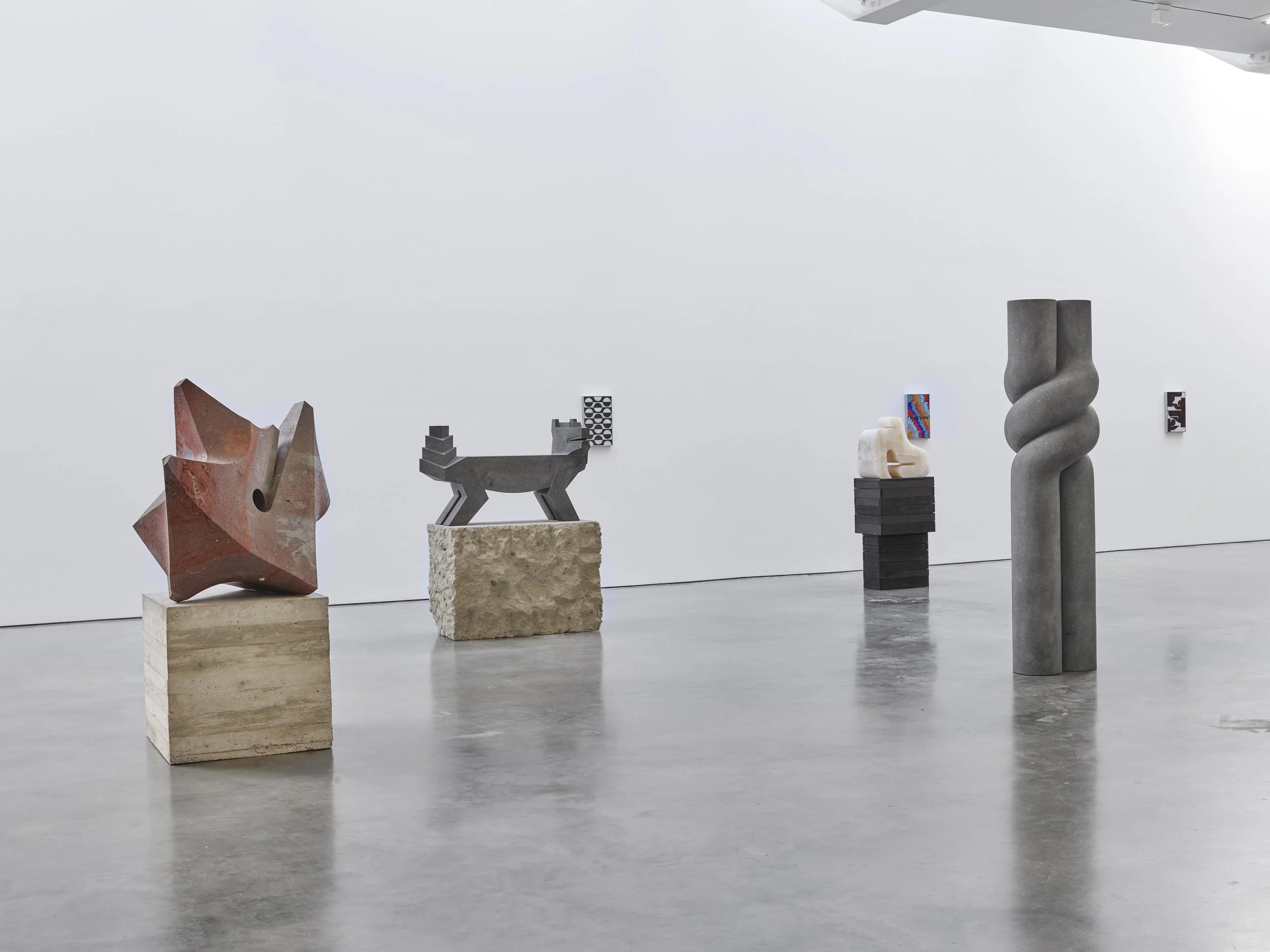
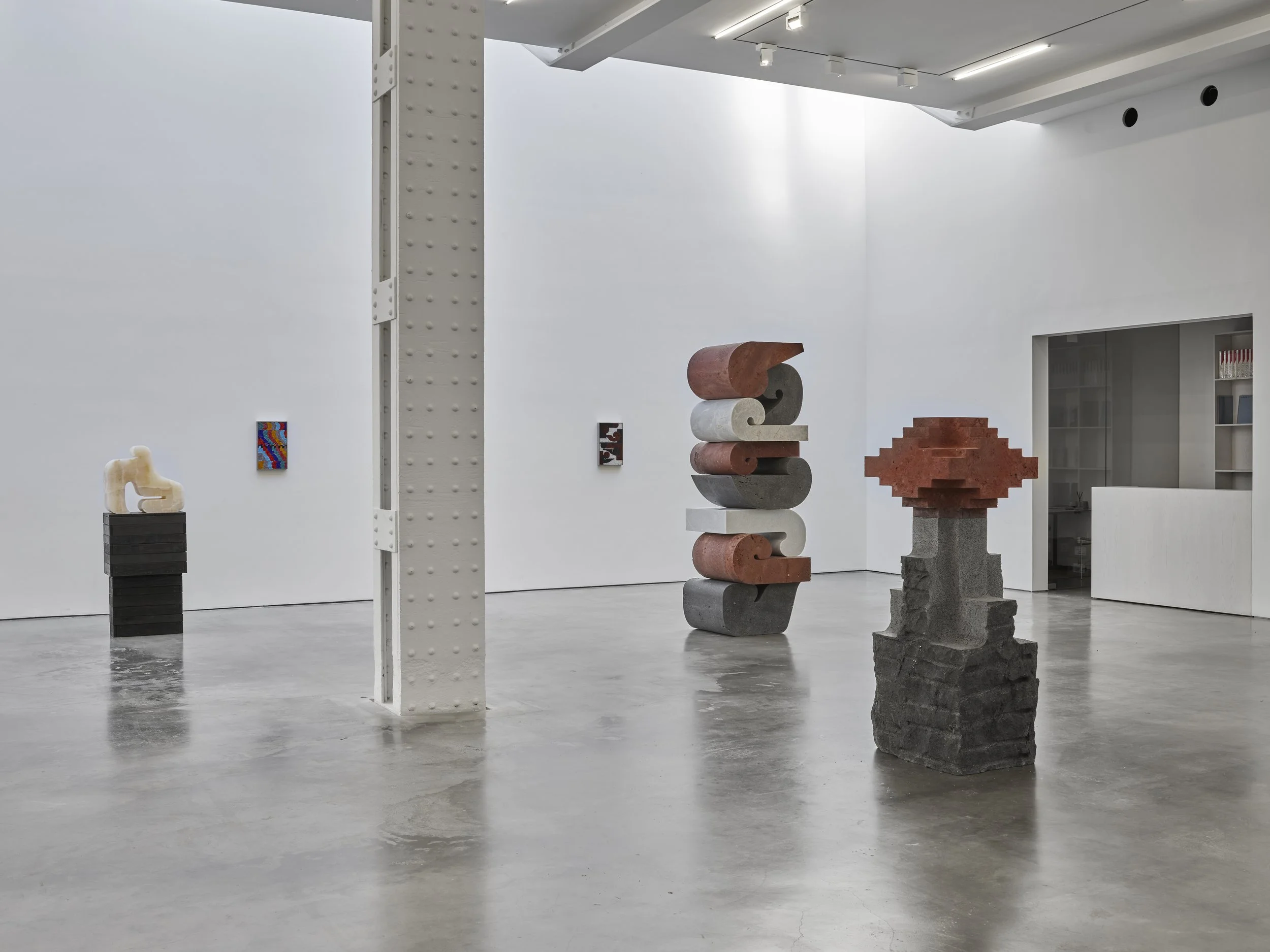
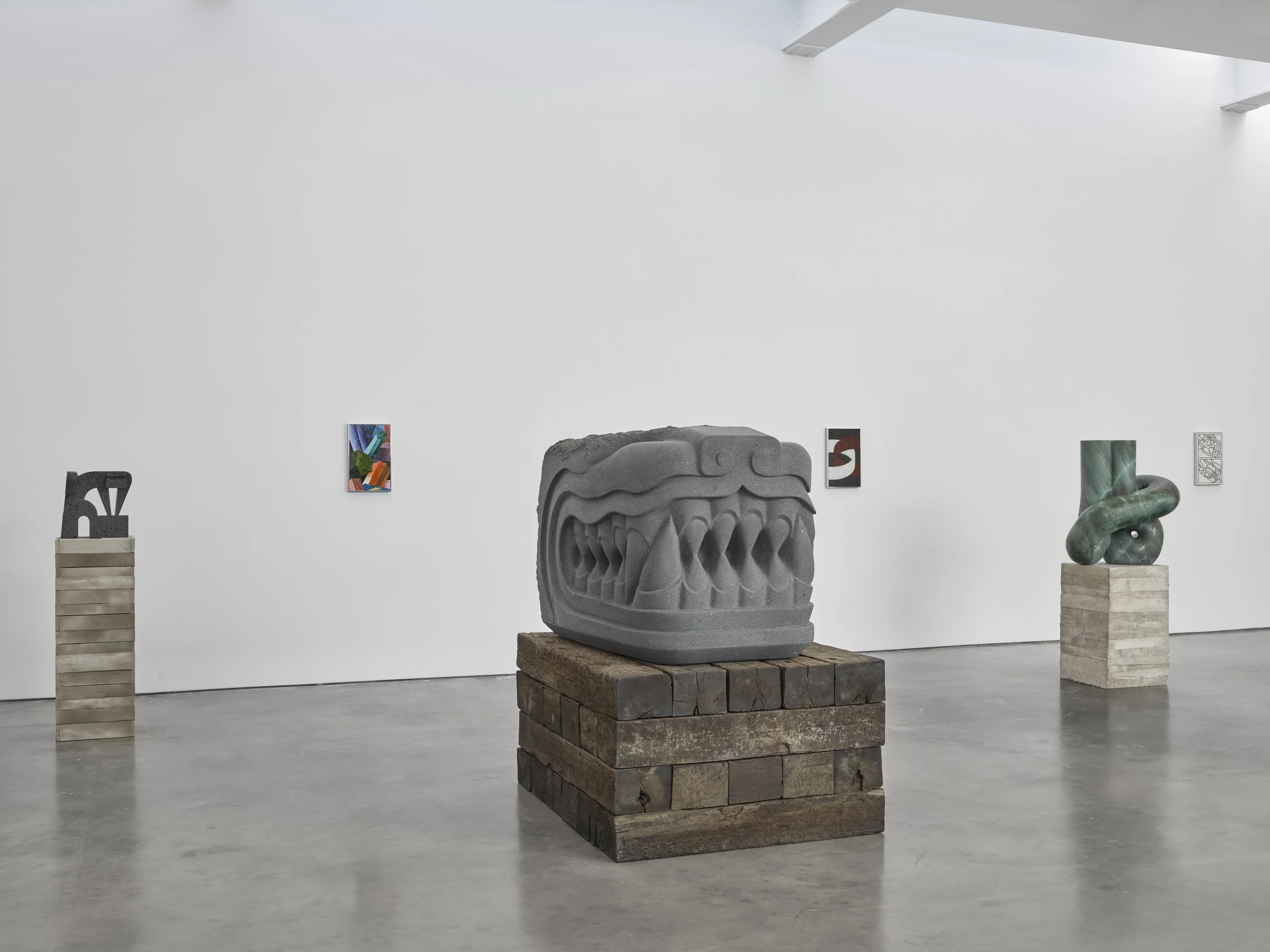
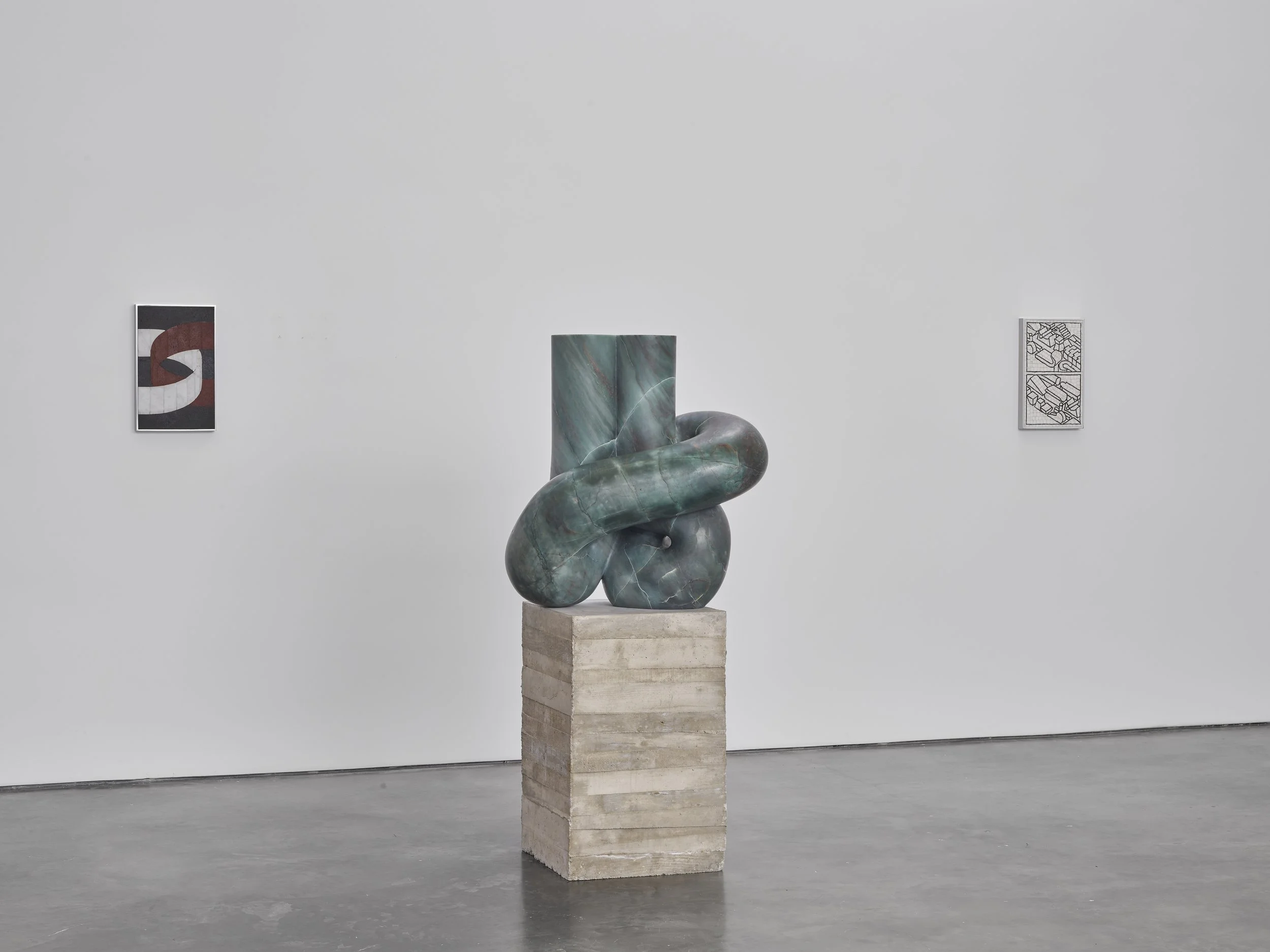
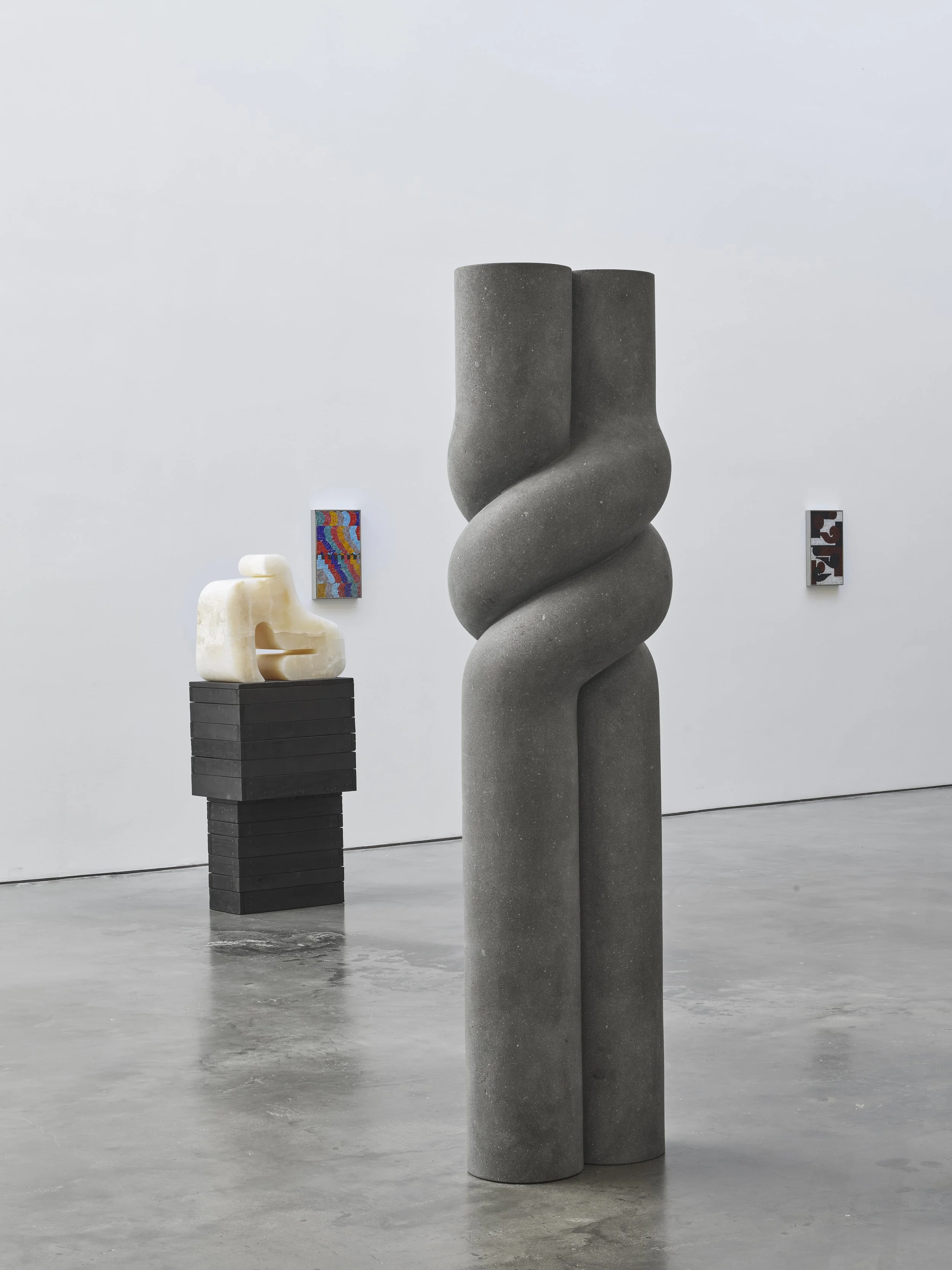

Exhibition views of ‘Pedro Reyes’ at Lisson, Gallery New York, 11 September – 18 October 2025 © Pedro Reyes, Courtesy Lisson Gallery
Alongside his distinctively abstract, totemic sculptural forms, a new series of evocative animal figures—jaguar, coyote, monkey, and axolotl—emerge, each rendered with a restrained precision that bridges ancient symbolism and a contemporary visual language. This synthesis is particularly evident in Coyotl (2025), where the sharp, geometric lines along the figure’s neck and tail reflect both formal clarity and cultural resonance. The work pays homage to Coyoacán—meaning “the place of the coyotes” in Nahuatl—the Mexico City neighborhood where Reyes has his home and studio. As the artist notes, “Often described as a creature between a dog and a wolf, the coyote plays the role of a trickster spirit in pre-Columbian mythology. It also serves as a symbol of earthly wisdom because of its astute nature.”
Pedro Reyes Tepantitla, 2025 Volcanic stone 250 x 98 x 62.5 cm 98 3/8 x 38 5/8 x 24 5/8 in © Pedro Reyes, Courtesy Lisson Gallery
At the heart of the exhibition is a newly developed body of stone mosaics. Smaller in scale and intricately composed, these works introduce a refined and rhythmic counterpoint to the larger stone sculptures. Composed of tesserae made from volcanic stone, marble, glass, silver, and gold, the mosaics radiate with vibrant color and material richness, underscoring their importance as conceptual anchors within the exhibition. Reyes’ mosaics act as portals—offering moments of reflection and pause within the broader sculptural landscape. This new direction in his practice brings heightened attention to pattern, detail, and material intimacy while maintaining the thematic depth that defines his work.
The exhibition also encourages spatial navigation and sensory engagement. As visitors move through the space, the artworks shift in form and meaning, offering changing perspectives and intimate encounters with surface, scale, and silhouette. Rather than isolated displays, the sculptures inhabit a shared environment, inviting viewers into a tactile, narrative-rich journey.
Pedro Reyes Cozamalotl, 2025 Mosaic 46.4 x 29.2 x 3.8 cm 18 1/4 x 11 1/2 x 1 1/2 in © Pedro Reyes, Courtesy Lisson Gallery
Whether monumental or intimate, animal or abstract, Reyes’ forms resonate with symbolic weight and formal clarity, inviting viewers into a space where the boundaries between past and present, myth and matter, are fluid and alive.
About the artist
Pedro Reyes has won international attention for large-scale projects that address current social and political issues. Through a varied practice utilising sculpture, performance, video, and activism, Reyes explores the power of individual and collective organisation to incite change through communication, creativity, happiness, and humour. A socio-political critique of contemporary gun culture is addressed in Reyes’ ongoing Palas por Pistolas, in which the artist worked with local authorities in Culiacán, Mexico, to melt down guns into shovels, then used to plant trees in cities elsewhere in the world. Similarly, in Reyes’ major continuing Disarm series, firearms confiscated by the Mexican government and donated to Reyes have been transformed into instruments, which are then activated by local musicians. Issues of community and compassion are addressed in Sanatorium, activated at the Solomon R. Guggenheim Museum in New York (2011), dOCUMENTA 13, Kassel, Germany (2012), The Whitechapel Art Gallery, London (2013) and at The Power Plant in Toronto and The Institute of Contemporary Art in Miami (2014).
Reyes (b. 1972, Mexico City) lives and works in Mexico City. He studied architecture at the Ibero-American University in Mexico City. Solo exhibitions have been held with Museo Anahuacalli, Mexico City, Mexico (2024); SITE Santa Fe, NM, USA (2023); MARTa Herford, Herford, Germany (2022); MARCO, Monterrey, Mexico (2022); MAAT, Lisbon, Portugal (2021); Museum Tinguely, Basel, Switzerland (2020); SCAD, Georgia, USA (2019); Creative Time, New York, USA (2016); Dallas Contemporary, TX, USA (2016); La Tallera, Cuernavaca, Mexico (2016); Hammer Museum, Los Angeles, CA, USA (2015); ICA, Miami, FL, USA (2014); The Power Plant, Toronto, Canada (2014); Walker Art Center, Minneapolis, MN, USA (2011); Guggenheim Museum, New York, NY, USA (2011); CCA Kitakyushu, Japan (2009); Bass Museum, Miami, FL, USA (2008;) and San Francisco Art Institute, CA, USA (2008). Reyes has participated in group exhibitions at the The Museum of Modern Art, Mexico City, Mexico (2023); Museo Jumex, Mexico City, Mexico (2021); the Brooklyn Museum of Art, New York, NY, USA (2018); the 21st Century Museum of Contemporary Art, Kanazawa, Japan (2015); The National Museum of XXI Century Arts (MAXXI), Rome (2015); Beijing Biennale, China (2014); Whitechapel Gallery, London, UK (2013); dOCUMENTA (13), Kassel, Germany (2012); Liverpool Biennial, UK (2012); Gwangju Biennial, South Korea (2012); Lyon Biennale, France (2009); and the 50th Venice Biennale, Italy (2003). In Fall 2016, Reyes served as the inaugural Dasha Zhukova Distinguished Visiting Artist at MIT Center for Art, Science & Technology (CAST) at Massachusetts Institute of Technology in Cambridge, Massachusetts.
About Lisson Gallery
Lisson Gallery is one of the most influential and longest-running international contemporary art galleries in the world. Today the gallery supports and promotes the work of more than 60 international artists across spaces in London, New York, Los Angeles, Shanghai and Beijing. Established in1967 by Nicholas Logsdail, Lisson Gallery pioneered the early careers of important Minimal and Conceptual artists, such as Art & Language, Carl Andre, Daniel Buren, Donald Judd, John Latham, Sol LeWitt, Richard Long and Robert Ryman among many others. It still works with many of these artists as well as others of that generation from Carmen Herrera to the renowned estate of Leon Polk Smith. In its second decade the gallery introduced significant British sculptors to the public for the first time, including Tony Cragg, Richard Deacon, Anish Kapoor, Shirazeh Houshiary and Julian Opie. Since 2000, the gallery has gone on to represent many more leading international artists such as Marina Abramović, Ai Weiwei, John Akomfrah, Susan Hiller, Tatsuo Miyajima and Sean Scully. It is also responsible for raising the international profile of a younger generation of artists led by Cory Arcangel, Ryan Gander, Van Hanos, Hugh Hayden, Haroon Mirza, Laure Prouvost, Pedro Reyes, Wael Shawky and Cheyney Thompson.
The exhibition opened on 11 September and will run through 18 October 2025 at the 504 West 24th Street location.
For more information about this exhibition and others, please visit the Lisson Gallery here. The gallery can also be found on Facebook, YouTube, and Instagram.
In No Particular Order
In No Particular Order 125 Newbury 395 Broadway, New York, NY 10013 August 5 – 14, 2025 Photography courtesy Pace Gallery
New York – Pace showcased the exhibtion In No Particular Order, an exhibition of over 50 works created by its international staff members from August 5 to 14 at 125 Newbury, a project space in New York helmed by Pace Founder and Chairman Arne Glimcher. Featuring paintings, sculptures, photographs, drawings, prints, and films that reflect the creativity and imagination of Pace’s teams across New York, Los Angeles, London, and Seoul, this edition of the staff show coincides with the gallery’s 65th anniversary, during which it is celebrating its enduring commitment to supporting artists.
This globally minded exhibition—organized by the gallery’s Culture & Equity team—will bring together the artistic practices of over 50 individuals living and working in the US, Europe, and Asia. Together, these artworks can be understood as a portrait of the gallery’s international community.
This presentation continues a tradition of Pace staff exhibitions that goes back some 25 years in the gallery’s history. Through its staff shows, Pace spotlights the artistic talents and diverse perspectives of its team members around the globe.









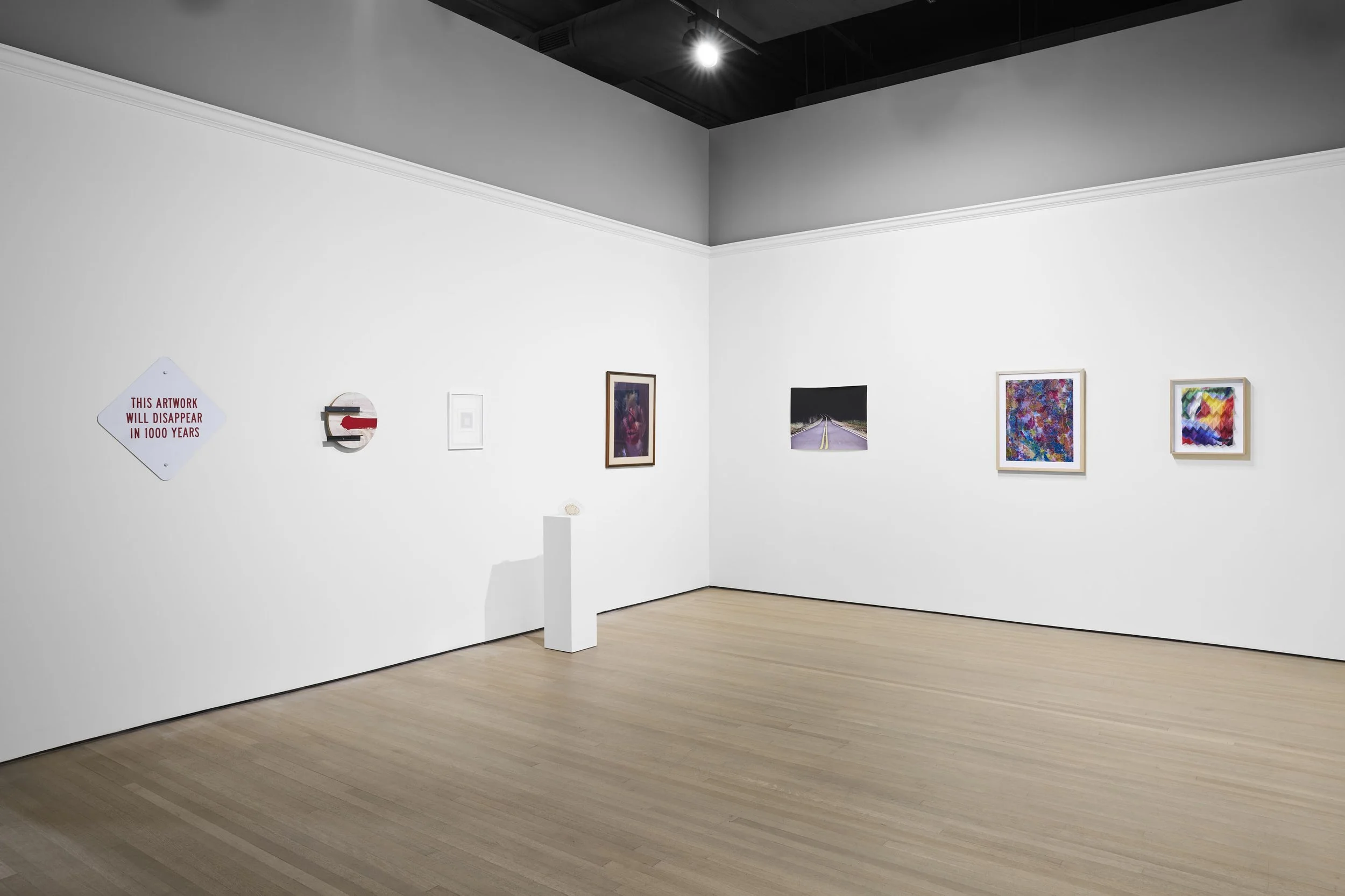












In No Particular Order 125 Newbury 395 Broadway, New York, NY 10013 August 5 – 14, 2025 Photography courtesy Pace Gallery
Learn more about Pace’s Culture & Equity program. Please visit here.
Pace is a leading international art gallery representing some of the most influential artists and estates of the 20th and 21st centuries, founded by Arne Glimcher in 1960. Holding decades-long relationships with Alexander Calder, Jean Dubuffet, Agnes Martin, Louise Nevelson, and Mark Rothko, Pace has a unique history that can be traced to its early support of artists central to the Abstract Expressionist and Light and Space movements. Now in its seventh decade, the gallery continues to nurture its longstanding relationships with its legacy artists and estates while also making an investment in the careers of contemporary artists, including Torkwase Dyson, Loie Hollowell, Robert Nava, Adam Pendleton, and Marina Perez Simão.
Jay Maldonado, Echo,May 12, 2025 PHOTO photo1 1" ×14" (27.9 cm ×35.6 cm) © Jay Maldonado
Under the current leadership of CEO Marc Glimcher and President Samanthe Rubell, Pace has established itself as a collaborative force in the art world, partnering with other galleries and nonprofit organizations around the world in recent years. The gallery advances its mission to support its artists and share their visionary work with audiences and collectors around the world through a robust global program anchored by its exhibitions of both 20th century and contemporary art and scholarly projects from its imprint Pace Publishing, which produces books introducing new voices to the art historicalFor immediate release canon. This artist-first ethos also extends to public installations, philanthropic events, performances, and other interdisciplinary programming presented by Pace.
Today, Pace has nine locations worldwide, including two galleries in New York—its eight-story headquarters at 540 West 25th Street and an adjacent 8,000-square-foot exhibition space at 510 West 25th Street. The gallery’s history in the New York art world dates to 1963, when it opened its first space in the city on East 57th Street. A champion of Light and Space artists, Pace has also been active in California for some 60 years, opening its West Coast flagship in Los Angeles in 2022. It maintains European footholds in London and Geneva as well as Berlin, where it established an office in 2023 and a gallery space in 2025. Pace was one of the first international galleries to have a major presence in Asia, where it has been active since 2008, the year it first opened in Beijing’s vibrant 798 Art District. It now operates galleries in Hong Kong and Seoul and opened its first gallery in Japan in Tokyo’s Azabudai Hills development in 2024.
RYOJI IKEDA’S IMMERSIVE SOUND AND LIGHT TRILOGY“DATA-VERSE”
Exhibition View: Ryoji Ikeda: data-verse, March 7 to Aug. 10, 2025, courtesy of the Artist and the High Museum of Art, Atlanta, GA Photo Credit: Mike Jensen
ATLANTA, In the spring, the High Museum of Art will present an exhibition of work by Japanese artist Ryoji Ikeda, including the U.S. debut of “data-verse, ” a trilogy of monumental, immersive light and sound installations that represents more than two decades of research by the artist and reflects upon the progressive digitalization of an integrated global society. On view from March 7 to Aug. 10, 2025, “Ryoji Ikeda: data-verse” will also premiere new site-specific work alongside existing works including “data gram,” a series of 18 monitors that take apart, analyze and recombine information Ikeda sourced for his trilogy. Ikeda (born Gifu, Japan, 1966; active Paris and Kyoto) is one of the world’s leading composers and media artists, whose work Artnet describes as “visceral, intellectual and awe-inspiring.. ” His immersive video projections, which will be presented floor-to-ceiling onto the walls of the museum’s largest exhibition space, feature visualizations of data extracted from mathematical theories and the study of quantum physics. His more recent work, including “data-verse” (2019- 2020, commissioned by Audemars Piguet Contemporary), incorporates open-source imagery from institutions such as NASA, CERN and the Human Genome Project. Ikeda produced “data- verse” in three “chapters,” transforming open-sourced data sets through self-written programs to create visual output, which he then synchronized and composed in arrangement with an electronic score. Together, the music, video projections and the museum’s architecture will become a dynamically balanced, self-contained whole. Ikeda’s work immerses the audience in a seemingly endless flow of data and explores the macroscopic depths of the universe and our relationship to it.
Exhibition View: Ryoji Ikeda: data-verse, March 7 to Aug. 10, 2025, courtesy of the Artist and the High Museum of Art, Atlanta, GA Photo Credit: Mike Jensen
“This exhibition will be an experience unlike any we’ve offered before,” said the High’s Director Rand Suffolk. “The mesmerizing, almost hypnotic, installations underscore the ever-changing, technologically manipulated nature of our world and how that can profoundly affect lives. We’re honored to be the first museum in the country to present Ikeda’s thought-provoking work.”










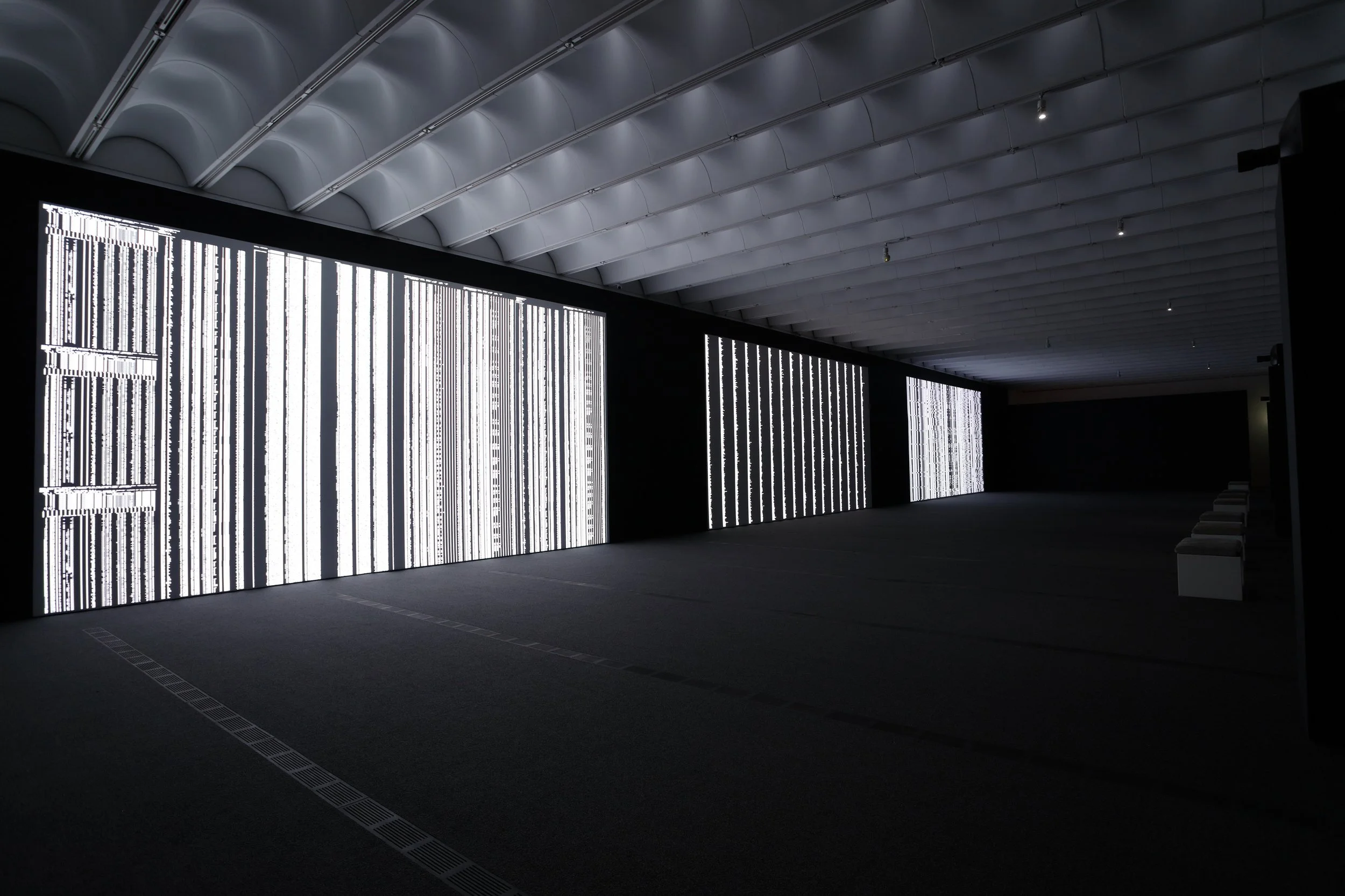
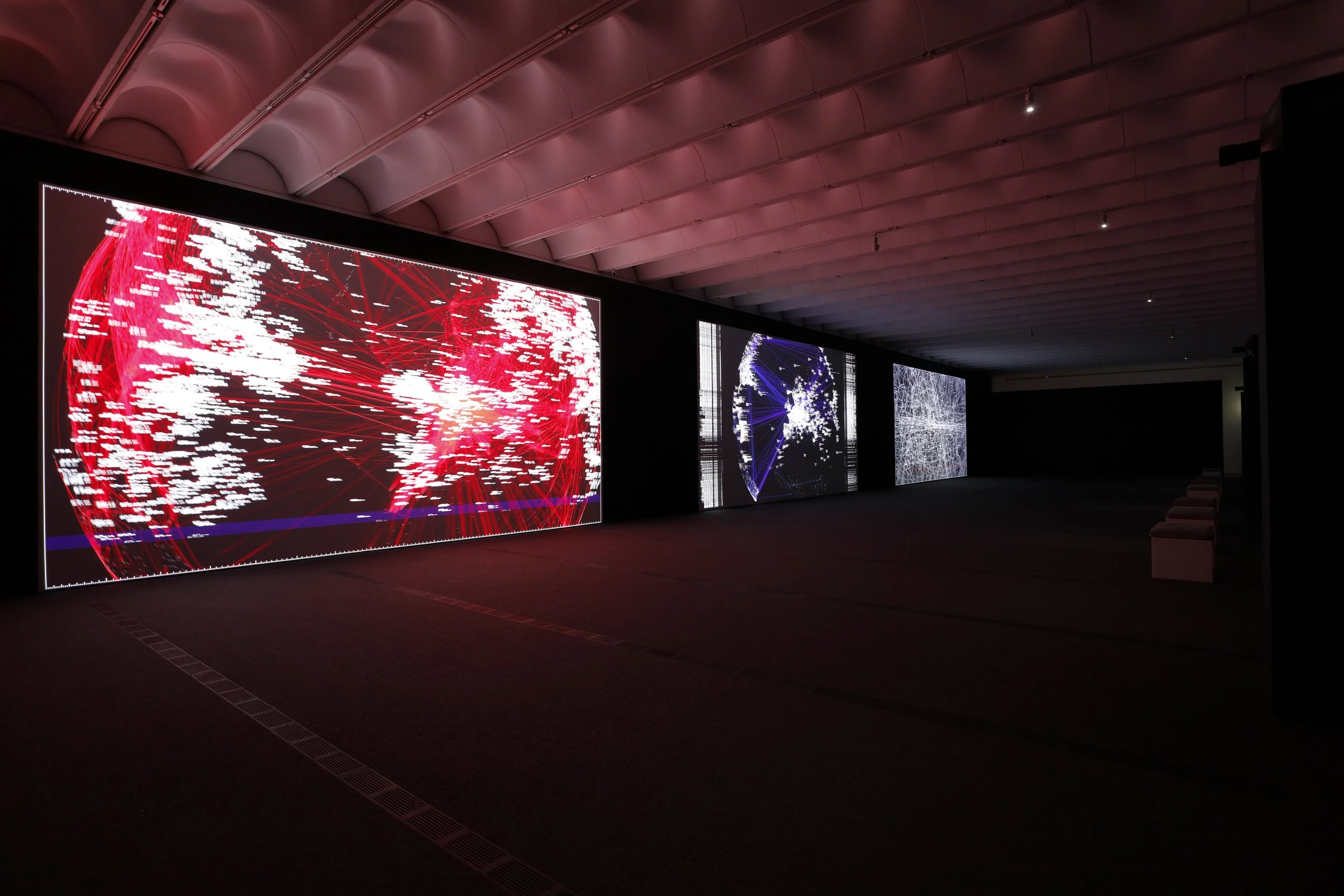







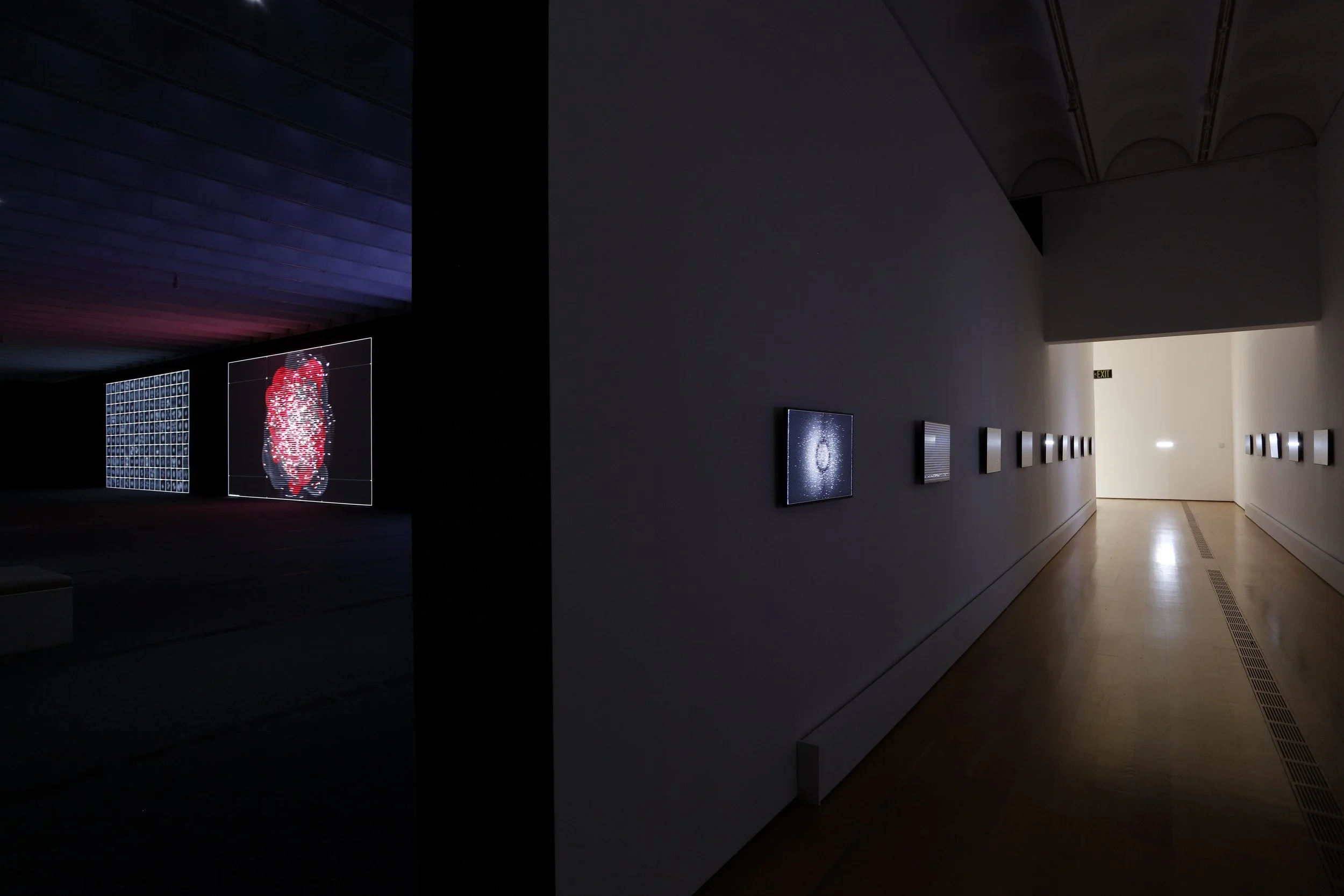

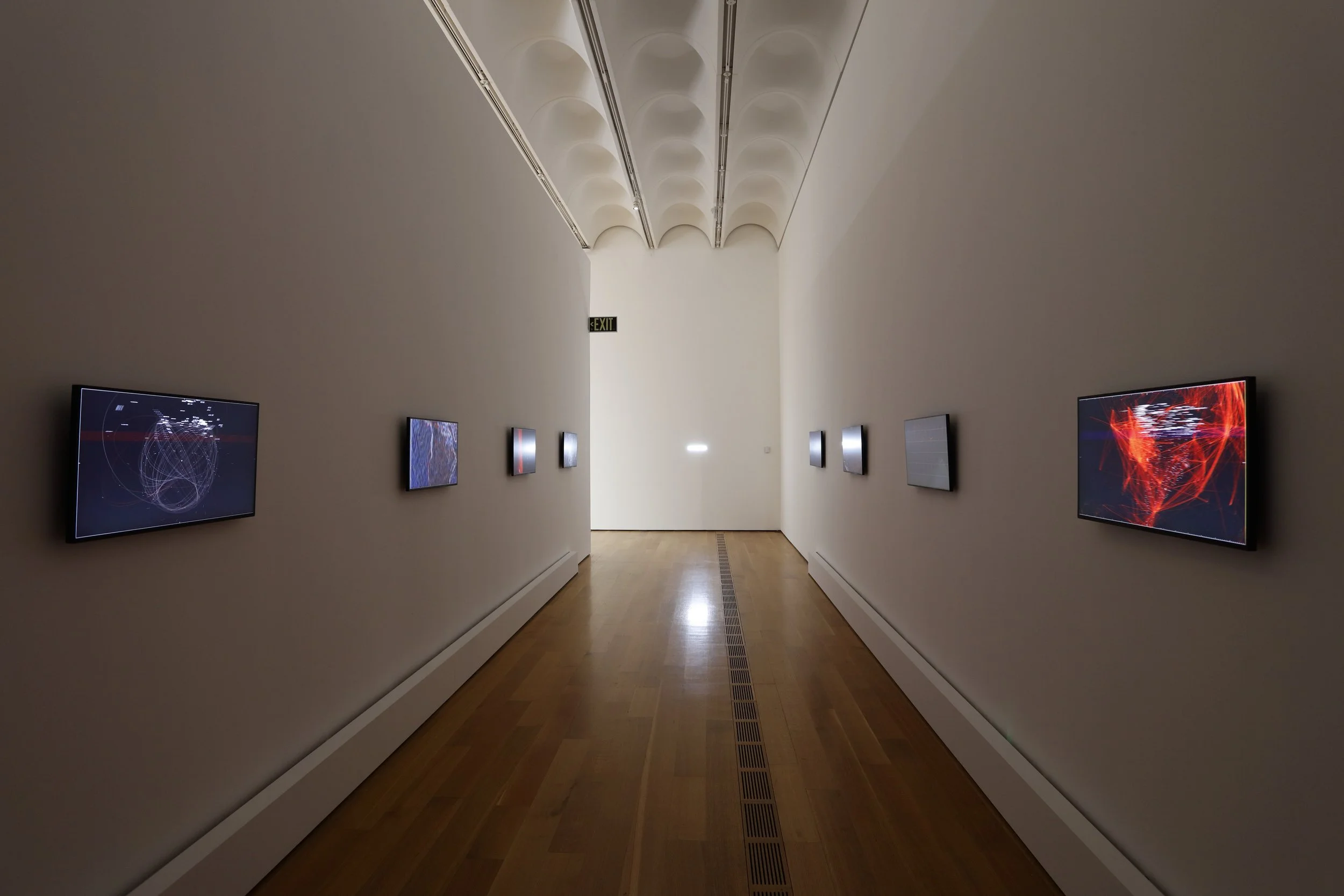


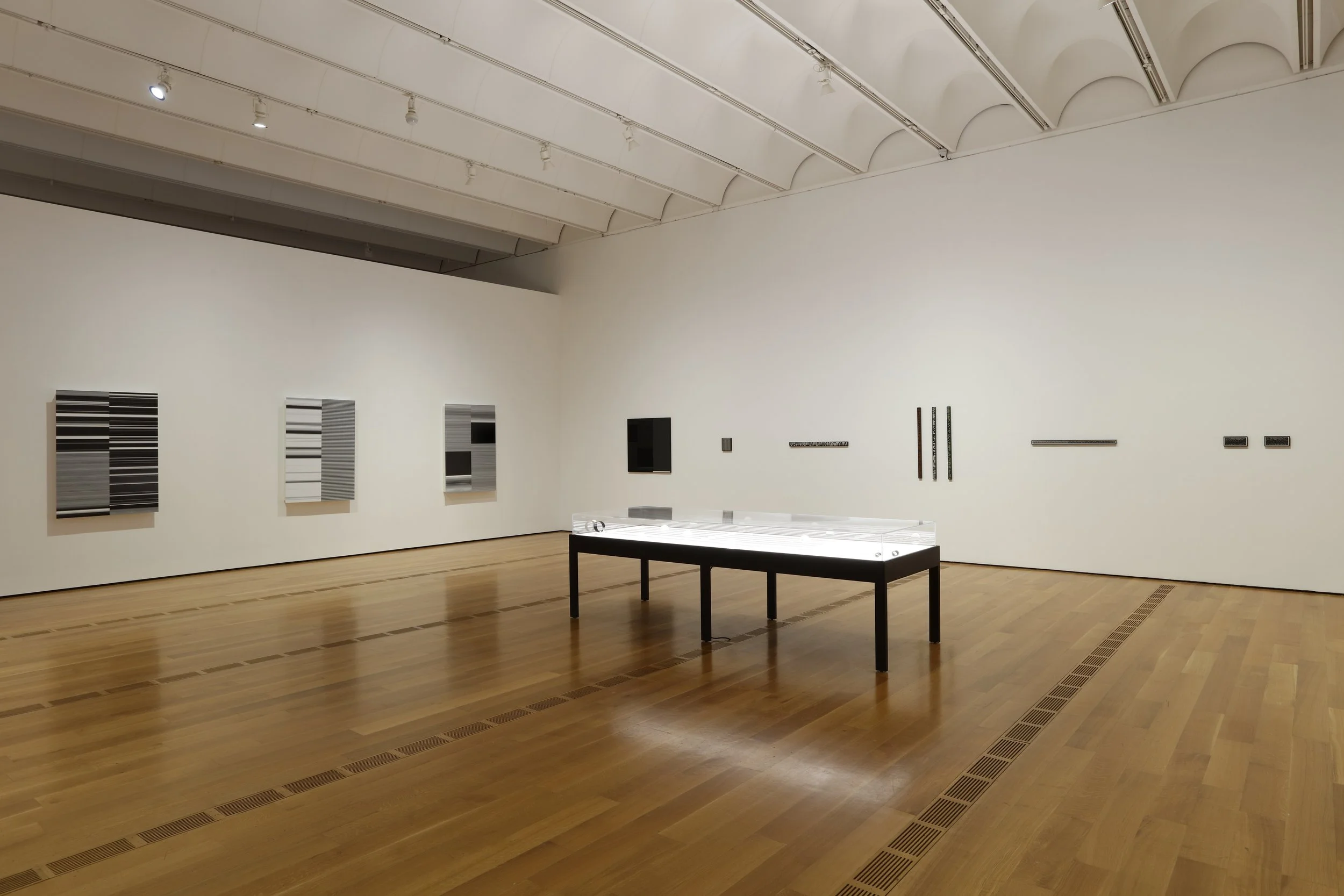



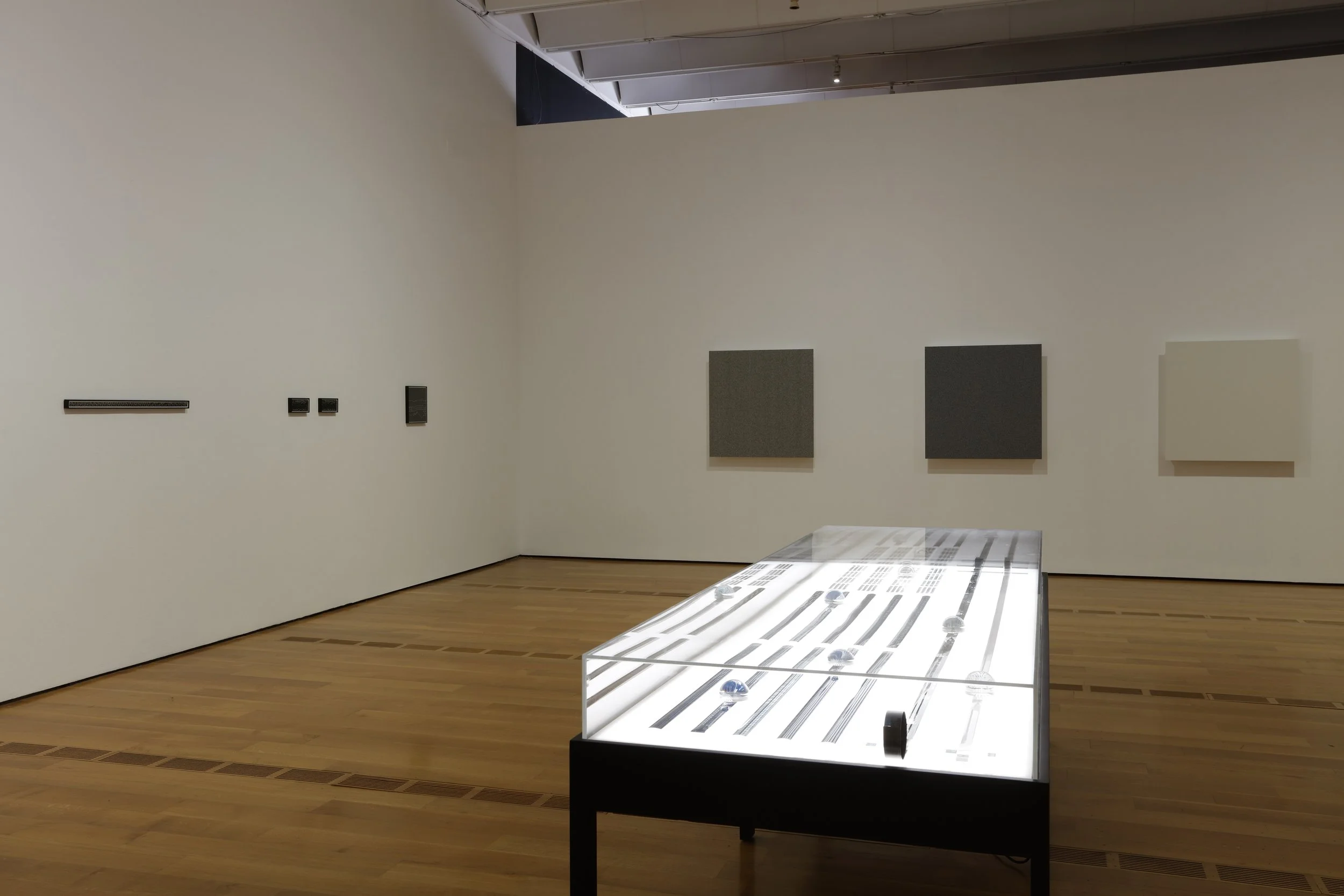
Exhibition View: Ryoji Ikeda: data-verse, March 7 to Aug. 10, 2025, courtesy of the Artist and the High Museum of Art, Atlanta, GA Photo Credit: Mike Jensen
“Ryoji Ikeda’s decades-long exploration of data, from sequences of alphanumeric symbols to collections of images of macro- and microcosms, is more relevant than ever, when data-driven decisions are precipitously changing the way people relate to the world,” said Michael Rooks, the High’s Wieland Family senior curator of modern and contemporary art. “His work across sonic and visual platforms will invite our audiences to rethink conventional relationships between sound and image in our tech-saturated lives.”
Exhibition View: Ryoji Ikeda: data-verse, March 7 to Aug. 10, 2025, courtesy of the Artist and the High Museum of Art, Atlanta, GA Photo Credit: Mike Jensen
“Ryoji Ikeda: data-verse” will be presented in the Cousins Family Special Exhibition Galleries on the Second Level of the High’s Wieland Pavilion.
Ryoji Ikeda is represented by Almine Rech.
Exhibition Organization and Support
“Ryoji Ikeda: data-verse” is organized by the High Museum of Art, Atlanta. “data-verse” wasoriginally commissioned by Audemars Piguet Contemporary, the art program of the Swiss finewatchmaker. This exhibition is made possible by Premier Exhibition Series Sponsor Delta AirLines, Inc.; Premier Exhibition Series Supporters Mr. Joseph H. Boland, Jr., The Fay S. and W. Barrett Howell Family Foundation, Harry Norman Realtors and wish Foundation; Benefactor Exhibition Series Supporters Robin and Hilton Howell; Ambassador Exhibition Sponsors Jones Day and Truist; Ambassador Exhibition Series Supporters Loomis Charitable Foundation andMrs. Harriet H. Warren; and Contributing Exhibition Series Supporters Farideh and Al Azadi, Mary and Neil Johnson, Mr. and Mrs. Baxter Jones, Megan and Garrett Langley, Margot and Danny McCaul, Wade A. Rakes II and Nicholas Miller, and Belinda Stanley-Majors and Dwayne Majors. Generous support is also provided by Alfred and Adele Davis Exhibition Endowment Fund, Anne Cox Chambers Exhibition Fund, Barbara Stewart Exhibition Fund, Dorothy Smith Hopkins Exhibition Endowment Fund, Eleanor McDonald Storza Exhibition Endowment Fund, The Fay and Barrett Howell Exhibition Fund, Forward Arts Foundation Exhibition Endowment Fund, Helen S. Lanier Endowment Fund, John H. and Wilhelmina D. Harland Exhibition Endowment Fund, Katherine Murphy Riley Special Exhibition Endowment Fund, Margaretta Taylor Exhibition Fund, RJR Nabisco Exhibition Endowment Fund and USI Insurance Services.
About the High Museum of Art
Located in the heart of Atlanta, the High Museum of Art connects with audiences from across the Southeast and around the world through its distinguished collection, dynamic schedule of special exhibitions and engaging community-focused programs. Housed within facilities designed by Pritzker Prize-winning architects Richard Meier and Renzo Piano, the High features a collection of more than 20,000 works of art, including an extensive anthology of 19th- and 20th-century American fine and decorative arts; major holdings of photography and folk and self-taught work, especially that of artists from the American South; burgeoning collections of modern and contemporary art, including paintings, sculpture, new media and design; a growing 2collection of African art, with work dating from prehistory through the present; and significant holdings of European paintings and works on paper. The High is dedicated to reflecting the diversity of its communities and offering a variety of exhibitions and educational programs that engage visitors with the world of art, the lives of artists and the creative process.
The exhibition will conclude on the tenth of August. For more information about this exhibition and others at the High Museum of Art, please visit their site here. The museum can also be found on Facebook, Instagram, Medium, TikTok, Threads, and YouTube.
ETRUSCHI DEL NOVECENTO(20TH CENTURY ETRUSCANS)
Exhibition View: Etruschi del Novecento (20th Century Etruscans), Fondazione Luigi Rovati, Milano MI, Italy 2025. Courtesy of the Fondazione Luigi Rovati
On 2 April Fondazione Luigi Rovati inaugurated the exhibition “Etruschi del Novecento (20th Century Etruscans)”, the ambitious project jointly organised with the Mart Museum in Rovereto. True to the foundation’s identity, the exhibition continues the journey begun with the Mart show (7 December 2024 - 16 March 2025) in a distinct and complementary show, proposing a selection of iconic works that shed light on Etruscan culture’s influence on 20th-century Italian artists.
In the exhibition, archaeological finds and masterpieces of modern and contemporary art are displayed along with documents, books and magazines, testifying to the fascination of the artists influenced by Etruscan art’s “anti-classical” aesthetic. Staged over both of the museum’s floors, the exhibition blends into with the permanent collection of the Fondazione Luigi Rovati.
Coperchio di urna cineraria con coppia de sposi Inzio V sec a.C Terracotta Parco Archeologico di Cerveteri e Tarquinia Photo Credit: Courtsey Parco Archeologico di Cerveteri e Tarquinia
A Fascinating Exhibition Route
Visitors are welcomed on the underground floor by the Leone urlante (1957): a “twentieth-century chimera”, a hybrid figure, a fantastic creature embodying the bond between Etruscan art and the experimental approach of Mirko Basaldella.
In the section Inspirations, Etruscan askoi (containers for oily liquids) come back to life in the 1920s porcelain-and-gold vases by Gio Ponti; the ceramic cista La camminata archeologica by Gio Ponti and Libero Andreotti – produced in the second half of the 1920s and on loan from the Poldi Pezzoli Museum (Milan) – echoes an Etruscan cista, a bronze container for storing jewels and cosmetics, from the National Etruscan Museum of Villa Giulia (Rome).



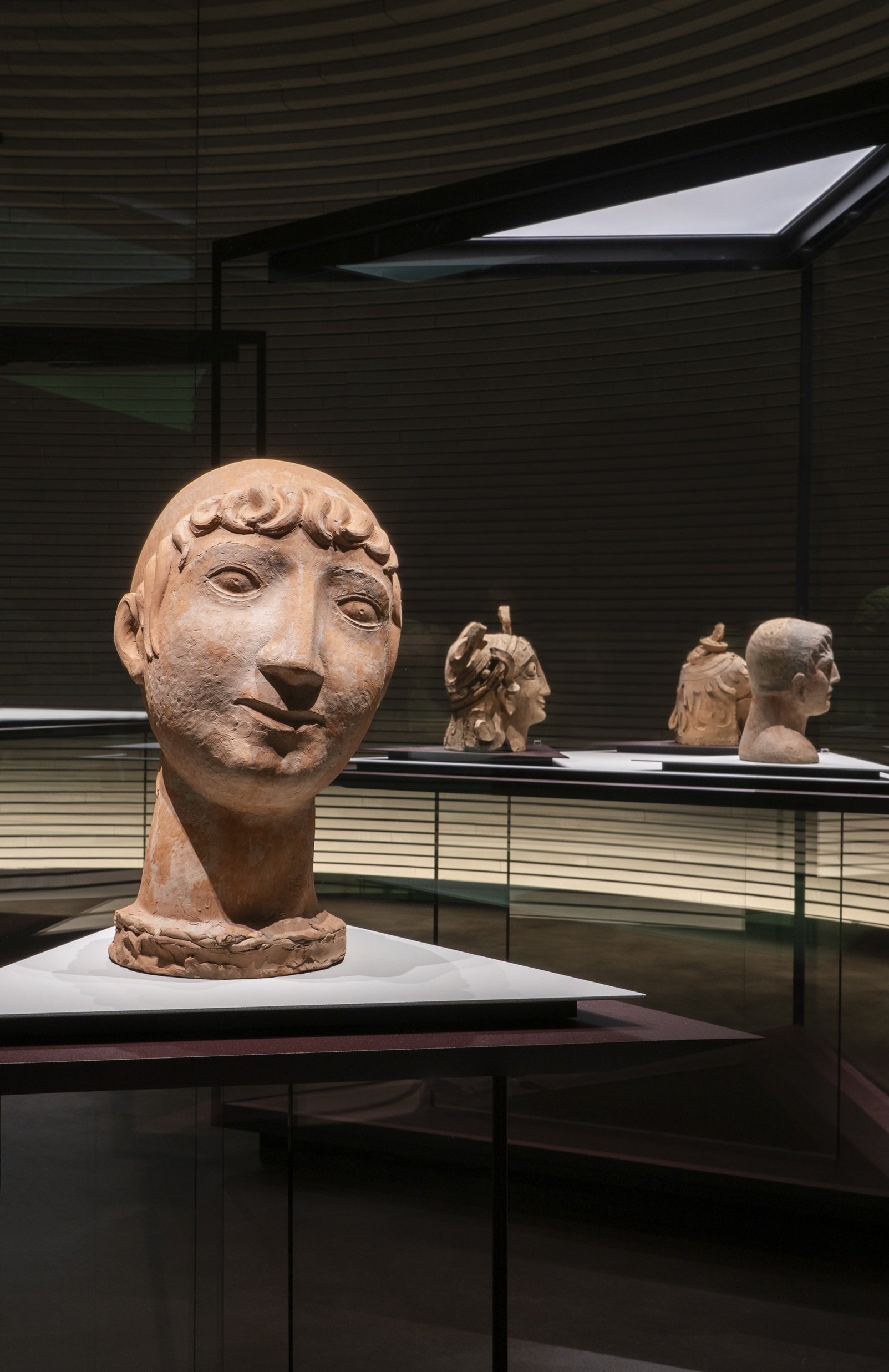
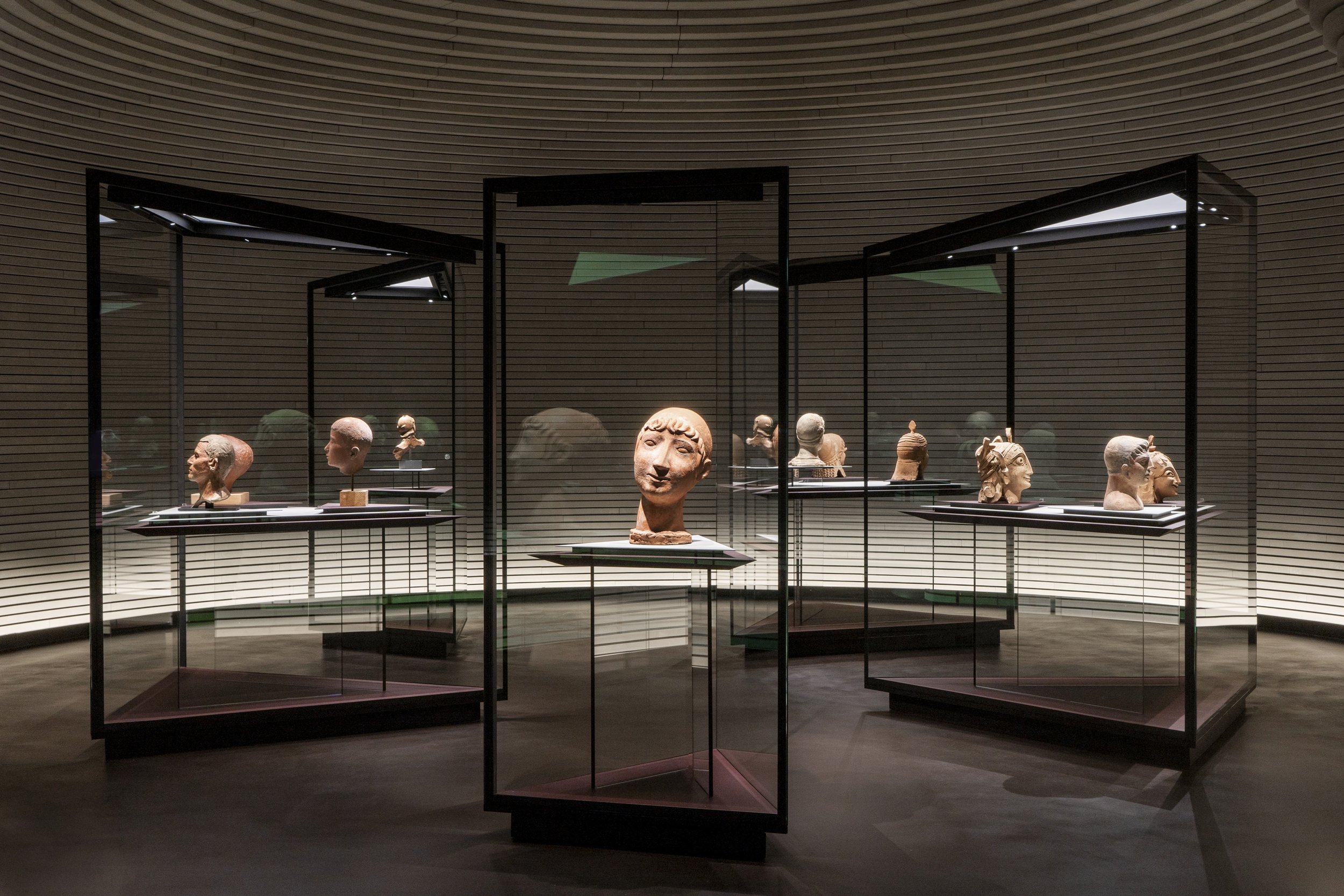

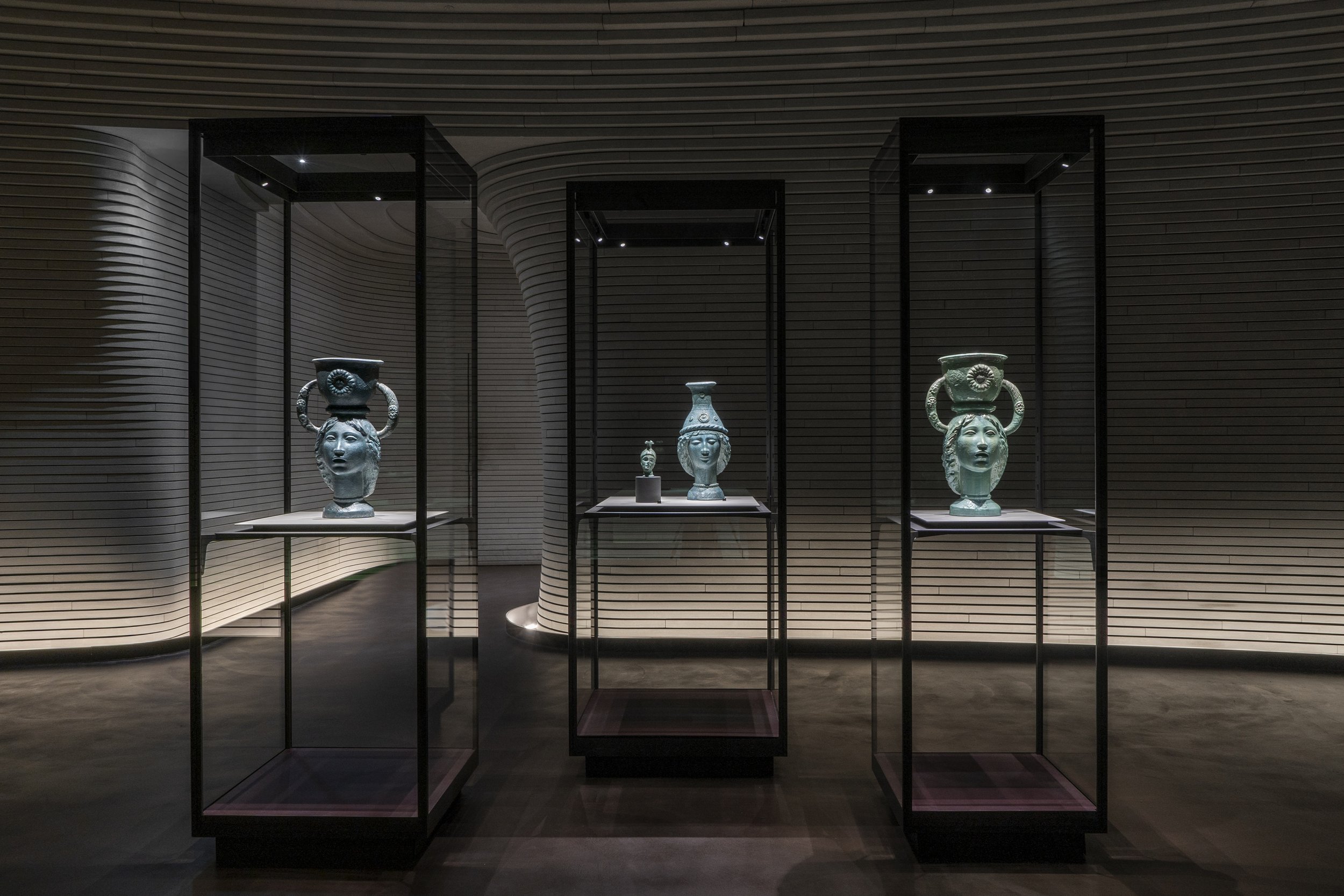
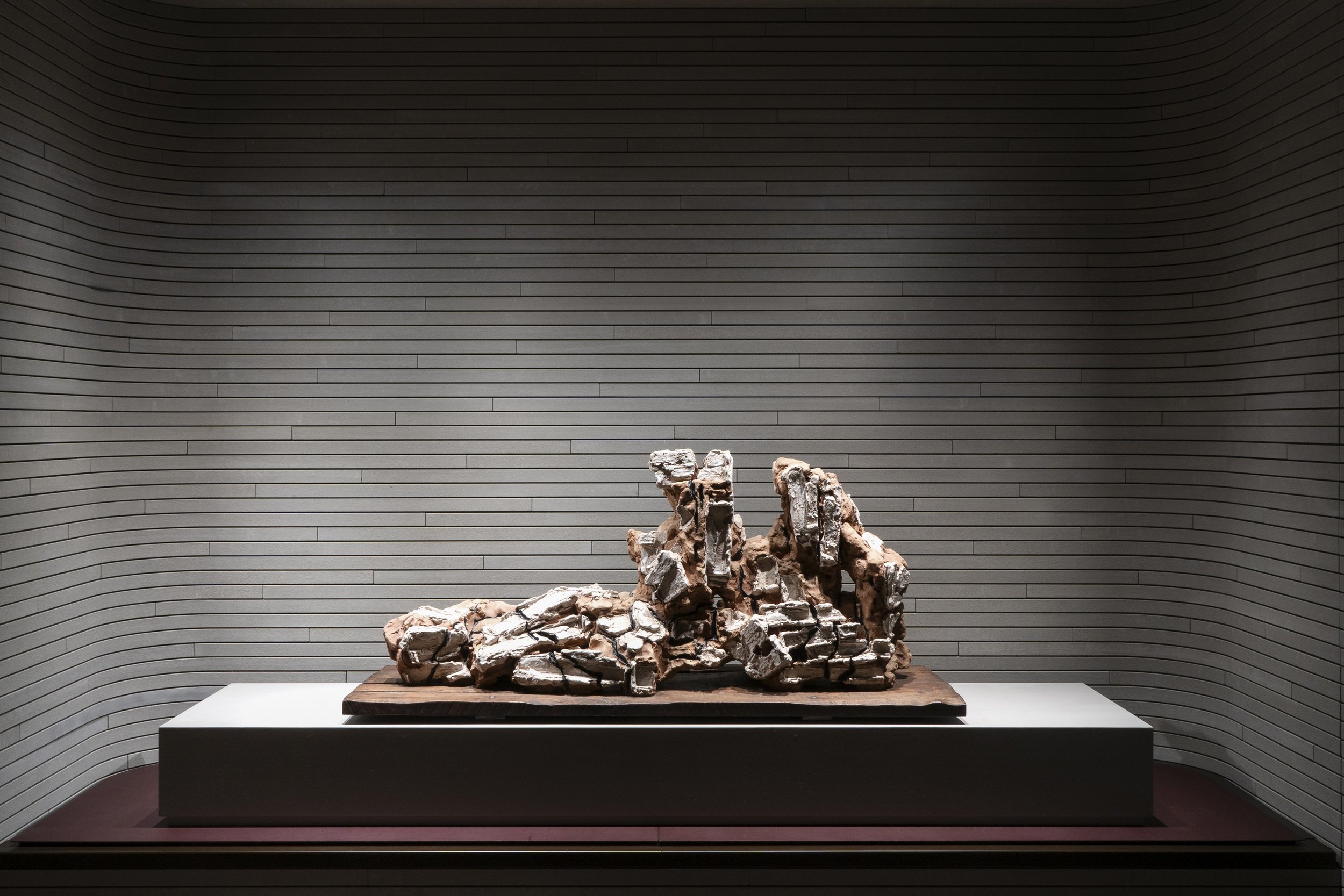

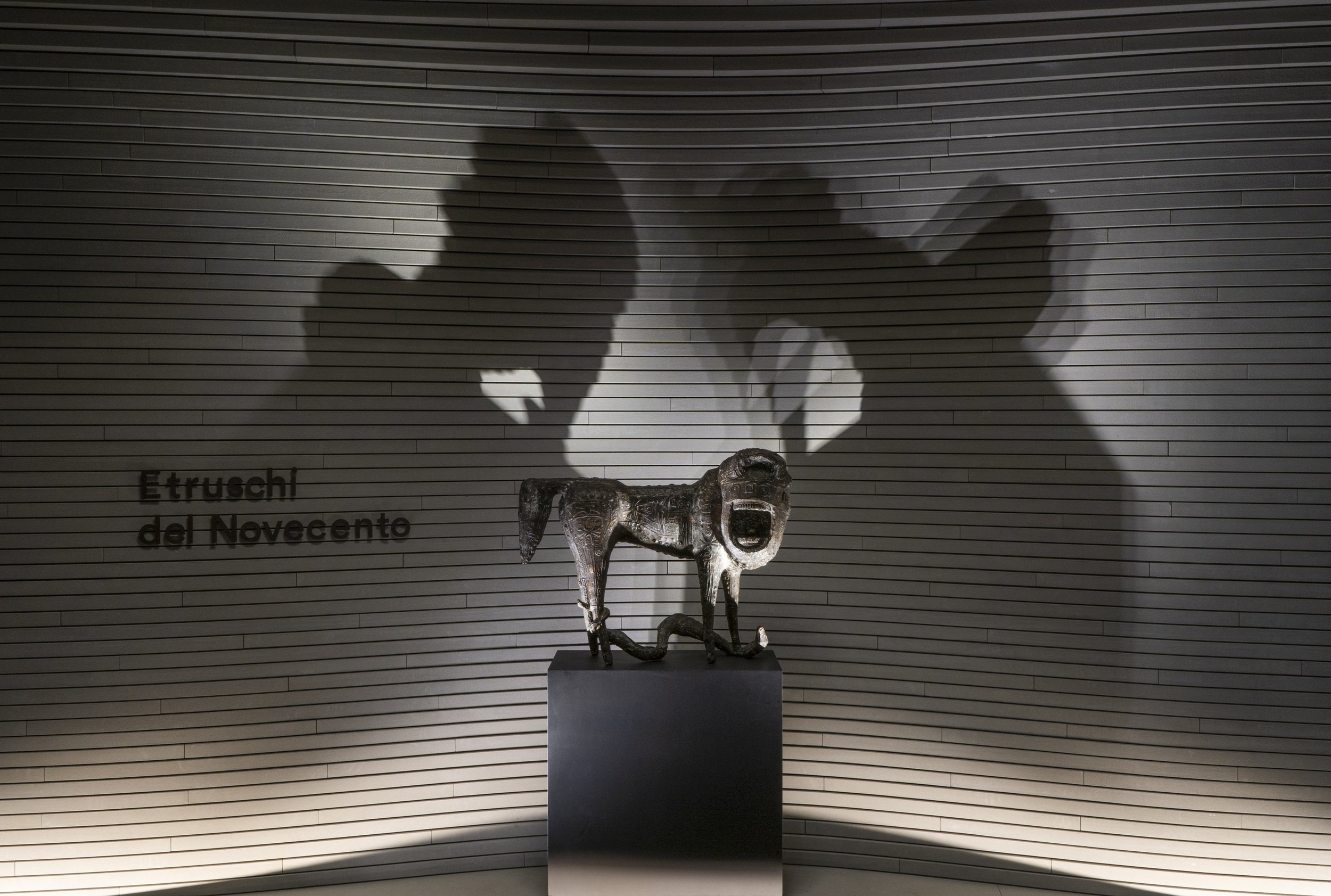


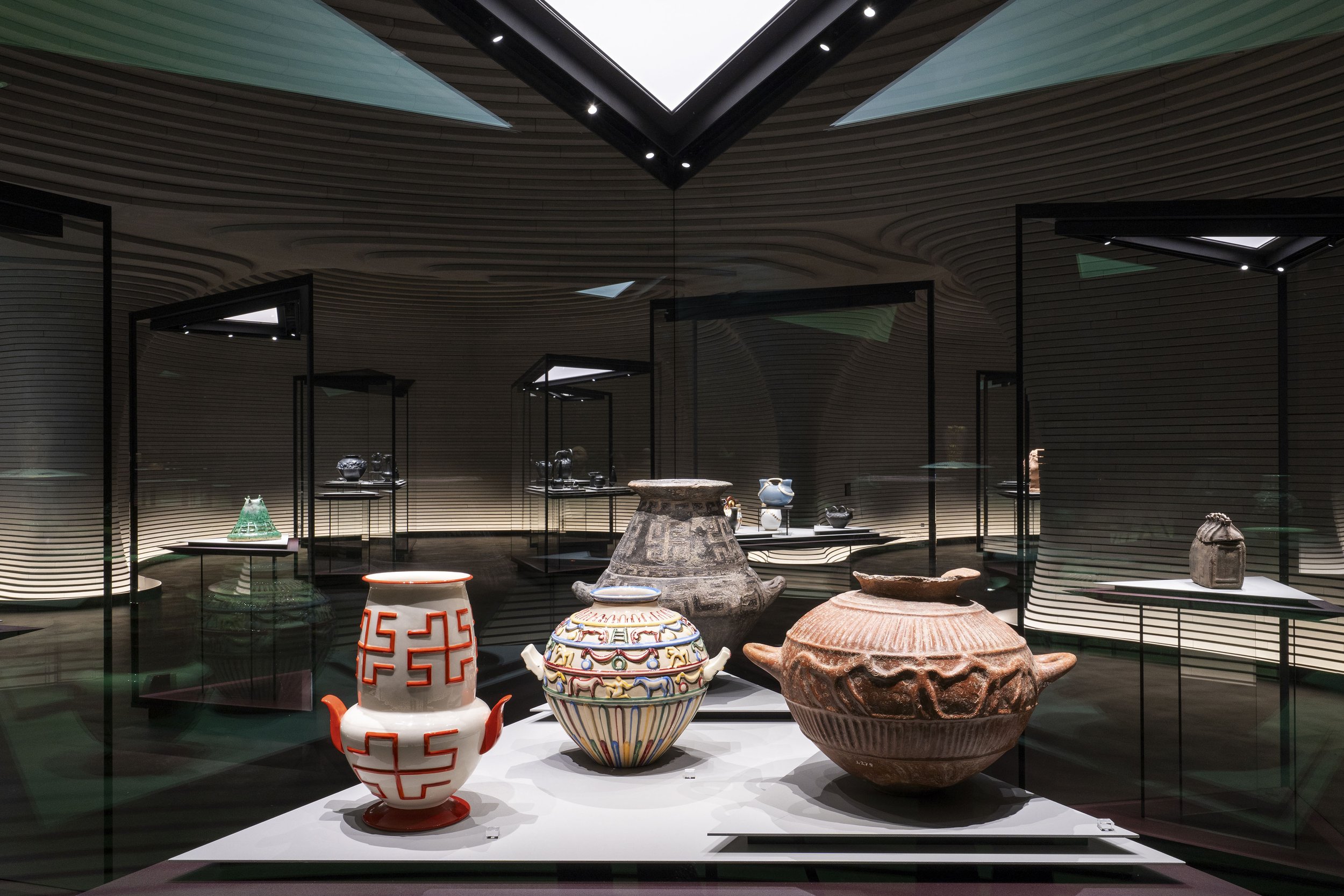


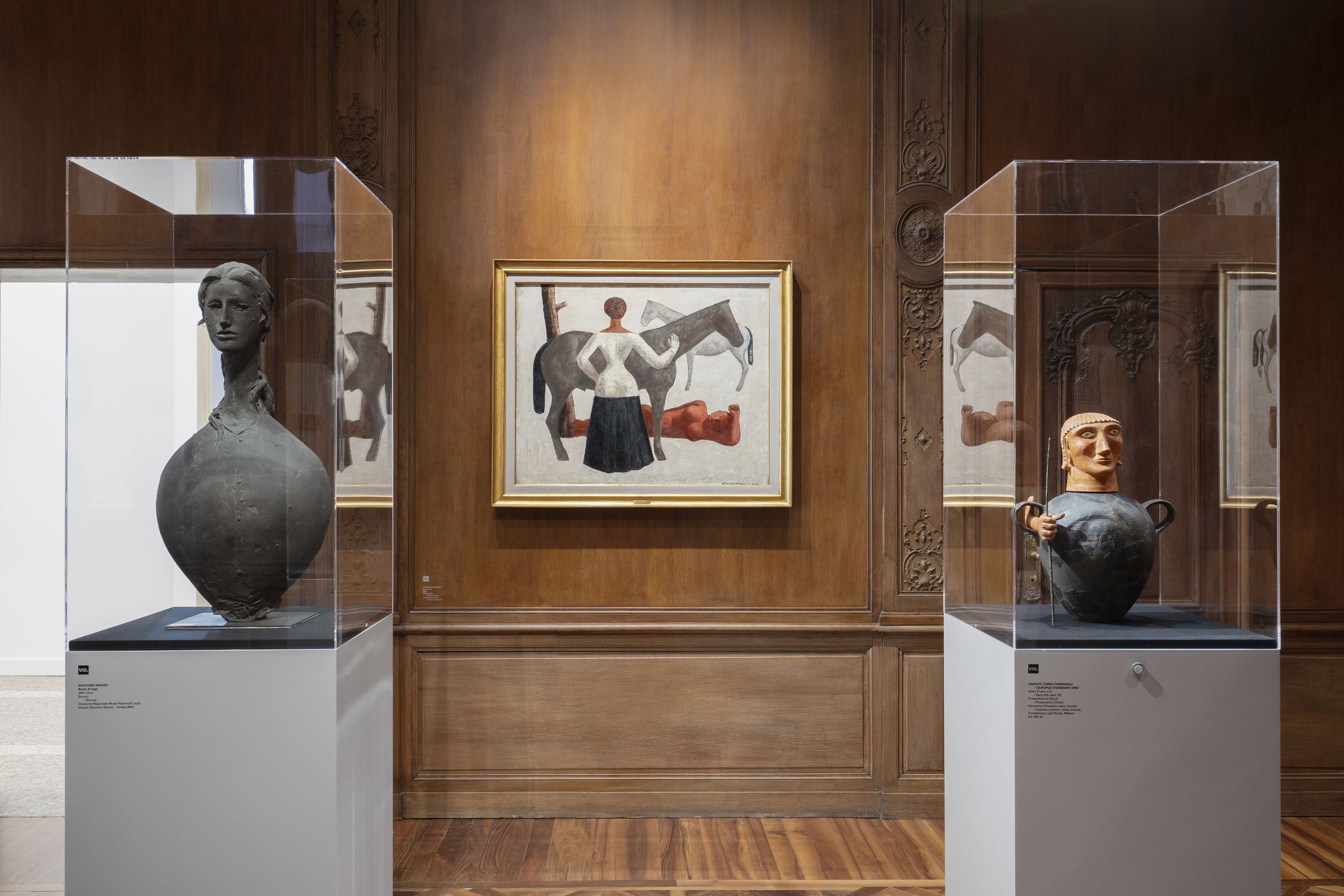

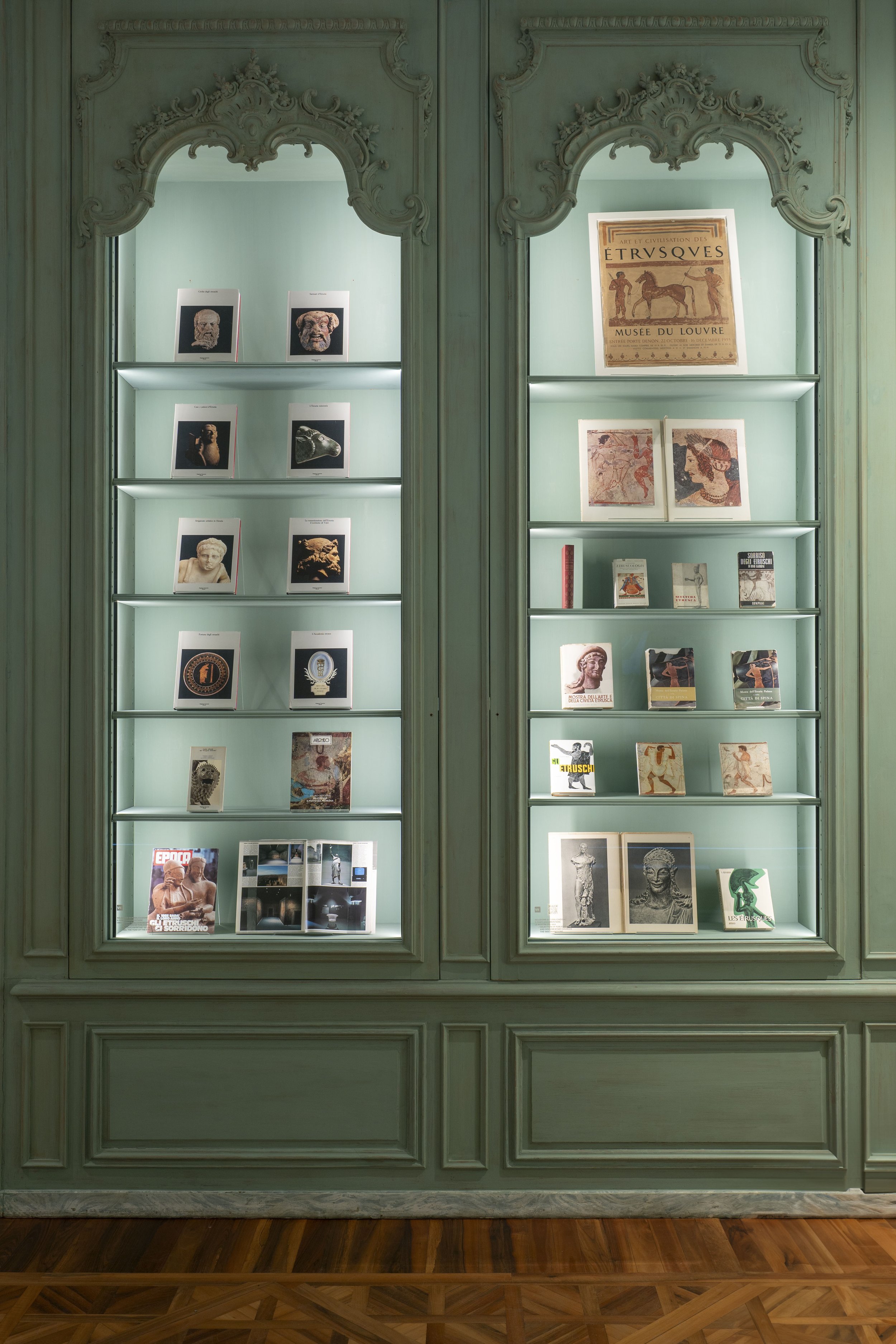



Exhibition View: Etruschi del Novecento (20th Century Etruscans), Fondazione Luigi Rovati, Milano MI, Italy 2025. Courtesy of the Fondazione Luigi Rovati
The motif of reclining figures is explored in the section Modern Reclining figures by the work of Leoncillo Leonardi, a powerful and dramatic interpretation of the famous Sarcofago degli Sposi from Villa Giulia, placed beside the precious Cinerary Urn Lid, on loan from the Archaeological Park of Cerveteri and Tarquinia.The Warhol Room on the main floor has been transformed into the documentation centre for taking a look back at the Appeal of the Etruscans as seen through rare art volumes, magazines, graphic works and posters dedicated to Etruscan culture published, from the late 19th century into the 1980s. In the “White Space”, Paolo Gioli’s series Etruschi (1984) is displayed in full for the first time, along with Alighiero Boetti’s Copertine (1985), an original work from the Fondazione Luigi Rovati’s collection. Paolo Gioli recreates the identity of the Etruscan faces depicted on cinerary urns through his polaroids, giving new vitality to colourless marble faces with chromatic touches and fragments that seem to pulse with life.
From Left to Right: Alghiero Boetti, Cupertino (Anno 1985) 1985 Grafite su carta Fondazione Luigi Milano Photo Credit; Courtsey Fondazione Luigi Rotaie, Milano, Marcello Nizzoli, Bozzette per il Manifesto per la XIX Biennale di Venezia 1934 CSAC- Centro Studi e Archivio della Comunicazione Universita di Parma
In the Copertine series, Alighiero Boetti painstakingly redesigns the covers of important international publications, creating a map of that year’s historic events, a sequence that opens with the cover of Epoca dedicated to the “Etruscans Project”.
Exhibition View: Etruschi del Novecento (20th Century Etruscans), Fondazione Luigi Rovati, Milano MI, Italy 2025. Courtesy of the Fondazione Luigi Rovati
A Multi-Site Exhibition Project
In addition to making use of loans from museums, institutions and collectors, the show benefits from two important collaborations that extend its presence out into the city, and specifically to Villa Necchi Campiglio and the Museo del Novecento. Due to conservation requirements, Arturo Martini’s L’amante morta (1921-22) and Marino Marini’s Popolo (1929), works that are part and parcel of the reflection on the Etruscans’ influence in the twentieth century, are not on display in the exhibition’s spaces but are still a part of the project, visible in the locations where they are customarily on display. The catalogue Etruschi del Novecento contains essays by the curators and scholars such as Matteo Ballarin, Fabio Belloni, Martina Corgnati, Alessandro Del Puppo, Maurizio Harari, Claudio Giorgione, Mauro Pratesi, and Nico Stringa.
School and Educational Activities
The exhibition will be enriched by an extensive offering of educational programs, part of Fondazione Luigi Rovati’s ongoing efforts to give visitors opportunities to learn and explore further. Workshops and group and school visits are designed to offer a more in-depth experience of the exhibition’s major themes, with a particular focus on the influence of Etruscan civilisation on twentieth-century visual culture through a critical and interpretive gaze.
From Left to Right: Fausto Melotti, Gallo, 1955 circa, Ceramica smaltata policroma, Montrasio Arte, Monza, Photo Credit: @Matteo Zarbo per Montrasio Arte, Monza, Uma a capanna, Fine IX, a. C. Ceramica d’impasto, @Fondazione Luigi Rovati, Milano Photo Credit @Giuseppe e Luciano Malcangi per Fondazione Luigi Rovati
Special Offers
For holders of the FLR Card and for the Amici del Mart, entrance is free for the duration of the two exhibitions and reduced for the rest of the year. In addition, visitors in possession of a ticket to one of the two museums can access the other for a reduced price for the duration of the two exhibitions.
The exhibition is supported by
Radio Monte Carlo - Media Partner
Italo Italy's first private operator on the high-speed rail network, as part of its activities to support culture, collaborates with the Luigi Rovati Foundation and promotes the exhibition “Etruschi del Novecento (20th Century Etruscans)”.
For more information and to consult the foundation’s dedicated educational programs, here. To learn about this exhibition and others, please visit Fondazione Luigi Rovati’s website here. The musuem can also be found on Facebook, Instagram, and YouTube.
Kishio Suga: Existence Within Definite Contours
Exhibition View: Kishio Suga: Existence Within Definite Contours, Tomio Koyama Gallery, Tokyo, Japan 2025. Courtesy of the artist and Tomio Koyama Gallery
Tomio Koyama Gallery Kyobashi is pleased to present “Existence Within Definite Contours,” an exhibition by Kishio Suga. Suga has held exhibitions of new works at our gallery for 10 consecutive years since 2015, including “Intentional Scenic Space” (2015), “Divided Orientation of Space” (2017), “Expanded Self-Space” (2018), “Measured Divisional Entities” (2019), “Released Scenic Space” (2020), “Gathered ” (2021), “Not Being Present, Not Being Absent” (2022), “Neither Things nor Sites” (2023), and “There Is Neither Such Thing as Being, Nor Such Thing as Not Being” (2024). This year, Suga will present his first exhibition at our new space in Kyobashi, titled “Existence Within Definite Contours” (2025).
At the Kyobashi gallery, Suga will exhibit new sculptures and installations, while the Roppongi and Tennoz spaces will also hold concurrent exhibitions of his work. In Roppongi, drawings from the 1970s and 80s and small three-dimensional works from the 1980s through 2000s will be exhibited. Meanwhile, the gallery in Tennoz will showcase activation videos, photographs, and drawings, as well as a series of works using paste on slate from the 1990s.
Exhibition View: Kishio Suga: Existence Within Definite Contours, Tomio Koyama Gallery, Tokyo, Japan 2025. Courtesy of the artist and Tomio Koyama Gallery
The catalog, which is published annually, features a special contribution from Simon Groom, Director of the Scottish National Gallery of Modern Art, who curated a two-person exhibition by Suga and Carla Black (2016) and wrote a text for the catalog of Suga’s solo exhibition at the Museum of Contemporary Art Tokyo (2015).
Kishio Suga (1944-) was a key member of the Mono-ha art movement of the late 1960s and 70s. He subsequently went on to deepen the essential world of his works expressed by the diversity of the existence of things, and has carved out a unique niche as a leading contemporary practitioner of postwar Japanese art.
菅木志雄 Kishio Suga 入遠 Entering Distance 2024 wood, acrylic h.119.9 x w.90.0 x d.8.2 cm ©Kishio Suga
Suga’s thinking, which focuses on “things” (mono) themselves that were previously only everyday materials, the human beings who perceive those things, and their relationships with each other, continues to pose fundamental questions about existing art and ways of looking at the world, earning him a formidable international reputation.
Suga has participated in more than 400 exhibitions, and his works are in the collections of more than 40 museums in Japan and abroad, including the Centre Georges Pompidou, the Tate Modern, and the Museum of Modern Art in New York. He will be presenting a solo exhibition at Dia Beacon in New York opening July 19, 2025.
Regarding the new works at this exhibition, and his own practice, Suga says that he now works simply and quickly. “Simplicity is important to me now. I think my work from my younger days was rather complicated. To know what ‘things’ are saying, and a kind of complexity that does not appear as such — that is what is important, however. Works from a long time past and works from the present are continuous, and not divided by time. The thoughtfulness in a particular moment, however, changes what is important and how we see it.”


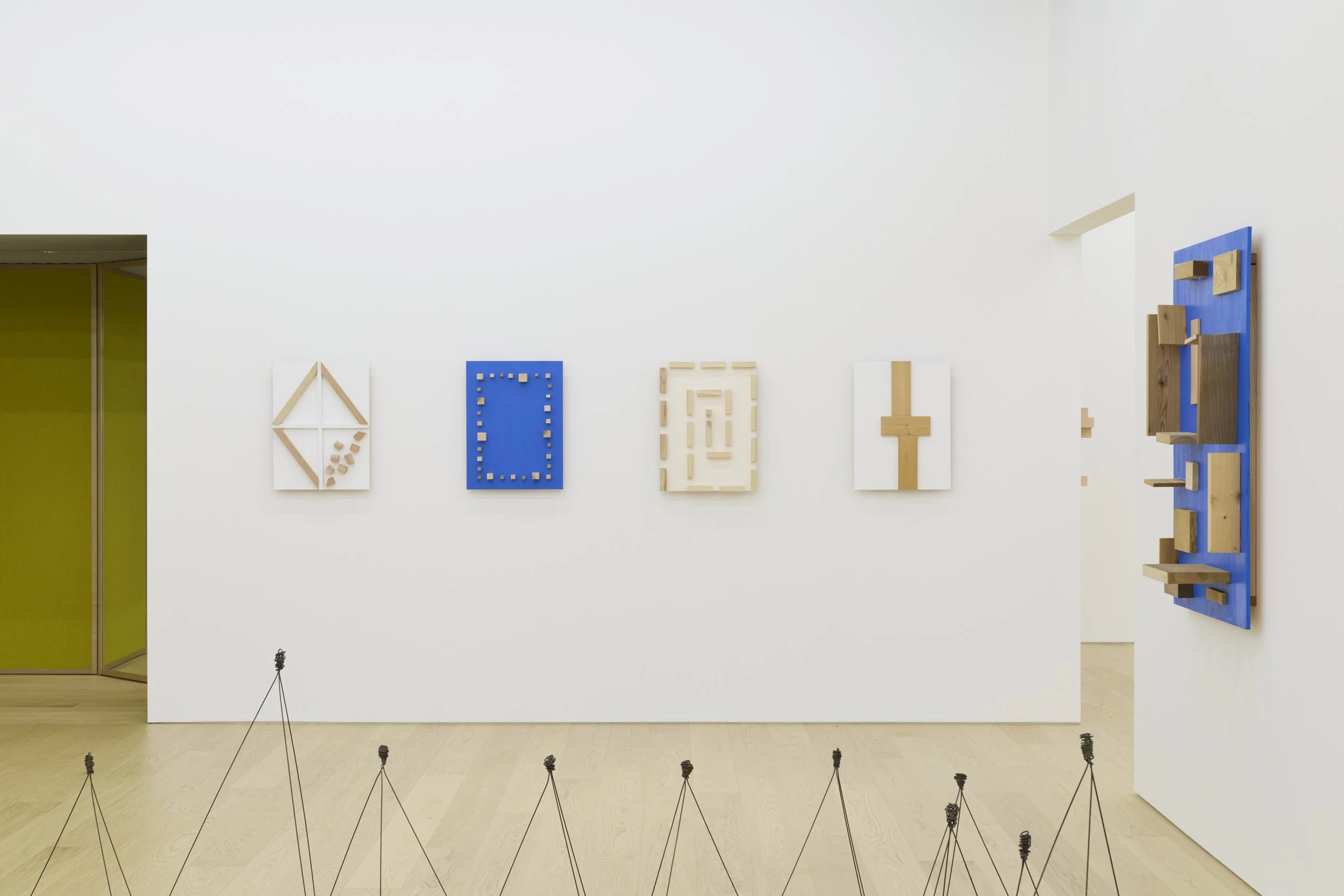



Exhibition View: Kishio Suga: Existence Within Definite Contours, Tomio Koyama Gallery, Tokyo, Japan 2025. Courtesy of the artist and Tomio Koyama Gallery
On the occasion of this exhibition, Suga penned the following statement.
—————————————
“Existence Within Definite Contours”
Things always exist as singular entities. And yet, people possess a mode of thought that resists this. We try to perceive meaning in things, and things can momentarily reveal aspects they never revealed before. What is visible is not all there is. And just because something is invisible does not mean that it lacks existence. It is the human eye that acknowledges existence—and the same eye that denies it. We must anticipate conditions beyond the norm.
Kishio Suga, May 2025
Of his current work, Suga also had the following to say.
“Before, I would use iron, stone, and rope, but now I only use wood. Although wood suits me in terms of the feeling it gives me and how it relates to my consciousness, the way in which I use things is more important than the materiality of the object. Philosophy is necessary to look at things. The act of creating an artwork is not aboutThings are not ideas: thingsthey already have an existence. Unless you are constantly thinking about what state your actions and circumstances are in, rather than about methodologies, it is extremely difficult to succeed at creating something.” (from an interview conducted at Suga’s studio, February 2025)
Suga’s senses have become even more finely honed over the past decade. Even as he maintains an underlying strain of thinking, he is not averse to change. Thanks to this keen sensitivity to the spirit of the times and human consciousness, Suga’s works continue to express a sense of contemporaneity. He constantly poses us questions, presenting us with a fresh worldview where theory and things intersect with each other. We hope you will take the rare opportunity to visit this exhibition.
For more information about this exhibition and the gallery, please visit the Tomio Koyama Gallery site here. The gallery can also be found on Facebook, X, Instagram, and YouTube.

